- Skip to main content
- Skip to primary sidebar
- Skip to footer


8 Steps For Planning an Epic Trip to Tuscany
Sean Finelli Last Updated: November 14, 2022
Planning a trip to Tuscany? Lucky you! It’s one of the most scenic and peaceful places most of us mortals will ever visit. Tuscany is an incredible destination that absorbs your anxiety and turns it into vino! But, where do you start? Here are eight steps to planning your ideal Tuscany trip.
Pro Tip: Planning what to do on your trip to Florence? Bookmark this post in your browser so you can easily find it when you need it. Check out our guide to Tuscany for more planning resources, our best Florence and Tuscany tours for a memorable trip, and how to plan a day of wine tasting in Tuscany .
Step by Step Tips For Planning Your Trip To Tuscany
Planning a trip can be daunting. Not to worry—we’ve got you covered. This article is composed of two parts. The first will cover some basic facts about Tuscany and the second offers some actionable tips on how to plan including where to stay, what vineyards to visit, and how to get around. Enjoy!
Step 1: How Long To Go For
There are three options for visiting Tuscany, really. You can do a day trip, spend a few days there (four days of your 10-day Italy trip, for example), or spend your entire trip in Tuscany. Don’t worry, I will make deciding easy. Ask yourself these questions to narrow it down.
Have you ever been to Italy?
If you’ve been to Italy’s main cities already, you should gravitate towards the option of a few days in Tuscany or your entire trip there. If this is your first visit to Italy, then choose a day trip or spend a maximum of a few days of your trip there.
Are you willing to rent a car and drive in Tuscany?
If you’re willing to rent a car in Tuscany and have visited the main cities of Italy on a past trip, I recommend doing a week in Tuscany, which could be your entire trip. There are such a variety of towns to visit and plenty to keep you occupied.
Take a day trip if you don’t like the idea of renting a car. Our Chianti Wine Day Trip from Florence is a top-rated option. If you have decided on a day trip, the good news is that your journey ends here and the planning is over!
If you don’t want to rent a vehicle but want to spend a few nights in Tuscany, maybe two or three, there are some great accommodations right outside Florence. We share some great vineyards with hotels and accommodation in this article.
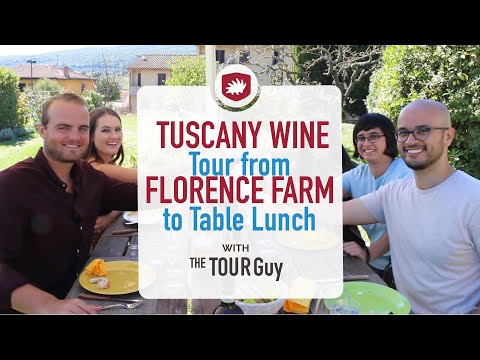
Step 2: Start in Florence
Florence is a great starting point. You’ll probably arrive in Italy via Rome, but I don’t recommend driving in Rome if you’ve not been before. You can take a train to Florence in less than two hours and navigate easily from there.
Florence is an amazing city that is always worth another visit. It’s full of wonders like the Uffizi Gallery , which I visit every time I’m in Florence if only to see the Birth of Venus .
There is an international airport in Florence and, as mentioned, many fast trains arrive in the city from Rome, Naples, Venice, Bologna, Milan, and Torino. It is the perfect jump-off point for a visit to Tuscany, especially Chianti, which is very close. If you’re willing to rent a car you can pick it up at the Santa Maria Novella station and easily get out of the city using your phone’s GPS.
You’ll have to decide if you want to spend the night in Florence or not. If you don’t, schedule to pick up your rental car early. Ask if you can leave it in the garage for the rest of the day and leave your bags inside the car while you sightsee.
Travel Hack: If you can find wi-fi, you can use your phone even on airplane mode. Pull up your map and search for directions. Hit “go” when you’re ready, then keep your phone on airplane mode and leave wi-fi. Your GPS will still work, and you shouldn’t be eating away at your roaming data. Be sure to turn that off in your settings. You won’t be able to search for a new destination when you leave wi-fi, but your GPS pin will work all the same.
Tours of Chianti and Florence
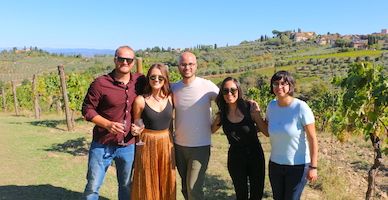
Top-Rated Experience
Chianti Day Trip from Florence with Vineyard Lunch
Want to have an epic experience in Tuscany? Remove the guesswork and the hassle of transportation by joining us on a day trip to Chianti from Florence. You’ll enjoy time in the enchanting cities of Siena and San Gimignano with lunch and wine tastings too. Make your Tuscany day trip one to remember!
Best-Selling Tour
Florence in a Day Combo Tour with David & Uffizi
This tour is your best value in Florence. See Michelangelo’s David statue in the Accademia Gallery with a licensed guide before exploring the Uffizi Gallery. You’ll also have plenty of time to see the outside of the Florence Cathedral, Baptistry Doors, Ponte Vecchio, and more. All your skip-the-line admissions are included along with an English-speaking guide.
Not ready to book a tour? Check out our Tuscany guide for more info.
Step 3: Rent a Car
As a rule of thumb, the most beautiful and well-preserved areas are the least connected by train or highways. For me, I would not travel to Tuscany without renting a car. Does that make you nervous?
You can rent a car from any online agency and they’re pretty much all the same. I wouldn’t stress much about being charged extra for scratches you aren’t at fault for. I’ve rented dozens of cars in Italy and have never been charged extra due to a false accusation.
In general, a small cross-over SEO is a good option for two people. If you are driving with kids, look at the larger SUVs or a station wagon. A station wagon may not sound sexy but they are pretty popular in Europe and easy to drive.
Step 4: Decide on Mobile Roaming Data
Traveling abroad with mobile usage turned on used to be the key to bankruptcy, but today it’s actually affordable. AT&T charges $10/day and some carriers charge nothing.
With AT&T, the only one I am familiar with, you just have to tell them you are traveling and they will only charge you if you go off airplane mode. If I’m in a city with wi-fi, I keep airplane mode on. If I’m renting a car and using my phone to navigate, I turn data on.
Step 5: Get Advice
We want to be your end-all source for advice on traveling to Tuscany and we make it as free as we possibly can. All our tours are designed to make your trips memorable and stress-free, so you can enjoy being in Tuscany without worrying about any details. Check out our Florence and Tuscany tours .
There is also a wealth of free information on our online Tuscany guide to help you plan. If you’re looking for a more customized experience, we offer trip planning services through Finelli & Shaw.
Step 6: Book Your Stay in Tuscany
Again, if you can’t make time to stay in the countryside, our Chianti day trip visits Tuscany for a full day and includes lunch in the vineyard. Here’s a quick guide on where to stay in Tuscany based on the number of nights you have.
Two to three nights
If you’re going to spend two to three nights in Tuscany, you’ll want to pick one destination and spend your time there. We have a great article on the best vineyards to stay at in Tuscany . If you’re renting a car, think about staying at Fonte de’ Medici or near Montalcino. Medici Villa is a great option if you’re not renting a car.
Four nights or more
If you’re going to spend more than four nights or possibly a week, you should move around a bit. With some money set aside to buy wine, possibly €50 to €150 per day, you could explore some really cool areas and have a great experience. Here are the areas I would dive into:
- Montalcino and Val d’Orcia
- Chianti Classico (specifically near Tignanello)
- Bolgheri (where Sassicaia is made)
Step 7: Don’t Ask “How Much For a Tasting”
I will rarely walk in and ask, “how much does a tasting cost?” On your trip to Tuscany, be prepared to buy wine. If you have a great budget, ship some home.
If not, plan to buy a few bottles per person at each vineyard and they’ll normally waive any tasting fees. When staying in Tuscany, you may well be consuming a bottle of wine per day minimum, so it’s better to stock up!
Step 8: Be Spontaneous
It almost always pays to plan ahead, but you can leave yourself some wiggle room to be spontaneous. You can stop by most vineyards unannounced in the summer to have a tasting.
If you have a phone plan working in Italy, you can call ahead by 20 or 30 minutes to see if you can stop by, but I have also popped in unannounced. That said, vineyards prefer a little notice.
It’s better to call the day before if there’s a vineyard you really want to visit, but you can fill in the blanks around that stop. That said, when you see a beautiful road that you simply must drive down or a vineyard calling your name, then you should change your plans and follow your dreams!
Not ready to book a tour? Check out our article on the best Florence tours to take and why .
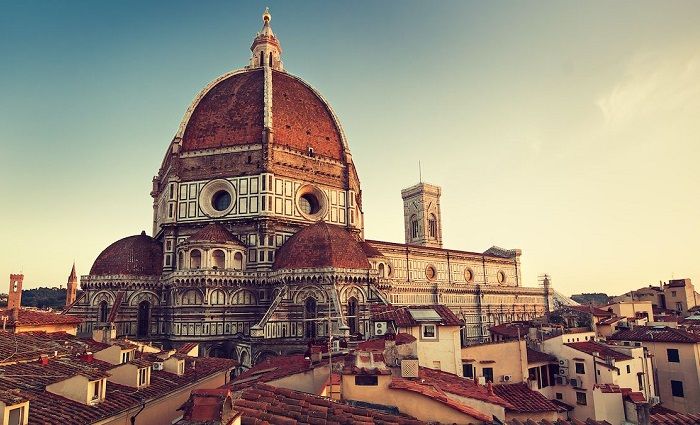
Where To Stay in Florence
Florence has a small historical center packed with iconic landmarks to explore. Plan where to stay in the best neighborhoods in this beautiful city.
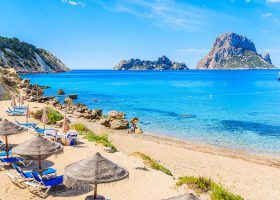
About Sean Finelli
Sean is a co-founder and owner of The Tour Guy and its subsidiary The Roman Guy. He studied finance and statistics, but that is his "Dr. Jekyll" side! His "Mr. Hyde" is in love with travel, art, history, and culture. Sean has read libraries of historical text and believes that all internet content should come from books. A practice he follows!
Reader Interactions
Comments (2).
July 28, 2021
Do you have any ideas of a location to stay in Tuscany and be able to stay in one place but take day trips? If so I would appreciate your suggestions. Will be in Tuscany at last 5 days
July 29, 2021
I prefer the area surrounding Siena. I just wrote this article on places to stay near Siena . The countryside there, especially near Montalcino , is so beautiful.
Montalcino is more remote, but if you are ok with 2 hour drives it’s perfect. You’re near Siena, Florence, Orvieto, and a ton of other cities. To answer your question, I would stay near Siena if you want a great balance between beauty and proximity and near Montalcino if you want to be in the most beautiful place in the world.
Leave a Comment Cancel reply
Your email address will not be published. Required fields are marked *
- Travel Guide
- In The Press
POLICY & TERMS
- Cancellation Policy
- Terms & Conditions
- Privacy Policy

- Smaller Text Larger Text
- Home /
- Blog: Cameron's Travels
How to Experience the Best of Tuscany: 12 Travel Tips for Italy’s Heartland
I love Italy. (Who doesn’t?) And after years of traveling all up and down “The Boot,” one area in particular keeps drawing me back: Tuscany, Italy’s heartland. In this country notorious for its challenging idiosyncrasies, Tuscany is the one place where everything is in perfect, serene harmony. What’s not to love? Amazing art — check. Gregarious locals — check. Epic history — check. Stunning landscapes — check. Incredible food — check. Entertaining cities — check. Gelato — super-check.

Six months ago, as I was plotting out my summer travels, I volunteered to do some guidebook-updating work in Italy: Orvieto, Assisi, and, oh, I don’t know, maybe a few other places… like, say… Tuscany?
Jennifer Madison Davis, the managing editor who keeps our guidebook production schedule humming like a finely tuned machine, eyed me suspiciously. “ Tuscany , eh?” She remembers all too well that the last time I went to Tuscany on a guidebook-updating expedition, I came home with a chapter twice as long as the one I left with…including a nine-page, fresco-by-fresco, self-guided tour of an obscure monastery tucked deep in the Tuscan hills. “Now, why might you want to go to Tuscany?”
I cut to the chase: “Look, I just want to go. I promise that I won’t get carried away. I’ll just update what’s already there. Honest!”
She went for it. And now I’m back in one of my favorite places on earth.

When I’m in the bucolic heart of Tuscany, I have trouble getting to sleep. I’m amped up, like I’m a toy-crazy little kid and every night is Christmas Eve. My head spins with the sublime experiences of the day that just ended, and my pulse quickens thinking about what tomorrow will bring. It’s like I’m on some sort of globetrotting drug…freebasing the essence of peak travel. And when I get home, it all feels like some sort of surreal fever dream. (Or maybe it’s just all the pecorino and truffles.)
Our tour company just announced a brand-new Best of Tuscany Tour for 2020. Impeccably designed by Heather Lawless and other experts and guides in our Tour Operations department, it weaves together 12 days of vivid Tuscan experiences. Comparing notes with Heather as she’s put this tour together, I’m both gratified to see many of my personal favorites on the list…and impressed by how many entirely new-to-me experiences Heather has sniffed out. I’ve led many Rick Steves’ Europe Tours, but I’ve never been on one just for fun. That’s about to change — my wife and I are signing up to be tour members on the Best of Tuscany in 2020.

Why is Tuscany my first choice for a European vacation? I think it’s because it’s so experience-rich. And, after years of visits, I’ve assembled this “best of” list — a running tally of the intensely pleasurable experiences that put Tuscany in travel’s all-time hall of fame. Here my top dozen things to do in Tuscany — whether you’re going with a tour, or on your own.
Bask in Stunning Scenery

One of Tuscany’s calling cards is its mind-bending scenery: Sumptuous, extravagantly green, undulating farm fields that look like a painting. Hillsides grooved with twisty rural roads and lined with pointy cypress trees. Stately churches, humble chapels, rustic farmhouses, and circles of trees perched just so in resplendent tableaus. But it’s not just the landscape. Beauty is in the DNA of Tuscans. One Siena native recently told me that Tuscans consider themselves the inheritors and stewards of a centuries-long legacy of beauty. Every tree that’s planted, every farmhouse that’s restored, every road that’s re-routed — it’s all carefully considered not only on practical or economic merits, but also on aesthetics.
Here’s a list of the best viewpoints in Tuscany — where you can snap postcard-worthy photos of your own.
Have a “Zero-Kilometer” Meal on a Farm

“Farm-to-table” was a thing in Tuscany centuries before it became trendy among 21st-century American foodies. Tuscans have always been keenly aware that the same produce can taste very different, depending on the specific conditions in which it’s grown — soil, sun exposure, micro-climate, and so on. Many Tuscan farms invite visitors to learn about how they make their wine, olive oil, and prosciutto. You can walk through the vineyards, check out the olive press, and step into the hut where giant ham hocks hang on racks, slowly curing in the dry air. The ultimate farm experience is having a “zero-kilometer” meal — meaning that all of the ingredients are sourced from within less than a kilometer of where they’re eaten. A meal like this is an interplay of earthy flavors, where the taste of each item enhances, and is enhanced by, the taste of every other item. At a zero-kilometer meal, you’re not just eating food. You are, in effect, eating a very specific place .
Read about a zero-kilometer meal you can experience just outside of Montalcino.
Ogle Great Art in a Forgotten Church

During the 1400s and 1500s, the Tuscan art world had a very, very, very deep bench: Michelangelo. Da Vinci. Raphael. Donatello. And many others (Botticelli, Brunelleschi, Giotto, Vasari, Fra Angelico) who don’t share their names with radioactive turtles. But many of my favorite works don’t hang in famous Florence museums; they’re hidden away in off-the-beaten-path towns and overlooked countryside churches. Two examples stick out in my mind: In Arezzo, you can step into the Technicolor apse of the town church to see luscious frescoes by Piero della Francesca. And deep in the Tuscan countryside, at the abbey of Monte Oliveto Maggiore, the cloister is gloriously frescoed with fascinating works by Luca Signorelli and Il Sodoma — offering both a lesson in the life of St. Benedict, and countless examples of two dueling artists whose egos ran amuck 600 years ago. Best of all, because 99 percent of travelers have never heard of these sights, they’re all yours.
Read more about these two overlooked Tuscan masterpieces…and why Il Sodoma may be the quirkiest character in art history.
Meet a Real-Life Artisan

Because of their deep dedication to beauty, many Tuscans have devoted their lives to mastering a craft — creating something with care and precision, while carrying on a proud aesthetic tradition going back centuries. If you take the time to slow down and seek out these modern-day masters, you’re left with indelible memories: Roberto the alabaster sculptor. Cesare the coppersmith. Adamo the vintner. Giulio the steak maestro. Nicola the gelato artist. (All of these craftspeople — and others — are recommended in our Rick Steves Florence & Tuscany guidebook ). If you want something done just right, with precision artistry and care…find yourself a Tuscan.
Here are four Tuscan artisans you can get to know in Montepulciano.
Sleep (and Eat) at an Agriturismo
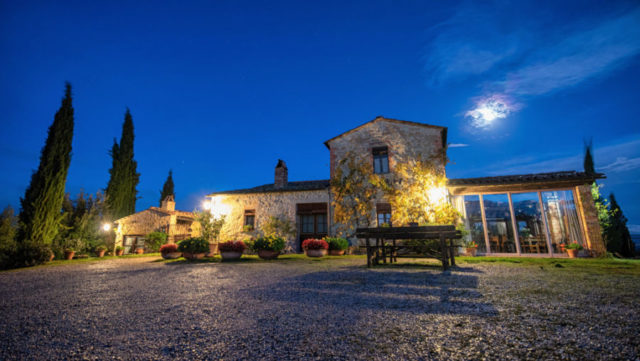
Italy has more than 20,000 agriturismi : farms that are subsidized by the government to introduce travelers to a unique pastoral lifestyle. Agriturismi are required to be working farms (that is, they must actually produce something) while also offering accommodations, restaurants, educational activities, or all of the above. Settling into an agriturismo , you meet fascinating locals and feel close to the earth. It’s like summer camp for grownups. We recommend our favorites in the Rick Steves Florence & Tuscany guidebook , and you can also find a comprehensive list at Agriturismo.it .
Read more about one of our favorite agriturismi : Cretaiole, just outside of Pienza.
Play “King of the Castle” atop a Fortified Tower
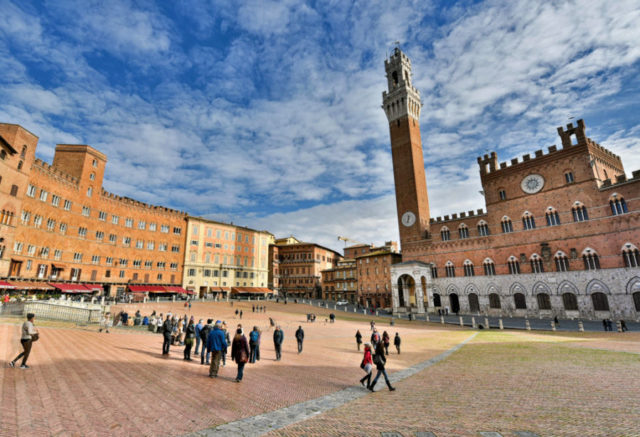
Tuscany is crazy about its towers — whether it’s the turreted townhouse of a wealthy local bigwig in San Gimignano, the fancy facade of a humble town hall in Montepulciano or Volterra, the towering City Hall of Siena, or the famously tipsy bell tower at Pisa’s Field of Miracles . Tuscany’s towers date from a time long before there was an “Italy” — when this area was a loose collection of city-states and wealthy families, all vying for the upper hand. Towers both served a defensive purpose and stood as status symbols for proud communities. That architectural legacy is a boon for today’s travelers, who enjoy climbing to the tops of these towers for views over the rooftops and rolling hills of Tuscany.
Learn more about the roots of Tuscany’s obsession with towers.
Lick Artisanal Gelato

My favorite gelato artist in Tuscany, Nicola Sgarbi, is a perfectionist…a total gelato snob. He makes several batches fresh every morning, so they’re not even available until mid-day. And then, in the late afternoon, when they’re gone — they’re gone. But if you’re lucky enough to hit his shop when he’s all stocked up, you’ll enjoy his explosively flavorful creations. Nicola goes all-in on seasonal flavors (creamy basil), surprising combinations (carrot-ginger, kiwi-spinach), and top quality. Nicola’s gelaterie — in Pienza and in Montepulciano — are just two of many great places to try top-quality gelato in Tuscany.
Get to know my favorite gelato artist, Nicola. Or study up on how to sniff out the best gelato wherever you go, anywhere in Italy.
Get to Know the Etruscans

Hold on! Stick with me. Don’t let your eyes glaze over. I know — when compared to things like gelato and Michelangelo and pappardelle alla bolognese , it’s hard to get excited about the people who lived in Tuscany 3,000 years ago. But the Etruscans may well be the most fascinating prehistoric people you’ve never even thought about. Not only did their advanced culture lay a foundation for the ancient Romans, and ultimately for all of Western Civilization. Not only did they warn Julius Caesar about the Ides of March and give their name to the region of Tuscany. But, despite all of this, the Etruscans left virtually nothing tangible behind — shrouding their distant civilization in mystery. A few tragically under-visited museums around Tuscany display what does survive, including delicate artwork (like the hauntingly beautiful statue called The Evening Shadow, or L’Ombra della Sera) and evocative funerary urns, showing Etruscans with big personalities lounging at an eternal banquet for the gods. Give the Etruscans a little bit of your touristic attention…and you may just find yourself entranced by the stories they have to tell.
Here are a few of Tuscany’s top Etruscan artifacts, and where to find them.
Sail Away to Elba for an Island Getaway

So much of the traveler’s Tuscany is rolling farm fields, world-class art, stony hill towns, and hearty, meaty cuisine. For a change of pace, consider hopping a ferry for the one-hour crossing to the little isle of Elba. I went there earlier this summer (researching a new chapter for the upcoming 18th edition of our Rick Steves Florence & Tuscany guidebook ) and was totally charmed by the place. Elba is synonymous with Napoleon, who was exiled here for 10 months after his bitter defeat. Today, touring his now-shabby residences is poignant. But there’s much more to this rocky little island: pebbly beaches, hardworking harbors, seafood dinners, and a truly terrifying gondola ride. Elba makes for a relaxing island escape from a busy Tuscan itinerary.
If you’re intrigued by the idea of splicing a little Tuscan seaside into your trip, check out my full report on Elba.
Take a Cooking Class
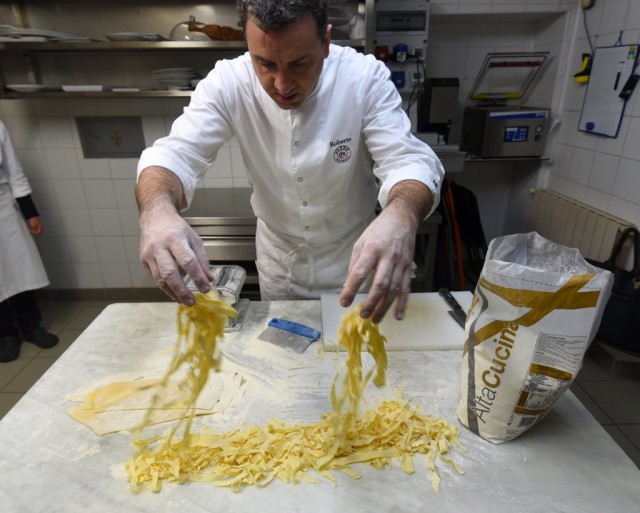
“Tuscan cooking classes” are an entire subgenre of travel. I’ve blogged more about that subject than I have about entire countries. That’s because this region has an outrageously appealing food culture — ranging from big, sloppy plates of pasta to refined high cuisine. And there’s a cooking class for every taste: hand-rolling pasta in a casual, family-friendly setting; going to the private residence of a talented home chef to assemble a seasonal feast; hanging out in the kitchen of a Michelin-star chef ; and everything in between. Also remember to look beyond the kitchen. While not technically a “cooking class,” going on a truffle hunt in a Tuscan forest — chasing after a smart-as-a-whip dog who has the scent of those precious deposits — gives you a whole new appreciation for a plate of truffle pasta.
For inspiration, here’s a rundown of my all-time-favorite Tuscan cooking classes.
Linger on a Convivial Piazza and Join the Passeggiata
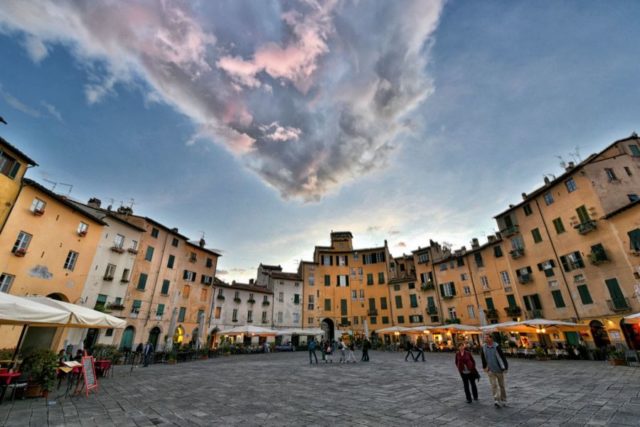
Tuscany is all about community. And there’s no better place to commune with the Tuscans than on the piazza, or main square — particularly in the late afternoon, when families are out strolling…doing those aimless laps that they call the passeggiata. Each Tuscan town’s piazza has its own special character: Florence’s is in the shadow of the towering Palazzo Vecchio. Pienza’s is a perfect Renaissance cube. Lucca’s follows the footprint of an old Roman amphitheater. And Siena’s — the best of them all — is a vast, slanted, brick-paved oblong that hosts a twice-yearly horse race. These are places where it’s actually worth paying way too much for a fancy aperitivo for the privilege of just hanging out at an al fresco table and getting serious about people-watching. Then, hop out of your chair and join the informal people parade as it promenades through the traffic-free town center. Become a temporary Tuscan. Come to understand the local saying, il dolce far niente — “the sweetness of doing nothing.”
Looking for the ultimate Tuscan piazza? Check out this “best of” list.
Visit Off-Season — and Have the Place to Yourself
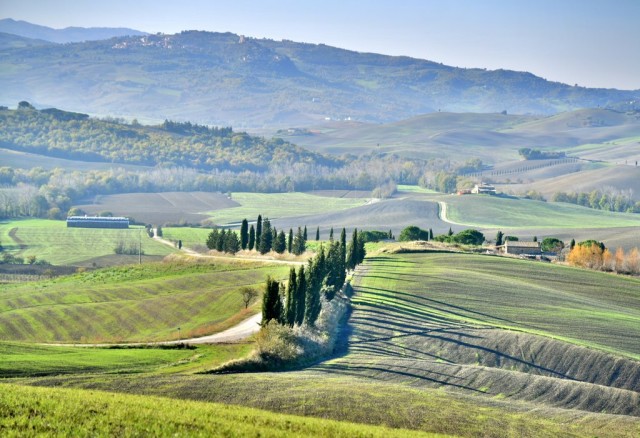
Tuscany — like other popular European destinations — can be extremely crowded. Fortunately, the region remains entertaining off-season, when things are much quieter. One of my all-time favorite trips to Tuscany came in late November . It was chilly but not cold, a crop of winter wheat blanketed the hillsides with a green vibrancy, seasonal ingredients (like chestnuts, persimmons, and truffles) infused each meal with autumnal flavors, and — best of all — we could simply show up spontaneously at museums and restaurants that would have been mobbed a few months before. While off-season travel comes with its downsides (cooler weather, earlier closing times, fewer daylight hours), visiting Tuscany outside of peak season can be a great plan for flexible travelers.
Here’s what to expect in off-season Tuscany.
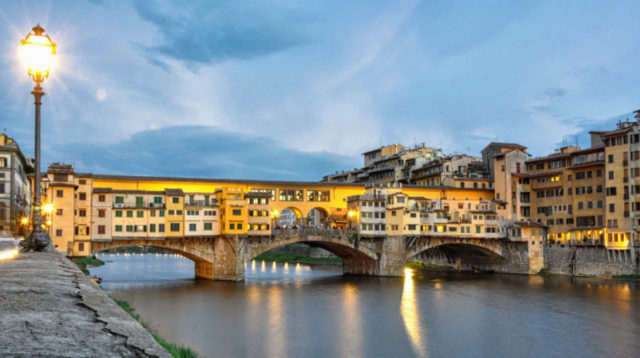
There’s so much more that I haven’t covered here — cycling around Lucca’s ramparts , taking a dip in the Roman-era hot springs of Bagno Vignoni, doing a tasting of high-end “Super Tuscan” wines at a Florentine enoteca — but hopefully this is enough to stoke your wanderlust for your next trip to Tuscany.
What have I forgotten? What are some of your favorite Tuscan experiences?
This roundup is designed to inspire you to pack your trip with quintessential Tuscan experiences. For all of the details on everything described here, check out our Rick Steves Florence & Tuscany guidebook .
Or…let someone else do all that planning. My inspiration for this piece is the arrival of our just-announced Best of Tuscany in 12 Days Tour , which weaves together, in some form or another, virtually all of the experiences I’ve described here. I’ve already signed up for one of the 2020 departures — just for fun (no work this time, I promise). Maybe I’ll see you there.
21 Replies to “How to Experience the Best of Tuscany: 12 Travel Tips for Italy’s Heartland”
Cameron, Just wondering if you, Sarah Corfield, or any of the guides (including Rick) have been to ‘Basco della Ragnaia’, just outside the village of San Giovanni D’Asso? It’s an interesting art garden of an eccentric (U.S., I think) artist, open to the public. I thought the village was fun, also.
It’s a great garden. The story behind that garden is very special. We had one of our most memorable lunch up at the castle restaurant in town.
Hi, Rick. Yes, I have been to that lovely garden! It is, as you describe, somewhat eccentric and an enjoyable place for a little walk. In fact, I went there once after a truffle hunt (with the hunter and his dog), simply to learn about the garden. Suddenly the dog got excited, started digging, and discovered a truffle right in the middle of a pathway through the park. San Giovanni d’Asso itself is a nice little town (and very striking from afar, since it perches on a little plateau). Many great truffle-focused eateries there…
My trip was in 2005, Loved it, wish I could live the there, did almost everything you suggested except cooking class, not enough time.
We stayed in an Agriturismo outside of Orvieto and had the most amazing farm to table communal meals there with guests from all over the world. Highly recommend!!
What was the name of the place you stayed? It sounds lovely. Thanks
What was the name of that farm to table? We are looking close to Orvieto!
Touring Tuscany in May 2016 was a dream…I was lucky to have a seasoned traveler to Italy with me……..trying hard to pack in Florence, Cinque Terre, followed by a leisurely week in Lucca ( followed by 5 days in Montepulciano )where we rented a lovely apartment and got to know the local baker and the veg &fruit lady…… we rented bikes and rode the rampart surrounding the town…..but the very best experience was a live concert of Puccini arias in a lovely old church ( since Puccini spent some time in Lucca….the town has claimed him as their own… with concerts one evening a week pretty much throughout the year…..front row….we could most reach out and touch the performers…..breathtakingly beautiful ! 4+ stars !
We attended that same opera while visiting Lucca. Then went on to have one of our most outstanding dinners while in Italy. It was one of our best memories of that trip.
We love Tuscany…have been to Cesare’s workshop where he made a gift for us. We stayed at a marvelous B &B in Montalcino. And a wonderful Agriturismo just outside Assisi….we had a glorious view of Assisi and could easily hear the church bells pealing. As an added bonus we were able to throw open our shuttered windows….it was April and the nights were cool…and one of the resident cats hopped through the windows and spent the night in bed with us!
I’m so excited cuz I’m booked on the September departure of the Tuscany tour. Thank you for this new tour and thanks so very, very much for all the wonderful experiences I’ve had with your tours. You have changed my life in such a wonderful way that I can’t even express. Happy Travels!!!
I want to move there! Looking into it…
Hi Steve, your Italy book recommended one of my favourite little towns, “civita di bagnoregio” if someone wants to travel off the beaten path. I found it a magical place to visit.
My wife, Sandy, and I have been to Italy several times and Tuscany is our favorite. Our last visit was in April, 2017 and we stayed two weeks in a condo located in the serene countryside near Assisi. We rented a little Fiat 500 and enjoyed day trips from our home base, buzzing along the narrow country roads throughout Tuscany and Umbria. We chose one destination per day, soaking in the scenery and ambience of each, visiting farmers markets and vineyards, and enjoying an inexpensive lunch (usually per Rick’s recommendations). Of course, we always indulged in a mid-afternoon gelato, too! During each day’s jaunt, we loved speaking with the locals in our limited Italian and they seemed to love (and get a kick out of) our attempts to do so! We usually returned late to our little condo and I cooked up the fresh veggies and pasta that we purchased for a few Euros along our journey, enjoying it with a little Tuscan vino and fragrant bread. Over dinner, we discussed our plans for the next day’s adventure. This was our favorite visit to Italy and our takeaways were: 1) spend a couple of weeks in one homebase location (if possible); 2) rent a vehicle for sightseeing in Tuscany; 3) Learn a little Italian and speak to the people you meet; 4) Try doing some of your own cooking with the amazing, fresh Tuscan produce; 5) Enjoy a daily glass of Tuscan wine and, of course, a gelato!
My wife and I have been to Siena three times, but the most memorable visit included two days before and after the New Year, especially because of the magnificent 360-degree video projection in the palazzo leading up to the New Year countdown. As fate–and the surprising Italian planning would have it–the video was completely Beatles themed, if I recall correctly. Everyone in attendance sang along to the group’s many hits and without a hint of an Italian accent. The thing that made the night most memorable, however, was that in the two or three hours before the celebration, a steady rain had been falling and we had waffled on whether to go to the party. We’ve always been glad that we decided to go. However, I’m still upset with the local guy who kissed my wife at the stroke of midnight before I did. (I just checked my records, and the end of this year will mark the tenth anniversary of that visit.)
PS: We don’t go to Europe without a Rick Steves’ book to guide us.
We have been to Cretaiole several times and it is our favorite place on earth. Isabella taught us to make pici. One visit was at Halloween, a fabulous time of year to go! The harvests and cooler air, the scent of roast chestnuts in Pienza, the warm uncrowded waters of Saturnia were unforgettable.
Tuscany and the Cinque Terre are our favorites. One night in Vernazza, we sat on the cliffs with a view of the full moon over the Mediterranean! And fireflies (none where we live) just added to the magic.
Ugh, five weeks from today I was heading to Italy to start the new Tuscany tour. Oh well. Hope to do it in the future!
Looking for recommendations for moving about Tuscany in Oct 2021. We are a group of 6 and we would like to spend 2-3 nights in area as we move from Cinque Terre to Florence. We think we’d like a driver/ vehicle so we could travel about together. To rent our own van doesn’t make sense. Also favorite lodging is appreciated.
Hello Cameron, Thank you for this delightful article. We all know how 2020 turned out but thankfully there is 2022 coming up and we signed up for this tour. I’ll be scouring more through the links you posted so we can maximize our time in Tuscany next year. Can’t wait!
Thank you Cameron..love all the information. Our 7th Rick Steves tour coming up! We just signed up for Best of Tuscany in May, 2022. We’ve been on the wait list..got in..so excited..celebrating my 71st B’day!
Leave a Reply Cancel reply
Your email address will not be published. Required fields are marked *
Experience the best of Tuscany with this regional guide

Apr 7, 2024 • 11 min read
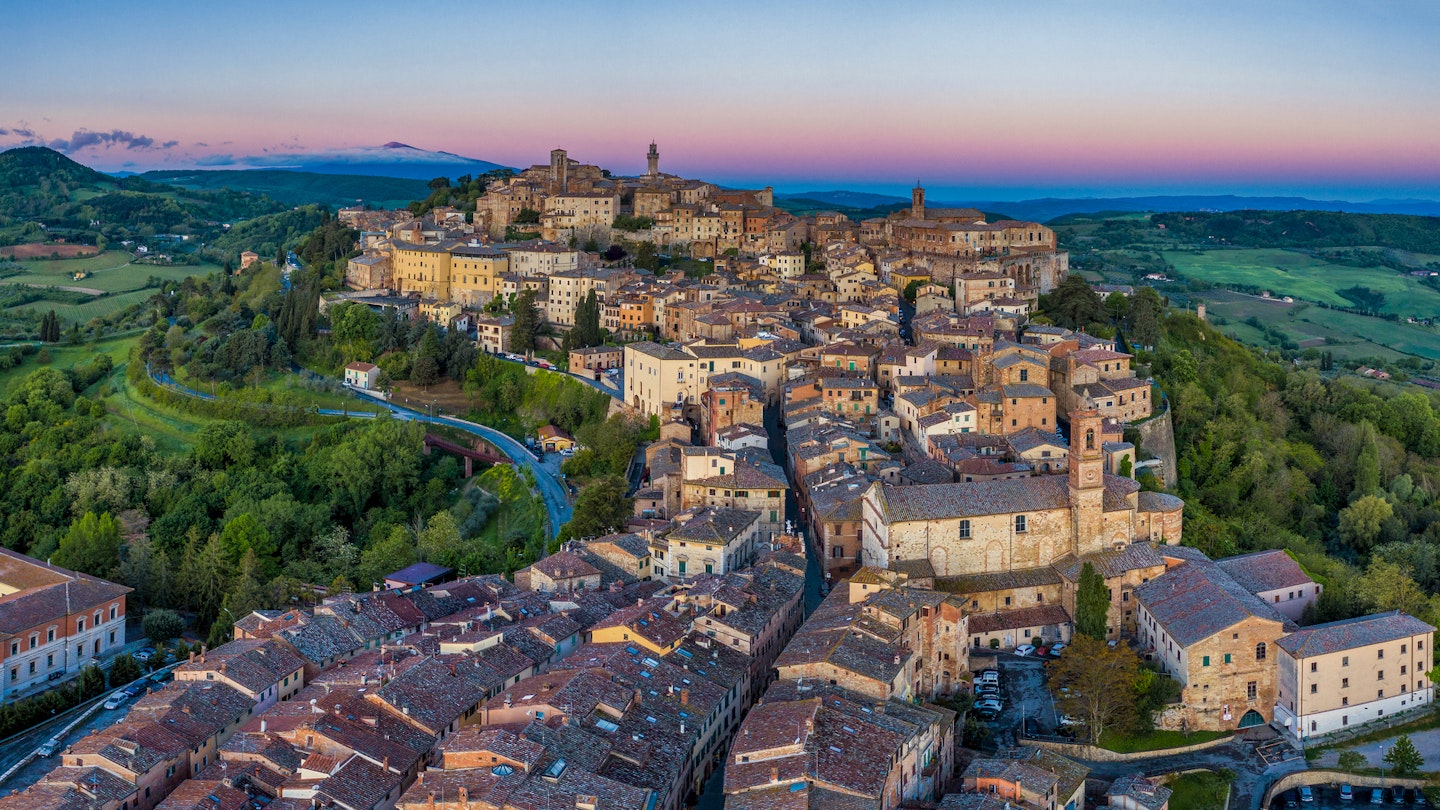
Have the most memorable trip to Tuscany with this comprehensive guide to the best of the region © Gavin Hellier / Stocksy United
Tuscany escapes easy definition. The Apennines – Italy’s mountainous spine – slope into vineyard-covered rolling hills, which in turn fade into the Mediterranean coast. This blend of diverse landscapes is home to the remains of millennia-old Etruscan settlements, isolated hamlets whose stone-built bell towers date back to the Middle Ages, and grand art cities whose heritage is invaluable.
With sarcasm being the local language, Tuscans may not seem to take such wealth too seriously. Understanding the many different facets of this rich Central Italian region can feel overwhelming. Florence tends to grab most of the attention, but it's worth exploring beyond the Renaissance city to discover more unexpected treasures.
Whether you are planning an art-filled tour of medieval cities, a road trip through the twisting countryside roads of Val d’Orcia, or a multi-day hike along the Via Francigena pilgrim route, here is how to figure it all out.
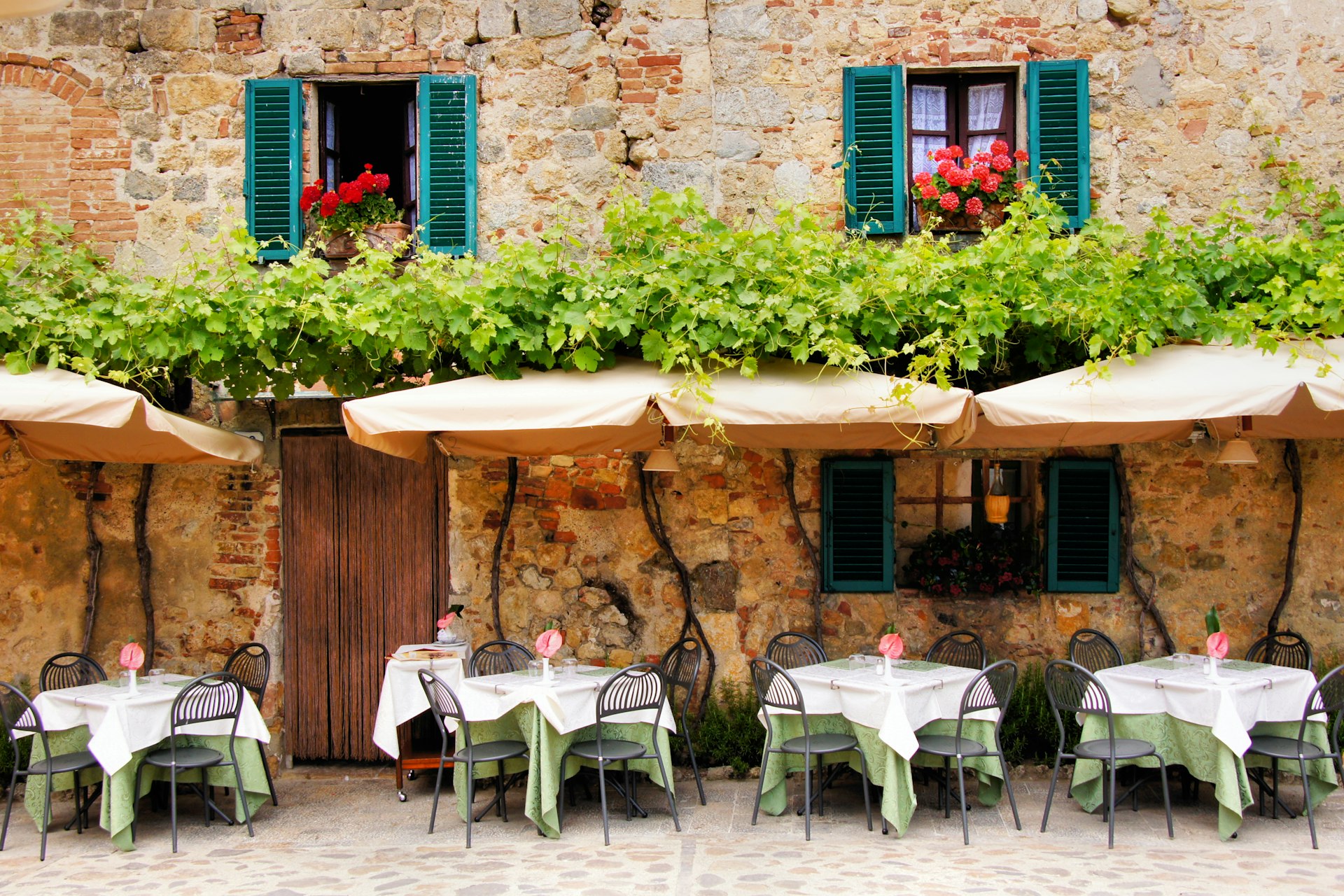
When should I go to Tuscany?
Late spring to early autumn is when most people visit Tuscany. It’s easy to understand why – days get longer and warmer, the countryside comes to life, outdoor dining opportunities abound, and festivals happen all around. Florence runs its Calcio Storico tournament and the region’s largest music festival, Firenze Rocks ; Siena has its traditional Palio horse race; Pistoia hosts its Blues Festival ; and Cortona its International Photography Festival (and there’s more).
July and August are peak holiday season. It’s when most Italians go on holiday and temperatures get scorching – days surpassing 35ºC (95ºF) have become the norm at this time of the year. Visiting in the middle of summer (especially in August) means finding beaches clogged and cities empty. Prices are significantly higher in popular destinations and booking accommodation in advance is well advised.
The two shoulder seasons – either between late April and June, or in September and October – typically offer the best compromise between good weather, flows of people, and prices.
Come in spring and you’ll see the countryside in full bloom; visit in autumn to catch the wine harvest – and related events like the Expo del Chianti Classico in September – and truffle fairs such as San Miniato’s White Truffle Exhibition in November.
Tourism slows down during winter, especially after the Christmas holidays. The coast goes into hibernation, and many countryside hotels shut down until spring. Cities offer the chance to visit famous museums without crowds – often at reduced prices, as is the case for the Uffizi in Florence – and deals on accommodation are more easily found.
How much time do I need to visit Tuscany?
With so much to see and do, it’s easy to feel overwhelmed in Tuscany. There is no perfect length of stay when it comes to exploring the region – whether you feel drawn to art, food, or the outdoors, you’ll likely leave looking forward to a second trip.
With walkable cities well-connected by public transport, five days will allow you time to tour Florence’s main sights and then jump on the train for a day trip in Siena , Lucca , or Arezzo . If you’d rather drive yourself, you can explore Val d’Orcia in about three days or plan a week-long road trip starting from Pisa which will take you through the rural towns that dot the hilly interior.
Slow travelers can also walk the path of the Tuscan section of the ancient Via Francigena – the pilgrim route that connected the Canterbury with Rome during the Middle Ages – crossing 38 municipalities over the course of 16 (or more) days.
Basing yourself in Rome? Here's how to plan a day trip to Tuscany
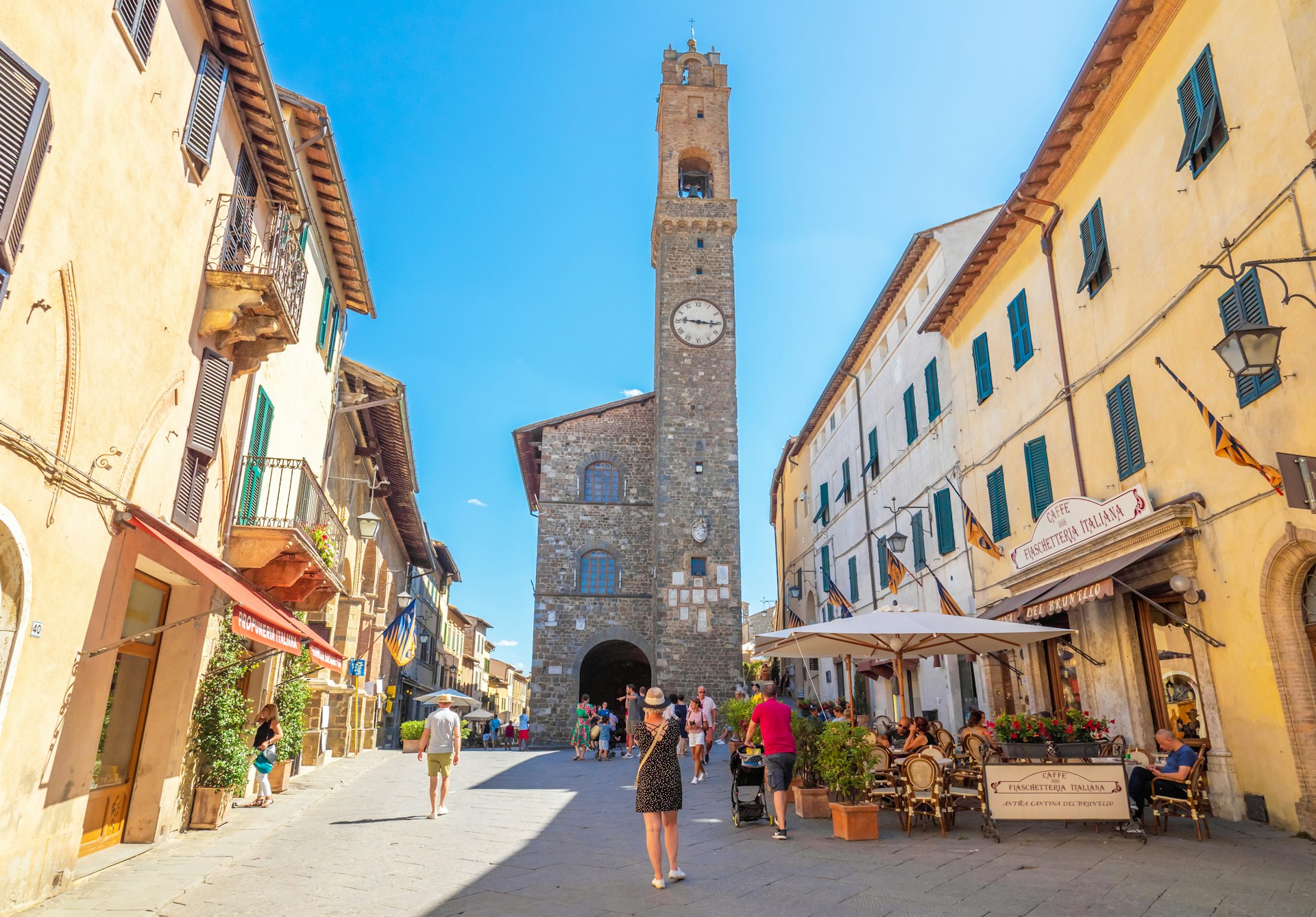
Is it easy to get in and around Tuscany?
Tuscany has two international airports, Florence and Pisa. Pisa's Galileo Galilei (PSA) airport is serviced by many low-cost airlines and has twice the passenger traffic of Firenze's Amerigo Vespucci (FLR) airport. The two cities are connected with a direct railway, which takes just over an hour to travel.
If you're not flying in from abroad, it is possible to reach Florence with high-speed trains departing from many major Italian cities, including Rome , Naples , Milan , Bologna and Venice .
Tuscany's rail network spans across 181 stations, providing an affordable means of exploring the region. You can buy regional train tickets conveniently through trenitalia.com, or at any station. Remember to validate paper tickets purchased at the station before boarding the train.
Trains do not run to many of the smaller towns and while buses are available, the best way of moving around rural areas is by car. Major rental companies, such as Budget, Sixt, Hertz, operate around Tuscany, with the largest offer available in Florence and Pisa.
Link your trip with these other great destinations in Italy
Where are the best places to go in Tuscany?
Tuscany is divided into ten provinces and people are famously proud of the defining characteristics of each. The days of warring city states are long gone, but by speaking to locals you will learn that food, dialects, and traditions can still differ widely from city to city – here is what to expect.
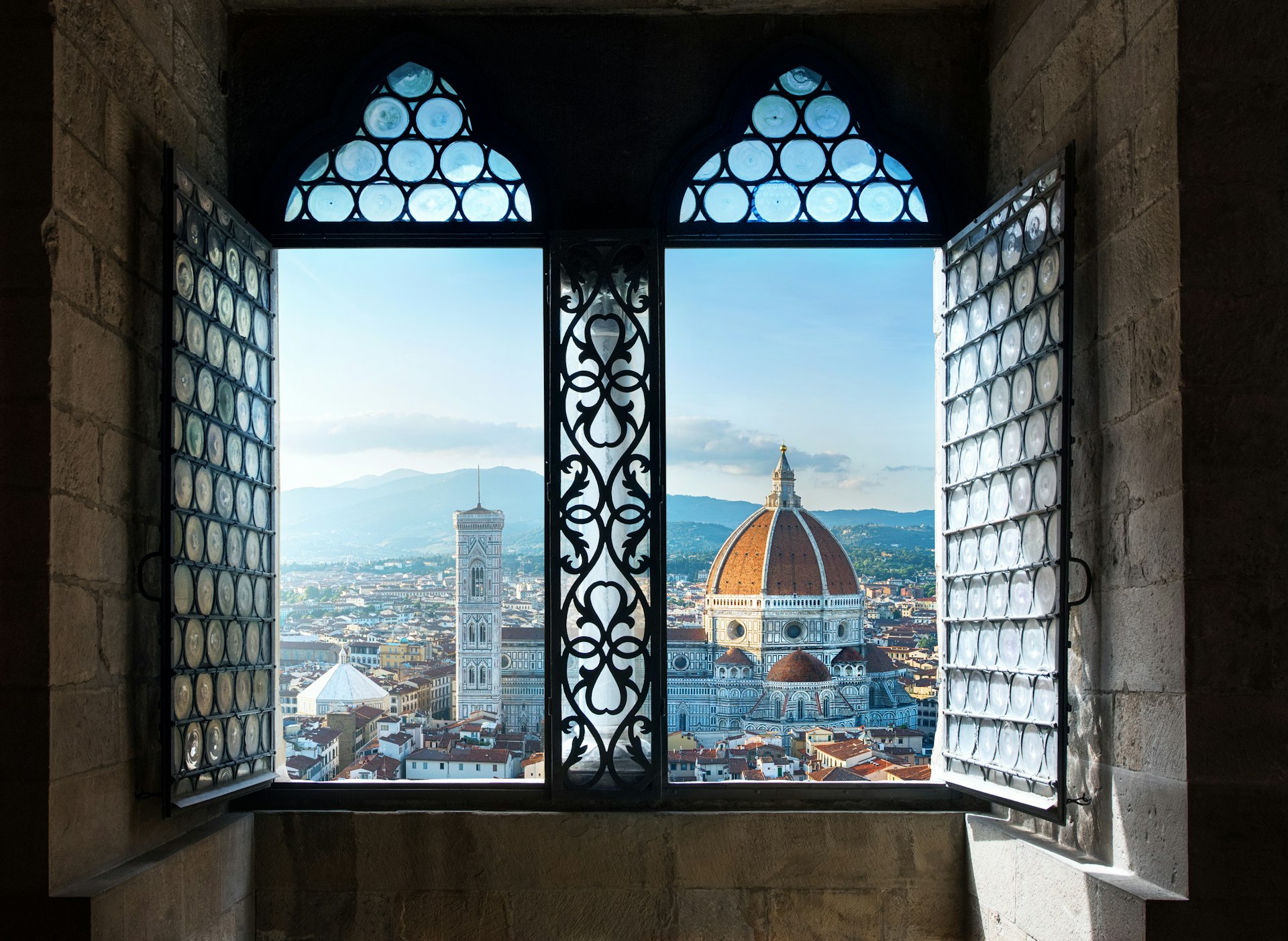
Renowned for its incomparable Renaissance heritage, Florence often feels like an open-air museum. The Tuscan capital is far from large, but its compact historic core packs grandiose cathedrals – such as Santa Maria del Fiore topped by Brunelleschi’s cupola, Santa Croce and Santa Maria Novella – opulent palaces, and some of the region’s best art museums.
The Galleria degli Uffizi , one of Italy’s most visited museums, tends to be high on everyone’s list, but there are plenty more options for art lovers including Michelangelo’s masterpieces in the Cappelle Medicee and the Galleria dell’Accademia , and the Medici’s heritage at Palazzo Pitti and Palazzo Vecchio .
Outside the thick stone walls of its captivating galleries, Florence boasts a cosmopolitan character and a vibrant culinary scene. Roam its markets in San Lorenzo or Santo Spirito , explore crafts and design workshops in the Oltrarno, and then fuel up with a stuffed schiacciata (Tuscan flatbread) at Forno Becagli or Sapori Toscani. Before dinner, get a negroni then hit one of the city’s many trattorias .
Traveling on a budget? Here are our tips for saving your euros in Florence
The Chianti region
The core of Tuscany’s most famous wine region stretches between Florence and Siena, offering as many tasting opportunities as you can imagine. The Strada Statale 222, better known as Via Chiantigiana, runs through the whole of the Chianti region north to south, twisting among vineyard-covered hills and medieval castles, making for an ideal road trip.
Antinori nel Chianti Classico , on the outskirts of Florence, is perhaps the region’s best-known winery – its futuristic headquarters in were completed in 2012, but the Antinori family has been in the wine business for over six hundred years, since Giovanni di Piero Antinori joined the Arte Fiorentina dei Vinattieri (Florentine Winemakers' Guild) in 1385. Many other wineries are found along the way, including the excellent boutique winery Capanelle and the imposing Castello di Brolio of the Ricasoli winery.
One of Tuscany’s most beautiful squares – Piazza del Campo – marks the center of Siena, Florence’s eternal rival that emerged during the Middle Ages as a progressive city-state where art and architecture flourished. Each year, the semi-circular piazza commonly known as “Il Campo” hosts the Palio, one of the most heartfelt events of the year in which Siena’s neighborhoods compete in a horse race with thousands of people watching.
Siena is worth spending a few days in, but if you are short on time make sure to enter its Duomo – Giovanni and Nicola Pisano, Pinturicchio, Michelangelo, Donatello and Gian Lorenzo Bernini all contributed to making the cathedral an unchallenged masterpiece. Don’t miss the floor, a composition of 56 marble panels forming a mosaic with scenes from the Old Testament, created by various artists between the 14th and the 19th centuries.
Val d’Orcia
The postcard image of Tuscany you have in mind likely comes from Val d’Orcia, the UNESCO-inscribed region where cypress-lined roads lead to dreamy farmhouses surrounded by hay bales that look like they are just about to roll down the hills. Films such as Anthony Minghella’s The English Patient and Ridley Scott’s The Gladiator have used Val d’Orcia as their backdrop and road tripping this region guarantees exceptional views all around.
Many charming towns dot this rural area. The construction of Pienza was commissioned to architect Bernardo Rossellino, a student of Leon Battista Alberti, by Enea Silvio Piccolomini, a humanist born who would become Pope Pius II in 1458, as the “ideal Renaissance city” and still stands as one of the main settlements in the Val d’Orcia. Nearby you can find the thermal waters of Bagno Vignoni and the fortress of Montalcino , globally revered for its prized Brunello wine.
The 12m tall walls surrounding Lucca’s historic center, built between 1513 and 1650 and stretching for four kilometers across eleven bastions, are among Europe’s best preserved fortifications and function as the city’s green lung with large parks and tree-lined paths offering great views over Lucca’s heart.
This charming city makes for an ideal day trip from Florence – inside the fortress walls, you’ll find Lucca’s Cattedrale di San Martino , where Gothic and Romanesque elements blend to form the structure housing one of Tuscany’s most precious artifacts, the celebrated Volto Santo (holy face) crucifix, believed to be one of the oldest wooden sculptures in Europe.
In summer the city hosts its Lucca Summer Festival , held in Piazza Napoleone. Over the years, artists such as Elton John, The Scorpions, Green Day, and Sting have played in the city. Another important event is the Lucca Comics & Games , one of Europe’s largest comics festivals held each year in autumn.
Pisa is often reduced to its leaning tower but there is much more to see, both inside and outside the UNESCO-listed Piazza dei Miracoli. In the Middle Ages Pisa was one of Italy’s most powerful maritime republics, and signs of its wealth are still part of this city which is now home of one of Tuscany's most important universities.
The monumental cemetery of Piazza dei Miracoli, established in 1277 to house the remains of the city’s elite, houses one of the city’s most important frescoes, the recently restored Il Trionfo della Morte (The Triumph of Death) by Buonamico Buffalmacco. Beyond Piazza dei Miracoli you find the new Navi di Pisa Museum which traces the history of the city’s relationship with the sea and features parts of over 800 ships excavated in Pisa’s surroundings.
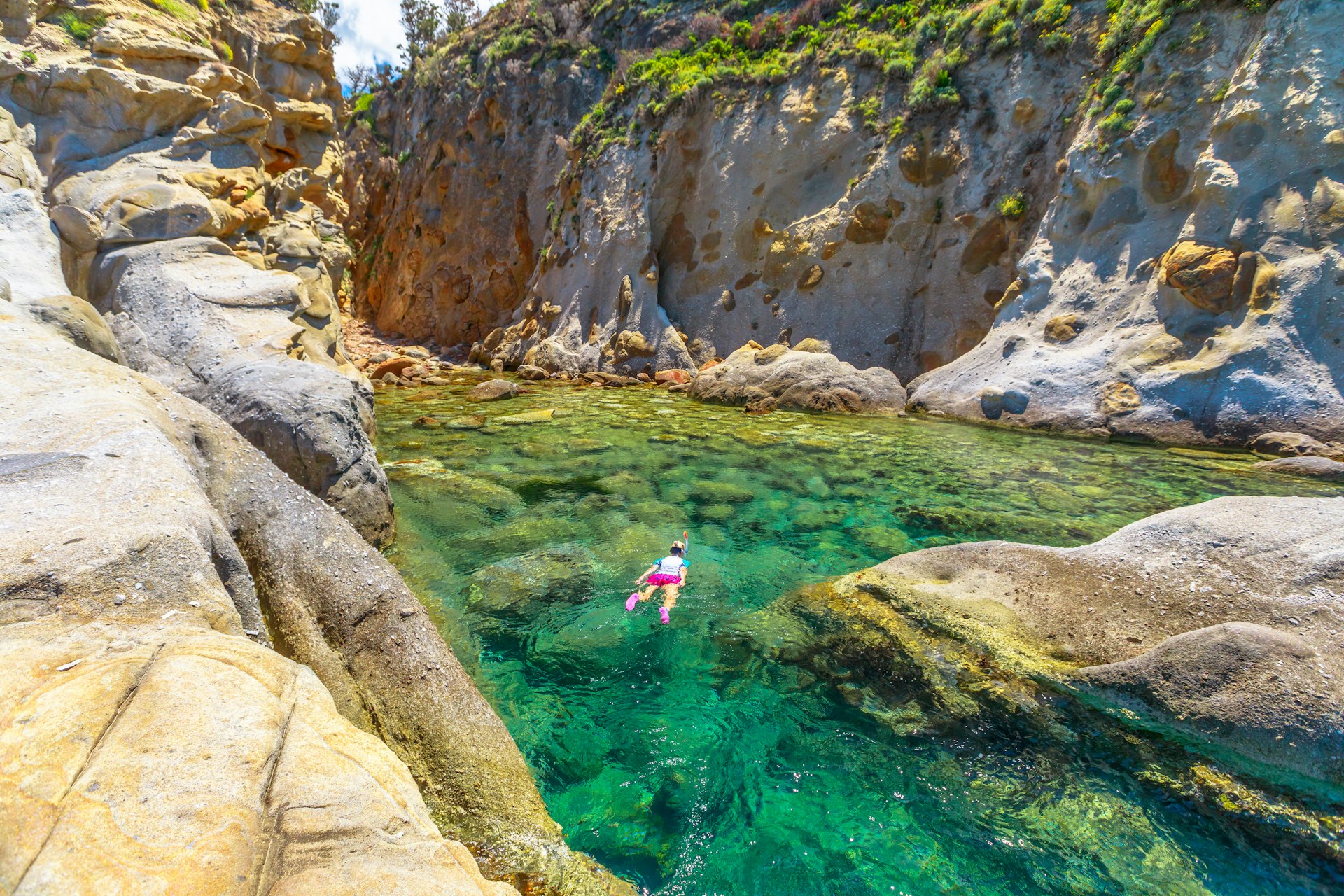
The islands
Distant from the museums and the cathedrals of the region's art cities are the seven islands of the Tuscan archipelago, ideally positioned for a Mediterranean escape after an overload of culture. The islands – Elba, Giglio, Montecristo, Capraia, Pianosa, Giannutri and Gorgona – come to life during summer and it’s worth booking accommodation well in advance if you plan to visit in the high season. Elba is the largest of the seven, offering both great beaches and hiking opportunities along its Grande Traversata Elbana (GTE, Elba’s Great Crossing) trail.
The Apuan Alps
The Parco Naturale delle Alpi Apuane stretches across two areas of northeastern Tuscany that few people take the time to visit, Lunigiana and Garfagnana. The rugged Apuan Alps take their name from their resemblance to the actual Alps, although they are much smaller in size with peaks under 2,000 meters.
Historically these mountains have been the main source of Carrara marble, extracted since Roman times in the quarries surrounding the city of Carrara. Today, much of the area is a protected nature reserve marked by a vast network of hiking trails. The hamlets of Castelnuovo di Garfagnana and Barga are good spots to start your exploration of the region – either by relaxing around the Lago di Vagli or committing to a multi-day hike along the Via Vandelli, connecting Massa to Modena.
How much money do I need in Tuscany?
Costs in Tuscany can vary widely depending on where and when you go. Prices tend to be inflated in areas that attract large tourism flows like central Florence and Siena and skyrocket along the coast during summer months. Still, it is possible to visit on a budget by relying on public transport and looking for accommodation deals outside peak summer months.
Find out what one visitor spent on a weekend trip to Florence
A guide to daily costs in Tuscany
- Basic double room: €80
- Espresso coffee: €1.20
- Car rental: €65
- A stuffed schiacciata sandwich: €5
- Dinner for two with a bottle of local wine: €70
- Museum ticket: €10€to €20
- Petrol: €1.80/liter
- City parking: €2/hour
- Aperitivo cocktail: €7
- Glass of wine: €5
- Train ticket from Florence to Pisa: €8.90
This article was first published August 2023 and updated April 2024
Explore related stories
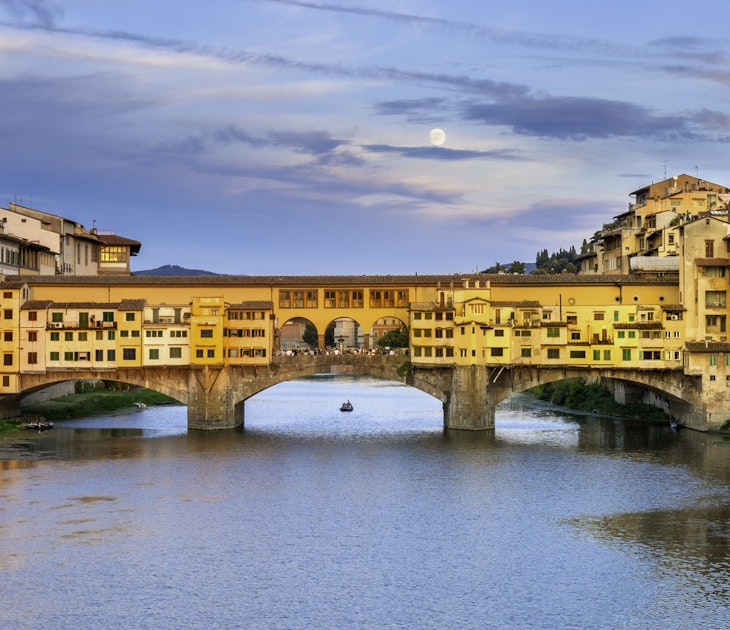
Budget Travel
Apr 21, 2024 • 7 min read
These budget travel tips can help your euros go further in Florence.

Apr 5, 2024 • 5 min read

Mar 26, 2024 • 6 min read

Mar 21, 2024 • 6 min read
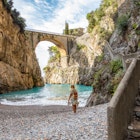
Mar 18, 2024 • 7 min read

Mar 15, 2024 • 10 min read
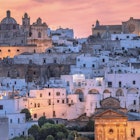
Mar 13, 2024 • 7 min read

Mar 8, 2024 • 17 min read
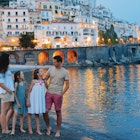
Mar 8, 2024 • 6 min read

Tuscany Itinerary: See the Best Places in One Week (+Map & Tips)
By Author Jurga
Posted on Last updated: July 4, 2023
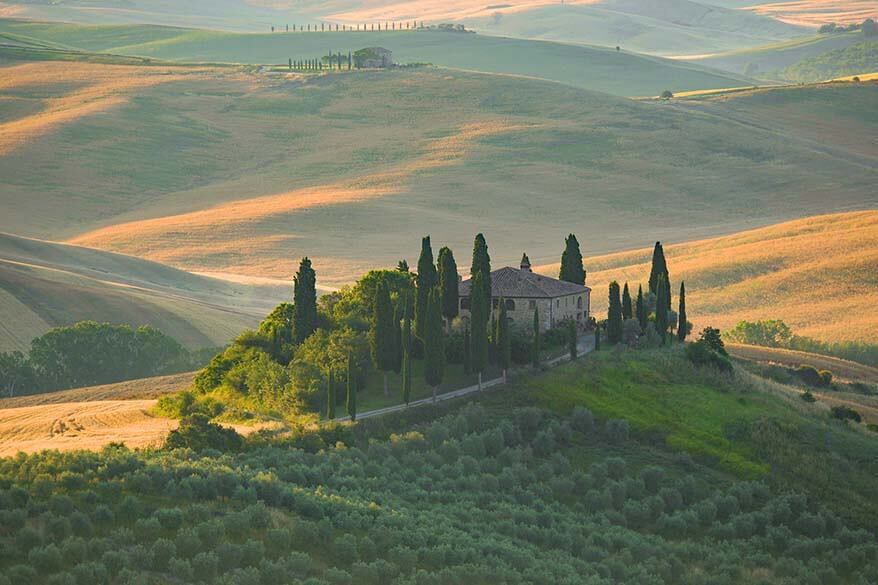
Planning a trip to Tuscany and not sure where to start and what’s the best Tuscany itinerary?
In our previous post, you could read about some of the most beautiful towns in Tuscany . In this article, you can read how to combine all those beautiful places (and some more) and create the perfect Tuscany trip itinerary that allows you to experience the very best of this picturesque region in one week.
How many days do you need in Tuscany
While you can see the main cities in 3-4 days, I recommend at least one week for Tuscany . This will allow you to see not just all the highlights of the best towns of Tuscany, but also to get a glimpse of the beautiful Tuscan countryside.
Below, you can find our suggested Tuscany itinerary that shows you where to go and what to see if you have one week in Tuscany. Read on!
How to see the best of Tuscany in one week
This Tuscany itinerary starts and ends in Florence. However, you can start and end in other towns and combine this trip with a visit to the other regions (e.g. Cinque Terre or Bologna ). This is really just meant to show you what’s possible and how to plan your time in Tuscany.
In order to see the very best of Tuscany and to experience some of its stunning landscapes, it’s best to visit the region by car. On the other hand, you don’t really need a car in the cities. Train connections between major towns in Italy are really good. So if you want to, you can visit some of the most beautiful towns using public transport only.
While this Tuscany itinerary is made assuming that you have a car, you can easily adapt it to your needs and your way of traveling. Just use this itinerary as a guide to the best places in Tuscany, how much time you need at each place, and how to best plan your trip.
At the bottom of the article, you can also find a map indicating all the places mentioned in this Tuscan itinerary. Read on!
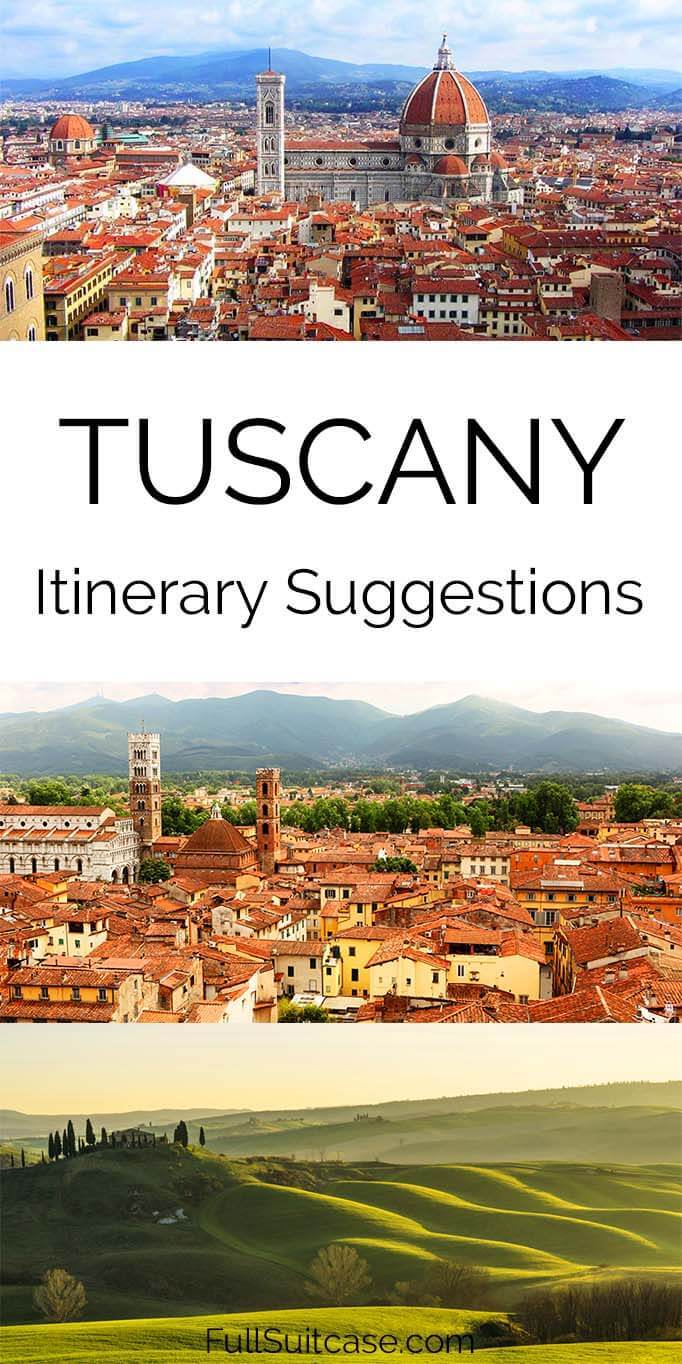
One Week Tuscany Itinerary
Day 1 – florence.
Florence is one of the most beautiful cities in Italy and is not to be missed in any Tuscany itinerary.
One full day is the minimum that you need in order to see the main highlights of Florence . You can find more information, tips, and advice for visiting Florence in some of the more detailed guides to the city on our blog.
Not to be missed in Florence is the Cathedral (you can climb the dome of the Duomo as well), Ponte Vecchio, Accademia Gallery, Uffizi Gallery, and Palazzo Vecchio. If you have just one day in Florence, stroll the old town, check out the market, and walk to Piazzale Michelangelo for the best sunset view in Florence. Alternatively, have a drink at one of the best rooftop bars in Florence .
Stay in Florence for at least one night, in order to take full advantage of your time here. If you are traveling by train, I recommend a hotel close to the railway station. We recently stayed at Hotel Croce di Malta , an excellent mid-budget 4*hotel with a lovely rooftop terrace. If traveling by car, keep in mind that parking in the city is very expensive.
TIP: If you only have limited time and want to see the best of Florence in one day, be sure to book priority tickets for ALL the places you absolutely want to visit inside.
LEARN MORE: One Day in Florence
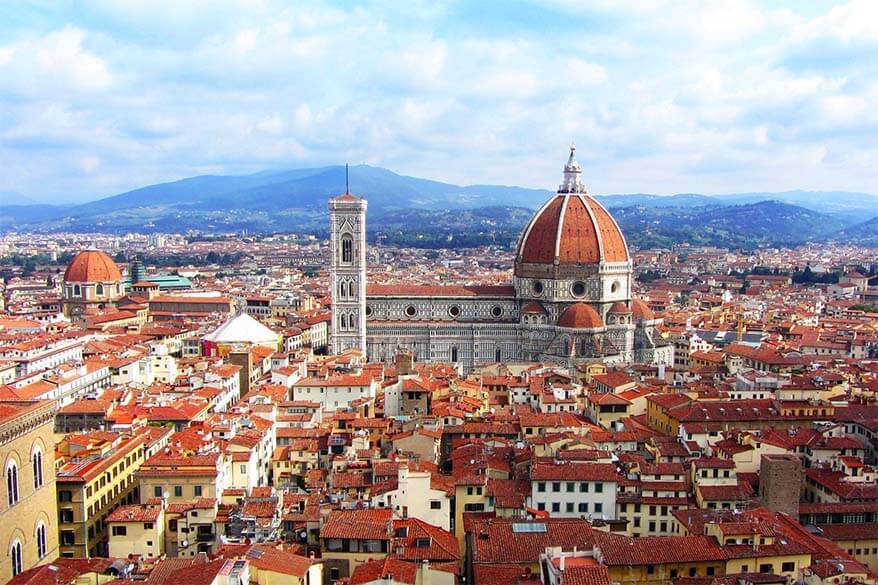
Day 2 – Florence to Siena
Leave Florence early in the morning and drive to Siena. Via Chiantigiana road SR 222 from Florence to Siena is very scenic, so you may want to take this road rather than a highway.
Spend the rest of the day exploring the beautiful town of Siena. Must-see in Siena is Piazza del Campo with its Palazzo Pubblico and the Mangia Tower, Siena Duomo (Cathedral), and the picturesque streets of the Old Town.
TIP: Stay in Siena for 1 or 2 nights. Albergo Chiusarelli is one of the best picks in towns in terms of price/location/quality.
LEARN MORE: Best Things to Do in Siena
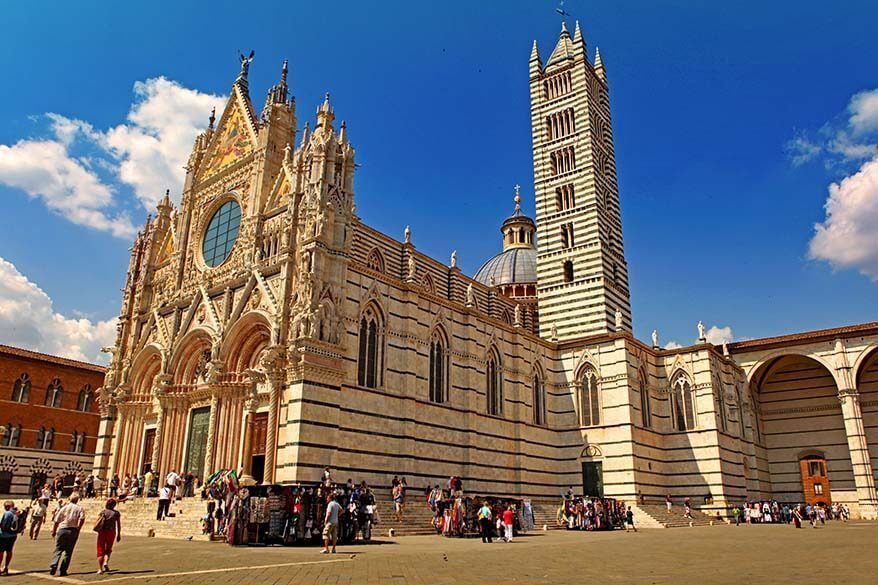
Day 3 – Val d’Orcia – Tuscan countryside
Here is a scenic road trip suggestion through the picture-perfect Tuscan countryside – Val d’Orcia – that you can take as a day trip from Siena.
If you have the time, you may want to spend a couple of days in this area, but one day is sufficient to drive through the scenic Tuscan countryside.
From Siena take the road SR2 to San Quirico d’Orcia. From here continue East along the SR146 in the direction of Montepulciano. This is the most scenic road in Tuscany – the one with the typical Tuscan landscapes you see in travel magazines and on postcards.
Take your time to explore Val d’Orcia and visit at least a couple of charming little towns in the area: Pienza , Montepulciano , San Quirico d’Orcia , Monticchiello , Montalcino … Also the Abbey of Sant’Antimo is worth a visit.
With just one day in this region, I think I’d focus on Montepulciano, Pienza, and the countryside of Val d’Orcia.
TIP: If you are in Siena without a car, the best way to explore the Tuscan countryside is by taking an organized tour, e.g. this wine tour that brings you to Montalcino, Pienza, and Montepulciano from Siena .
READ ALSO: Best Things to Do in Montepulciano

Day 4 – San Gimignano and Volterra
San Gimignano and Volterra are both relatively small towns and their proximity to each other means that you can easily visit them in one day.
San Gimignano , famous for its fourteen medieval towers has a tiny but very picturesque Old Town. It can get extremely busy during the day, so I recommend going there first thing in the morning.
One of the main places to see is Piazza della Cisterna. You can also climb to the top of the Torre Grossa.
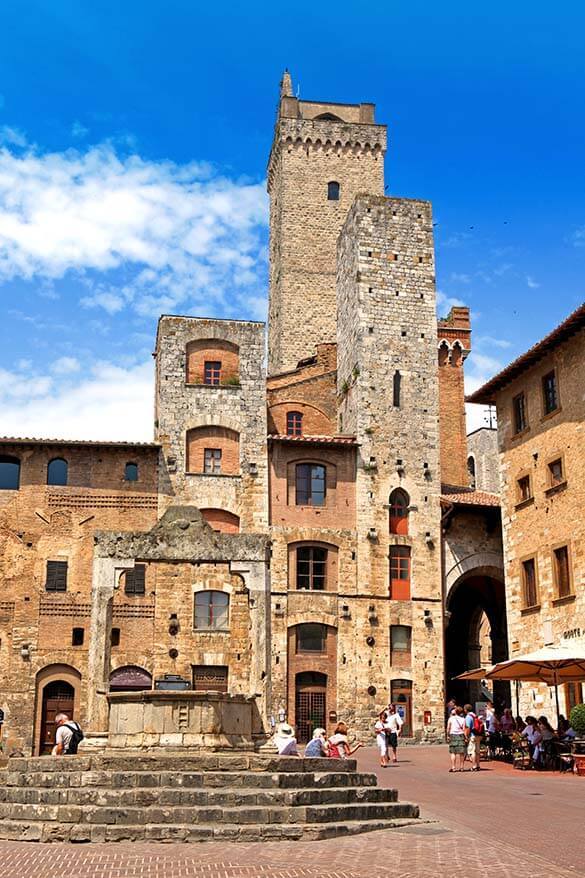
Volterra has a great atmosphere in the evening, so it’s best to visit it later in the day. It’s a charming medieval town and it’s nice to just stroll the streets, check out some souvenir shops, and have a nice Tuscan dinner.
In my previous post, you can read more about what to see and do in San Gimignano and in Volterra .
TIP: One of the nicest and good price/quality hotels in Volterra is Hotel La Locanda . If you are on a tighter budget but want something really special, stay in Chiostro Delle Monache Hostel Volterra . It’s located in the 15th-century Franciscan monastery, has a great location, and free parking.
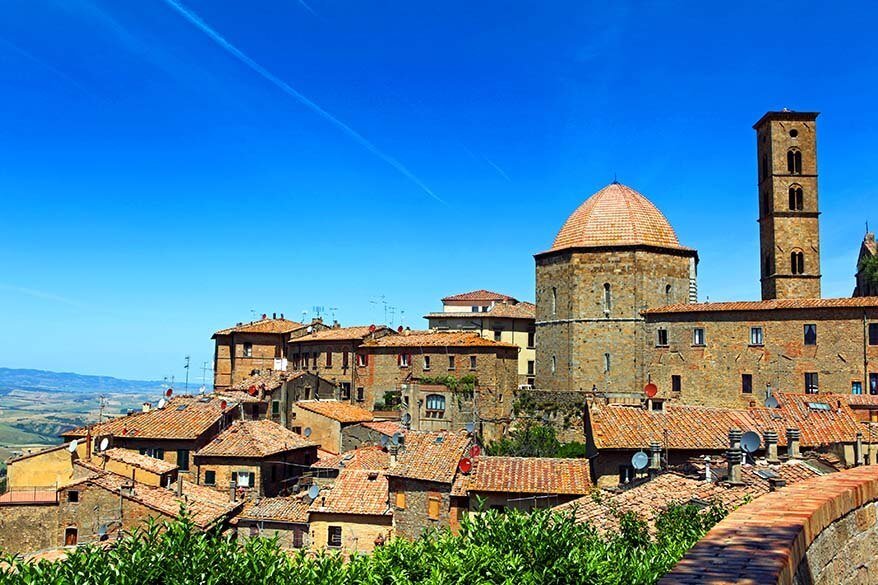
Day 5 – Pisa
Take your time to explore Pisa . Don’t limit your visit to the leaning tower of Pisa only! In fact, the leaning tower of Pisa is just one of the many monuments of Miracle’s Square. The Cathedral and the Baptistery are very impressive as well.
Pisa town center has no crowds and is very picturesque as well. Stroll the Arno River promenade and check out the Borgo Stretto, an old shopping arcade with many restaurants, cafés, and shops.
TIP: If you are touring around Tuscany by car, I’d advise not to stay in Pisa. Instead, drive to Lucca after you visited Pisa and stay there for two nights. Lucca has such a great atmosphere and several really nice hotels. They are located inside the city walls and so parking is not free (but possible). Check out Hotel Palazzo Alexander or Hotel Alla Corte degli Angeli .
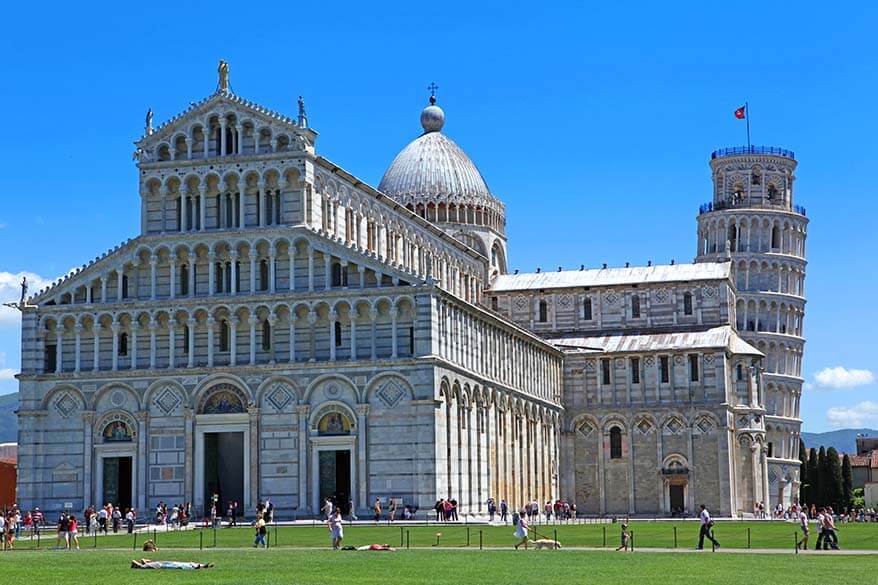
Day 6 – Lucca
Lucca is our favorite town in Tuscany. You can see the main highlights in just one day, but you definitely won’t regret it if you choose to stay a bit longer.
The main landmark is the city walls of Lucca which you can explore on foot or by bike. In fact, the best way to see Lucca is by taking a self-guided bike tour .
Piazza dell’Anfiteatro is another must-see in Lucca. Make sure also to climb at least one of the towers -Torre Guinigi or Torre Delle Ore for the best views in town. Here you can read more about what to see and do in Lucca .
TIP: Take a food tour in Lucca – it’s a great way to explore the town and taste some of the typical local specialties.
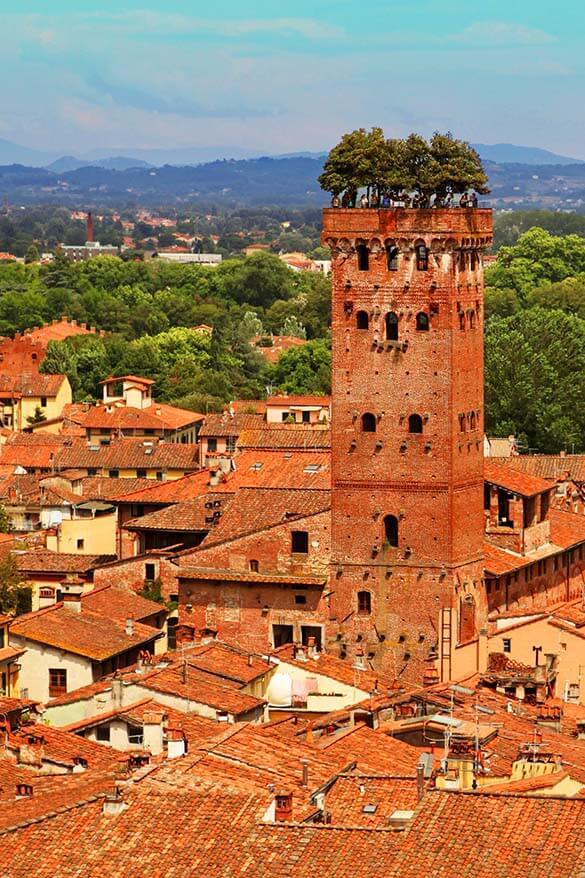
Day 7 – Collodi, Pistoia, Prato, or the outskirts of Florence
There are several nice towns that you could visit between Lucca and Florence. Collodi, Pistoia, and Prato are all worth a detour.
We liked exploring the outskirts of Florence as well. You’re hardly out of the city, but the scenery is amazing. Take a road from Florence to Fiesole for stunning views and a beautiful Tuscan landscape.
Alternatively, you could easily visit Bologna. It’s located in the nearby Emilia Romagna region (so not in Tuscany), but is more than worth a visit if you find yourself in this part of Italy.
READ ALSO: Florence to Bologna Travel Info & Itinerary + Best Things to Do in Bologna
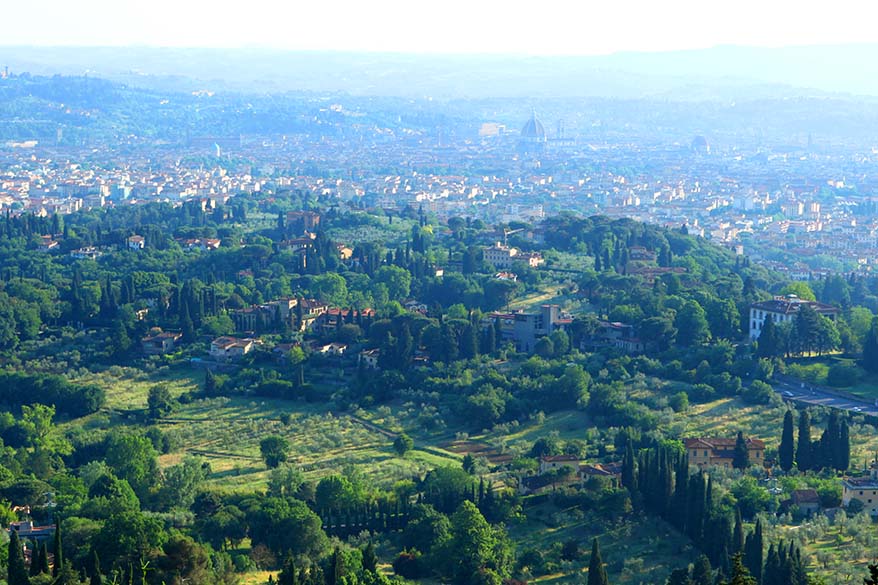
Where to stay for this Tuscany itinerary
Many people ask what’s the best area to stay in Tuscany . The answer really depends on what kind of trip you are planning.
If you are thinking of making a road trip in Tuscany , you can find my suggestions for hotels in each town in the day-to-day Tuscany itinerary above.
If, however, you don’t like changing hotels and packing your bags every day, you can also stay at one central location in the Tuscan countryside and take day trips from there. Sometimes you’ll need to drive an hour, sometimes two, so it’s not perfect, but it might still be easier and more relaxing, especially if you are traveling with kids.
TIP: If you want to stay in just one place for sightseeing, the best place to stay for exploring Tuscany would be the area close to Volterra or San Gimignano. It is very centrally located in Tuscany and is therefore ideal if you are looking to stay at just one hotel and explore the region by taking day trips. Here you can find the best deals for accommodation in Volterra and hotels in the San Gimignano area .
In fact, a few years ago we did just that when we were visiting Tuscany with our kids. We stayed at just one hotel in the Montaione area for 12 days and combined relaxing days by the pool with sightseeing. It worked well for us. You can read more in our best of Tuscany – itinerary from one central location post.
On our most recent trip to Tuscany, we were focusing on the area around Siena and Val d’Orcia, plus a few other places in Umbria too. For that, we opted to stay at this beautiful country house in Bettole.
There’s really not one ‘best’ spot to stay- Tuscany is way too big for that. So it all depends on which places you decide to visit.
Without a car: If you are not renting a car, the best places to stay for exploring Tuscany are either Florence or Siena. They both have good railway connections to the bigger towns and also a big choice of organized tours to the smaller villages in the countryside.
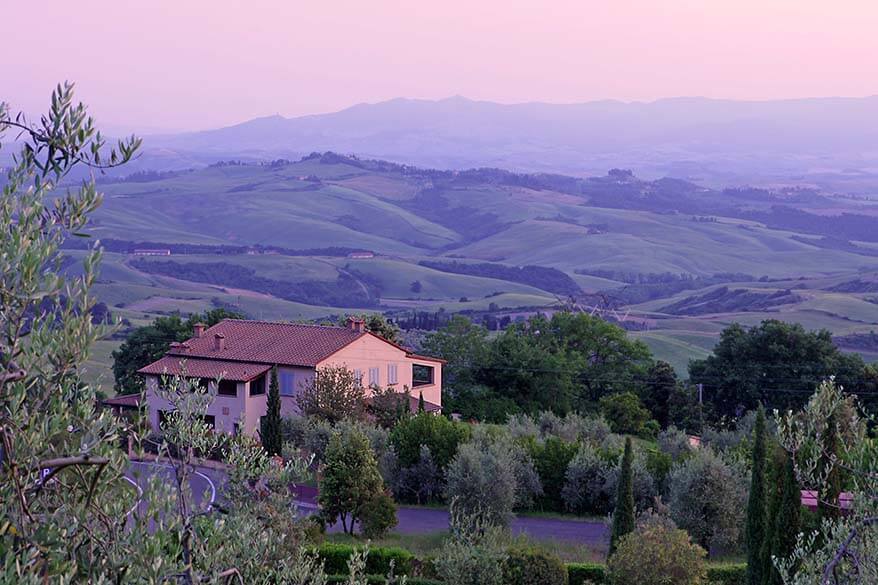
One week Tuscany trip itinerary map
Below, you can see an overview of this suggested Tuscany itinerary on the map.
Start in Florence, drive down to Siena, then on to San Gimignano and Volterra. Continue your trip towards Pisa and Lucca, and end in Florence.
Alternatively, continue to Cinque Terre, which is just a short ride from Pisa. Here you can find more information about how to see the best of Cinque Terre in one day .
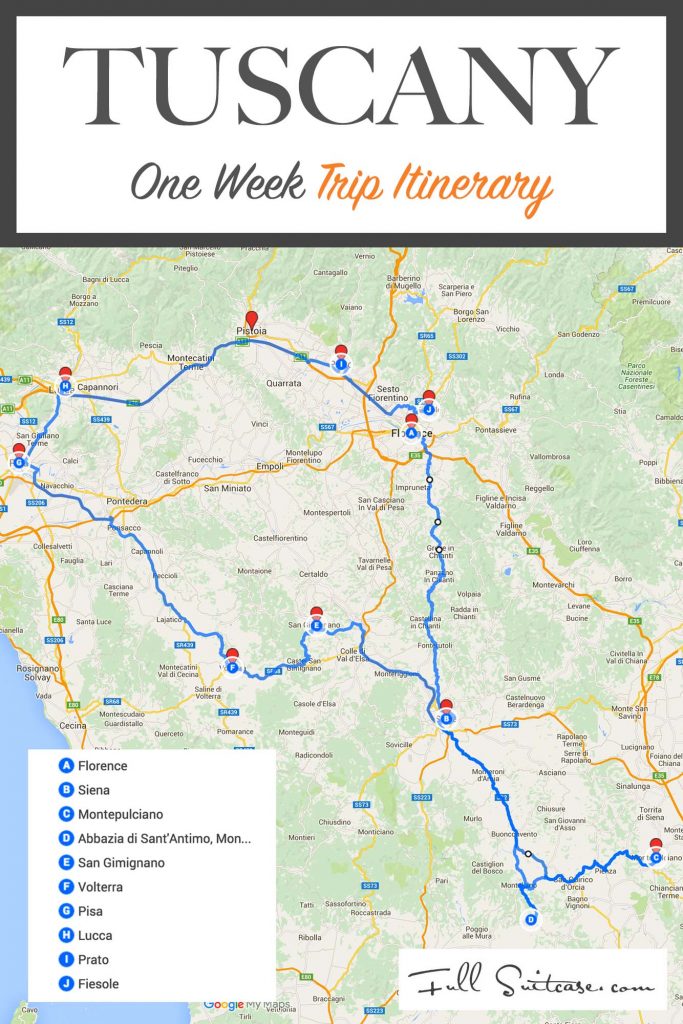
Best Time to Visit Tuscany
Tuscany is a beautiful destination that has something to offer at any time of the year. That being said, the best time to visit Tuscany is in late spring or in early autumn. The very best months for sightseeing in Tuscany are May and September.
In the summer months, it’s very hot here. So if you are visiting in July or August, you may want to concentrate on the Tuscan countryside. A popular thing to do is rent a villa with a pool and make an occasional day trip to one of the smaller towns in the area.
Whereas the weather in late fall, in winter, and in early spring is more suitable for visiting the big cities rather than touring the countryside.
READ ALSO: Best Time to Visit Europe
So, this is our suggested Tuscany itinerary for up to one week. If you are planning a trip to Italy, make sure to check our Italy travel guide for more tips and travel advice for a big variety of popular destinations in Italy.
Alternatively, check our selection of articles below for more tips for a variety of destinations in Italy.
More tips for some of the most visited destinations in Italy:
- Best Things to Do in Rome
- Best Things to Do in Venice
- Best Things to Do in Milan
- Best Things to Do in Naples
- 2 days in Rome
- 1 day in Milan
- 1 day in Venice
- 1 day in Cinque Terre
- Tips for Visiting Rome
- Best Things to Do at Lake Como
- Bellagio, Lake Como
- Best of Lake Garda
- Best of the Italian Dolomites
- Emilia Romagna Region
- Hiking in the Dolomites
- Tips for Visiting Cinque Terre
- Amalfi Coast Itinerary
- Italian Riviera
- Best Day Trips from Naples
READ ALSO: Best Places to Visit in Italy
If you found this Tuscany itinerary helpful, don’t forget to bookmark this post and share it with your friends. Are you on Pinterest? Pin this image!
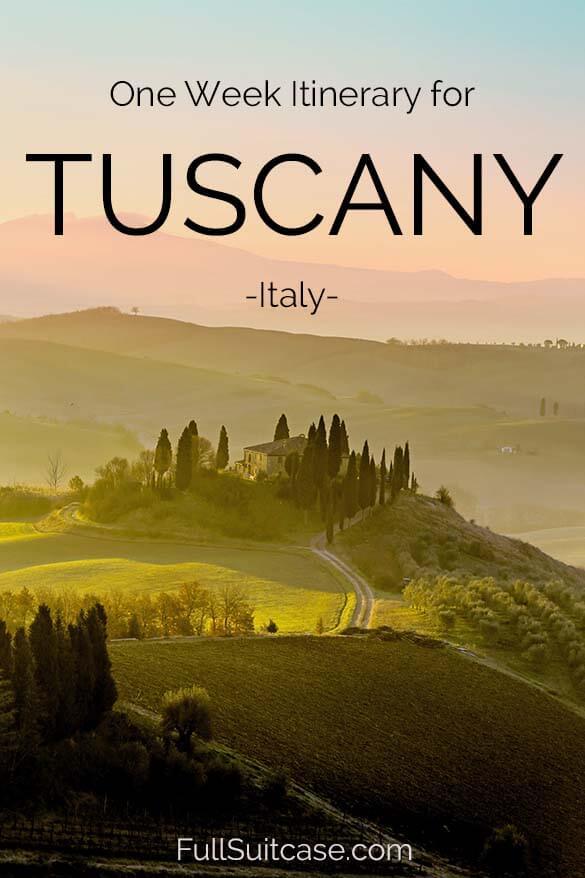
This site uses Akismet to reduce spam. Learn how your comment data is processed .
Monday 26th of February 2024
What a fantastic blog! This has really inspired me! I am thinking to visit Florence and Tuscany for a week in mid-June.
After 2 nights in Florence, and having a car, what town would you recommend to stay as a base and then do day trips? In terms of day trips, a must visit for us are Sienna, Lucca and Volterra. And definitely a winery but without driving to it. Advice very welcome!
Tuesday 27th of February 2024
Hi Teddy, if you want to visit Sienna, Lucca, and Voltera, you could stay somewhere in the middle between all these towns and make sure there's a winery nearby. I quickly checked something for you in the San Gimignano area which is very central and fits your criteria. There are several wineries that you can visit in that region and many accommodations, so you can find places to stay within walking distance to one or the other winery if you like. For example, this agriturismo (Capanna 1826) is just near this vineayrd. From what I read in the reviews of this accommodation, they even include a visit to their vineyard for free if you stay there. But there are many more options. You just have to do a bit more research and see what's available for your travel dates. If you don't mind taking a taxi to one or the other vineyard, then it will be easier. Just pick a hotel you like and then see what wineries there are nearby. Also, the San Gimignano area is just one of the many, so it's just a suggestion based on the info you gave. If you are traveling in June, I'd book your accommodations asap.
Ann Marie Pugliese
Friday 6th of October 2023
Hello, this blog seems very helpful. I am traveling to Italy for the first time with 9 family members for 2 weeks in June. We were trying to fit in so much, but don't think it's feasible with so many people. Was hoping to visit Venice, Tuscany, Rome and The Amalfi Coast. Also, we are planning to stay in Air bnb's along the way. Just not sure if we should travel to each area and stay for 3 days or find 2 central hubs and take day trips? Any insight you can offer would be greatly appreciated. Thanks!
Monday 9th of October 2023
@Jurga, THANK YOU SO MUCH!! Greatly appreciate the information!!
Sunday 8th of October 2023
Hi Ann Marie, since these areas are located quite far from each other and each has so much to offer, I think that staying in each place for a few nights is indeed better than looking for two base locations. You could start with 4-5 days in Sorrento (from where you can easily visit Amalfi Coast, Capri Island, Naples, Pompeii, etc.), then move on to Rome for 3-4 days. From there, take a train to Florence which is a good base for Tuscany, Cinque Terre, and also Bologna. Depending on what you want to see, you could stay here for 4-5 days. And finally, take a train to Venice and stay there for 2-3 nights. You can find lots of information for all these destinations on our blog. See an overview of all articles on our Italy travel page. This 2-week Italy itinerary might also be helpful - just to see what's possible and how you could structure your time at some places. For Amalfi Coast, take a look at this guide. Good luck with the planning!
Sunday 18th of June 2023
Hi, I am considering a 3 night stay in Florence next Summer followed by a week in self catering accomodation somewhere on the coast (we will not be driving, therefore, will be making use of public transport when we transfer from Florence to our second destination). We love Sorrento, Taormina and the Lake Garda towns and are wondering where on the coast (quite manageable by train from Florence), would have a similar vibe / buzz (i.e lively atmosphere) to these places? We would obviously fly into Florence but would be happy to go home from a different airport.
My other option is to follow on from Florence with a week in self catering accomodation (definitely with a pool to cool off), within walking distance of one of the cities / towns in the region - but I'm having difficulty deciding between Siena. Lucca and San Gimignano (or somewhere else with a Sorrento type 'feel' to it!!).
Any suggestions / advice would be gratefully received
Many thanks, Becs
Tuesday 20th of June 2023
Hi Becs, as you can imagine, there are too many options for me to give you any kind of reasonable suggestion. :) Also, there are two coasts - with places like Rimini or Ravenna to the east or the Cinque Terre area, Ligurian towns, etc. to the west. I assume you mean west? Without a car, by the sea, you could split your stay between the Cinque Terre area and Italian Riviera (e.g. Portovenere or Monterosso al Mare for a few days followed by a few days in Rapallo or St Margherita Ligure. If you are looking for a bigger city - check out Genoa. If you rather stay in central Tuscany, then Siena is definitely a lot better than San Gimignano - in terms of transport, things to do, etc. San Gimignano is a tiny village. Lucca is also very nice but not as centrally located as Florence or Siena for all the most popular places. Bologna is amazing too, btw! You can also just stay in Florence the whole time and make day trips. It also depends so much on what exactly you want to see. Good luck! Whatever you choose, you can't really go wrong - the whole area has so much to offer.
Kim Hendrickx
Monday 17th of April 2023
We are a family of 5 and we will be going on a week trip to Tuscany at the end of this month, We will be staying in a country guesthouse in Montaione. This will be our base to see different places in Tuscany, as we have a car. Could you recommend which cities are best to visit to get a real feel of Tuscany. We also want to do some wine tasting in Chianti and Montepulciano, so any tips on nice wineries to visit would be much appreciated. Thank you.
Hi Kim, you can find all the suggestions in this article and you may also want to take a look at this guide to some of the best towns in Tuscany. This is by no means a complete list and there are dozens of amazing places. But if this is your first time, you'll probably not want to miss the main cities such as Florence or Siena, so you need at least 2-3 days for that. The rest really depends on your interest and preferences. Of the smaller ones, San Gimignano is really nice, also Volterra, Montepulciano, and Pienza. If you have even more time, you may want to check out Montalcino and Cortona, also San Quirico d'Orcia. A week will fly by! As for the wineries, we really enjoyed a very unique wine cave visit in Montepulciano last summer. You can find more details in our Montepulciano guide. And this is a really nice winery that you can visit in Chianti. The problem with winery visits is that it's not really something you can do (and enjoy wine) if you have to drive afterward. So ideally, you have a dedicated driver, find a winery close to your accommodation and take a taxi, or book a tour (but those are usually only available departing from big towns so not ideal unless you stay in Florence or Siena). But definitely check out the wine cellar in Montepulciano if you go there! You can also taste just a bit of wine and buy some to take with you to enjoy at your accommodation. Enjoy your trip!
Tuesday 21st of March 2023
Looking for some advice on my trip to Italy in Aug/Sept. Flying into Venice and staying for 3 days then headed to Florence/Tuscany region for 5 nights. We don't want to rent a car but want to go wine tasting and check out the countryside and maybe the hill towns. After the 5 nights we head to Sorrento for 4 nights and finish off in Rome. Looking for advice on where I should stay in Florence/Tuscany area. Should I stay a few nights in both places or stay in one place and do day trips by train? Where do I take the train from to end up in Amalfi? Any advise appreciated.
Hi Rosemary, some of the best places to stay in Tuscany when traveling by train are Florence and Siena. You can find plenty of Tuscan countryside/wine tours from any of these towns (see here for tours from Florence and here - from Siena). If you don't mind changing hotels, you can spend a few nights at each of these; otherwise, I would recommend staying in Florence. There are many nice hotels close to the station (just in the center too), and it's very easy to explore the city or plan day trips. At the bottom of this guide of the best places to see in Florence, you can find some hotel recommendations for this area. For the Amalfi Coast, you'll have to take a train to Naples (there are high-speed trains from Florence to Naples - see here for train schedules and to prebook your tickets). Here you can find our guide on how to get to the Amalfi Coast from Naples. Have a great trip!
Let's be friends! Sign up receive our monthly newsletter with updates and new in-depth guides.

How to Plan an Incredible 7 Day Tuscany Itinerary
Want to plan an incredible trip to Tuscany, but not sure where to start, what to include, or how much time you need? In this guide, we’re going to cover exactly how to spend 7 days in Tuscany.
Tuscany is an incredible – albeit very popular – slice of Italy. Within its borders, which stretch almost coast to coast in Central Italy, you’ll find world-class wine (several of Italy’s most prestigious reds come from Tuscany), picturesque landscapes (that are surprisingly diverse), amazing food, and countless charming hilltop towns with commanding views over said landscapes.
Before my (Matt here!) last trip to Italy, I had never explored much of Tuscany outside of Florence. While Florence is great, especially if you’re into history and art, the real magic of Tuscany happens out in the countryside.
If it’s your first time in Tuscany, you should plan on balancing your trip between the hustle and bustle of cities like Florence and Siena, and the slower life found in the Val d’Orcia and Volterra.
In this guide, we’re going to cover everything you need to know to plan an incredible Tuscany road trip (spoiler: you’re probably going to want to rent a car). We’ll start with some important logistics to help you structure your itinerary, then dive into the best things to do and see in Tuscany based on our experience.
The intention here is to give you the information you need to plan your own Tuscany itinerary.
Keep in mind that we’re assuming you have one week in Tuscany in the main itinerary. If you have more or less time than that, we’ve got a section below the main itinerary with suggestions on what to do with more and less time (3-5 days, or 10+ days).
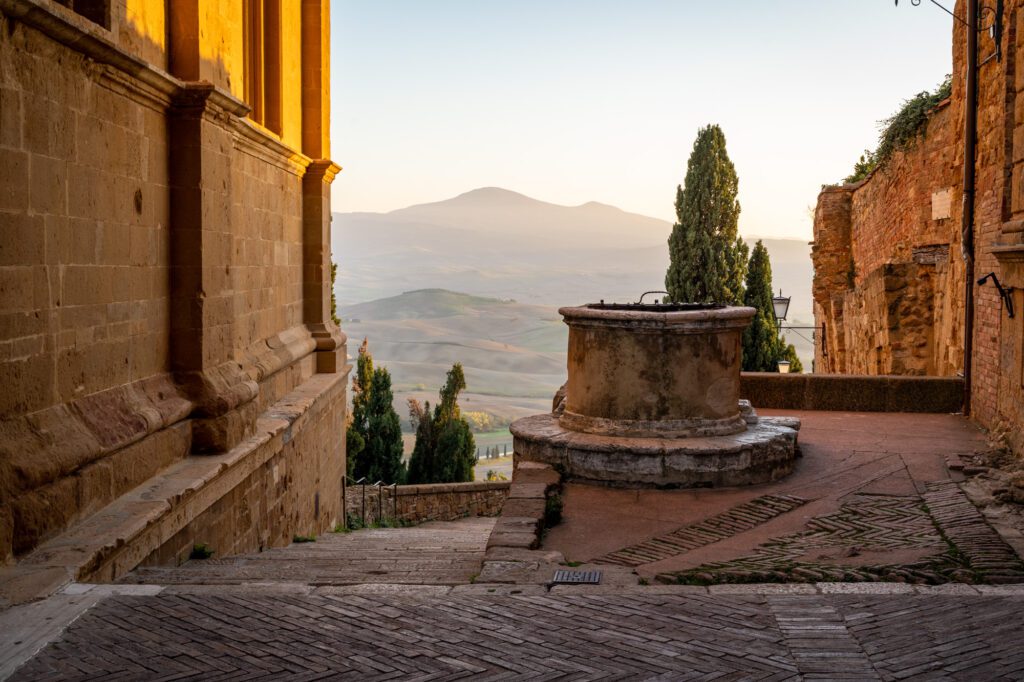
Disclaimer: Some of the links in this post, like hotel links, are affiliate links, meaning at no additional cost to you, we make a little bit of money if you click through and book. That being said, we would never recommend something to you that we don’t stand behind 100%.
A Quick Tuscany Geography Overview
Before we get into the meat of the Tuscany itinerary, it makes sense to take a second to talk about the geography of Italy’s most famous region.
Tuscany is in central Italy and is a land of olive trees as far as the eye can see, rolling hills, winding roads, and cypress trees.
The capital of Tuscany is Florence, which is well worth a couple of days exploring (our recommendation would be to do it at the end of your trip), but cities like Pisa and Siena are also within Tuscany’s boundaries.
In order to talk about what to focus your time on when you visit Tuscany, we’re going to break up the region into four distinct areas. This is just our way of breaking things down into more digestible pieces, it’s not an official designation or anything like that.
Here are those four regions:
- Florence & Around (including Chianti)
- Siena & Around
- Southern Tuscany & The Val d’Orcia (Pienza and Montepulciano)
- San Gimignano and Volterra
Now, there are other places in Tuscany – like Pisa and Lucca up north, and the Tuscan coast out to the west – but if you have limited time and you’re looking for the quintessential Tuscan countryside, these are the four areas we think you want to focus on if you have 10 days or less (which is going to be most people reading this).
With that brief and incomplete overview out of the way, let’s get into the information you’ll need to actually plan your Tuscany road trip.
Do You Need a Car for This Tuscany Itinerary?
While we’re big fans of train travel in Italy, Tuscany is one of the places (along with Sicily ) where you really need a car to fully experience it.
You’ll need to rent a car, and we’d strongly recommend you avoid having a car for your time in Florence (if you decide to include the biggest city in Tuscany in your itinerary). Parking in Florence will be expensive and unnecessary – you really don’t need a car.
To pull this off, we’d put Florence at the end of your Tuscany itinerary.
You’ll want to rent a car from the airport when you arrive and head straight down to Siena, and then drop it off on the day you ARRIVE back in Florence (day 6, if you follow our itinerary below).
Then take the bus from the Florence Airport into the city, and spend a couple of days exploring before you head home!
That way, you don’t have to deal with traffic or parking in Florence, which can be a nightmare.
Here are a few things to know about renting a car in Italy (keep in mind that we’re American).
You Need an International Drivers License if You’re Coming From the US
You can get them at AAA in the US. While they might not ask you for it at the rental car counter, the police will ask you for it if you get into an accident or get pulled over. Best not to risk it.
Know Your Toll Roads
Toll roads in Italy – called Autostrade – are essentially equivalent to Interstates here in the United States.
They have anywhere from two to four lanes, high speed limits, and are more or less a straight shot between destinations. You can only enter and exit them at fixed points, but there are gas stations and casual restaurants at rest stops along the way.
Unlike here in the US, you have to pay to use the highways, which are toll roads.
You do this by either renting a transponder from your car rental company, or by stopping at one of the entrance stations and getting a ticket, which you pay when you exit the toll road. You can almost always pay with a credit card these days (in our experience, anyway).
Here’s a guide to help you understand toll roads in Italy .
What If You Don’t Want to Drive in Tuscany?
Look, we totally understand the hesitance to drive in a foreign country. Especially in a country like Italy, which doesn’t exactly have a reputation for having friendly, patient drivers.
If you don’t want to drive in Italy (or can’t drive in Italy), you can still make this itinerary work using a combination of public transportation and guided tours.
You’ll want to base yourself in Florence and Siena – which are connected by train and bus, so they’re relatively easy to get between – and use them as a home base to do day trips out into the wider Tuscan countryside.
Unfortunately, that means you’re going to be paying more for guided tours to the Val d’Orcia and San Gimignano, and you’ll have less flexibility to explore at your own pace without a car.
Where to Start and End Your Tuscany Road Trip
Without a doubt, the best place to start and end this road trip is going to be Florence. There are three main reasons why we think that’s the case.
First, if you’re flying in from outside of Italy, Florence is your best bet in terms of finding flights. You’ll want to fly into Florence Airport (FLR), NOT PISA INTERNATIONAL AIRPORT, which as you might expect, is actually in Pisa (about 45 minutes west of Florence).
Second, you’ll have the best selection of rental cars in Florence.
Third, Florence is the closest major city (with a solid airport) to the main regions of Tuscany we touched on above. It’ll take about an hour and 15 minutes to get from Florence to Siena, your first stop on this Tuscany itinerary.
Another airport to look at – and this is actually the airport we flew into – is Bologna Guglielmo Marconi Airport (BLQ) . It’s about 45 minutes north of Florence (which means 2 hours to Siena), but it’s a good alternative and you might be able to find slightly cheaper rental cars and flights.
Plus, we adore Bologna, and it’s worth a day or two of your time (here’s our guide to spending one day in Bologna).
Plan on doing a big loop through Tuscany, and returning your car to (and flying out of, if applicable) the same airport you came in to.
Is One Week in Tuscany Enough Time?
While you could technically do Tuscany in a couple of days, you’re not going to have much time to experience the dolce vita that makes this part of Italy special if you do it that way.
We think you need at least one week in Tuscany to do all four of the regions of Tuscany we mentioned above.
That will give you enough time to get beyond the surface level in each place. That’s why we chose to write this guide for 7 days in Tuscany.
A good example of why this is important is Siena. Siena is a madhouse during the day when buses full of tourists get dropped off to wander through Piazza del Campo and the Duomo.
However, when those tour buses leave, Siena transforms into a much more serene destination – the narrow alleys go from packed wall-to-wall with people to being nearly deserted.
If you only have a couple of days in Tuscany, you won’t have the time to experience Siena either in the early morning or evening, when it’s a completely different – and much more pleasant – place.
What should you do if you only have 3-5 days or so? Pick one or two of the regions above, and focus on those rather than trying to do it all.
We have suggestions on how to plan a shorter itinerary below the main itinerary, which includes day-by-day Tuscany itinerary options for 3 and 5 days.
More time? Great! We also have suggestions on what to do with your extra time in a section below the main itinerary.
Where to Stay for Your Tuscany Road Trip
When it comes to where to stay, there are essentially three approaches you could take: stay in one place for your entire trip, and use it as a base for exploring the entire region, stay in a different place each night, or a find a home base in each micro-region and stay there for a couple of nights each.
As you might imagine, we like the last approach, which is a hybrid that gives you the benefits of staying in each of the parts of Tuscany that you’re visiting (which cuts down on drive time) and not having to move around every single night.
If you follow our itinerary below as written, you’ll stay in Florence, Siena, and the Val d’Orcia for 2-3 nights each.
By the way, we have an entire guide dedicated to helping you find the perfect place to stay in Tuscany . If you want more detail, head over and read that.
Hotels in the City Center vs. Agriturismos?
The next decision you’ll need to make is what kind of stay you’re looking for. Do you want to stay right in the middle of all the action in a hotel right in the city center, or would you rather have a tranquil stay in the Tuscan countryside?
Our (strong) bias is the latter – we stayed exclusively at Agriturismos in Tuscany, and loved every second of it .

You won’t have to worry about (or pay for) overnight parking, you’ll have a little more space (if you’re lucky, a patio with some nice views), and you’ll be awash in the warm glow of the dolce vita as you sip your morning coffee on the outdoor patio with a view of Cypress Trees and hilltop towns.
The upside of staying in the center of a city is, obviously, convenience. However, parking and navigating ZTL (the car-free zones in the city center of most of Tuscany’s towns and cities) make staying in a city with a car less appealing, at least in our estimation.
Our recommendation would be to spend your two nights in Florence in the city center (you won’t have a car at this point, so parking isn’t as much of an issue), and stay in the countryside around Siena and in the Val d’Orcia .
Where to Stay in Florence, Siena, and the Val d’Orcia
Let’s quickly cover some of our specific recommendations on where to stay based on our own experience and research.
In Siena, we stayed at Il Palazzetto just outside of town for a few nights and loved enjoying our coffee in the morning with a view of Tuscany from our front porch.

It’s a farmhouse in the countryside surrounded by olive trees, rolling hills, and Cypress trees, and they have a few beautiful rooms and apartments on the property. Very friendly staff, and helpful recommendations for what to do, see, and eat in Siena.
In the Val d’Orcia, we stayed at Agriturismo Il Casalino , a cute little farmhouse in the valley below Pienza with a spectacular view of Pienza up on the hill. Very friendly owner, and the location is truly excellent. Cypress trees and rolling hills as far as the eye can see!
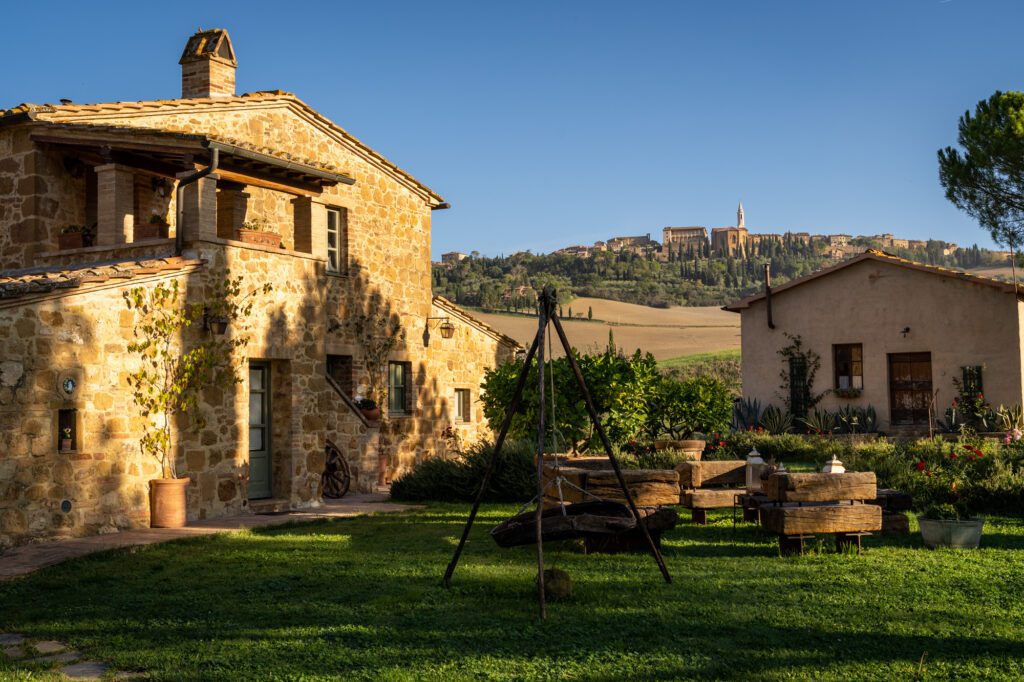
In Florence, you’re going to want to stay in the city center. We’ve stayed at Pietrapiana Boutique Apartments , which are in a great central location about ten minutes from the Duomo di Firenze. They’re compact, but they have a little more space to spread out and relax.
Here’s our guide to where to stay in Florence for more detail.
7 Days in Tuscany: How to Plan an Amazing Tuscany Road Trip Itinerary
With a week in Tuscany, we’d strongly recommend limiting your trip to Florence, Siena, the Val d’Orcia, and San Gimignano (plus a side trip to Volterra) to avoid driving for hours a day and, most importantly, missing out on the slow life that makes this part of Italy special.
We’ve structured this itinerary as a loop that begins and ends in Florence, like we mentioned above.
Now, let’s get into the itinerary itself! Here’s a day-by-day itinerary, and a map to visualize what it looks like.
- Day 1: Siena
- Day 2: Siena
- Day 3: Val d’Orcia
- Day 4: Val d’Orcia
- Day 5: San Gimignano and Volterra (end in Florence)
- Day 6: Florence
- Day 7: Florence
Now that you’ve got a good overview of the geography and logistics, let’s get into exactly how to spend one week in Tuscany!
Days 1 & 2: Siena
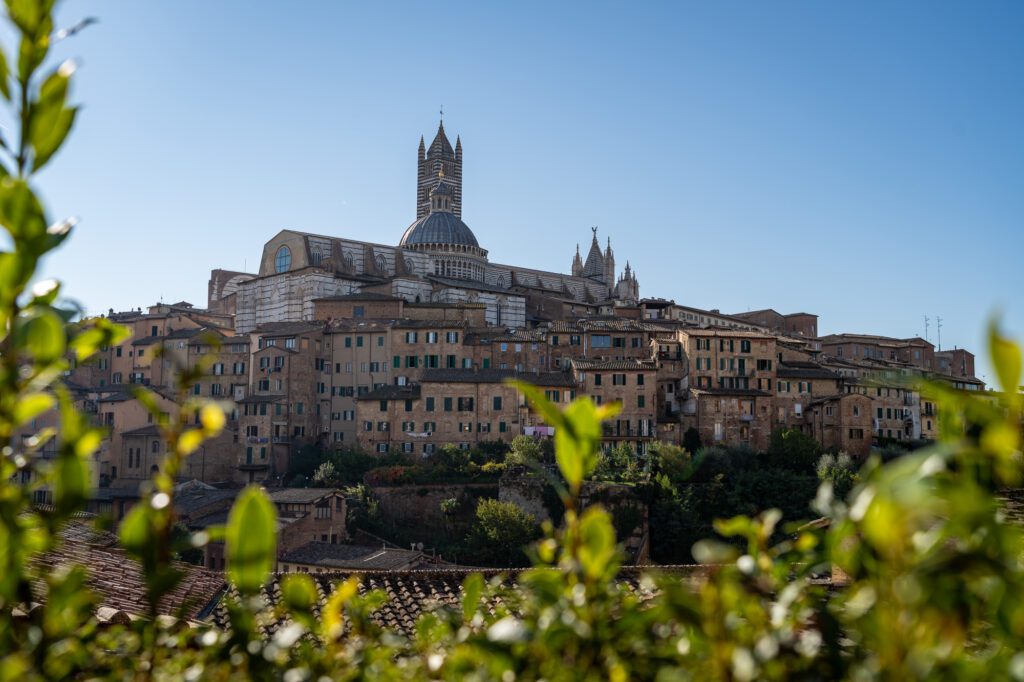
Drive Time and Distance from Florence to Siena: 1 hour 15 minutes / 78 km
On your first day, pick up your car and head straight to Siena. Chances are, you’re either taking the train to Florence, or you’re flying into the airport in Florence.
Either way, skip Florence for now (you’ll be back!) and head straight down to Siena, which will take you about 90 minutes, depending on traffic.
There’s really no place to soak up Tuscany’s medieval charm quite like the hilltop city of Siena, one of the best preserved medieval villages in all of Italy.

The striking city is characterized by its red clay brick houses, grand Gothic churches and palaces, and soaring medieval towers. It’s home to some of the finest art and architecture in the country thanks to its great wealth and power during the 13th and 14th centuries.
Siena is also famous for its historic Palio horse race, which takes place on July 2nd and August 16th each year. The event has been taking place in the city since the 15th century and features 10 riders from different districts racing bareback around central Piazza del Campo.
This is one of the most exciting – albeit extremely busy and expensive – times to visit.
Things to Do in Siena

Siena’s distinctive medieval architecture and unique charm have earned the city the recognition of UNESCO World Heritage Site. And it is now one of the most popular destinations in Tuscany.
This does, however, mean that it gets pretty busy all throughout the year, with crowds that rival even the bigger cities of Florence and Pisa.
There’s one implication of Siena’s popularity that you should consider.
Many people visit Siena on a day trip from Florence , which means it’s at its busiest in the middle of the day.
To see the city at its most peaceful, head out early in the morning or late in the evening and enjoy having space to yourself. This is why we’ve recommended spending two days in Siena.
- A Walking Tour of Siena. We did this walking tour on our first day and it was an excellent introduction to the history and culture of Siena. It even included a visit to the cathedral, which is a fascinating place to explore with a knowledgeable local guide who can point things out that you wouldn’t otherwise notice (though, it does not include a ticket to the viewpoint of the cathedral – more on that in a second).
- Piazza Del Campo. Siena’s impressive main square is surrounded by stunning Medieval palaces and historic buildings. Today, it’s a hub of social life in the city and a great place to take a stroll or stop for a drink on the terrace of one of the charming cafes.
- The Duomo di Siena (and the view from Facciatone). Siena’s 13th-century cathedral is one of the finest Gothic churches in all of Italy, with an intricate marble façade and lavishly decorated interiors. The colorful stained-glass window and amazing mosaic floors were particular highlights for us. Plus the Panorama dal Facciatone – located at the top of the incomplete expansion of the church in the now museum – offers breathtaking views over the historic city. The extra cost (you have to buy a special ticket) to get up to the viewpoint is well worth it, we think.
- Eating and Drinking in Siena. Siena is a great foodie destination, with plenty of delicious things to try. Places we’d recommend eating and drinking in Siena are Bakery Il Magnifico (for Siena’s famous chewy almond cookies, Ricciarelli), Caffetteria Torrefazione Fiorella (for coffee at the counter), Du’ Cose Da Berna (recommended by the host at our agriturismo), and La Prosciutteria Crudi e Bollicine Siena (for cured meats).
Days 3 & 4: The Val d’Orcia (Montalcino, Montepulciano, & Pienza)
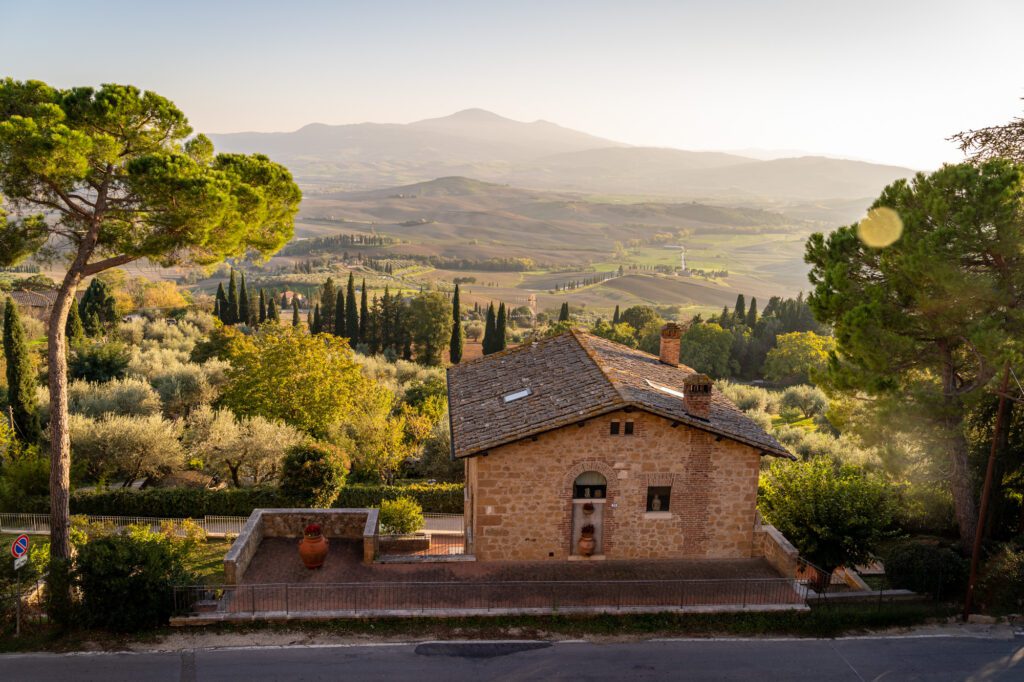
Drive Time and Distance from Siena to Val d’Orcia: 1 hour 15 minutes / 55 km
Next, it’s time to journey through the beautiful Val d’Orcia in southern Tuscany. This is one of our absolute favorite parts of the region.
If you’re like us, the things you associate with Tuscany from popular culture are rolling hills, cypress trees, and red wines. Which, spoiler alert, is exactly what you’re going to find in Tuscany (along with some other gems).
The journey from Siena to the Val d’Orcia can take anywhere between 1 hour and 1 hour 15 minutes, depending on the route and traffic.
The Val d’Orcia is quintessential Tuscany, with rolling green hills (at least in the spring and early summer before they turn brown) dotted with cypress trees, vineyards, historic farmhouses, and picturesque hilltop towns.
The valley’s gorgeous landscapes and unmatched beauty inspired many Renaissance painters during the 15th and 16th centuries.
Two days is a good amount of time to spend on a little road trip around the Val d’Orcia. We’d suggest focusing your visit on three main towns; Montepulciano, Montalcino, and Pienza.
Things to Do in the Val d’Orcia
Pienza is situated in the middle of the two other towns. We’d recommend starting at Montepulciano or Montalcino on your first day and moving east or west with Pienza as the second stop to minimize travel time.
There are also tons of great places to stay in and around Pienza (for what it’s worth, we chose Agriturismo Il Casalino and loved it) so it makes a good base in the region.
The other thing to know is that each of the towns are fairly small, so you’ll only need a couple of hours to explore the town itself. You can spend the rest of your time enjoying a long leisurely lunch, sipping local wine with a view, and driving the winding roads through the countryside.
Montepulciano
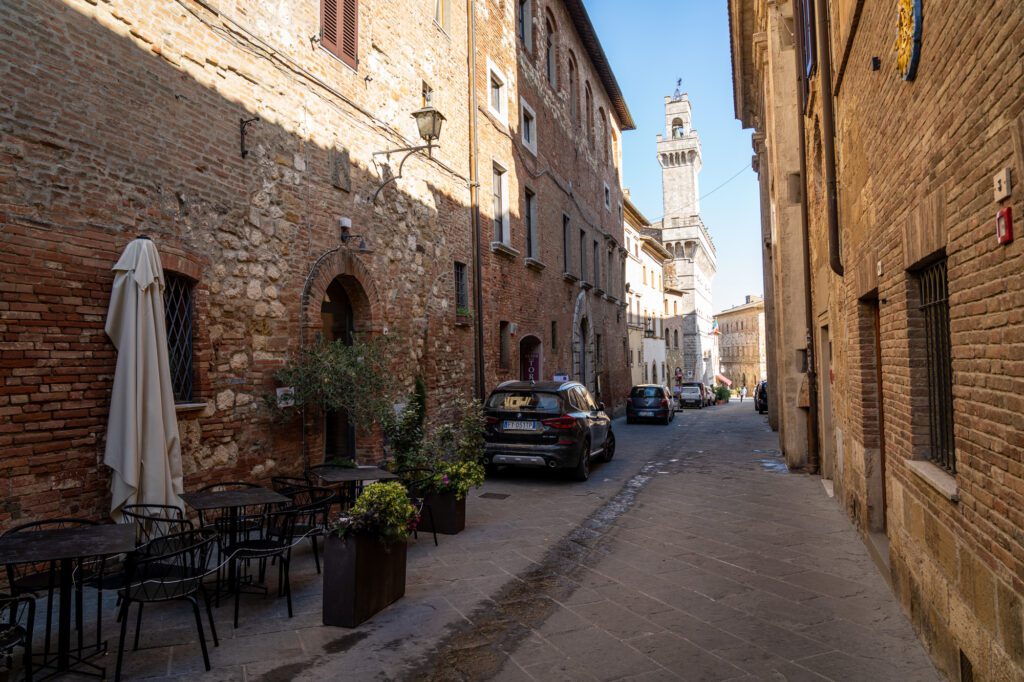
This quaint little town sits on the edge of a volcanic rock cliff face with sweeping views over the surrounding valley.
Make sure to go wine tasting at De’ Ricci (Vino Nobile is the local red wine), climb the tower of Comune di Montepulciano for excellent views of the valley sprawling out to the west, and take a stroll along the winding Via di Gracciano nel Corso, the main street in town.
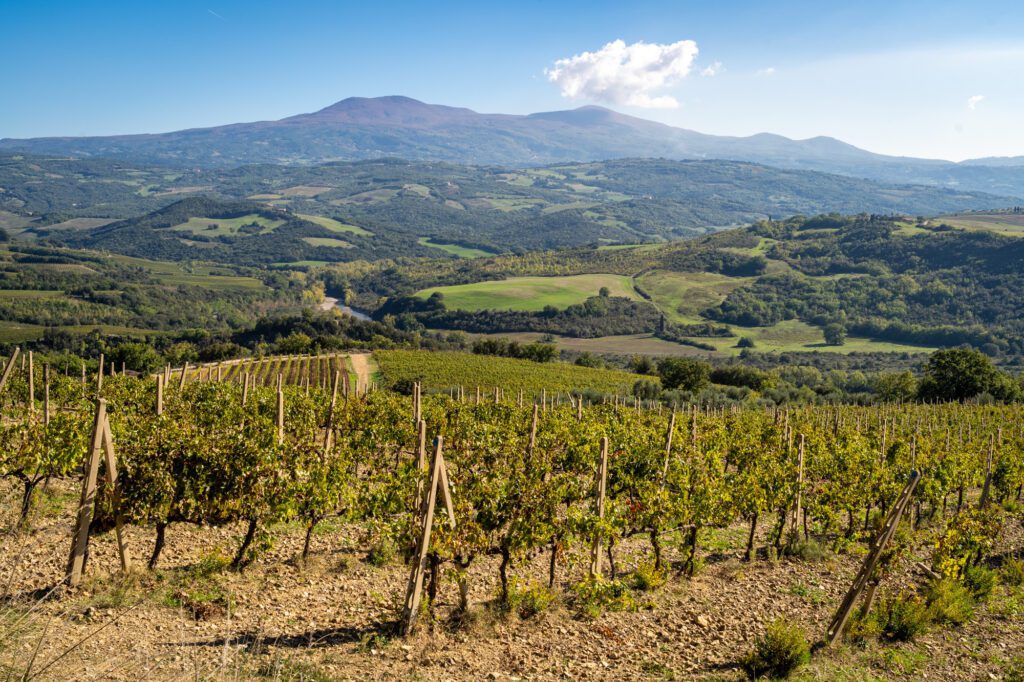
Sitting in the heart of Tuscany’s famous Brunello wine region, Montalcino is a must-visit for red wine lovers.

You can sample local Brunello wine at Ciacci Piccolomini D’Aragona (or any of the other wineries south of Montalcino) where we got a crash course in Brunello, which is largely made with the same grape varietals as Chianti, but is processed differently.
You should also take the time to walk the historic walls of Fortezza di Montalcino, the town’s medieval fortress, and visit the Romanesque monastery Abbazia di Sant’Antimo (which is conveniently right next to the winery we recommended above, which makes it an easy stop).
A romantic Renaissance town with spectacular panoramic views over the surrounding countryside. This viewpoint was our favorite.
The town is also famous for its local Pecorino di Pienza cheese, which you can try at La Taverna del Pecorino (if you can find it, get it baked with honey on top – pecorino con miele).
And don’t miss coffee with a view at the lovely Bar il Casello .
Day 5: San Gimignano, Volterra, & Drive to Florence
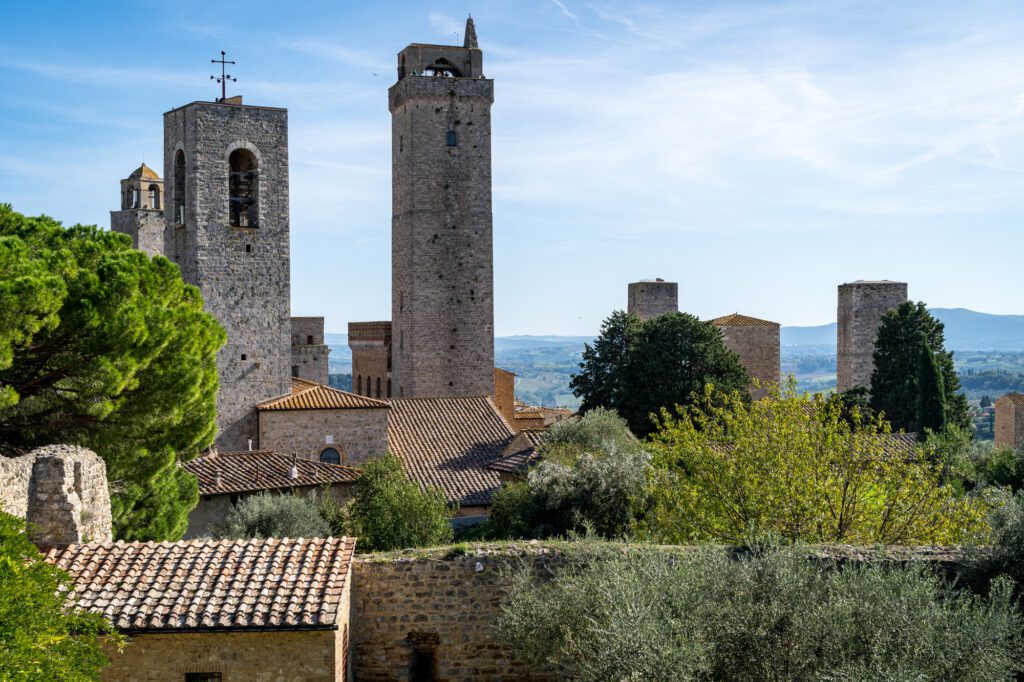
Drive Time and Distance from Val d’Orcia to San Gimignano: 1 hour 45 minutes / 95 km
On day five, you’ll want to gradually make your way back from the Val d’Orcia towards Florence, taking a slight detour to visit the towns of San Gimignano and Volterra along the way.
Both towns sit on the western end of Tuscany towards the sea. They are located around 30km from each other and can take anywhere between 40 minutes to 1 hour to drive between. So be sure to factor this into your day if you do want to visit both.
San Gimignano is a lovely medieval town and another of Tuscany’s UNESCO World Heritage sites. The small town once had over 70 soaring medieval towers making up its skyline, gaining it the unique title of the “Manhattan of the Middle Ages”.
Today only a handful of these towers remain, but the town is still known as Italy’s “City of Towers”.
Nearby Volterra is slightly less well-known than its famous neighbor (unless you’re a Twilight fan, in which case you probably know it).
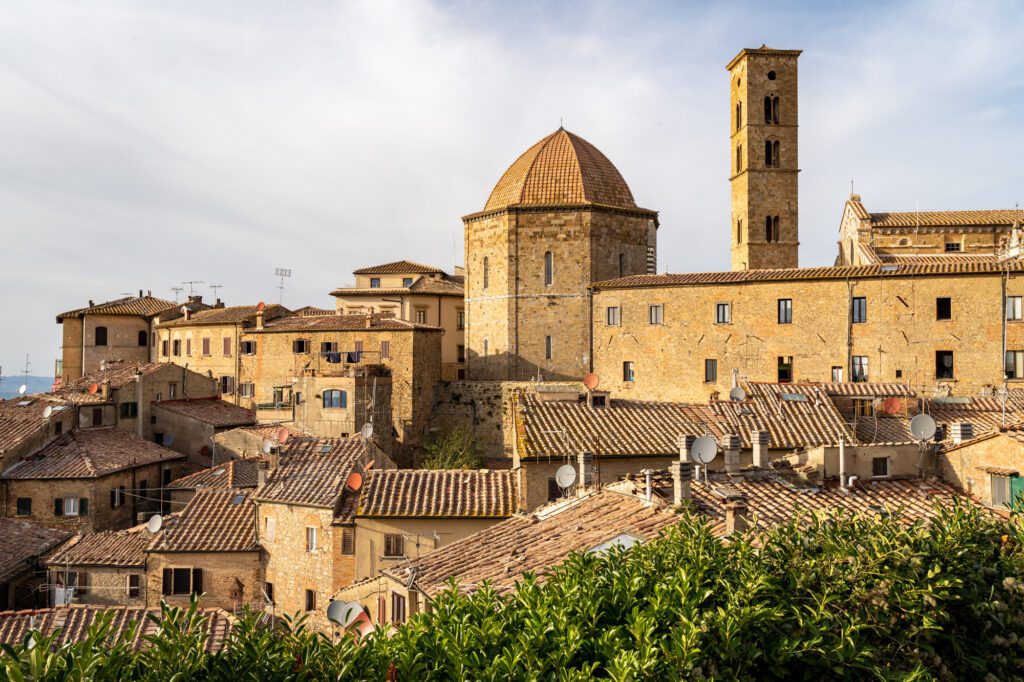
The less popular walled hilltop town is still a great place to explore and is worth the drive, with several important historic and archeological sites including a world-class Etruscan museum and a couple of Roman archaeological sites.
You’ll also find considerably smaller crowds than San Gimignano, so it’s a good place to escape the chaos for a couple of hours.
Things to Do in San Gimignano
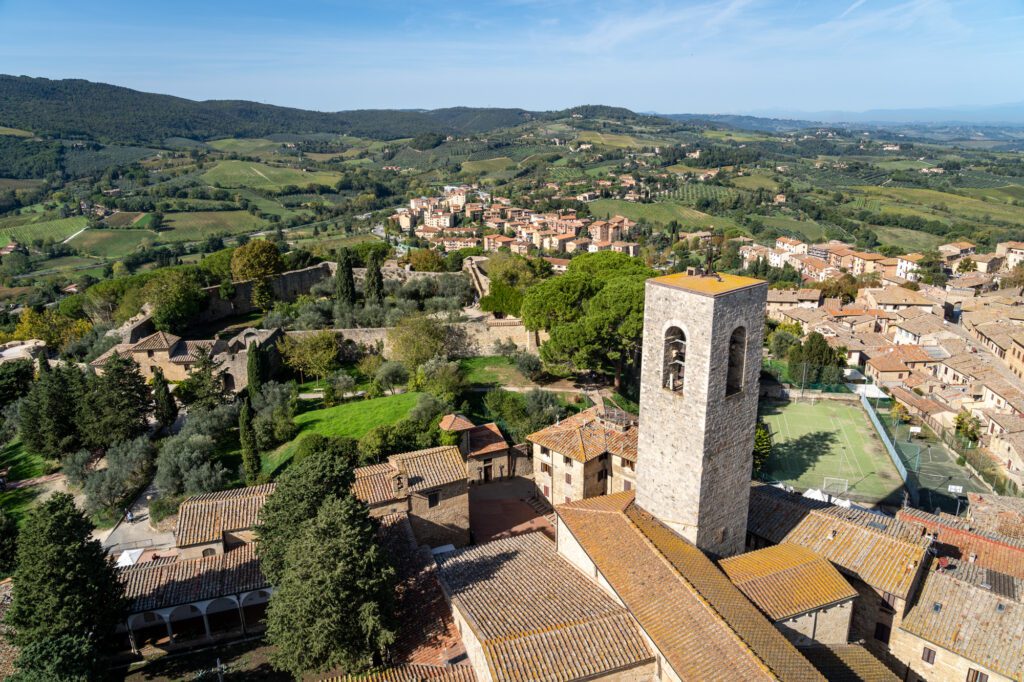
San Gimignano is a relatively compact town, and it is one of the most popular places to visit in Tuscany.
Wandering the narrow streets, you’ll likely find yourself packed wall-to-wall with other visitors if you’re here in the summer between 11:00 am and 5:00 pm (especially on a weekend).
However, it’s easy to see why so many visitors flock here – the towers of San Gimignano are an iconic piece of Tuscany’s landscape.
- Eating in San Gimignano. San Gimignano is a lovely spot to make the most of Tuscany’s world-class cuisine. Enjoy lunch on the terrace at Le Vecchie Mura for great food and even better views. And don’t forget to grab some tasty gelato from Gelateria Dondoli (they also have gelato making classes).
- Drink Vernaccia Di San Gimignano. Produced in the vineyards surrounding the town, Vernaccia is Tuscany’s most famous white wine. You can sample Vernaccia in most restaurants and bars around town, or head to the Vernaccia di San Gimignano Wine Experience to learn more.
- Climb the Torre Grossa. The bell tower of the Palazzo Communale (town hall) is the tallest remaining tower in San Gimignano, sitting at 177 feet. You can climb 218 steps to reach the tower’s summit and enjoy beautiful views over the town. And while you’re there, spend 15 minutes admiring the artwork in the attached Palazzo Comunale – there’s not much but it’s definitely worth a quick visit.
- Parco della Rocca. This lovely hilltop park is the highest point in San Gimignano and is home to the ruins of a medieval fortress. Today it’s a great place to take a walk or stop for a relaxing picnic with amazing views over the town (the best view is from here ).
Things to Do in Volterra

Volterra is also a small town at the top of a rocky outcropping (are you seeing the pattern here yet?) with great views out over Tuscany (and even out to the sea, on a clear day).
There’s not a whole lot to do in town, and we found it to be pretty sleepy on a random weekday afternoon in mid-October.
However, it’s gorgeous and is an important piece of history on the Italian Peninsula. It’s worth visiting for the walking tour and Etruscan Museum alone.

An afternoon in Volterra is well worth the drive from San Gimignano, we think. You only need about a half a day to see the highlights. Here are some of our favorite things to do in Volterra.
- The Etruscan Museum. Volterra has been home to many different inhabitants over the years (it has been consistently inhabited since the 8th Century B.C.), including the Etruscans, who left their mark on the city. The Etruscan Museum in town is well worth a couple of hours of your time – it has one of the most extensive collections of Etruscan artifacts in the world.
- Walking Tour. This twilight walking tour of Volterra (NOT THAT TWILIGHT) was one of our favorite experiences in all of Tuscany. It covered the history of the city in just one hour. The time of the tour varies each day, and it is well worth the small donation (only cash) to hear about Volterra’s history from a local, including the feat of saving the main gate into town from destruction during World War 2.
- Roman Ruins. One of the other fascinating elements at play here is related to another of the town’s inhabitants over the millenia, the Romans. There are several sites around town where excavations have uncovered extensive Roman ruins, and the best example is the Roman Theater on the northern side of town ( here is the best view). There is another, more recently uncovered Roman amphitheater further north outside of town, which was uncovered in the 2000’s (which is the most recent archaeological discovery I personally had ever heard of).
Days 6 & 7: Florence
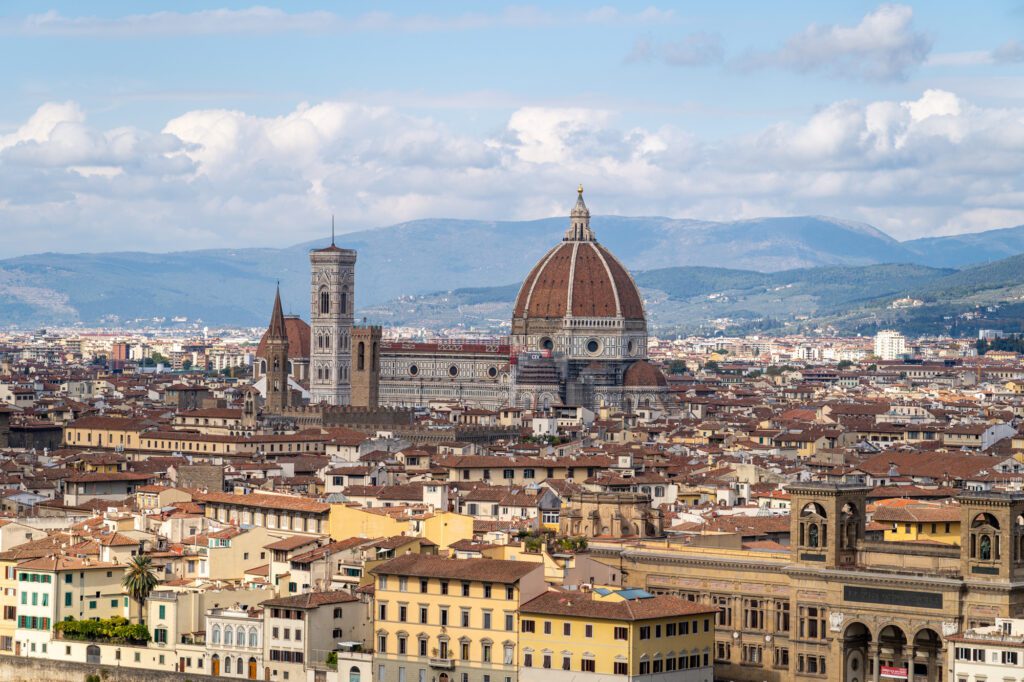
Drive Time and Distance from Volterra to Florence: 1 hour 30 minutes / 85 km
Finally, spend the last two days of your Tuscany road trip exploring the regional capital and one of Italy’s most famous cities, Florence.
The city was one of the richest and most powerful in all of Europe (if not the world) during the 15th century, explaining its unmatched elegance and grandeur today.
Known as the ‘Birthplace of Renaissance’, Florence is a hub of world-class art and architecture.
Its two impressive art galleries are home to more masterpieces than you can possibly fathom, while the city itself is one giant open-air museum, with exquisite churches and grand Renaissance palaces on every corner.
It’s difficult not to fall in love with Florence, despite the huge tourist crowds that descend on the Italian city all year round.
Things to Do in Florence
Florence may be relatively small as far as Italian cities go, but it certainly still packs a good punch when it comes to things to see and do.
Two days is just about enough time to experience the city’s top sites and visit the two main galleries.
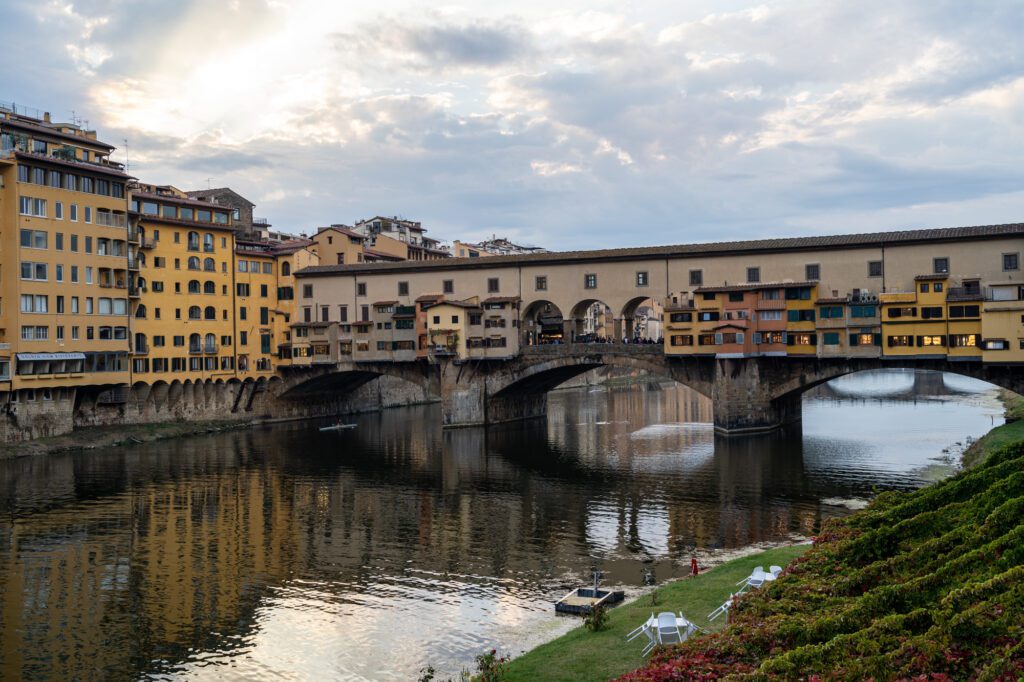
However, try to avoid visiting the Uffizi Gallery and Galleria dell’Accademia on the same day. Even for the biggest art lover, it’s simply too much information to digest all at once.
- Piazza del Duomo & Climbing the Dome. Sitting at the heart of the city, Piazza del Duomo is home to many of Florence’s most important landmarks, including the 13th-century Cathedral and its famous dome, the Baptistery, and Giotto’s Bell Tower. With only two days, we’d prioritize Brunelleschi’s Dome. By climbing 463 steps to the top of the iconic dome, you can admire the striking frescoes up close and experience amazing views over the church’s beautiful interior. Try to do it first thing in the morning for the fewest people, and book in advance here .
- The Uffizi Gallery. This world-class gallery has a whopping 101 rooms that hold an unparalleled collection of Renaissance and European art. Many of the artworks were assembled by the powerful Medici family between the 15th-18th centuries. We’d highly recommend visiting on a guided tour to add context and richness to your visit – it can be a little overwhelming otherwise. We did this tour and absolutely loved our experience!
- The Galleria dell’Accademia and the David. Florence’s second major gallery is best known for one particular piece, Michaelangelo’s Statue of David, which is one of the most famous sculptures in the world. It’s worth visiting the gallery on a guided tour ( this is the one I did on my latest visit to Florence with my mom, who had never seen David in person before) to learn more about the famous statue and other artworks in the gallery.
- Explore Oltrarno. Just across Ponte Vecchio, which crosses over the Arno River that runs through Florence’s historic center, is one of our favorite parts of the city, Oltrarno. The neighborhood is full of charming little piazzas, traditional restaurants, and cozy bars. It’s a great place for a peaceful stroll or an afternoon aperitif. Check out Le Volpi e l’Uva for the best Italian wine selection, and Gelateria Della Passera for Alysha’s favorite gelato in Florence.
- Eating and Drinking in Florence. Tuscany is a region that’s known for its fantastic cuisine, and you can sample the best of it in its capital city of Florence. Start your mornings with coffee from Coffee Mantra , indulge in delicious pizza from award-winning Ciro and Sons , and don’t miss the Pappardelle al Cinghiale (pasta and wild boar ragu) at Da Garibardi . The city also has two food markets, Centrale and Sant’Ambrogio, which are must-visits for foodies.

More Than a Week in Tuscany? Here’s What We’d Add to Your Itinerary
There are two places that we really liked that you’re missing if you follow the Tuscany itinerary above as written. They are Chianti and Lucca, which are west of the majority of this itinerary.
With a few extra days, we’d spend a day or two in each place. Both areas can easily be covered in a day for each, but two gives you the opportunity to do things at a more leisurely pace. You can absolutely do Chianti as a half day trip, either from Siena or Florence.
You’ll notice that we haven’t included Pisa here, which is in the same vicinity as Lucca. We MUCH prefer Lucca to Pisa, both because it’s a more interesting city in general, and because it sees a fraction of the tourists that Pisa does.
If you absolutely must see the leaning tower of Pisa, then we’d add it as a day trip from Lucca (but we wouldn’t stay the night in Pisa, if you can avoid it).

Lucca is one of our favorite discoveries from our six week Italy trip in 2021, and the highlight here is the intact city walls that date back to the Renaissance. You can circumnavigate the city by walking along the walls, which is absolutely something you should plan on doing.
The city is in a narrow valley, surrounded by mountains on the south and north sides. One thing you should absolutely do in Lucca is climb one of the many towers in the center of town.
We climbed the Torre Guinigi , and the view from the top with the towers and churches of Lucca and the surrounding mountainous landscape was sublime.
Another thing not to miss is Piazza dell’Anfiteatro , which is a piazza built on the site of a former Roman amphitheater. The piazza keeps the same oval shape today, though the restaurants on it leave a bit to be desired.

Chianti is a wine region just south of the city of Florence that is known for its red wines, specifically the Chianti Classico, which is one of the main wine exports of Tuscany.
Similar to other Italian D.O.C.G. wines like Prosecco and Brunello, Chianti Classico is a red wine that is made in a specific way with primarily Sangiovese grapes from the Chianti region.
It is one of the most famous wines that comes out of Italy. If you don’t like red wine, I have some bad news for you – Tuscany is all about the red wines (except for vernaccia, which is a white wine that comes from San Gimignano!).
As you might imagine, Chianti is all about the wine tasting. Now, on the itinerary above, you’ve covered a few different famous red wines from Tuscany like Brunello and Rosso di Montepulciano, and Chianti is somewhere in between the two in terms of prestige and price.
The best way to experience the wines of Chianti is on a wine tour. In terms of guided tours, you have two options. You can either choose a tour that goes deep on a single winery , usually including a cellar tour and detailed tasting (but you’ll have to make your way out to the winery), or a tour that takes you around to multiple wineries .
Since you have a car, we’d recommend the first option, which gives you a deeper, more intimate experience. We did this wine tour of a tiny organic winery in Chianti and absolutely loved it.

If you have the time, we’d also recommend a stop at the lovely town of Badia a Passignano, a charming little town in the heart of Chianti.
Pro tip: If you’re buying Chianti Classico at home or somewhere else in Italy, make sure it says “Chianti Classico” (versus just “Chianti”, which we learned can be made elsewhere in Tuscany) and has a rooster logo somewhere on the bottle, which is how you know it’s legit.
Planning a Shorter Tuscany Road Trip Itinerary (3-5 Days)
If you have fewer than 7 days in Tuscany, our recommendation would be to focus your time on specific regions within Tuscany (see the geography overview above for how we’d break it up) rather than trying to see it all.
The first thing to consider is whether or not you want to include Florence in your itinerary. You might have already been there, or you might be more interested in the charming hilltop towns in the south of Tuscany.
If you want to include Florence in your itinerary AND you have limited time , we’d recommend basing yourself in Florence, and doing a day trip to Siena, Lucca, or Chianti from there. In this scenario, we’d strongly recommend that you don’t rent a car!
We actually have a 3 day Florence itinerary for you to basically steal, which includes a day trip on the third day out into broader Tuscany.
If you have three days and you don’t want to include Florence , then we’d focus on one region (and we’d make it either Siena or the Val d’Orcia).
If you have five days or so , focus on two regions – Siena and the Val d’Orcia.
You could also structure your own itinerary based on your particular interests by using the information in the main itinerary above!
5 Days in Tuscany: Siena and the Val d’Orcia
These two regions are quintessential Tuscany, at least for us. Tuscany is famous for many things, but somewhere near the top of the list has to be cypress trees and hilltop towns perched atop rolling hills as far as the eye can see.
That’s what you’ll find between Siena and the Val d’Orcia. If you only have five days, we’d split it between these two regions and completely skip Florence and San Gimignano.
Here’s what that itinerary looks like:
- Day 1: Drive to Siena
- Day 2: Siena + Monteriggioni
- Day 3: Val d’Orcia (Montalcino)
- Day 4: Val d’Orcia (Pienza & Montepulciano)
- Day 5: Val d’Orcia & Drive to Florence
3 Days in Tuscany: Siena & Around
Siena is a great city, and like we mentioned above is probably the best example of a charming hill town in Tuscany. It’s a bigger city than the vast majority of the other smaller towns on this itinerary, and it’s just beautiful vista after beautiful vista around every corner.
If you have three days in Tuscany, Siena makes for a great home base because it’s central to both San Gimignano and the Val d’Orcia, which makes a day trip more feasible.
One idea for a shorter itinerary like this that is based in Siena would be to hop on a day trip from Siena to reach either San Gimignano or the Val d’Orcia.
The tradeoff of seeing one of those places is that it gives you less time to explore Siena (you really only need about a day and a half, we think).
- Day 1: Arrive in Siena
- Day 2: Day Trip from Siena
- Day 3: Siena + Drive to Florence
In terms of the day trips, we’d definitely recommend going with the company behind the walking tour we did in Siena, which we enjoyed. They have a small group tour to the Val d’Orcia (Montepulciano and Pienza) and one that goes west to San Gimignano and Volterra .
3 Days in Tuscany: The Val d’Orcia
As we have already covered multiple times, we love the Val d’Orcia.
The only issue with the Val d’Orcia is that it’s a little far from Florence, which means you’re going to spend a lot of time in the car between the two (roughly 90 minutes each way) for just a couple of days spent there.
Still, we think it’s worth it. This is by far our favorite part of Tuscany.
- Day 1: Drive to the Val d’Orcia + Montalcino
- Day 2: Pienza & Montepulciano)
- Day 3: Morning Scenic Drive + Drive Back
Matt is the founder and main writer behind Wheatless Wanderlust, which he started back in 2018 as a way to share his gluten free travel guides with his fellow Celiac travelers.
Since then, Matt and his wife Alysha have visited 18 national parks, spent three months in Europe and six weeks in Colombia, and have explored every corner of the Pacific Northwest, which is where Matt grew up.
He writes super detailed guides to the places they visit, bringing together personal experience and historical context to help YOU plan an amazing trip.
Leave a Reply Cancel reply
Your email address will not be published. Required fields are marked *
This site uses Akismet to reduce spam. Learn how your comment data is processed .
A Local’s Guide to Travel in Tuscany

Tuscany, the most famed region in Italy and a place visited by millions of people every year, really needs no introduction. Featured in countless films and often used as the postcard image of quintessential Italy, Tuscany is squarely on the tourist map for just about everyone.
And that’s for good reason; because this is a truly spectacular region!
Tuscany has just about everything that you could ask for from a vacation destination: majestic UNESCO world heritage cities and towns, a to-die-for countryside, lovely mountains and fabulous beaches, and globally-renowned culinary and enological traditions. Simply put, we’ve got it all here!
And when it comes to culture, Tuscany is a fabulous part of Italy to discover. Tuscan, the region’s dialect, is very similar to Latin, and today’s standard Italian language was born from it. This is largely thanks to the writings of local artists like Dante Alighieri, Francesco Petrarca, and Niccolò Machiavelli.
On top of that, this was also the cradle of the Italian Renaissance, with Florence having been the epicenter. If you’re interested in art and history, few places in Italy can beat Tuscany.
So, if you’re looking to sample great food and wine, enjoy beautiful scenery, walk through history in medieval towns, and maybe even hit the beach for a bit, Tuscany has got you covered. No matter your tastes, travel style, or interests, Tuscany has something to offer.
More Tuscany travel info:
For more info on travel in Tuscany and Italy, check out our 7-day Tuscany itinerary and our guide to the Chianti wine region .
If you could use some one-on-one help planning your itinerary, consider scheduling an Italy travel consultation with one of our Local Experts!
Guide to the Val d’Orcia
Citu guide to Florence
City guide to Siena
City guide to Montepulciano
City guide to Lucca
City guide to Cortona
City guide to Pisa
Day trips around Tuscany with Stefano
Table of contents
Where is tuscany, best time to visit, how long to spend here, how to get to tuscany, where to stay in tuscany - best bases.
Transportation and how to get around
Is Tuscany expensive? Average travel costs
Paying for things and using credit cards, what to do in tuscany.
Best places to visit in Tuscany
Tuscany itineraries - from 5 days to 2 weeks
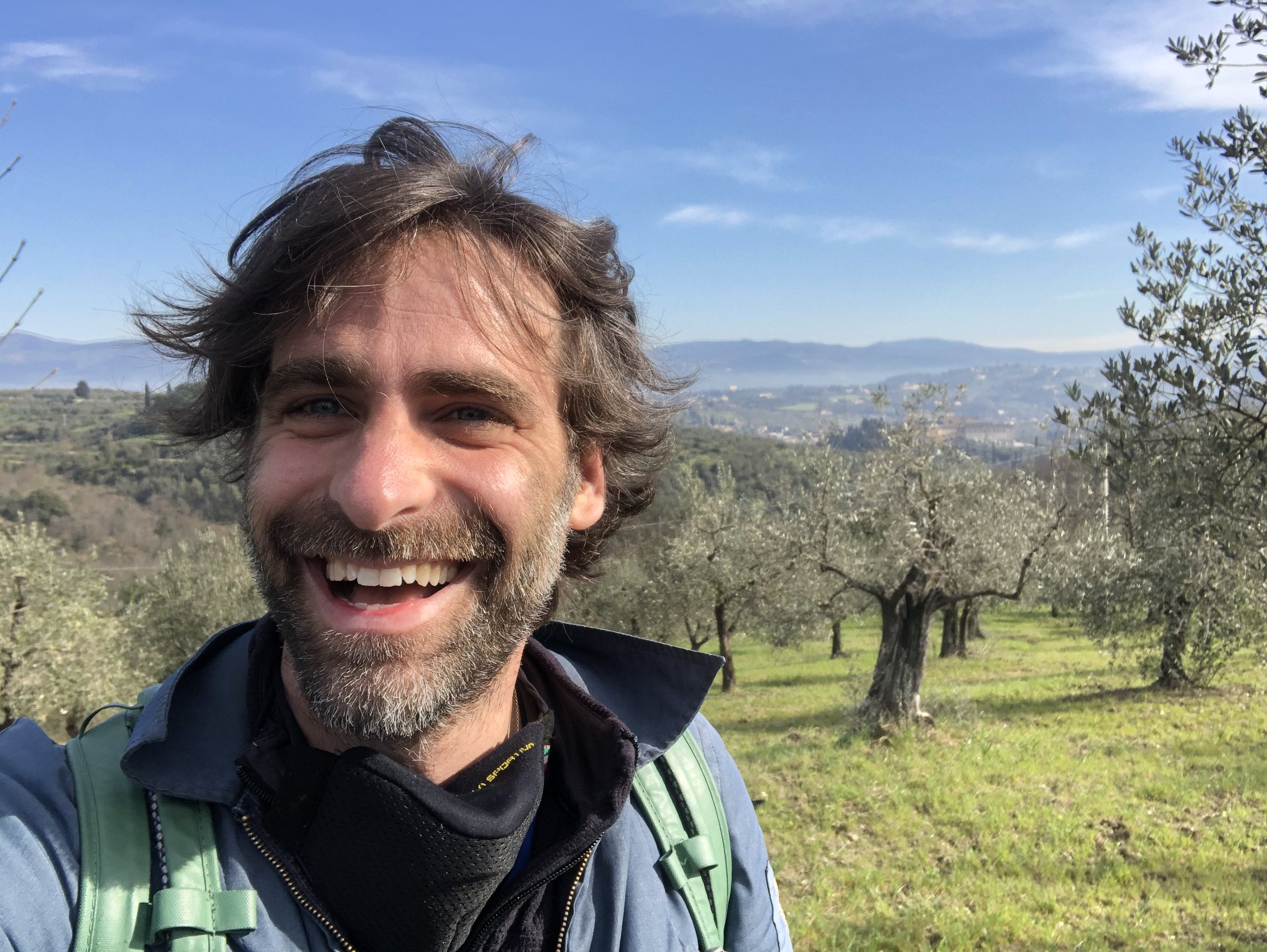
Local help with your planning
In the article below we’ve shared lots of advice and many tips on how to plan a trip to Tuscany. But it’s impossible to mention everything that you might want to know in just one article. Also, no two travelers are alike so not everything we’ve mentioned will be the right fit for everyone.
So if you’ll be planning your trip independently but could use some help sorting through all your options, consider scheduling a Tuscany travel consultation with one of our Local Experts!
These are one-hour Zoom calls where you can chat with a Tuscany-based travel pro about the trip you’re planning and they’ll share their tips and advice, answer your travel questions, and help you perfect your itinerary.
Tuscany is located in central Italy, about a 2-hour drive north of Rome at its southernmost point, and an hour south of Bologna in the region’s north. It is bordered to the northwest by Liguria, to the north by Emilia-Romagna, to the east by Marche and Umbria , and to the south by Lazio (where Rome is).
The western edge of Tuscany, runs all along the coast, from the Tyrrhenian Sea in the south to the Ligurian Sea in the north. Along much of the region’s northern border, you will find the Tuscan-Emilian Apennine Mountains, along with the Apuan Alps in the northeast.
Tuscany is a fairly big region for Italy (about 8,900 square miles), which means that there is a lot to see and do, and there is much more to it than just its (beautiful) countryside and the (magnificent) city of Florence.
Scattered all throughout Tuscany you will find fortified hilltop towns, mid-sized cities, beaches and coves, mountains, parks, and hot springs. Ready to start discovering it? Then keep reading!

The best time to visit Tuscany is indisputably late spring or early fall, especially the months of May and September. These are the periods when traveling in Italy is most enjoyable, and Tuscany is no exception.
Visiting in late spring and early fall
In late spring, the temperatures are already warm but not excessively hot, so it’s perfect for visiting historic towns, the countryside, and also the coast.
Besides Florence, which is crowded all year round, late spring isn’t packed with tourists, so you will surely enjoy your time there. Italians are still at work/school, so prices for accommodation and other attractions haven’t yet skyrocketed. Plus, most restaurants on the coast and less touristy areas/towns will already be open since they usually open up right after Easter (which is in late March or until mid-April).
Similarly, September also has great weather, lower prices, and less crowds. On top of that, seasonal venues (beach clubs, for instance) are still open and going full swing, before things die down toward the end of the season and everyone closes up shop for the winter.
If you can swing it, there’s no question that late spring or early fall are the perfect times to travel in Tuscany.
Visiting in summer
In summer, the weather is roasting hot in the cities and towns, while the coast overflows with vacationing Italians and foreign tourists. This is especially true from mid-July to the end of August.
Prices are incredibly high and availability is limited pretty much everywhere, so you need to reserve way in advance for hotels, rental cars, restaurants, and even entrance tickets to popular museums and historical sites.
Now, if summer is the only time you can come to Tuscany, don’t despair! While it’s not the ideal time to visit, it’s not as if every town, beach, or vineyard is going to be permanently packed.
You can always find hidden places that the masses have yet to discover, and if you visit popular locations early in the day or later in the evening (before the day trippers have arrived or after they’ve left), you can still enjoy beautiful places in Tuscany without being constantly shoulder to shoulder with others.
If visiting in summer, you just need to plan ahead, make reservations in advance, and visit the right places at the right time.
Visiting in winter
Visiting Tuscany in winter isn’t an outright bad idea either. While entrance tickets for museums and monuments are the same all year long, hotels and car rentals are much more affordable than at other times of year. If you’re looking to save money, this is the ideal time to travel in Tuscany.
November, January, and February are the least busy times to visit the region, which all makes it the ideal time to travel through the beautiful hilltop and art towns, which are packed throughout much of the rest of the year.
However, just be aware that it’s pretty chilly at this time of year, the weather is unpredictable and can often be grey and rainy, and trips out to the countryside or coast aren’t especially pleasant.
There is much more to see in Tuscany than just Florence and the Chianti hills. Tuscany is rather big, and it’s home to many historic sites and art towns (which are towns of great artistic/historic importance). The Tuscan coast is also stunning, with not one but two beautiful islands that you can travel to.
For the most part, it’s also quite easy to get from one place to another since the distances are pretty manageable by train or car, and there are good public transit connections for major destinations. Thankfully, you will never have to sacrifice entire days to travel, and will instead be on the road for at most a few hours before reaching your intended destination.
Even so, to appreciate Tuscany properly and to really get a feel for the region, you will need to slow down and take your time. This is especially true if your itinerary includes Florence, as that will take up a minimum of two days.
5 days - for a decent introduction
You need at least 5 days in Tuscany in order to appreciate the region and see a bit of what it has to offer. Remember, this is a region filled with beautiful hilltop towns, renaissance cities, coastline, mountains, and world-renowned wine country, so it has a lot to offer you.
While many people come in to Florence for 2 days, and then tack on a day trip out to the Val d’Orcia or Chianti area and call it a day, that’s not recommended - you’d simply be missing too much of what makes this region special.
To do things the right way, dedicate 5 days to Tuscany, and spend 2 of them discovering the renaissance jewel of Florence, then venture out to the Chianti countryside to visit wineries, thermal baths, or the coast, and give yourself a day or two to road trip between a few of the region’s beautiful hilltop towns.
Doing all of that in 5 days won’t be especially relaxing, but it will allow you to actually see Tuscany and begin to understand what the region is all about. 7 days would be better, as that would give you time to slow down and enjoy yourself a bit more, while having an extra day for Tuscany’s natural areas and another one to visit more of the historic towns dotting the entire region.
7 days - enough time for a solid itinerary
A 7-day trip to Tuscany gives you enough time to check off many of the highlights, while also spending some time enjoying the region’s gorgeous countryside. It’s not enough days to see the entire region, but it will let you beyond just the surface.
With 7 days, you could spend a pair in Florence, go wine tasting in Chianti, enjoy Siena, and then hop around the hilltop towns of the Val d’Orcia before finishing your trip in Pisa.
Depending on what your interests are, you could trade out a day in the Val d’Orcia for a day spent visiting places closer to Florence like San Gimignano and Monteriggioni. For your final day, if Pisa doesn’t appeal you could consider Lucca or Cortona instead. With 7 days, you have some good options.
For a detailed one week plan, check out our 7-day Tuscany itinerary .
10 days - the ideal visit
With 10 days in Tuscany, you can fully experience the region and see it in all its glory. This is the perfect amount of time to spend here. With a week and a half, you can do everything mentioned above, visiting art towns to your heart’s delight, making a trip to the gorgeous city of Siena, spending plenty of time in Florence, and then heading out into the countryside for a few days discovering the hills and wineries of the Chianti or Val d’Orcia regions.
You’ll likely even have time to spend a coupe of days beach hopping along the Tuscan coast, visiting seaside cities like Livorno, and quiet coves lined with pine trees.
To really mix things up, you could shorten your time visiting the hilltop towns or cities of the region, and add on visits to the islands of Elba or Giglio.
With 10 days, you can thoroughly discover this region. There are countless ways to spend a week and a half in Tuscany, and the beauty of this is that you will never run short of things to do and places to visit. Your only challenge will be deciding where you want to spend most of your time!
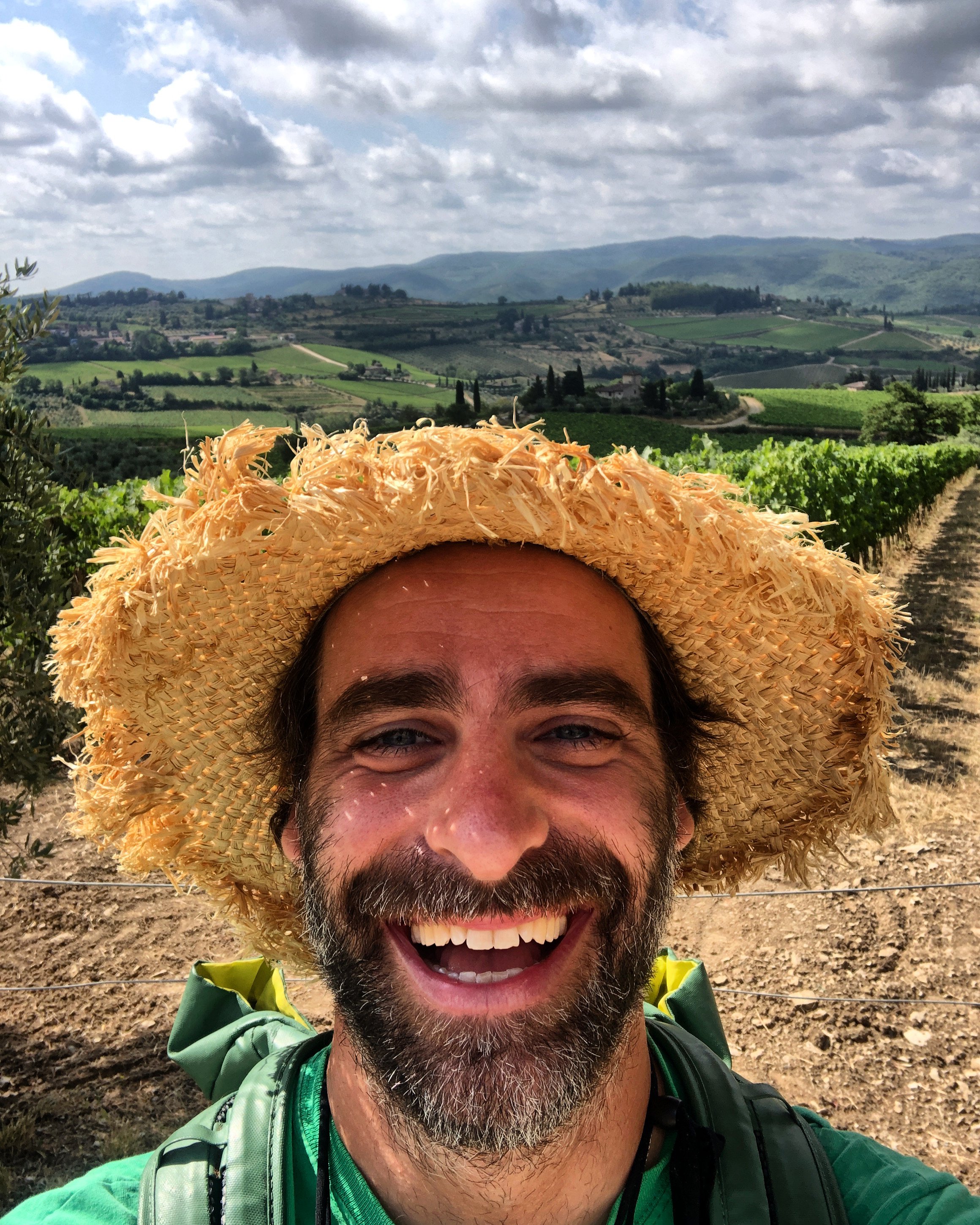
Connect with Tuscany travel expert Stefano for help perfecting your itinerary, answers to all your travel questions, and fabulous local tips for a better visit!

Tuscany has two cities with international airports: Florence and Pisa.
Florence’s airport is called “Amerigo Vespucci Airport” (FLR), and it’s located about 10 kilometers northwest of the city. This airport is small but efficient and hosts flights from cities around Italy and Europe. If you are traveling from the US or elsewhere in the world, you will probably need to fly into Rome or Milan instead.
From Florence’'s airport, you can take a tram into the city, and then from the central Santa Maria Novella train station you can transfer to virtually anywhere in Italy, with high-speed connections to Milan, Rome, Bologna, Naples, La Spezia, and other destinations.
Pisa International Airport’s (PSA) official name is Galileo Galilei Airport, and its distance is only 6 kilometers from the town center. Flights here depart to/from other Italian cities and some European destinations.
From the Pisa airport, you can easily arrive into the city center with the Pisa Mover, a high-speed monorail train that gets you into the city in just 5 minutes. Then, from the Pisa train station, you can catch trains to many other destinations in Tuscany, including Florence.
Arriving by train
Tuscany’s major towns are incredibly well-connected by trains with other parts of the country. You can easily arrive into many different cities and towns in Tuscany from Rome, Bologna, Milan, Turin, La Spezia, etc. Many of these routes are served by high-speed trains. You can also travel to and throughout the region by Intercity and Regional trains, which are slower but cheaper.
Of course, the central hub for all of Tuscany is the city of Florence , which has high-speed train connections with almost every other major city in Italy. In many cases, if you’re traveling to Tuscany from elsewhere in Italy, you will probably first arrive to Florence’s central Santa Maria Novella train station, and then catch a connecting train on to your final destination in the region.
You’ll usually find multiple daily departures from Florence to many other Tuscan cities and towns. For information on trains and timetables, check the Trenitalia and ItaloTreno websites.
Most trains in Italy are operated by the national rail service, Trenitalia . However, depending on where you’re coming from, the private train company Italo , which exclusively operates high-speed trains on Italy’s most heavily used routes, may also be an option.
Taking a ferry
For those of you who are coming from Sardinia, Sicily, or Corsica, you can also arrive to Tuscany by ferry, into Livorno, the largest port in the region. From Livorno, it’s an easy train ride on to other destinations in Tuscany.
Where to buy train and bus tickets
In general, we recommend booking your public transport tickets directly with the service provider. That said, when you’re trying to see all your options and compare routes and prices, it can be a real hassle to have to look up each individual company.
Omio is an aggregator that shows options for public transport routes all over the world. When you do a search, you’ll be able to see all your options for trains, buses, flights, and even ferries along with a host of different companies that provide the services. Comparing prices is easy, the site has a great design, and you can keep all your bookings in one place. It costs a little bit more than booking direct, but it’s really convenient.

If you’re planning to stay in Tuscany for anything more than 3 days, you should split your time between a few different bases, so that you can see different areas of the region and minimize time spent driving or taking the train out to places of interest.
For stays of 3 days or less, however, and especially if this is your first time in Tuscany, you should almost certainly base yourself in Florence. More on that below.
Florence , the birthplace of the renaissance, is a gorgeous city and a must-visit for anyone traveling to Tuscany. Florence is iconic, and the city is filled with more world-class museums, galleries, churches, gardens, and gorgeous buildings than you could possibly visit in a single trip.
Is it touristy? Yes. Is it still worth visiting? Absolutely yes! As long as you know what to expect and have a good plan for your visit, you will have a great time in Florence. Millions of people come here for a reason!
Florence is also an ideal base because being Tuscany’s biggest city, it offers a huge selection in terms of accommodation, restaurants, tours/experiences, nightlife, and cultural offerings.
From a purely practical standpoint, Florence is centrally located within the region, it’s extremely accessible without a car, and it’s the central train hub for all of Tuscany, meaning that you can get almost anywhere else you want to go quickly and easily from there.
One quick transport note: if you plan to rent a car for your trip, wait to get it until you’re done visiting Florence, or drop it off before you arrive in the city (if you’ll visit Florence at the end of your trip) as parking in the city is an absolute nightmare.
Staying in Siena is a great idea if you want to be in a city, but close enough to the Chianti and Val d’Orcia regions to easily visit them as day trips. Siena is also a beautiful city in its own right, and is well worth a full day’s exploration. A bustling university town, it’s got plenty of great restaurants and bars where you can enjoy a fun night out.
Siena is also known for its many antique shops and a weekly market, the Mercato delle Merci, which is one of the largest in Tuscany.
The city isn’t especially big (only about 50,000 residents), so you won’t find quite as many hotel options as in Florence, but there should still be plenty of places to choose from at all price levels.
One important thing to know is that the towns and countryside outside of Siena (Val d’Orcia, Chianti, etc.) are not very well served by public transportation, so you will really need to have a car if you choose to stay here and want to visit the surrounding area.
Monteriggioni/the province of Siena
Now, if you’re interested in staying in the countryside amongst the smalls towns of rural Tuscany, the province of Siena is your best option. This area is gorgeous, it’s got tons of wineries, and is bursting with “agriturismi” (elegant farmhouses converted into hotels, many with pools and excellent on-site restaurants), which are wonderful accommodation options.
The town of Monteriggioni is one excellent countryside base. Here, you can visit the local castle, admire stunning views, do all sorts of outdoor activities (from horseback riding to e-biking), and quickly travel to Siena and other points of interest.
The Maremma Coast
On the Maremma coast, which begins a bit south of the city of Livorno and continues down into the region of Lazio, you can stay in charming towns like Grosseto, Orbetello, Follonica, or Porto Santo Stefano.
Porto Santo Stefano is a particularly beautiful town, beloved by the rich and famous, which boasts a bubbly atmosphere in a Mediterranean setting. The town doesn’t offer cultural attractions, but it has stunning beaches and coves. The surrounding area is especially verdant, so it’s also a great place to enjoy scenic walks in nature.
Since the main attractions in this area are the beautiful beaches, many of which are not served by public transporation, you will need to have your own car in order to really experience what makes the Maremma Coast so special.
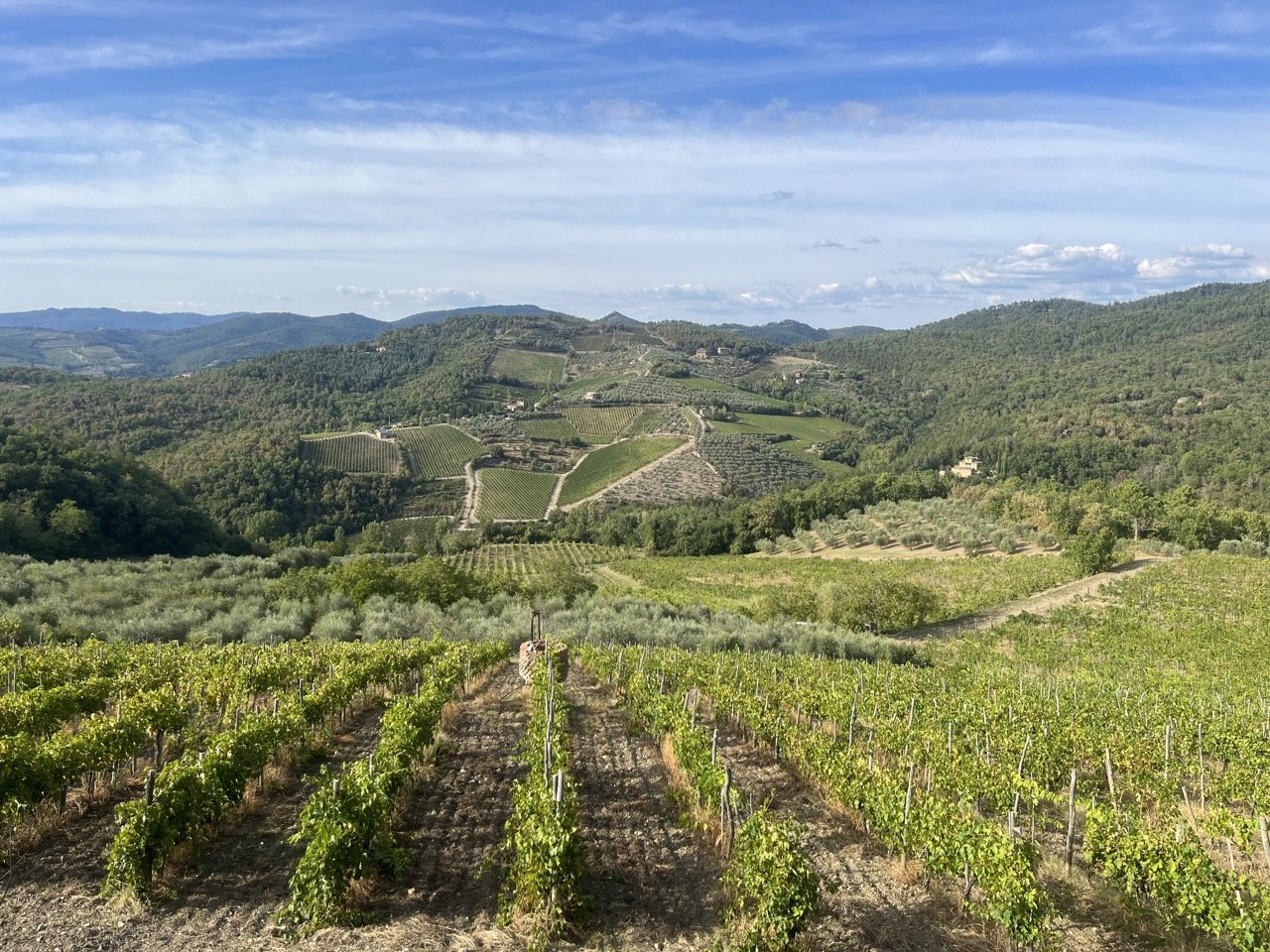
Transportation and how to get around in Tuscany
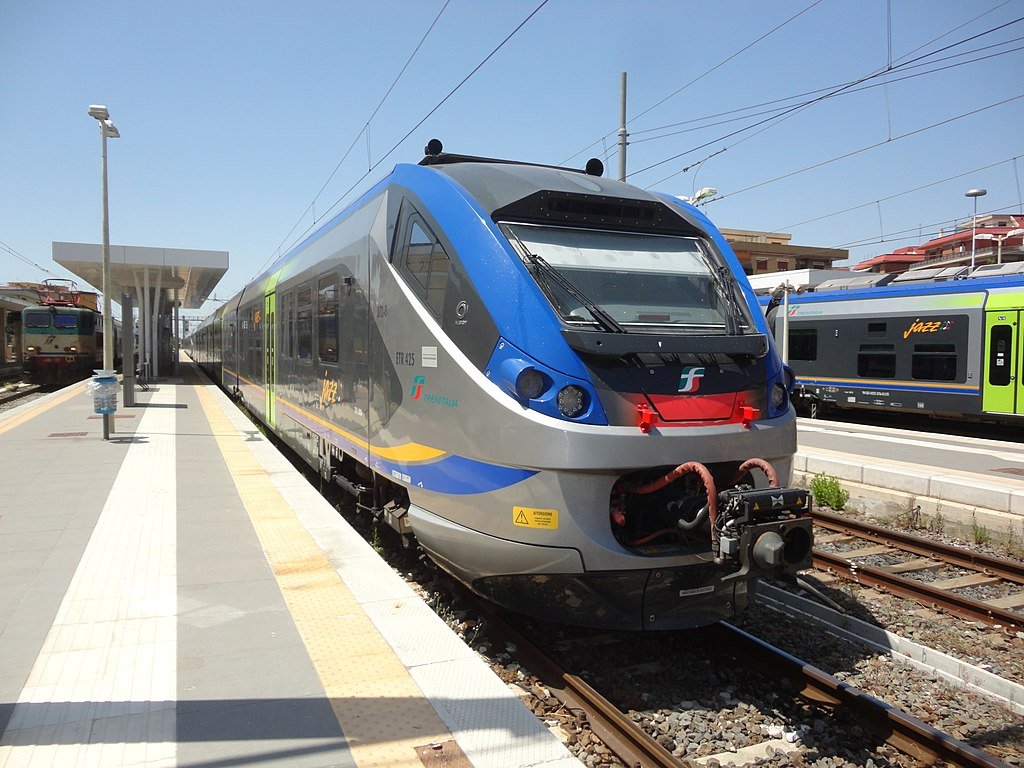
A “Regionale” train. Photo: CAPTAIN RAJU , CC BY-SA 4.0 , via Wikimedia Commons
When it comes to traveling within Tuscany, you can easily bounce between the major cities of the region by train. If you intend to only visit big cities like Florence, Siena, and Pisa, there’s no need to have a car, and it would actually probably be inconvenient to get one.
However, if you plan to visit the countryside, the coast, or smaller towns, you will very likely find that having a car is the most convenient option. Public transportation does not cover rural areas and it’s very slow and indirect for many art/hilltop towns, so unless you want to spend a lot of time waiting around on buses, you’re really better off renting a car.
Renting a car and driving in Tuscany
Renting a car in Tuscany is extremely straightforward. You’ll find rental car offices in major cities like Florence, Siena, and Pisa, as well as at the airports. All of the major international rental car companies can be found here, along with a few local options, and you can pre-book your car online and pick it up when you arrive.
The price per-day for renting a manual-transmission compact car is usually around €30.
Now, regarding driving in Tuscany, Italy is somewhat infamously known for having aggressive drivers, so you might be intimidated by the thought of driving here.
However, Tuscany's peaceful landscapes (which is where you’ll likely be doing most of your driving) are lightly trafficked and the locals in those rural areas usually drive quite reasonably. Driving in the Val d'Orcia or Chianti hills is largely a stress-free experience.
If you are visiting the Argentario Coast during the peak of summer, you will certainly find traffic, but drivers will be mostly laid-back and in no rush, as the area is heavily frequented by people on vacation.
Driving within the cities or in the narrow winding roads of the hill towns can be a bit more stressful, but there’s really no need to use your car within a city or town, so once you park it, you won’t have to worry about repeated trips into heavy, impatient traffic.
Where to find a car rental
For the largest selection of cars and agencies, you should plan on renting in either Florence or Pisa. This is where Tuscany’s two main airports are, so you have the most cars and usually also the best prices.
In Florence, you can rent directly at the airport or at Santa Maria Novella train station. In Pisa, all the rental agencies are at the airport.
You also have a few rental agencies in Siena, a couple in Arezzo, and a few in Chiusi (near to Montepulciano). If you’re coming off of a cruise ship or ferry, the port city of Livorno also has lots of car rental agencies.
To check prices and book, I recommend using the following two car rental websites:
DiscoverCars includes offerings from all the major international rental companies as well as lots of smaller local agencies, which often have much better pricing. You can often find great deals.
AutoEurope tends to be more expensive, but they only list options from large, well-reviewed companies and their customer service is excellent. Their deals often include “zero deductible” (i.e. full coverage) rental insurance.
Road conditions
Most secondary roads in the region are two-lane country roads, and they might not always be perfectly paved.
Medieval towns and villages have tiny and tight roads inside the centers. Mostly uphill, these streets are challenging to navigate. They are usually one-way roads, but this isn’t always true, so you might have to stop, pull over, and let the a passing car go by before you can drive on.
Manual transmission cars
In Italy, it is still popular to drive manual transmissions cars, so if you are not used to it, make sure to select a car with an automatic transmission when booking your rental car (just note that the price might be higher).
ZTLs - traffic limited areas
Some town centers, especially historic ones, have ZTL (Limited Traffic Zone) areas that only residents can drive through. If you drive into a ZTL area, you will almost certainly receive a fine, so always be on the lookout for the signs alerting you to them.
You will see a “no traffic” or ZTL sign at the entrance(s) to the town, so you will know when you can’t proceed with the car.
Finding parking in small towns is often quite difficult, so it’s can be more convenient to leave the car outside the center of Medieval towns and then walk in.
Usually, there will be municipal parking lots right outside of the medieval walls. Many of these are metered, so you’ll need to pay a small fee.
When parking on the street , you will see different strip colors on the curb. White strips mean that the park is free (unless differently specified on street signs), blue strips mean you have to pay, and yellow strips mean you can’t park there.
To pay for parking, you will need to look for parking meters along the curb.
International Driving Permit
An International Driving Permit (IDP) is legally mandated in Italy. Online sources will tell you that it’s not necessary and that you won’t be asked for it when renting a car.
While they are right that rental agencies rarely request to see it, some do, and the police can fine you if you don’t have it.
Train travel in Tuscany
Tuscany is overall well-connected by public transit. Trains and buses operate all over the region, but trains mainly link art cities and the centers along the coast. Regional and local trains are operated by the national rail service, Trenitalia .
In the countryside, you will need to take public buses or taxis to get around if you don't have a car.
Train travel in Tuscany is affordable and efficient, and the major cities and towns are quite well connected. The biggest downside is that many small towns that you may be interested in (like San Gimignano), don't have train stations. Instead, they will need to be reached by bus, or a combination of bus and train.
While most of the main cities/towns have a train station directly in the city center, the hill towns represent an exception to this: they usually don’t have train stations at all, but even when they do have a dedicated station, it will often be located a couple of kilometers outside of the town center.
This is because you can’t run train tracks up hills that steep! In these cases, you’ll have to catch a local bus or get a taxi to take you into the center of town from the train station.
Schedules and frequency of train departures
For routes between popular destinations and big cities, trains depart more or less every hour, with more frequent departures during the peak hours. The frequency of departures varies significantly from one destination to the next, but generally speaking, trains depart as early as 7 am and as late as 11 pm.
Types of trains
In Italy, there are three types of trains:
Trenitalia Frecce fleet - these are high-speed trains that make very few stops between their starting and ending destinations
Intercity , which travel between the country's major cities and towns, making more stops than the high-speed trains, but still not too many
Regionale - slower trains that make a high number of stops within a region
Intercity and Frecce trains assign a specific seat with your ticket, and for popular journeys and/or during busy periods, it’s not uncommon for them to sell out. So, you should always reserve tickets in advance if possible. This will also usually be cheaper than buying at the last minute.
Regionale trains, on the other hand, don’t assign you a specific seat with their ticket (which means you can sit where you prefer or find an empty seat), and as such, never sell out. The certainly can get packed though!
For traveling between the cities and towns within Tuscany, you will likely mostly be relying on Regionale trains, and since they don’t sell out, you can always buy those tickets directly at the train station shortly before your train’s departure. Tickets are also available on the official Trenitalia website/app though.
You also have a company named Italo Treno that runs a network of high-speed trains (similar to Trenitalia’s Frecciarossa fleet) on some of Italy’s most heavily traveled routes.
Validating tickets
If you purchase a physical ticket at the train station, you will need to validate it before boarding the train. There are dedicated machines where you can do this at the station and along the platforms, but if you can’t find them, ask the personnel at the ticket office. If you don’t validate your ticket, you may get ahttps://trainline.tp.st/HluOWC3ghefty fine.
There is no need to validate website-purchased tickets; just show the ticket on your phone to the “capotreno” (train conductor) when asked and you will be all set.
Cost of tickets and booking in advance
Trenitalia train tickets can cost as little as 3€ for local travel, and 50€+ for longer-distance, high-speed train rides. Keep in mind that if you book your long-distance train tickets well in advance, they will be cheaper.
For short routes, there really isn’t a need to buy in advance as the price doesn’t change much. On holidays or at exceptionally busy times of year, you should reserve in advance though just to make sure you get a seat.
Bus travel in Tuscany
In Tuscany, public buses fill the gap that the trains don’t cover, connecting the cities to smaller towns and rural villages. Buses are even cheaper than trains, with tickets costing as little as 1,20€. Bus tickets can be purchased in local kiosks/shops (called "tabacchi" in Italian), inside train stations, and directly onboard from the driver (although they don't always have tickets up for sale).
To validate your ticket, there is a dedicated machine inside the bus, usually in the front, where the driver is.
Bus companies and schedules
The main bus companies in Tuscany are Autolinee Toscane , Sitabus , and Tiemme . You also have Flixbus .
Bus schedules change throughout the year, and it might be challenging to find the updated one, so if you can’t find good information online, it’s best to go to Tourist Infopoints or ask at the "tabacchi" where you are purchasing the ticket. Google Maps is usually quite accurate with bus schedules as well.
In general, the first bus ride from any regularly-serviced destination usually departs around 6 am, and the last trip will be between 10 pm and midnight (depending on how frequented that bus line is, of course). Buses travel between towns on many different frequencies, and you can find them as often as every 10 minutes, or only every couple of hours.
Where to book train and bus tickets
For local buses, you can buy tickets at any bus station, at “ Tabacchi ” (little shops that sell miscellaneous goods, newspapers, and tobacco products - you’ll find them in every Italian town and city). sometimes at bars/cafe, and often aboard the bus.
For longer distance buses and trains, it’s ideal to book directly with the service provider, but the website/app Omio is also very convenient to use.
Taking ferries on the coast
To reach the islands of Giglio and Elba, you’ll need to take a ferry. Elba's ferries depart daily from the towns of Piombino and Livorno. The companies that operate the route are Toremar and Moby. Tickets cost around 20€ one-way and without a vehicle on board.
The ferries to Giglio Island depart daily from the town of Porto Santo Stefano. This route is operated by the Toremar and Maregiglio companies, and a one-way ticket costs around 15€, again, without a car.
Speaking of cars, non-residents cannot bring theirs onto the island during high season, so be aware of this if you’re considering taking your car with you.
Taxis and ride-sharing apps
Ride-sharing apps are illegal in Italy, so these are never an option here. As such, taxis are your only choice. You will find taxis lined up in dedicated locations at airports and train stations, and will usually need to wait in line to take one.
Otherwise, you can google "taxi" followed by the city/town you are in to find the local taxi company that services that town/area. To book a ride, you will usually need to call the company directly.

Compared to other regions in Italy, Tuscany is rather pricey. This shouldn’t be a much of a surprise though, as this is a premier tourist destination that welcomes millions of visitors every year.
Here are some rough prices for typical expenses:
A night at a hotel: 80€ to 150€
An average meal: 15€ for daily lunch specials (typically a main dish, a drink, and coffee or dessert), and 20 to 50 euros for dinner, depending on how fancy the place is and whether you want wine and multiple courses.
A glass of wine: 3€ to 9€
A coffee: 1-2 euros for an espresso or cappuccino at a non-touristy bar/cafe
Renting a car: 30€ per day (potentially much more in the high-season, or if you need an automatic)
A taxi ride within a city/town: 10€ to 25€
Short-distance bus/train ticket: 3€ to 10€
Long distance bus/train ticket (but still within the region): 10€ to 25€
Entrance tickets: 0€ to 25€
There is a wide range of costs here. Local museums or lesser monuments and attractions will usually not cost more than 10 euros, while visiting places like the Accademia Gallery, Uffizi, Siena Duomo Complex, and other premier destinations can cost around 20 euros.
Wine tastings at a winery: 10-20 euros (this usually includes multiple tastings and some light snacks)
Bike/E-bike rental in the countryside: 50 to 100 euros for the day
Guided tours (private and group):
Half-day private guided tour: approximately 250 euros
Full-day private tour: 400-600 euros.
Small group tours: 40-80 euros per person.
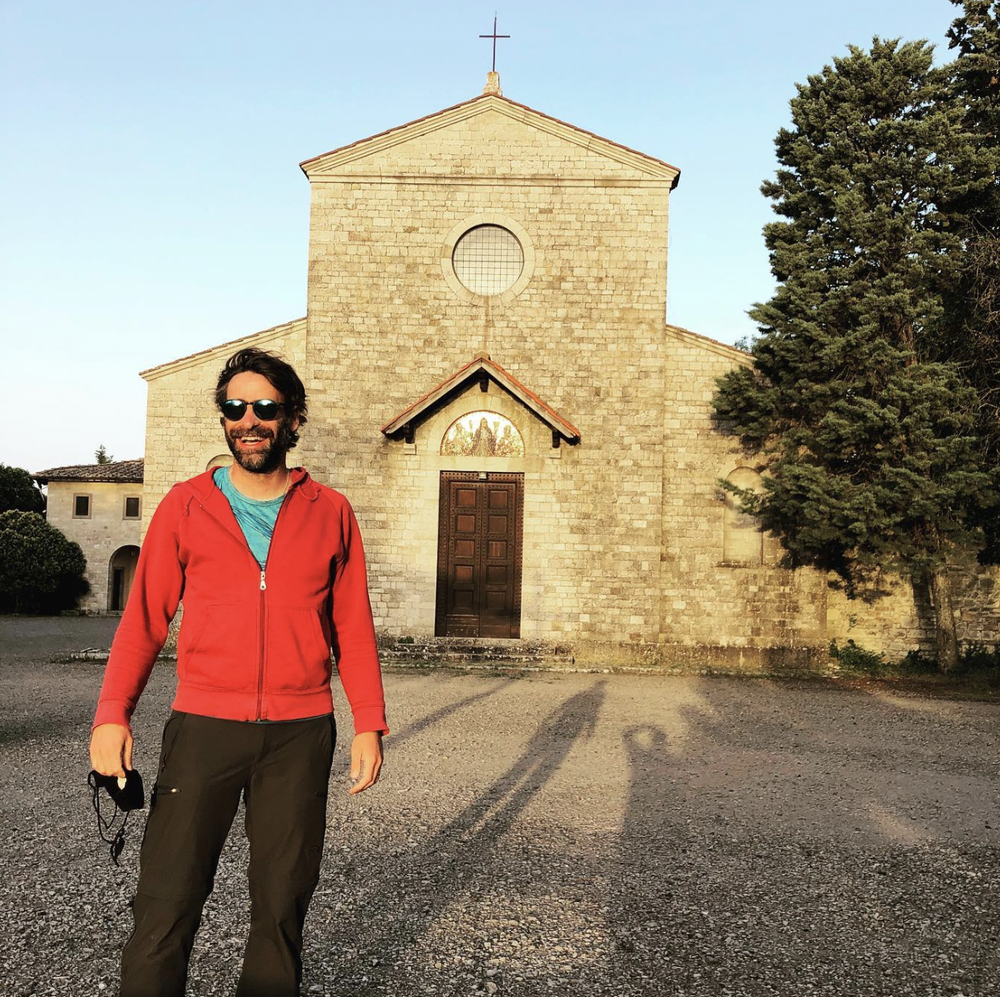
Credit cards
When in Italy, you can pay with both debit/credit card and cash. You can use your card to pay in most places in Tuscany. Just note that some smaller bars can ask you to pay cash if you are consuming a meal that costs less than 5€.
So it is advisable always to have some euros in your wallet. You will find ATMs in every town, but the withdrawal of money might apply some fee.
Tipping is not customary in Italy. However, it is sort of expected by foreigners (and especially from North Americans), and it is appreciated by those working in hospitality.
You can only tip in cash, and how much to tip really depends on you. In general, you should tip a few euros for a short and/or undemanding service (like a drink at a bar). In this case, you usually leave the change if you pay cash. You should tip more for ongoing services (like a week-long cleaning service).
Tuscany is best known for Florence, wineries, and its lovely Renaissance towns where famous artists and scientists lived, from Leonardo Da Vinci to Michelangelo. This is a big region though, and there’s much more to it than just that, so there’s a lot to see and do here!
Here, architectural wonders and artistic masterpieces mingle with beautiful landscapes made up of green hills, cypress trees, vineyards, and olive groves.
An agricultural powerhouse, Tuscany produces excellent-quality olive oil and wines, both which are key-ingredients of the many delicious local dishes made here. As such, food and wine tasting are very popular here.
For scenic drives, rolling hills, and bucolic countryside, the Chianti region and the Val D’Orcia (a UNESCO heritage site) are simply unbeatable.
Heading toward the coast, idyllic beaches with crystal-clear waters backed by coastal plains, such as in the Maremma region, are perfect for snorkeling, boat tours, and other water sports.
And last but not least, Tuscany has two incredible islands that should be on everyone’s bucket list: Elba and Giglio.
For some more ideas, here’s a quick list of some interesting things to see and do when visiting the region:
Visit charming hilltop towns like Cortona , San Gimignano, Montepulciano , and Lucca
Hit the beach - the Argentario area is the best one, also for snorkeling
Go for a wine or olive oil tastings in the Chianti region
Hike in the Apennines, Monte Capanne, or Monte Capanne
Explore the heart of the renaissance: Florence , Pisa , and Siena are the best places to do it
Go truffle hunting in San Miniato
Ride e-bikes through the hills in the Val d’Orcia
Tour Fortezza delle Verrucole (a scenic castle in Garfagnana)
Relax in nature in Parco Naturale della Maremma
Join a food tour in Florence
Take a pasta cooking class. Everyone does it for a reason - it’s good fun!
Ride a Vespa through the countryside - Toursity? Yes. A blast? Also yes.
Learn about marble in Carrara
Go bird-watching at the Laguna di Orbetello
Best Places to Visit in Tuscany
Tuscany is truly blessed with an abundance of wonderful places to visit and things to do. With an incredible number of beautiful towns, great beaches, lovely countryside, and pristine nature, you could spend weeks here and still not see everything.
So, we could easily list 100 “best places to visit”, without exaggerating. However, no one has unlimited vacation time (or money), so you probably won’t be able to see all those places. As such, below is a list of 20 destinations that we think are well-worth visiting whether this is your first time in the region or your tenth.
1. Florence

One of the most visited cities in the world, Florence is packed with astonishing artworks and architecture dating back to the Renaissance. Lying on the Arno River, Florence was home to incredible artists of the likes of Da Vinci, Michelangelo, and Botticelli, who worked to make the city a renowned art capital.
Elegant palaces, incredible museums, and centuries-old churches are not all you will find in Florence. The city is also popular for its culinary traditions and cutting-edge shopping opportunities.

This picturesque town, founded by the Etruscans over two millennia ago, lies 70 km south of Florence. Siena might be small but is full of cultural landmarks and architectural marvels.
From the famous shell-shaped Piazza del Campo to the black-and-white-marbled Duomo, Siena is mainly known for the horse race called “Palio di Siena”, which is held twice a year (in June and August).

Worldwide known for the iconic Leaning Tower, Pisa boasts many other artistic and architectural treasures. One of the richest cities during the Middle Ages, here you can marvel at Romanesque buildings, Gothic churches, and Renaissance squares - with Piazza dei Miracoli being particularly beautiful.
Pisa is also a university town, so it has a lively vibe and hosts great bars, cafes, and cultural events.

Lying very close to Pisa, Lucca has among the best-preserved city walls in Italy. Surrounded by green hills, the walls have been turned into a pedestrian promenade that you can walk to circle this enchanting Tuscan town.
Besides the city walls, Lucca is home to elegant squares, centuries-old churches, and a couple of still-standing lofty towers.
The town is popular in Italy for hosting the Lucca Comics & Games, the country’s biggest comic event held annually between October and November.
5. San Gimignano

You will spot San Gimignano from a distance: the hilltop town is characterized by 14 tall medieval towers that create a unique skyline. Once in number 72, the towers were commissioned by powerful families to show off their wealth.
Climb the towers for breathtaking views of Tuscany hills. The “Town of Fine Towers”, as San Gimignano is called, also has a couple of excellent museums and Gothic and Romanesque buildings lining the streets and main square.
6. Val d’Orcia

Tuscany is beloved for its rolling hills, and the Val d’Orcia is quintessentially Tuscan in this sense. This fertile area extends from the hills south of Siena to Mount Amiata.
Visiting pretty medieval towns like Pienza, Montalcino, and Castiglione d’Orcia are just a few things you can do in the valley. And of course, visiting the wineries is an ever-popular activity.
Relaxing walks among olive groves, tall cypresses, and vines make the area perfect for discovering Tuscan nature.
The dreamy landscapes of the Val d’Orcia have been used for shooting scenes in many movies (like “Gladiator” and “A Midsummer Night’s Dream”, just to name a few).

Sitting on a sloping hillside, Arezzo was once one of the 12 towns of the Etruscan League. With a long and rich history, the city delights visitors with many churches and archeological museums.
Among the city’s highlights is the central Piazza Grande with the Vasari Loggia, the Palazzo della Fraternita dei Laici, Arezzo Cathedral, and Corso Italia, lined with boutiques and shops selling antiques.
Many scenes of the award-winning movie “La Vita è Bella” were shot in Arezzo’s historic center.
8. Parco Naturale Migliarino San Rossore Massaciuccoli
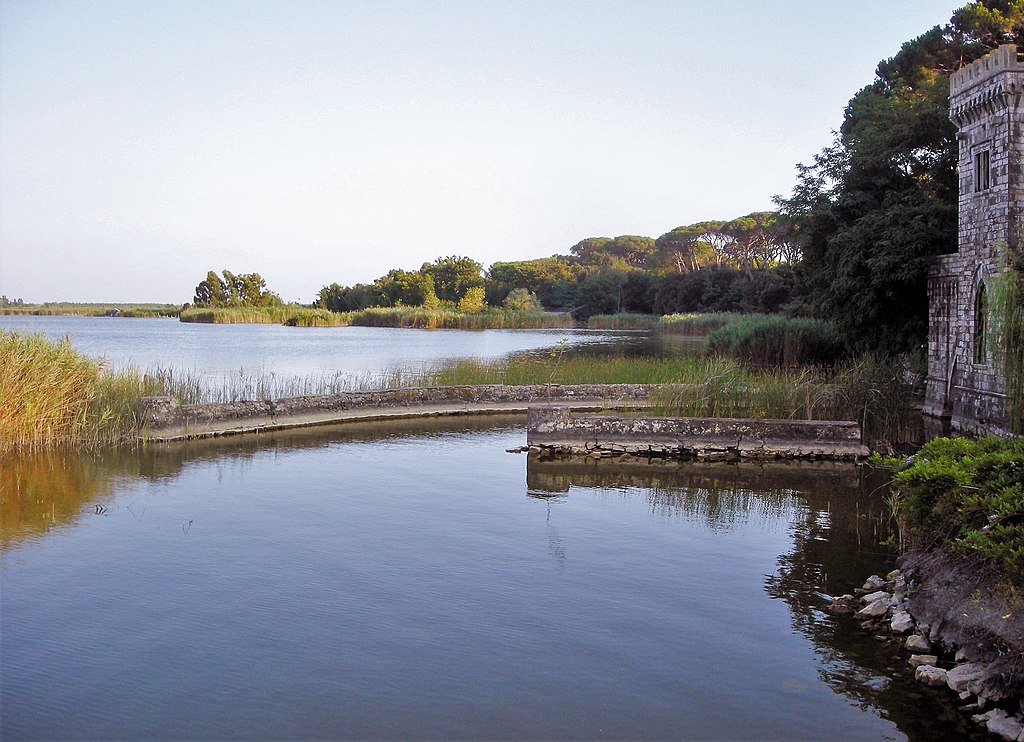
A little inlet on Lake Massaciuccoli. Photo: Albarubescens , CC BY-SA 4.0 , via Wikimedia Commons
The Migliarino Nature Park is a protected area that stretches from Pisa to Lucca. It covers 230 square kilometers and encompasses many habitats, including pine forests, wetlands, and coastal dunes.
The Migliarino Nature Park is perfect for discovering Tuscany’s natural beauty and biodiversity. The area also boasts the lovely Lake Massaciuccoli, which can be explored by bike or walking.

Located in the Province of Arezzo, Cortona is set atop a hill full of Medieval and Renaissance buildings. Cortona’s main draw is the surrounding countryside, where the popular movie “Under the Tuscan Sun” was shot.
Besides the stunning landscape, Cortona has a rich history and heritage that can be discovered by visiting the Museum of the Etruscan Academy, as the town was once part of the Etruscan League.
10. Hot Springs

The Terme di Saturnia
Tuscany has many natural hot springs, some of which are pretty popular (and busy), while others are still under-the-radars. You will find both hot springs enclosed in spa centers and beautiful outdoor hot springs, which are free to visit.
The most famous hot spring in the region is the Terme di Saturnia, which has become pretty busy. If you prefer a less-frequented but just as scenic, head to the Bagni San Filippo, in the namesake village. Here, the small thermal pool is hidden within the forest, and it is characterized by candid-white rocks that create a snow-like covered landscape.

A gorgeous beach on the island

The town of Portoferraio in Elba.
Elba is an island surrounded by the sparkling Tyrrhenian Sea. Famed for being the place of Napoleon’s exile, the island is much more than sun-kissed shores, beautiful beaches, and coves for a beach getaway.
Elba’s coastline is dotted with lovely towns where you can delve into the island’s cultural heritage, such as Portoferraio and Porto Azzurro.
The inner part of the island is home to fertile vineyards, and Monte Capanne, with a height of 1,018 meters, makes for an ideal hiking spot.
12. San Miniato
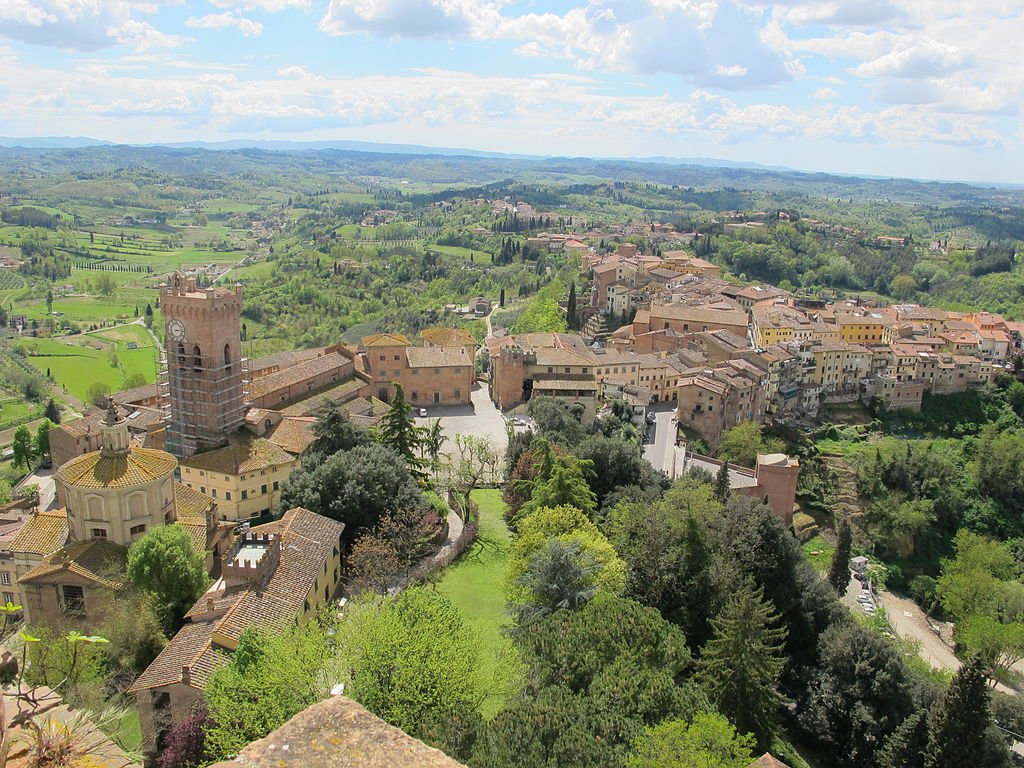
Photo: I, Sailko , CC BY-SA 3.0 , via Wikimedia Commons. Cropped from original
A quaint village in the province of Pisa, San Miniato is the place to be to taste one of the food products you can find in Tuscany: the rare white truffle. To this incredible food is dedicated a whole cultural event, the “Mostra Mercato di Tartufi”, hosted every November. In San Miniato, you can do truffle tastings and also participate in truffle hunting.
The village is also lovely to explore by foot, and its most stand-out feature is the medieval Piazza del Seminario.
But there’s more: San Miniato is one of the stops of the historic Via Francigena.
13. Chianti Region

Gorgeous scenery in Radda in Chianti
Another unmissable area of Tuscany for any food lover is the Chianti region . Kilometers of rolling hills with fertile vineyards create not just a wonderful landscape to discover by bike or motorbike, but it is also where the world-famous Chianti wine comes from.
Having a wine tasting in the Chianti hills while sampling local foods and meeting local winemakers is a must-do experience in the area.
14. Porto Santo Stefano

Located in the Argentario Peninsula, Porto Santo Stefano is a semi-island tied to the mainland. All around Porto Santo Stefano are striking coves that will be the joy of beach dwellers. Some coves are private, while others can only be reached by boat or with a short hike. One of the best coves is Cala Gesso, which is a perfect snorkeling spot.
The town is also one of the main seaports of the area, with a bubbly atmosphere and daily transfers to reach Giglio Island.
15. Giglio Island
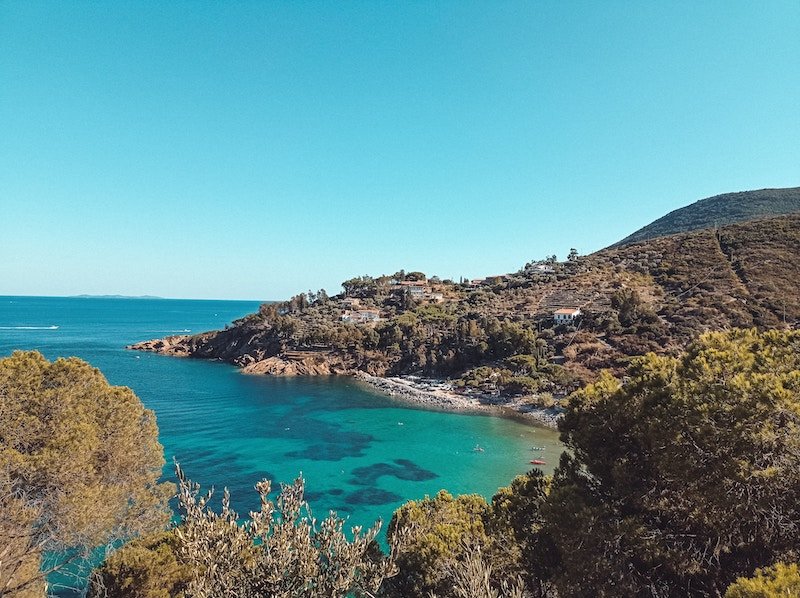
Giglio Island lies within the Arcipelago Toscano National Park, just 16 km from Porto Santo Stefano.
This Mediterranean island offers visitors natural beauty and rich history. The narrow streets of the main town of Giglio Porto are lined with artisan stores and outdoor restaurants.
The island is home to stunning beaches for swimming and snorkeling - don't miss Campese Beach and Cannelle Beach.
Another highlight of Giglio Island is the town of Giglio Castello, on the island's highest point, where you can visit the medieval fortress Rocca Aldobrandesca to marvel at 360-degree landscape views.
16. Volterra

Volterra is one of the larger hill towns in Tuscany. Located between the Era and Cecina valleys, Volterra is enclosed by double walls of Etruscan and Medieval times. If you like narrow streets, ancient walls, and a towering fortress, you will surely love this town.
Volterra is particularly known for the craftsmanship of alabaster, and you can purchase decorative objects in the many artisan shops in town or visit the interesting Ecomuseum of Alabaster.
17. Monteriggioni
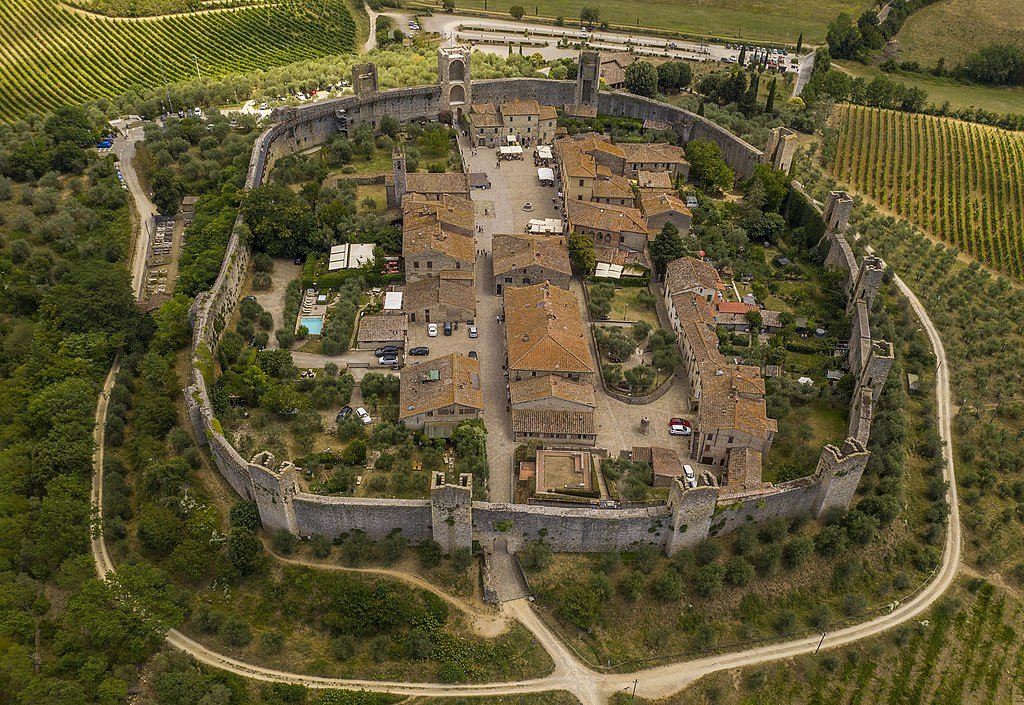
Photo: Maurizio Moro5153 , CC BY-SA 4.0 , via Wikimedia Commons. Cropped from original
Another walled town in Tuscany, Monteriggioni's main feature is the 13th-century castle that overlooks the entire landscape. You can walk on the medieval walls that are part of the castle to have a bird's eye view of the Chianti countryside. The town also has 15 still-standing medieval towers, two impressive doorways, and charming little streets.
Monteriggioni is located along the pilgrimage route known as Via Francigena, and it was featured in two famous movies, "The English Patient" and "The Gladiator".
18. Orbetello

Orbetello is a seaside town in the Argentario, with a lovely center with shops, restaurants, and a lively weekly market selling local food products. But Orbetello is much more: the town boasts a lagoon, which makes the area geographically unique. The Laguna di Orbetello is rich in fauna of all kinds, which is protected by the WWF.
The lagoon is surrounded by a cycle-pedestrian path that you can go through to admire pink flamingos, white herons, and flocks of coots.
19. Livorno

Livorno is an important port town in Italy, where ferries depart for many other parts of Italy, including the Elba Island in Tuscany.
Embellished during the Renaissance by the Medici family, in Livorno, you can visit many attractions like a castle (the Fortezza Nuova), the beautiful Terrazza Mascagni (a sea view terrace), and the Nuova Venezia (the streets surrounding the castle, which are lined with canals).
20. The Tarot Garden
Tuscany has an unusual attraction, The Tarot Garden. This artistic garden is located right outside the village of Capalbio, and it was created by the mind of artist Niki de Saint Phalle.
The park houses installations representing the 22 major arcana of the divinatory tarot, which are made of iridescent mosaic tiles and metal. The artist took almost 20 years to complete this project, and this magical attraction is open from the beginning of April through mid-October.

5-day itinerary - Art towns
Days 1-2: Florence
Day 3: Pisa and Lucca (day trip from Florence)
Day 4: Siena
Day 5: San Gimignano, Monteriggioni, Colle di Val d’Elsa (day trip from Siena)
7-day itinerary - Art towns and the Chianti area
Day 6: Chianti region
Day 7: Arezzo and/or Cortona
10-day itinerary - Art towns, the countryside (Chianti and Val d’Orcia), and the coast (Argentario and Giglio Island)
Day 5: Chianti region
Day 6: Val d’Orcia with Montepulciano
Day 8: Terme di Saturnia
Day 9: Argentario (Porto Santo Stefano and Porto Ercole)
Day 10: Giglio Island
2-week itinerary - The best of Tuscany (art towns, islands, Argentario, hot springs, and the countryside)
Day 4: San Miniato
Day 5: Elba Island (ferry from Livorno)
Days 5-6: Porto Santo Stefano & Porto Ercole
Day 7: Giglio Island
Day 8: Bagni San Filippo
Days 9-10: Val d’Orcia with Montepulciano
Day 11: Cortona or Arezzo
Day 12: Siena
Days 13-14: Chianti region
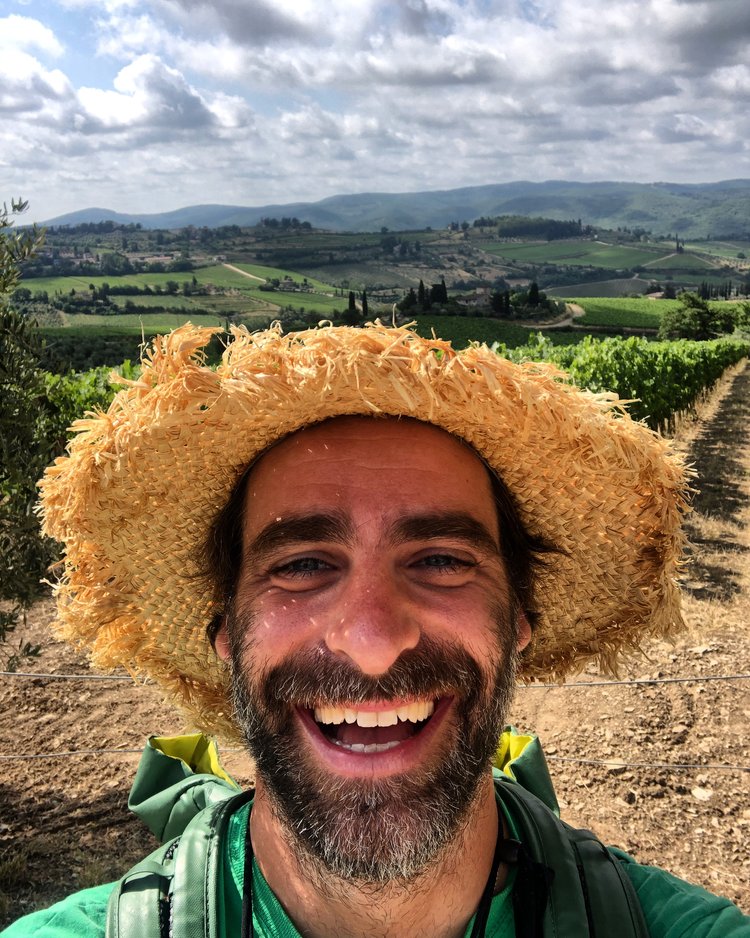
At Go Ask A Local we connect independent travelers with in-destination Local Experts for personalized travel planning that goes way beyond the highlights. Whether you’re planning a DIY trip and just want some expert advice on your plan or are looking for a fully tailor-made trip, our Local Experts can help you plan better!
One-week Serbia Road Trip Itinerary - By A Local
A local’s guide to travel in madeira.

The Ultimate Tuscany Itinerary – 7 Days
Tuscany is the part of Italy I’ve visited the most owing to my parent’s love of the area.
Over the years we’ve visited and re-visited the places on this best Tuscany itinerary.
A Tuscany vacation should be on your Italian bucket list for sure.
My siblings and I would roll our eyes every time one of our parents said “wow! Look at the view!” as they gazed at the rolling hills covered in vineyards and olive groves.
But now we’re older we too can appreciate the view.
Tuscany is a region in Central Italy and has coast land, hills, beautiful towns, awe-inspiring artworks, and incredible food. It’s where you’ll find popular Italian destinations such as Pisa, Florence and Siena.
The scenery has been the backdrop to many films over the years including Under the Tuscan Sun, A Room with a View, Gladiator and Twilight.
If you’re planning a Tuscany trip and looking for awesome Tuscany itineraries, you’ll find it below.
Table of Contents

How many days do you need in Tuscany?
If this is your first time visiting Tuscany I highly recommend giving yourself at least 5 days in Tuscany. This is enough to see some of the major cities in Tuscany and enjoy them without feeling too rushed.
This is a 7 day Tuscany itinerary which takes you through some of the main sites in Tuscany, and some hidden gems and allows you some time to relax too.
If you have longer you could easily spend 2 weeks in Tuscany.
This is what we did on our most recent trip.
It allowed us time to go further afield, e.g. to Rome, and to spend days lounging by the pool at the villa which we’ve stayed at about 5 times.
A sample itinerary for Tuscany in 7 days could look something like this, depending on where you’re flying in and out of.
- Day 1 : Arrive in Florence
- Day 2 : Explore Florence
- Day 3 : Drive to Siena via San Gimignano, explore Siena
- Day 4 : Drive Val d’Orcia (Montalcino, Montepulciano, Pienza,) overnight in Montepulciano
- Day 5 : Hot Springs at Saturnia, overnight at Volterra
- Day 6 : Drive to Pisa, explore Pisa
- Day 7 : Drive back to Florence (visit Lucca if time)
Best way to get around Tuscany
If you’re just keen to visit the cities in Tuscany you can definitely get around using trains and buses. The main cities are well connected to places like Rome, Florence or Pisa and train travel is fairly cheap and easy to navigate.
This Tuscany 7 day itinerary is written with car access in mind. It allows you time to explore some of the back roads and stop in small towns that aren’t as well connected.
However, you could still visit most of the places on this list by arranging day tours from some of the larger cities. Where possible, tours are recommended further in this post.
Flights to Tuscany, Italy
The best airports in Tuscany Italy are Florence airport and another airport in Tuscany is Pisa airport. Both of these are served by budget airlines in Europe.
You can also fly to Rome and then get a bus or train to Siena, Florence or Pisa.
On my latest visit to Tuscany, I flew to Rome as that’s where the cheapest flights were to.
Skyscanner is what I use to find cheap flights.

Tuscany road trip
The best way to experience this 7 day Tuscany itinerary is to rent a car, or if you’re coming from the UK or elsewhere in Europe you can drive into Italy with your own car.
If you’re driving from another country, be sure to check the rules. For British drivers, you don’t currently need an International Drivers Permit (IDP), but you do need to have your full insurance papers, license and additional safety equipment.
If you’re renting a car with a Canadian or American license (+ perhaps others, please check!), then you need an International Drivers Permit (IDP) as well as your full license in order to rent a car.
If you do not have an IDP, you will not be able to rent a car. Sure, you may find somewhere that’ll do it anyway, but any insurance you have will be void by not having an IDP.
Cars can be rented from Pisa or Florence airports on arrival if you’ve flown into Italy.
I use comparison sites like DiscoverCars and RentalCars to book my car rentals as it’s easy to check prices and compare the best deals!
Top tips for driving in Italy
These two top tips for driving will help your 7-day Tuscany itinerary go a bit smoother!
Avoid ZTL zones wherever possible
ZTL zones are areas of cities that are restricted access. They are typically in the city centre and if you drive through them you risk getting a big fine or charge.
If you’re renting a car the charge will be even bigger since rental companies will add some sort of admin fee on top of the original fine.
You can avoid these by looking up a place to park that’s outside of the city centre ahead of time. I like to use parkopedia to find places or just google ‘ parcheggio ‘ in Google Maps.
Expect toll roads
There are toll roads throughout Tuscany. They’re usually not too expensive, and most take card, but it’s always handy to have a few coins in your car just in case.
Tuscany by train
Getting around Tuscany by train is definitely doable. Trenitalia operates regional trains and they stop at the main cities such as Florence, Pisa and Siena as well as smaller towns too.
You can book trains online in advance by using TheTrainline.com which makes it super easy to plan your journey ahead of time!
Best places to visit in Tuscany
Below is more information about each of the stops on this 7 days in Tuscany road trip itinerary. You’ll find links to recommended tours and more information within each section.

Days 1 + 2: Explore Florence
Florence is the capital of the Tuscany region in Italy.
It’s a beautiful city with centuries of history and is home to masterpieces of Renaissance art and architecture. This includes the famous Florence Duomo, the Galleria dell’Accademia which houses Michelangelo’s “David” sculpture and the Uffizi Gallery.
The city of Florence sits on the river Arno and there is plenty to explore which is why this Tuscany itinerary spends two days in Florence.
I highly recommend booking your entrance tickets to galleries before you arrive as that way you can skip the lines (which are super long in high season!).
Top of the list of things to do for your two days in Florence and Tuscany itinerary are:
- The Duomo , Santa Maria del Fiore
- The Piazza Della Signoria
- The Uffizi Gallery (if you’ve reserved priority tickets )
- Mercato Centrale – leather goods and food!
- Stroll the Ponte Vecchio
Doing this Tuscany itinerary without a car? Check out these guided tours
If you’re travelling in Tuscany without a car, these guided tours could be perfect for you. They pick you up from Florence and drop you back too.
- Tour from Florence: Siena, San Gimignano and Monteriggioni day tour (one of the best Tuscany wine tours)
- Tuscany day trip with lunch and wine
- From Florence, Pienza and Montepulciano guided wine tour
Day 3: Drive to Siena via San Gimignano
From Florence, it’s time to head out into the super picturesque parts of Tuscany!
San Gimignano
Often cited as one of the best Tuscany towns , San Gimignano is a super cute Medieval hilltop town complete with cobbled streets that’s well worth being on your one week Tuscany itinerary.
This pretty place to add to your Italy Tuscany itinerary is also a UNESCO World Heritage Site.
There are 15 towers throughout the charming little town and it’s super popular with people looking to experience Tuscan history and culture.
Spend some time wandering around the streets in the city, visiting the piazzas, like the beautiful piazza della cisterna , the medieval fountains, and, of course, the Duomo in San Gimignano.

Siena is a beautiful city that’s sometimes overlooked in favor of other Tuscany cities and towns.
However, it’s well worth being on this Florence Tuscany itinerary.
You only really need one day in Siena to tick off the main sights.
Siena is known for the Palio horse race that takes place twice every summer in the center of the city, as well as its beautiful marble-striped Duomo, Piazza del Campo, old town streets, and stores to explore.
Be sure to climb up to the top of some of the towers, such as palazzo vecchio , for views over the historic city center.
If you don’t have a car
If you don’t have a car, this tour is recommended for the following day. It’s a food and wine-tasting tour where you’ll be picked up and dropped off at Siena.
You’ll visit Pienza, and taste world-famous wines produced in Montalcino and Montepulciano as well as some snacks to eat.
Where to stay in Siena
$ – B&B San Francesco: In a 15th Century building, this B&B in Tuscany Italy is just a short walk from Piazza del Campo. The rooms have city views, free wifi and include breakfast.
$$ – Il Vezzosino: Have your own apartment while staying in Siena. This 1-bed apartment has a terrace and garden view
$$$ – Residenza d’Epoca Campo Regio Relais: This beautiful building has incredible views of Torre del Mangia and the Siena Duomo. Rooms include breakfast and you’re just steps away from the best things to do in Siena Italy.


Day 4: Take a Val d’Orcia road trip
From Siena, it’s time to explore Val D’Orcia which is a region of Tuscany, central Italy. Val d’Orcia extends from the hills south of Siena to Monte Amiata.
Today you’ll drive through Val d’Orcia and stop off at Montalcino, Pienza and Montepulciano where you’ll spend the night.
Along the way, you may want to go wine tasting for the Brunello wine found near Montalcino, or just stop off and soak up the views of rolling vineyards and Tuscany’s beautiful hilltop towns.
This is one of the areas in Tuscany that’s most beautiful – and that’s saying something!
There are so many vineyards around Montalcino. Most charge a small fee per wine tasting and have several you can try.
Some notable places to stop on a Val d’Orcia road trip include:
- The Cappella di Vitaleta – a super cute church that’s a popular photo spot
- Bosco di Cipressi – a group of cypress trees that is also popular with photographers
- Bagno Vignoni – cute town with thermal hot springs
Where to stay in Montepulciano
Montepulciano is one of the best towns in Tuscany to stay in. It gets busy during the day but most people will leave once evening comes so you’ll get to explore it without the crowds!
- Camere Bellavista : This accommodation in Montepulciano is right in the centre of the town and every room has views of the Tuscan countryside.
- Palazzo Carletti: This luxurious accommodation in Montepulciano has panoramic views and is in a beautiful Medieval building.
- Agriturismo Cognanello: Stay on a real Tuscan farm just 2km from Montepulciano. Every guest gets a welcome package with local oil, wine and fruit too!

Day 5: Visit the Saturnia hot springs in Tuscany and explore Volterra
The Saturnia hot springs are some ice-blue hot springs in southern Tuscany. Only they don’t feel icy, they’re hot!
The hot springs themselves are called “ Cascate di Mulino ” and are just under 6 km outside of the town of Saturnia.
As with most hot springs in Tuscany and elsewhere, the waters are rich in mineral deposits, especially sulphur which gives it an “eggy” smell.
The pools get very busy so it’s best to go super early in the morning to beat the worst of the crowds.
Once you’re done at Saturnia, head up north again towards Volterra.
Another beautiful Tuscan hilltop town, Volterra has a long Etruscan history and, more recently, played a part in the Twilight series.
The town has basilicas, cobblestone streets, crumbling gateways, and red-tiled roofs.
It’s a great place to wander around in the afternoon and grab dinner here before retiring to your accommodation in Volterra.
Below are some places to stay for this part of your Tuscany countryside itinerary.
Places to stay in Volterra
- Residenza Storica Palazzo Ricciarelli : This beautiful 1-bed accommodation in Volterra has everything you need for the night.
- Casa Mosaico: This guest house in Volterra has city views which you’ll love!
- Hotel La Locanda : This Volterra hotel is decorated with Etruscan carvings and offers a buffet breakfast to guests.

Day 6: Explore Pisa
If you know anything about Pisa, the chances are that you know about the Leaning Tower of Pisa.
This small city in the Tuscany region of Italy is famed for the tower which is slightly off-tilt.
While many visitors come to view the Leaning Tower of Pisa and then leave, there’s actually so much more to this city and plenty to keep you entertained for one day in Pisa!
Check out my ultimate guide to the best things to do in Pisa Italy!
Besides the Leaning Tower of Pisa and the complex around it, there’s also the River Arno and the Palazzo Della Carovana which you should explore.

Day 7: Visit Lucca
Your final stop on this Tuscany itinerary is the city of Lucca. However, if you have an early flight you can head off to Florence straight away.
Lucca is known as the city of a hundred churches and is well-known for the beautiful Medieval city walls that can still be seen around the old town.
The best things to do in Lucca include the Lucca Cathedral, Piazza dell Anfiteatro, and San Michele in Foro.
Where to stay in Lucca
- La Chiusa delle Monache: This B&B includes a great breakfast and has its own courtyard for relaxing after exploring Lucca.
- The Old Laundry: This two-bedroom apartment is beautiful with a private courtyard and is super close to the town centre.
- Al Carmine Apartments: With incredible views, these apartments are just 100 m from Guinigi Tower and 200 m from Piazza dell’Anfiteatro.
Other places to add to your Tuscany Itinerary
If your Tuscany itinerary is 10 days or longer, you could check out some of the destinations and things to do in Tuscany listed below.
Visit the beaches in Tuscany Italy
It may come as a surprise but the region of Tuscany actually has a coastline, a pretty one at that!
Most visitors to Tuscany are more focused on the hilltops and vineyards and forget about the coast, but if you have more time then head out to visit the beaches in Tuscany, Italy.
Some of the best beaches in Tuscany are:
- Castiglioncello : A famous seaside destination that has beautiful sand beaches, pine forests, coves and pebble creeks.
- Cala Violina : A wonderful cove in Maremma with white fine sand. To get there you walk a trail with incredible views of the coastline.
- Giannella beach : Characterised by sand dunes and beautiful waters.

If you have the time, 3 days in Rome is perfect for exploring the city. It allows you plenty of time to explore the top attractions in Rome while enjoying it at a more leisurely pace.
Obviously, you should visit the Colosseum and forum, the Pantheon, Spanish Steps, and Trevi Fountain and head for food and drink in Trastevere is a must too.
You could also spend a day alone exploring the Vatican and its museums.
Get skip-the-line tickets, guided tours and access to over 35 of Rome’s top attractions with a GoCity® Pass. You’ll save up to 50% compared to buying individual attraction tickets & can get the pass straight to your phone.

Cinque Terre
Just north of Tuscany in the Liguria region is Cinque Terre. A Tuscany and Cinque Terre itinerary makes a great vacation to Italy.
The Cinque Terre is famous for its beauty and today visitors explore the five towns by walking the rugged, steep trails between them.
As you hike you’ll get breathtaking views of the harbors, medieval fortresses, and vibrant colors; it’s beautiful!

Lake Como is one of the best lakes in Italy and also one of the most popular lakes in the Italian Lake region.
I recommend spending about 4 days in Lake Como. If you’re looking for an Italy itinerary 7 days long, I’d combine Como with some time in Milan too.
If your flights are going in and out of Milan then stopping in Lake Como is a must as it’s just 40 km or so to Lake Como from Milan.

Assisi is associated with St. Francis of Assisi who was a popular pilgrim related to animals.
If you’re visiting Assisi you can tour the beautiful Basilica of St. Francis while learning about the saint’s life and history.
This is an interesting stop if you have more than one week in Tuscany.

Tuscany Itinerary 5 days
Not everyone has a full week to spend in Tuscany, especially if the start and end of your holiday to Tuscany is taken up with travel time.
In that case, here’s a 5 day itinerary for Tuscany that’ll give you a taste of the best that Tuscany has to offer.
Day 1: Florence
- Morning: Uffizi Gallery : One of the world’s top art museums with works by Michelangelo, Botticelli, Leonardo da Vinci, and more. Wander around Piazza della Signoria .
- Afternoon: Florence Cathedral (Il Duomo) : Climb to the top for a panoramic view of the city. Ponte Vecchio : Iconic bridge with shops built along it.
- Evening: Tuscan dinner in the historic district. Try a traditional “Bistecca alla Fiorentina”.
Day 2: Siena
- Morning: Visit the Siena Cathedral (Duomo di Siena) and then wander the medieval streets.
- Afternoon: Visit Piazza del Campo which is known for the Palio horse race and then explore Torre del Mangia for views of the city.
- Evening: Enjoy dinner in one of the local trattorias and try pici pasta.
Day 3: Chianti Wine Region
- Morning and Afternoon: Go wine tasting and visit a few vineyards. Notable ones to check out include Castello di Verrazzano and Castello di Brolio . Then, explore towns like Greve in Chianti and Radda in Chianti .
- Evening: Stay in a local agriturismo (a farm stay) and enjoy a meal made with local produce.
Day 4: San Gimignano and Volterra
- Morning: Explore San Gimignano which is a medieval town known for its towers
- Afternoon: Drive to Volterra a hilltop town known for its Etruscan history and alabaster products.
- Evening: Dine in Volterra or return to San Gimignano for a lovely dinner with views.
Day 5: Lucca and Pisa
- Morning: Explore Lucca and wander inside its well-preserved Renaissance walls. Don’t miss Lucca Cathedral and Guinigi Tower .
- Afternoon: Head to Pisa to see the iconic Leaning Tower of Pisa and the nearby Pisa Cathedral and Baptistery .
- Evening: Enjoy a final Tuscan dinner in Pisa, trying dishes like Tortelli Lucchesi.
Tuscany itinerary 10 days
If you have more than 1 week to spend in Tuscany, check out this 10 day Tuscany Italy itinerary for some more ideas.
- Days 1-3: Florence : Visit the Uffizi Gallery, one of the world’s top art museums with works by Michelangelo, Botticelli, Leonardo da Vinci, and more. Wander around Piazza della Signoria , climb to the top of the Florence Cathedral (Il Duomo), and visit the Ponte Vecchio.
- Day 2: Explore the Boboli Gardens , visit the Palazzo Pitti , and spend your evening in the bohemian Oltrarno area.
- Day 3: Visit the Accademia Gallery to see Michelangelo’s David, explore Santa Croce Church , and do some shopping at the San Lorenzo Market .
- Day 4: Fiesole : Just a short bus ride from Florence, explore the Roman Amphitheatre, and enjoy panoramic views of Florence.
- Days 5-6: Siena and Monteriggioni : Visit the Siena Cathedral (Duomo di Siena) and then wander the medieval streets as well as Piazza del Campo which is known for the Palio horse race and then explore Torre del Mangia for views of the city.
- Day 6: Visit the walled town of Monteriggioni . Spend half a day wandering its walls and the small, historic center.
- Day 7: Chianti Wine Region : Go wine tasting and visit a few vineyards. Notable ones to check out include Castello di Verrazzano and Castello di Brolio . Then, explore towns like Greve in Chianti and Radda in Chianti .
- Days 8-9: San Gimignano and Volterra : Explore San Gimignano which is a medieval town known for its towers and Volterra a hilltop town known for its Etruscan history.
- Day 10: Lucca : Explore Lucca and wander inside its well-preserved Renaissance walls. Don’t miss Lucca Cathedral and Guinigi Tower .

Tuscany itinerary 14 days
Below you’ll find an outline of a 2 week Tuscany itinerary that you could use for a longer stay.
- Days 1-4: Florence : Find things to do in Florence listed in the above itineraries and extend your Florence stay by one day to truly absorb the city’s art and culture.
- Day 5: Fiesole
- Days 6-7: Siena and Monteriggioni . Visit the Siena Cathedral (Duomo di Siena) and then wander the medieval streets as well as Piazza del Campo which is known for the Palio horse race and then explore Torre del Mangia for views of the city.
- Day 8: Chianti Wine Region : Go wine tasting and visit a few vineyards. Then, explore towns like Greve in Chianti and Radda in Chianti .
- Days 9-10: San Gimignano and Volterra : Explore San Gimignano which is a medieval town known for its towers and Volterra a hilltop town known for its Etruscan history.
- Day 11: Lucca : Explore Lucca and wander inside its well-preserved Renaissance walls. Don’t miss Lucca Cathedral and Guinigi Tower .
- Day 12: Pisa : Dedicate a day to Pisa, visiting the Leaning Tower , Pisa Cathedral , Baptistery , and wandering the city.
- Day 13: Arezzo : Visit the beautiful town of Arezzo , known for its churches, antique market, and the fresco cycle by Piero della Francesca in the Basilica of San Francesco.
- Day 14: Cortona : Explore the hilltop town of Cortona , made famous by the book and film “Under the Tuscan Sun”. Wander its medieval streets, visit its museums, and enjoy panoramic views of the surrounding landscape.

When is the best time to visit Tuscany?
No matter the time of year you’ll have to experience the beauty of Tuscany.
Summer is often cited as the best time to visit Tuscany as it’s when the weather is best. However, it’s also when the crowds are at their biggest meaning long lines for the best things to do in Tuscany such as museums and galleries.
I’ve also visited Tuscany in spring and in late September and October and while it is a little bit colder and more likely to rain, there are usually fewer people around and prices are lower.
FAQs about this best itinerary Tuscany Italy
How many days in tuscany.
When it comes to how many days in Tuscany, I recommend spending 7 days in Florence and Tuscany which gives you time to visit other nearby places as well as see the city of Florence too.
Is Tuscany or Florence better?
Tuscany is a region known for landscapes and historic towns, while Florence is its capital of Tuscany and a city in Tuscany known for art and architecture. If you visit Florence, you’re visiting Tuscany.
What are the best months in Tuscany?
The best months in Tuscany are May, June, September, and October, offering pleasant weather and fewer crowds.
Is it better to go to Tuscany by train or car?
Going by car is preferable for exploring Tuscany’s countryside and smaller towns, while trains are efficient for connecting major cities.

Final thoughts on this Tuscany Itinerary 7 days
This Tuscany road trip 7 days itinerary has hopefully given you some ideas on how to plan your Tuscany travel itinerary.
From exploring big cities and towns like Florence and Siena to smaller countryside and hilltop towns, this Tuscany trip itinerary gives you a complete whistlestop tour of Tuscany.
If you want to add more stops to your Tuscany Italy itinerary I’ve included some places like Lake Como and Rome which are well worth checking out.
And, of course, you could go further south and explore places like Sicily, or go north and explore the Dolomites in Italy.
For more European travel guides to places like Norway, Switzerland, and the UK, check out my Europe travel guides.
Last Updated on September 7, 2023 by Hannah

Hannah started That Adventurer after graduating back in 2013 and has documented all of her adventures since then. From backpacking South America to city breaks in Europe , a 3 month road trip across the USA in a self-converted van and 6 years living in Canada , you’ll find posts on all of this.
Hannah specialises in active travel and on That Adventurer you’ll find hiking, walking, biking, skiing and all sorts of active travel guides to allow you to see a destination in an adventurous way.
Now back in Europe, you’ll find new guides as Hannah and her husband spend the next year ‘digital nomading’ from Norway to Portugal, Switzerland to Scotland and places in between.
Leave a comment Cancel reply
You must be logged in to post a comment.
You are using an outdated browser. Please upgrade your browser to improve your experience.
Fall in love with Tuscany!
Discover Tuscany Newsletter
Ask the Tuscany Experts on our Forum
- Book your Hotel
- Rentals by Owners
- Museums & Tours
Get the lowest rate for your Hotel in Tuscany through Booking.com
Get the best deal direct from the owners on TuscanyAccommodation.com
Book your unique Tuscan Experience
Book your Tour
Book your Tickets ahead & Skip the line!
Buy Museum Tickets
- Tourist Info
- Getting to Tuscany
There are many reasonably priced flights to Italy , generally to the larger international airports in Milan or Rome . From there, you can easily rent a car and drive to Tuscany or take a train to Florence. You can also look for flights that fly into Pisa, Bologna or Florence (from other European hubs) to get even closer to your destination without needing the extra travel in between.
If you live in Europe, it is easy enough to travel overland to Tuscany (by car or train) but there are also good deals with low-cost air companies, such as Ryan Air (it flies both to Pisa and Bologna). Depending on whether you want to visit other areas in Italy, you should also consider traveling by train as it is very convenient. Read the articles below for further details on the various ways to get to Tuscany and start your wonderful holiday in this beautiful region!
Related Sections
- Chianti Map
- Moving around Tuscany
You Might Also Like
- Tuscany Tourist Info
You'll love reading about...

Flying into Tuscany: Pisa and Florence
Information on Tuscany's two main airports, the Galileo airport in Pisa and the Peretola/Vespucci airport in Florence, and tips on how to move to other parts of Tuscany from there.

Getting to Tuscany by Train
Practical information on traveling by train, with details on the Tuscany railway system and tips for getting to Tuscany.
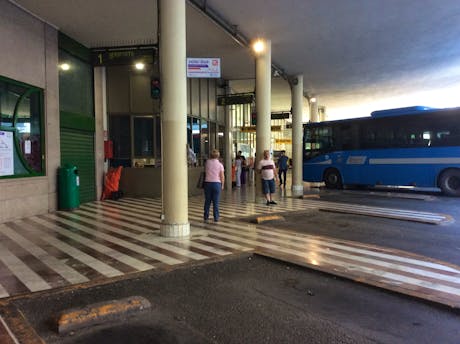
Getting to Tuscany by Bus/Coach
Practical information on getting to Tuscany by bus from across Italy and Europe.
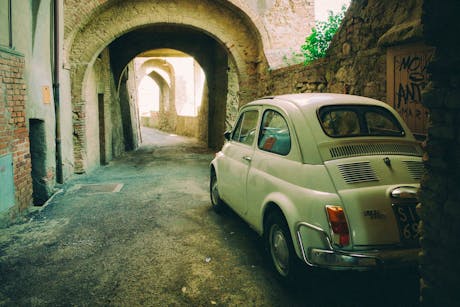
Getting to Tuscany by Car
Practical information for getting to Tuscany by car, such as major roads and tips for driving in Italy.
Top Experiences in Tuscany
Our travel guides.

Campiglia Marittima- Discover the Top 4 Must-Visit Sights
Castel del piano – tuscany’s enchanting escapes revealed, what is rome famous for – 28 things that make rome…, coffee shop in florence – 14 choices for your caffeine fix, northern vs southern italian food – 14 rich culinary delights, sorrento food – cuisine with rich history and tradition, amalfi coast food – 13 typical dishes to taste, tuscan food – a wealth of pasta sauces, soups, and sweets, tuscan desserts – sweets, cookies, cakes, and wines, what to wear in rome – where fashion meets history, rome to tuscany – navigating the best travel route, italy in january – your winter guide for 10 things to…, rome in january – visiting the eternal city in winter, rome to amalfi coast day trip- everything you need to know.

How to Get to Tuscany – The Smart Traveler’s Guide
Coming from the United States, I was looking for the simplest and most hassle-free way on how to get to Tuscany. Several airlines run non-stop direct routes from select US cities, and you can get there with more than one method.
If you wish to arrive in Tuscany, most people from the US will take a direct flight to Leonardo da Vinci-Fiumicino Airport in Rome due to the greater number of direct flights. Some of the cities that offer direct flights include Atlanta, Boston, Chicago, Los Angeles, Miami, New Jersey and New York. Once there, you can take a train, plane or rent a car to get to Tuscany.
If you’d like to learn more in-depth information about how to get to Tuscany, keep reading. We’ll cover which ones for getting to Tuscany are the easiest and how long the duration for each one is.
Getting to Tuscany by Air
First, I would say that the best airport to fly into from the US would be the Leonardo da Vinci-Fiumicino Airport in Rome. The biggest reason behind that is that you can buy tickets for direct flights from those cities to cut down on your flight time.
Important to note that you can get direct flights into Pisa or Florence, depending on where you live, but you must do this in the summer season , or the airlines don’t offer a direct flight. During the summer season, check Chicago, Washington, or New York City for a direct flight into those cities. That’s one of the most direct ways to get to Tuscany, but it’s only available during the summer months.
The other downside about direct flights into Florence is the higher cost than if you fly into Rome. However, Florence tends to cost more than flying into Pisa. You can buy a train ticket from Pisa to Florence for $10, and it takes about 49 minutes.
At the same time, you could fly into Rome to see a bit of the city and all it has to offer. It’s one of the finest in Europe and was once the cradle of the Holy Roman Empire.
You could also take a flight to Milan and ride a high-speed train to Florence. Now, Milan does sit farther away from Florence than Rome , but it tends to cost less because of multiple low-cost carriers that fly into Milan. Traveling to Tuscany from here will take longer, but you can travel more on a budget.
The Main Airports in Tuscany
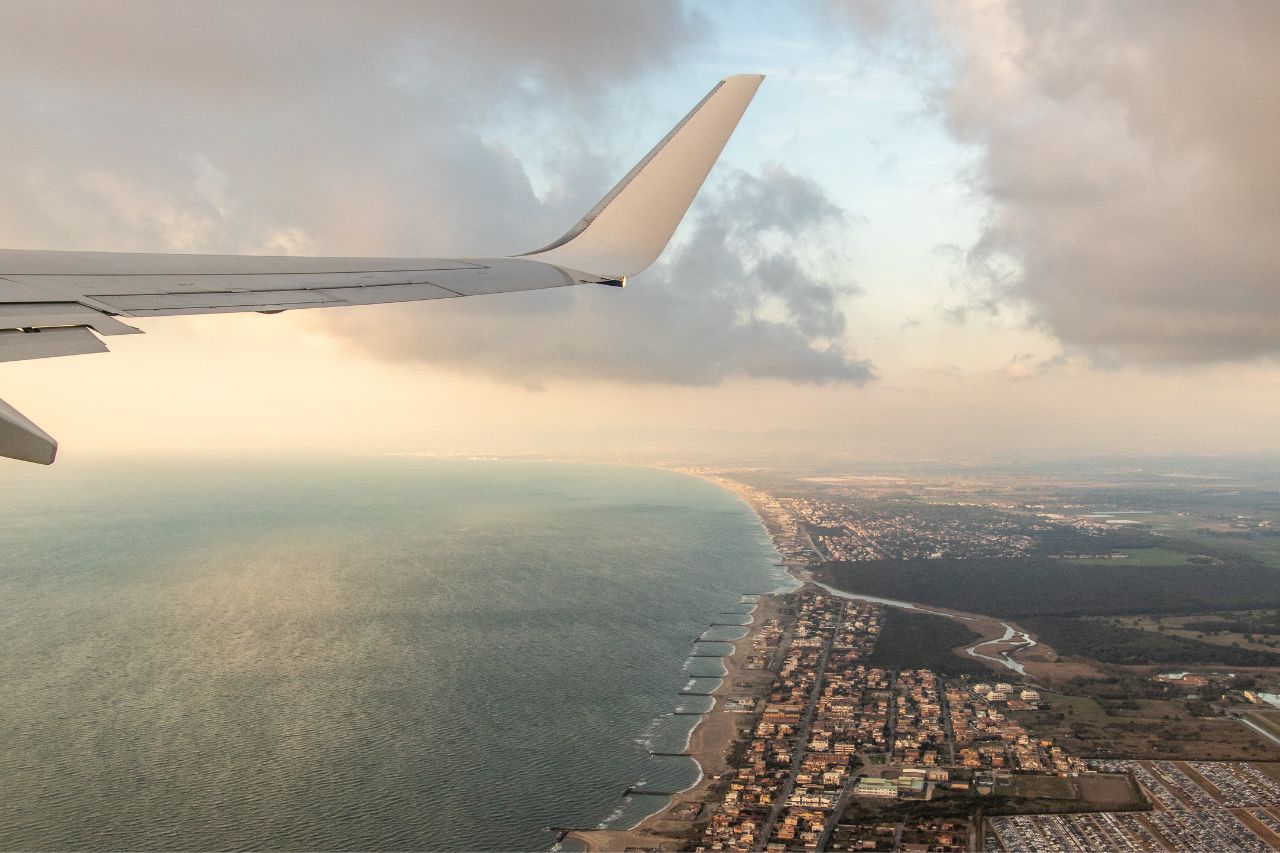
The main airports in Tuscany include the Amerigo Vespucci Airport in Florence and the Gallileo Galilei Airport in Pisa. They sit 49 miles apart, but the Pisa airport is larger with two terminals, which is why you can get cheaper flights there. Florence only has one terminal and 10 gates, and they can’t build more terminals because of the proximity of the mountain. The proximity to the coast in Pisa, however, still makes Florence the more convenient airport. The budget airline Ryanair is one of the airlines that serve Pisa.
For anyone flying in from Europe, Pisa handles most European scheduled flights, so it may make more sense to fly into Pisa than Rome.
International and Domestic Airports in and Near Tuscany
Now, if you want to know how to get to Tuscany from an international level, Pisa and Florence offer the only two international airports in Tuscany. Other nearby airports would include Bologna (73 miles away) and Perugia (72 miles away).
Italy is well connected by trains , but in some cases, you can save time with a domestic flight. For those seeking cheap domestic flights into Tuscany, you have several carriers available, but none of them will give you a direct flight to Florence or Pisa.
You can also fly to the Tuscan island of Elba via the airline Silver Air, which was once the island where Napoleon Buonaparte had a brief 10-month exile from France. You would fly into the Marina Di Campo Airport, Elba. From there, you could take a ferry into mainland Tuscany.
This is also a great choice if you’d like to see the Tuscan island, but don’t want to take the ferry. However, this airport only has connections with Pisa and Florence, so you couldn’t fly in from outside of Tuscany. Mostly private airplanes and helicopters use it.
Airline Options and Average Flight Times from Various Locations
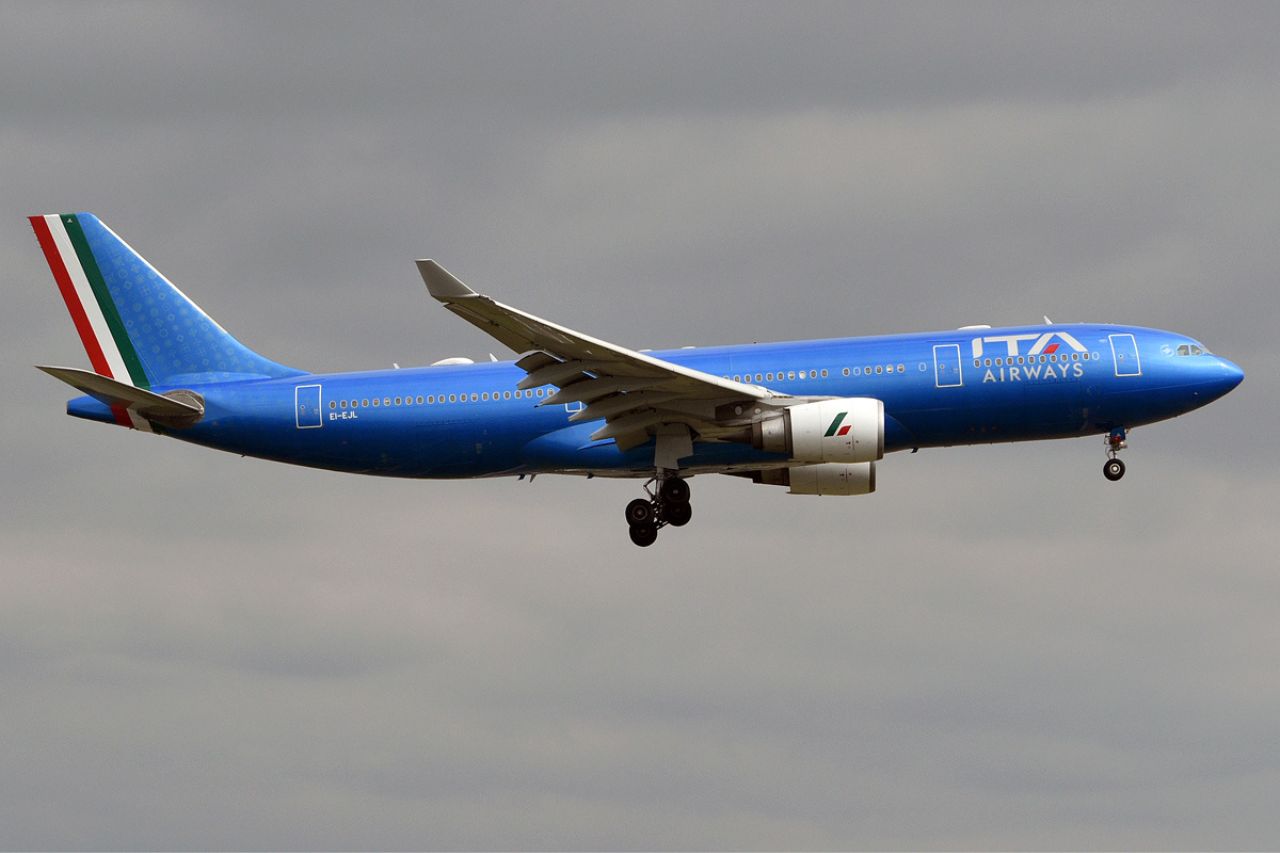
If you want to know how to get to Tuscany from the United States, I will show you a few different options with direct flights and the average flight time of each one. I’ll use Rome because it’s the most common flight path next to Milan.
- Atlanta: The nonstop flight from Atlanta to Rome takes 9 hours and 50 minutes. You can take seven direct flights between Atlanta and Rome every week.
- Boston: It requires an average of 8 hours and 10 minutes of flight time to get from Boston to Rome. Delta Airlines and Alitalia both offer flights from Boston to Rome.
- Chicago: The average flight time from Chicago to Rome is 10 hours and 5 minutes, and two different airlines offer the service.
- Los Angeles: Taking a direct flight from Los Angeles to Rome takes 12 hours and 50 minutes.
- Miami: Getting on the plane from Miami to Rome takes 10 hours and 5 minutes.
- Newark, New Jersey: The average flight time from Newark to Rome is 8 hours and 10 minutes.
- New York City: The average flight time from New York City to Rome is 8 hours and 35 minutes.
Arriving in Tuscany by Train
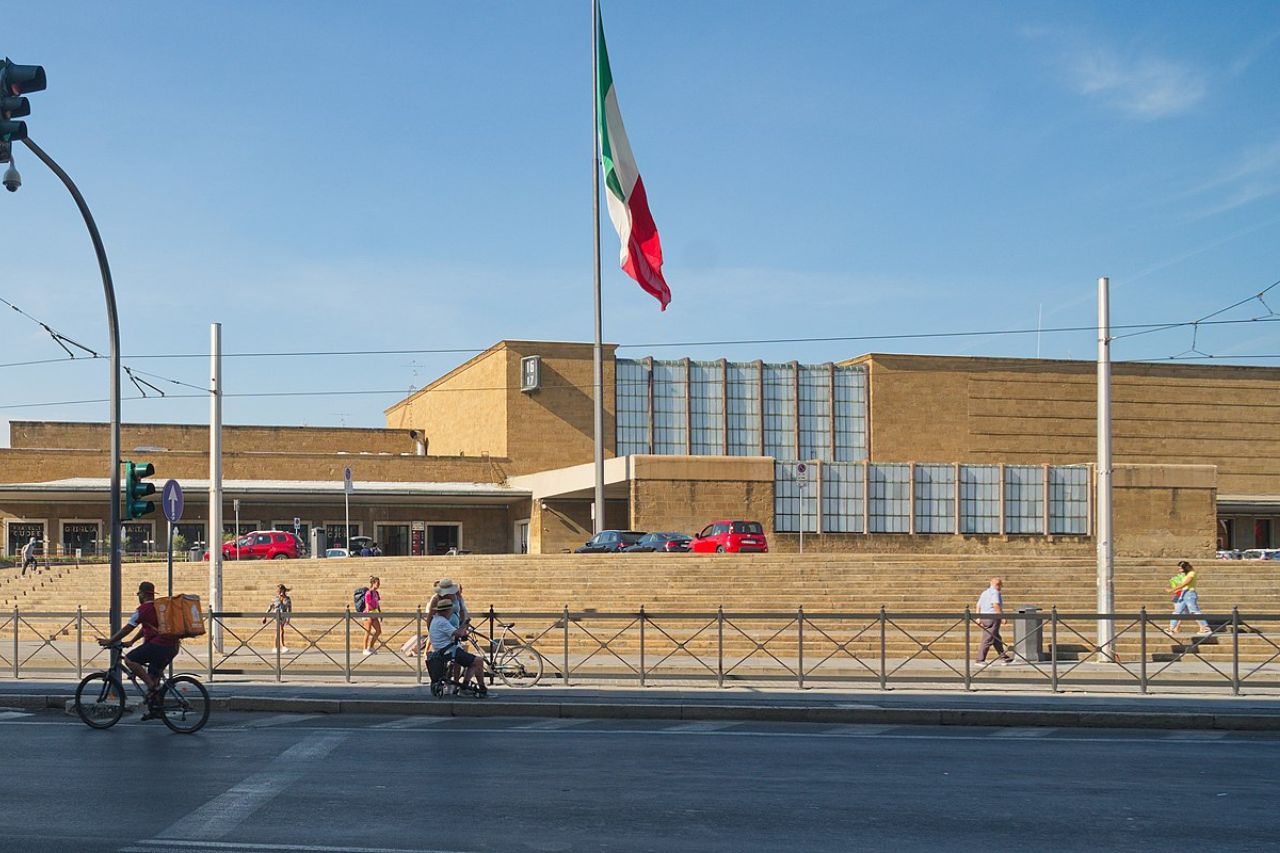
The main train stations in Tuscany include:
- Florence (Firenze Santa Maria Novella)
- Siena (Piazza Carlo Rosselli)
- Pisa (Pisa Centrale)
- Lucca (Lucca Railway Station)
You may struggle to reach the smaller villages due to the lack of train, but you could opt for the bus .
This highlights how to get to Tuscany via the train station. Most of Italy is well connected by trains. If you want the main terminal of the region, choose Firenze Santa Maria Novella since it sits along the route between Rome and Milan. You can also take high-speed trains from Naples, Bologna, Rome, and Milan to this station.
Taking a regionale train (slower but serving the region) will get you to all parts of Tuscany. Pisa is another one of the important railway stations. It has served an important role in the region since 1871, and it takes the train coming from Florence and the coastal train route. The coastal railway lines in Tuscany will connect you to some of the most beautiful beach resorts in Italy including seaside resorts in Carrara, Massa, Viareggio, and Pietrasanta.
Reaching Tuscany by Car
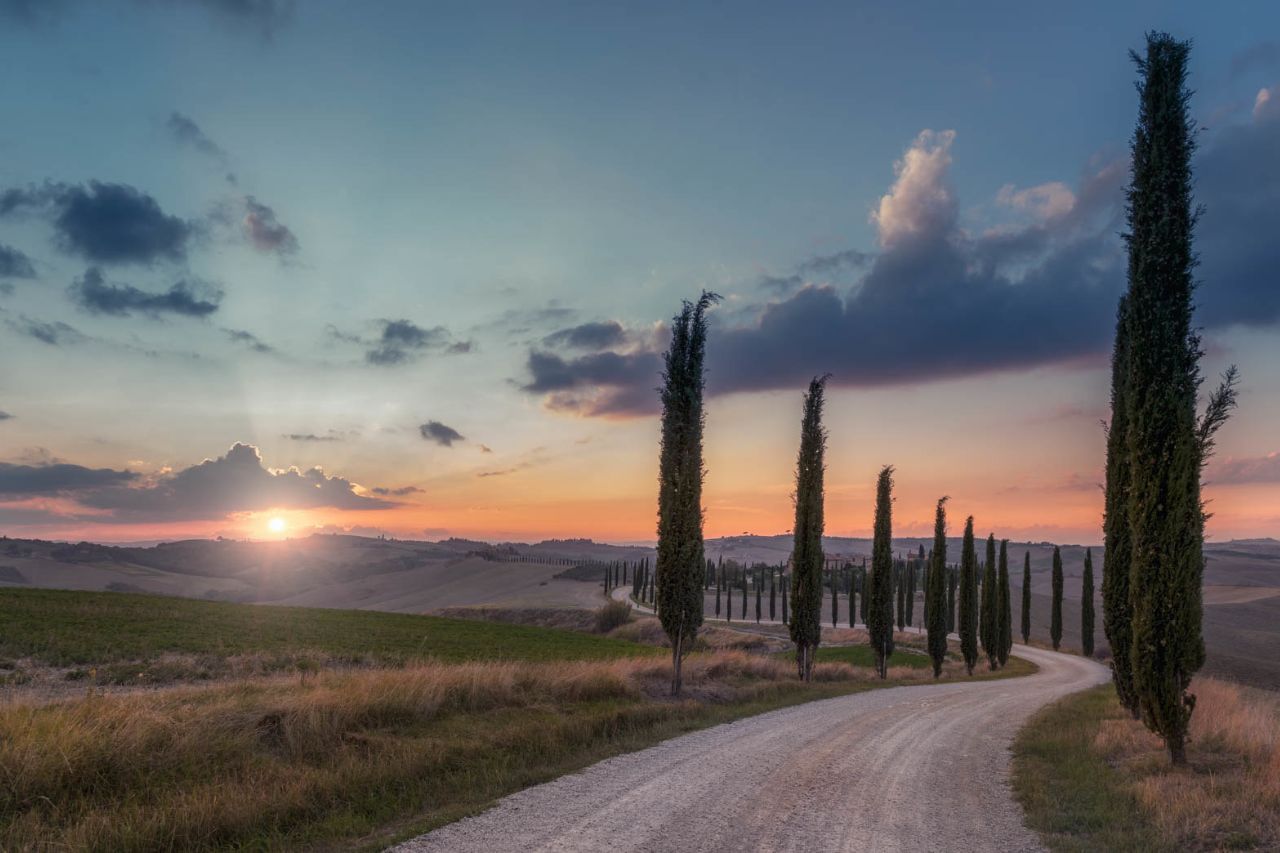
Keep in mind that in some locations of Italy, a car can be difficult because you struggle to find parking. A rental car, however, is a valid way of getting to Tuscany, and generally speaking, the roads throughout Tuscany are good. You can also reach the smaller towns more easily with a car.
Tuscany offers two main driving routes that you would go through. You can either drive through Via Cassia or Via Chiantigiana. If you want to know how to get to Tuscany in style, Via Chiantigiana is known for its winding road, extensive landscape views , and vineyards . This is one of the most beautiful routes in the whole country.
Via Cassia connects Florence and Siena to Rome through the Val d’Orcia . This road offers you some of the most beautiful landscapes in Tuscany with its wheat fields, isolated cypress trees, and deserted landscapes.
Ferry Services to Tuscany
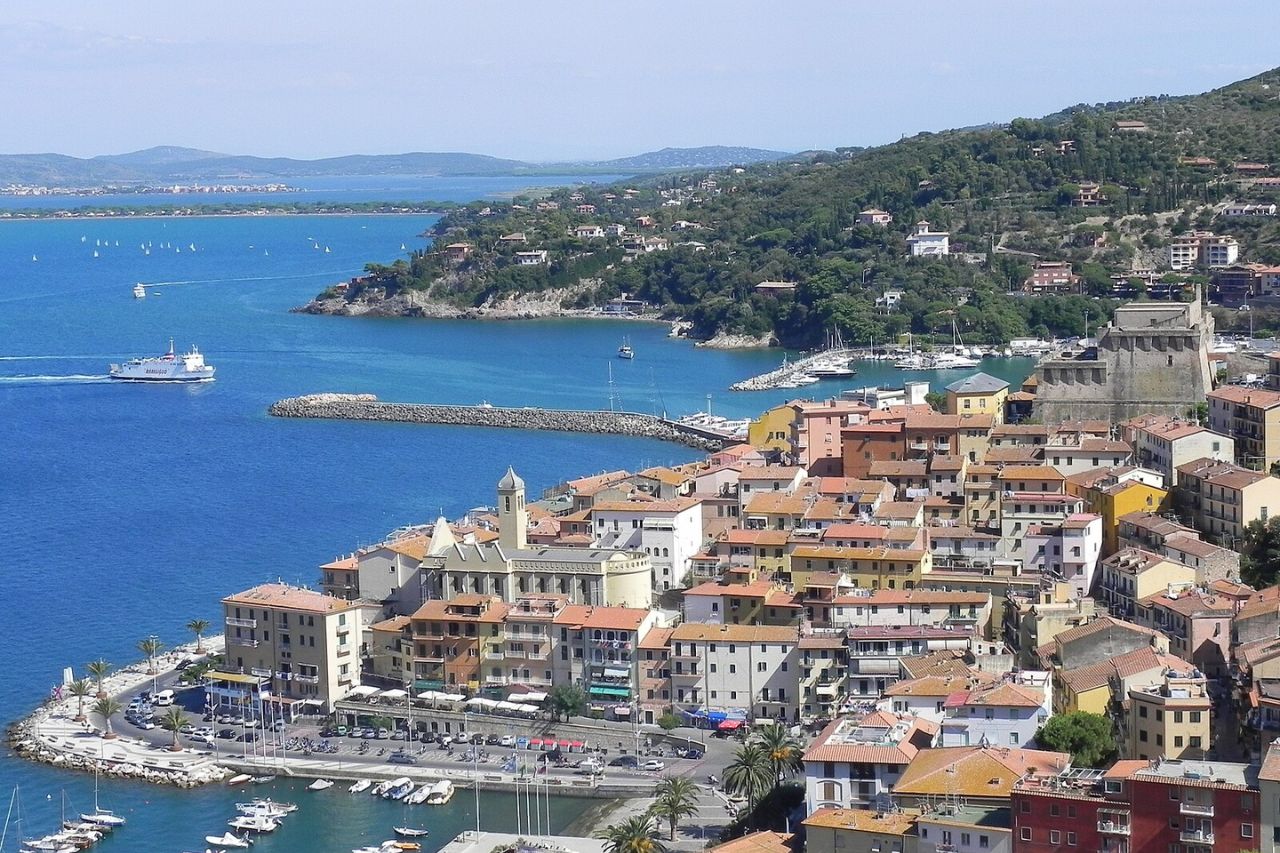
Ideally, you would use the ferry services after you had already flown in from the US for traveling to Tuscany. The main ferry ports in Tuscany include:
- Porto Santo Stefano
Livorno is the largest port, and you can sail from a variety of destinations here including Olbia and Golfo Aranci. You can also sail from Palermo, the capital of Sicily to Livorno. You can also sail from Portoferraio to Piombino.
As a side note, Portoferraio is located on the island of Elba, so you could fly to Elba and take a ferry across into the main part of Tuscany.
Porto Santo Stefano can take you to two other islands in the same archipelago. You can either visit Giglio or Giannutri. Giglio is the larger of the two islands.
Getting around Tuscany
For exploring the Val d’Orcia, I would recommend a car because of how it gives you the freedom to explore the region at your will. You could also reach most major cities in Tuscany through the train system. For the smaller towns , I would recommend you travel via bus since it’s a cheap way of getting around. If you’d like to create a more intimate experience with a great deal of background about the region, I would recommend that you book a day tour since it will let you explore specific areas of Tuscany for the day. Hopefully, this shows you how to get to Tuscany.
RELATED ARTICLES MORE FROM AUTHOR
What is rome famous for – 28 things that make rome unique, popular articles, towns in tuscany – 15 jewels of italy’s rich culture, bolgheri – exploring the charm of tuscany’s wine country, val d’orcia – valley of castles, hot springs, and vineyards, popular posts, pitigliano – guide to southern tuscany’s best kept secret, sorano – guide to the ancient hill town in tuscany, giglio island, italy – 11 things to do and where to..., popular category.
- Campania 24

Top 10 must-sees for a first-timer in Tuscany
- email Email
- print Print
- content_copy Copy link
Find out here many itinerary tips and some useful advice
When travelling to a new place, make sure you prepare a list of towns and attractions you absolutely have to see to make the most of your trip. If you're planning a trip to Tuscany for the first time, this article is for you!
Remember that you must take transportation into account (unless you have your own car) and also consider that opening hours of museums, shops, restaurants and other places may have vary or that you could run into unexpected closures (in occasion of local festivities, for example).
A general go-to tip is that you should check opening times of any attractions you want to see. Book in advance if a reservation is advised. At the same time, though, don’t over-schedule! It’s important to take travel as it comes, leaving yourself a lot of free time to just walk around. You will be on vacation, right?
If you are drowning in a deluge of potential destinations, these are 10 major must-sees in Tuscany.
- 5. San Gimignano
- 6. Monteriggioni
- 7. Val d'Orcia
- 8. Volterra
Magical, historical, charming… no adjective can adequately describe the Cradle of Renaissance.
We could never leave Florence off the “top 10” list. Piazza della Signoria, the Cathedral, Ponte Vecchio… everything here is worth a visit.
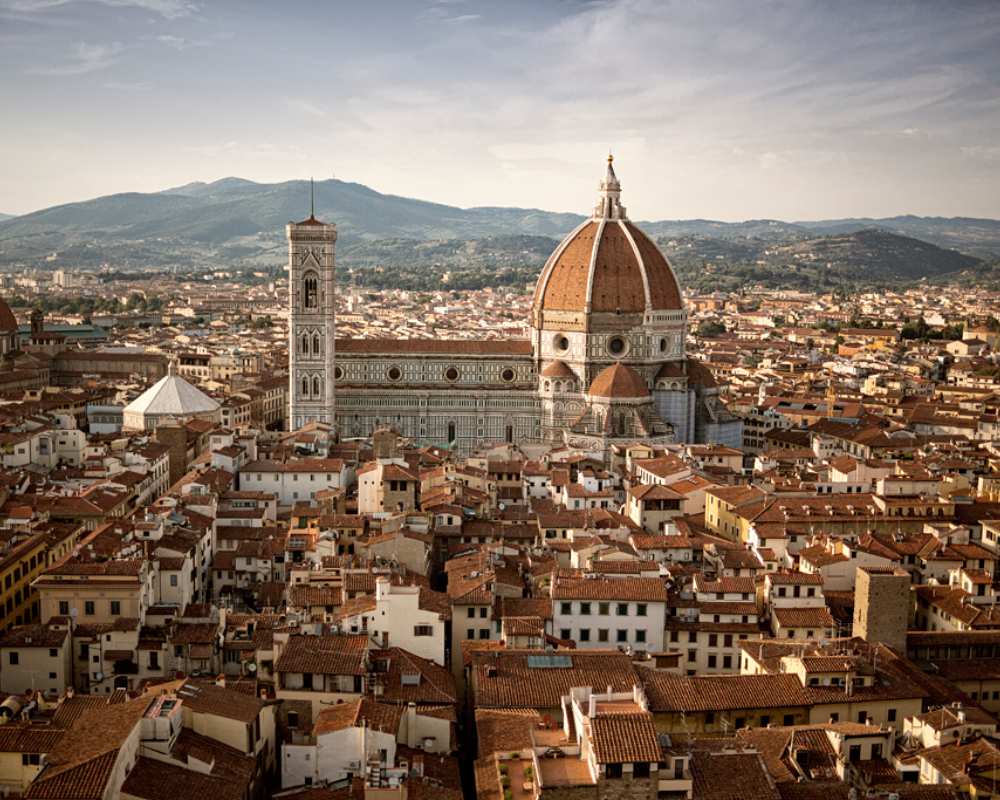
In addition to Florence, Pisa is at the top of the list, not only thanks to the famous Leaning tower and the Piazza dei Miracoli (Field of Miracles), but also because of the many hidden treasures that deserve a visit.
When in town, don't make Piazza dei Miracoli your only stop: continue along, crossing Piazza dei Cavalieri, Borgo Stretto and Borgo Largo, Piazza delle Vettovaglie, eventually reaching the Lungarno. Here you can find noteworthy spots such as the San Matteo Museum, Palazzo Blu and the beautiful “Chiesa della Spina” church. Alternatively, consider following a Galileo itinerary .
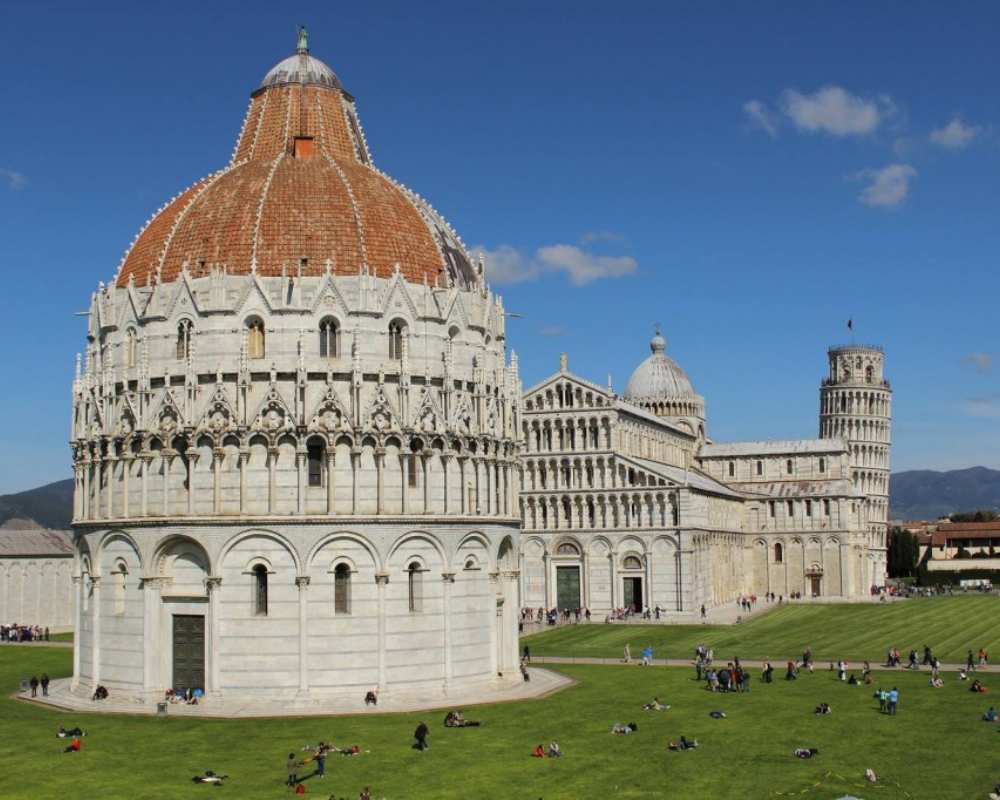
The iconic vineyards and olive trees associated with Tuscany are spread throughout the Chianti area , situated just a few kilometres south of Florence . You’ll find a series of country roads perfect for a car or bike trip, and this whole area is considered a food and wine paradise .
There are many different itineraries to choose from. One of these is the Chianti Classico route , which touches the towns of Greve in Chianti, Gaiole and Castellina. Another itinerary focuses on the Pesa Valley, including Tavarnelle Val di Pesa, San Casciano Val di Pesa, San Donato in Poggio, Badia a Passignano and other hidden gems in this undeniably beautiful area.
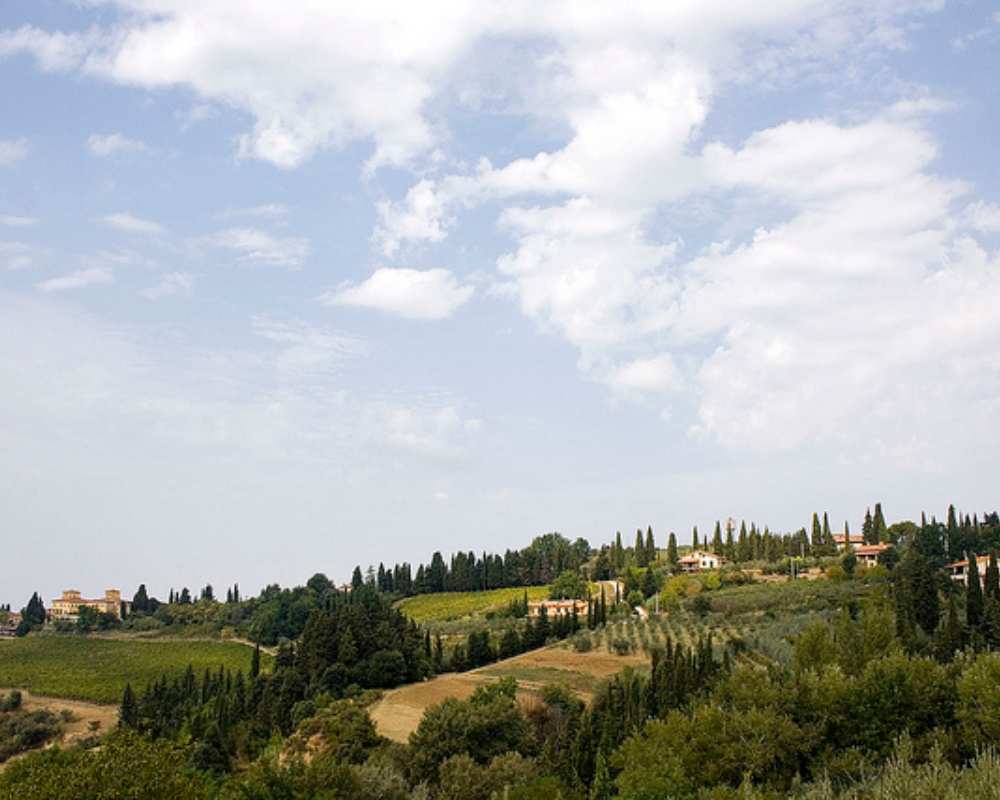
Coming to Tuscany and haven’t scheduled a day in Siena ? Don’t make this mistake! Siena has a unique charm and an ancient history: try to dedicate a whole day to this city, walking along its cobblestone streets in the shadow of its brick buildings.
Siena is known worldwide for the Palio , held every year on July 2nd and August 16th. The heart of the city is Piazza del Campo , with its unmistakable shell-shape. From here, you can admire the 88 meter Torre del Mangia (and then even climb it!). Another must-see is the Cathedral, boasting a black and white façade and a spectacular interior, with its magnificent marble mosaic floor and spectacular vault.
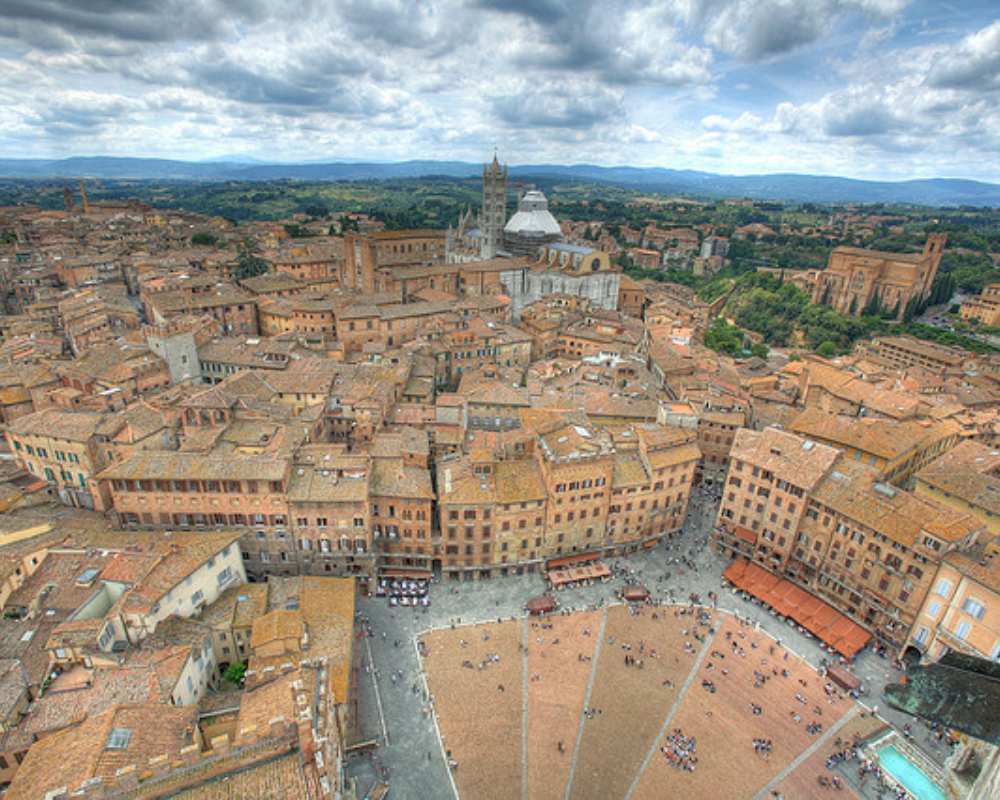
San Gimignano
Known as the medieval Manhattan, San Gimignano is one of the most beautiful hill towns of Tuscany. Characterized by stone towers and narrow streets , it is surrounded by an expansive countryside filled with vineyards that produce the famous Vernaccia wine .
The main square is Piazza del Duomo (home to the Cathedral) where you can also take in the sights of the Palazzo del Podestà, Palazzo del Popolo, the Loggia and various medieval towers. For a postcard-perfect view of the Tuscan landscape, climb the Torre Grossa , a tower housing masterworks by Benozzo Gozzoli, Filippino Lippi, Pinturicchio, and Lippo Memmi.
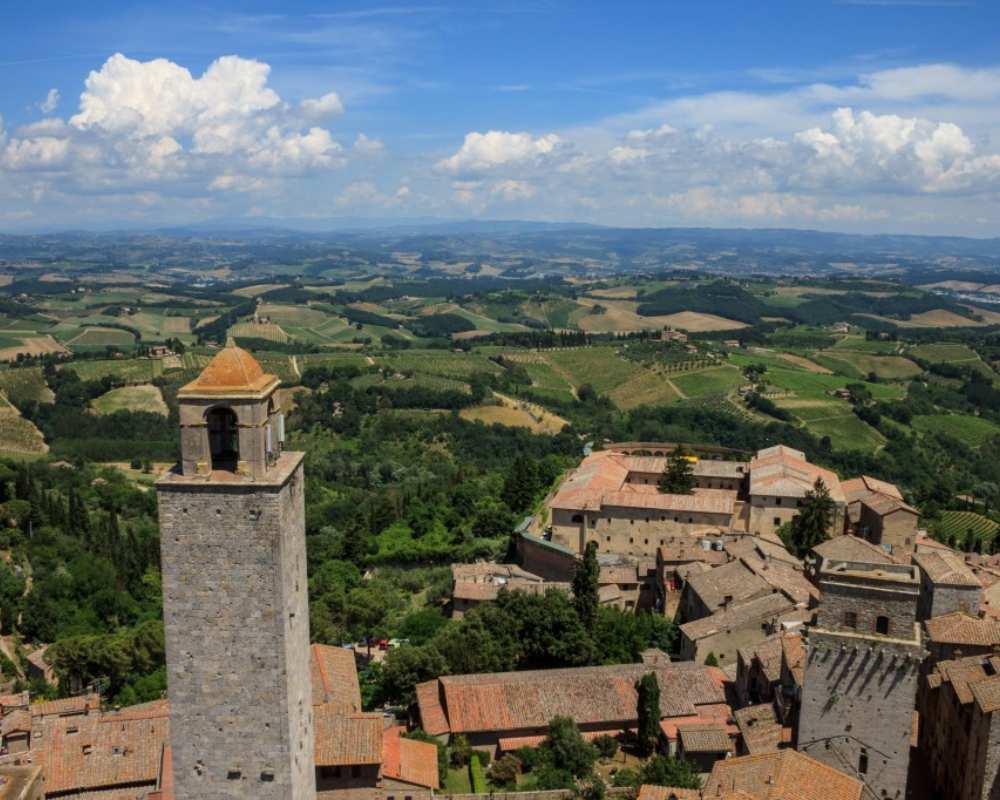
Monteriggioni
In the countryside of Siena there is another Tuscan hill town that definitely deserves a mention in this article: Monteriggioni.
Mentioned in the Inferno of Dante Alighieri’s Divine Comedy, the hamlet is home to perfectly preserved ten-meter-high fortified walls , along with fourteen towers that stand out from afar. When you enter the medieval doors, you are already in the heart of the village.
Nowadays, Monteriggioni is beloved by pilgrims from all over the world (it is one of the top halting points along the Tuscan section of the Via Francigena ) and is also globally known for its medieval festival, celebrated every year in July.
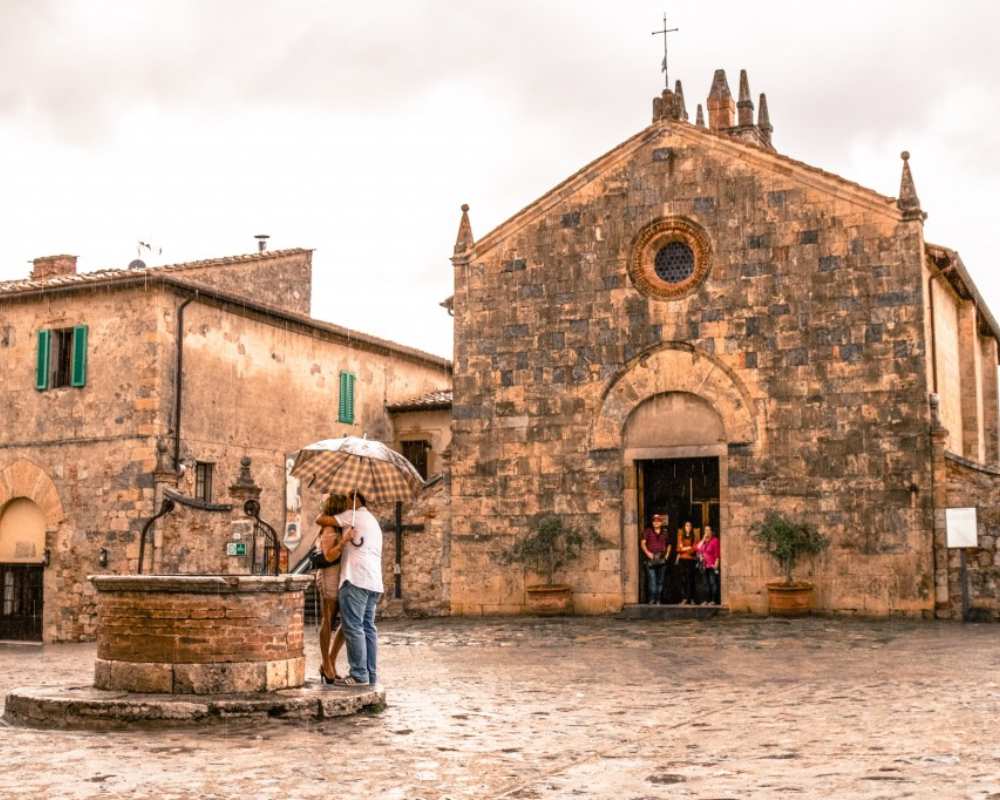
Val d'Orcia
When you think about Tuscany you probably visualize green fields, vineyards and rolling hills . This is the idealized image of Tuscany, but the good news is that it genuinely exists, and you’ll find it in the Val d’Orcia !
This area, extending from the hills south of Siena to Monte Amiata , boasts very famous towns such as Pienza, Montalcino, Monticchiello, Bagno Vignoni, San Quirico d’Orcia… you’ve probably heard of them!
The whole area is an UNESCO World Heritage Site and each small village has its own peculiarities. Hot springs fans will find their heaven in Bagno Vignoni, Bagni San Filippo and Vivo d’Orcia. Finally, wine lovers will be happy everywhere they go around Val d'Orcia!
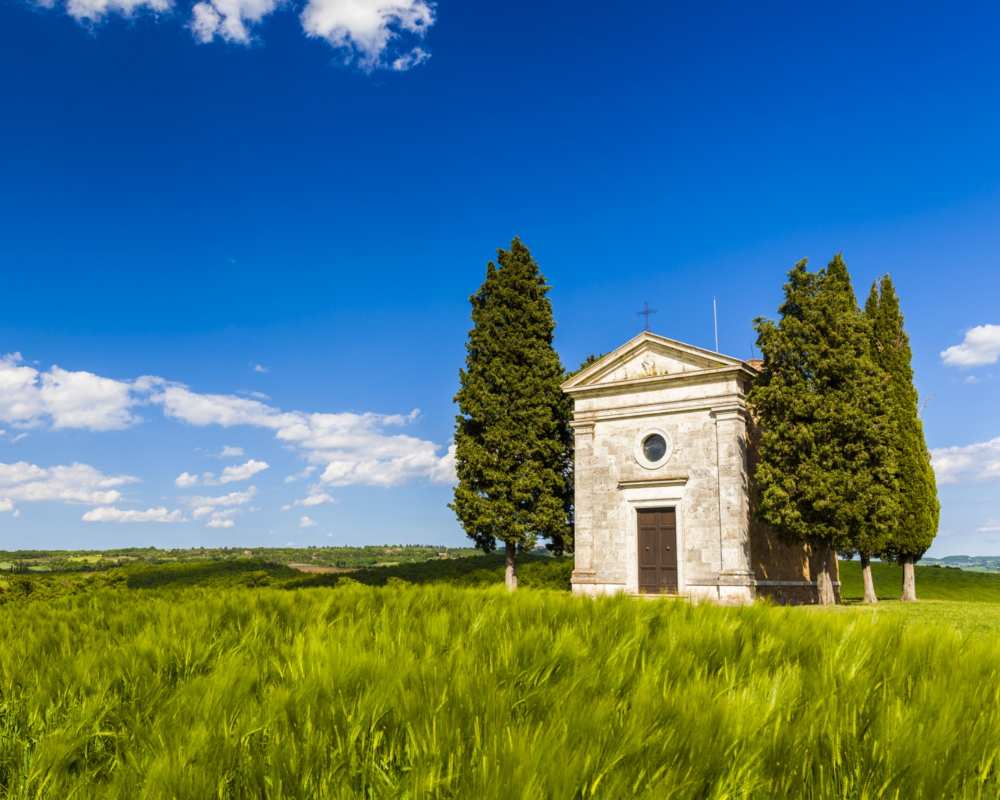
Volterra is one of the most beautiful hill towns of Tuscany. It’s a walled town with a well-preserved past, as evidenced by its medieval and Renaissance buildings , its Roman theatre and its Etruscan sites .
Must-see attractions include the Piazza dei Priori, home to the magnificent Palazzo dei Priori, the Palazzo Pretorio with its Tower of the Little Pig, the Romanesque Cathedral and its Baptistery, the Roman Amphitheatre and much more.
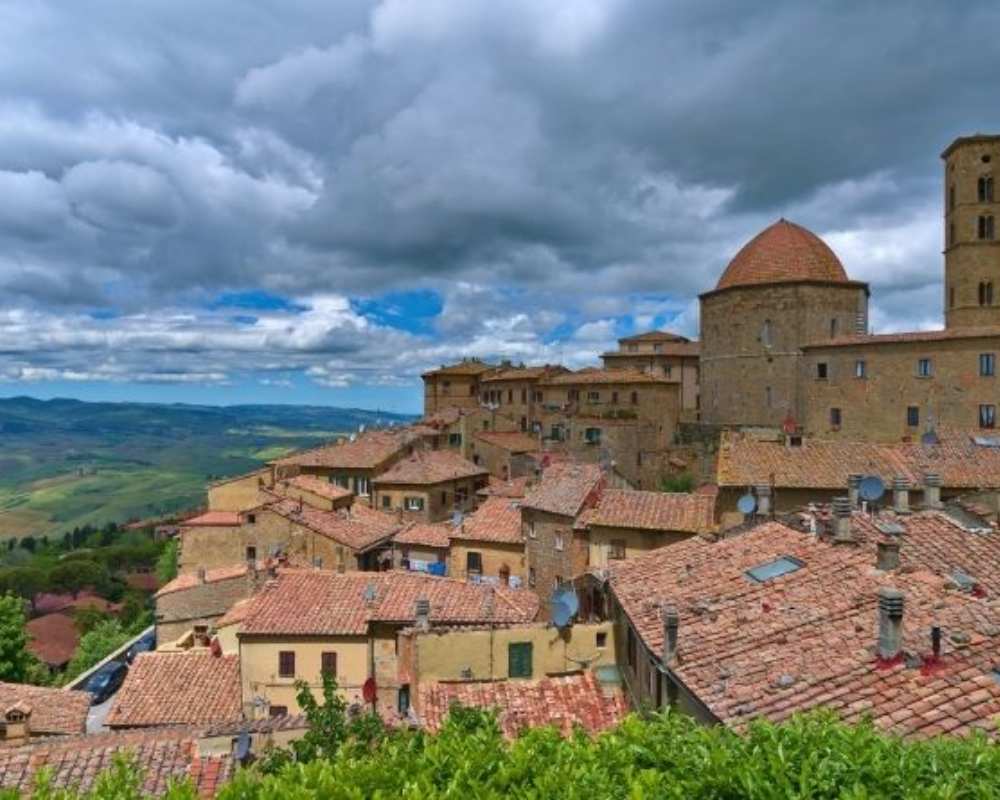
Nicknamed the “city of 100 churches” , Lucca is famous for its perfectly preserved and walkable 16th century walls. This 4 kilometer walkway overlooking the town is a great starting point for a tour of the town.
Don’t miss Piazza Anfiteatro , with its elliptical shape, the Guinigi tower and its trees on top , the forum located in the S. Michele square, and the beautiful San Martino Cathedral. You can access the city centre from 6 different “porte”, or gates.
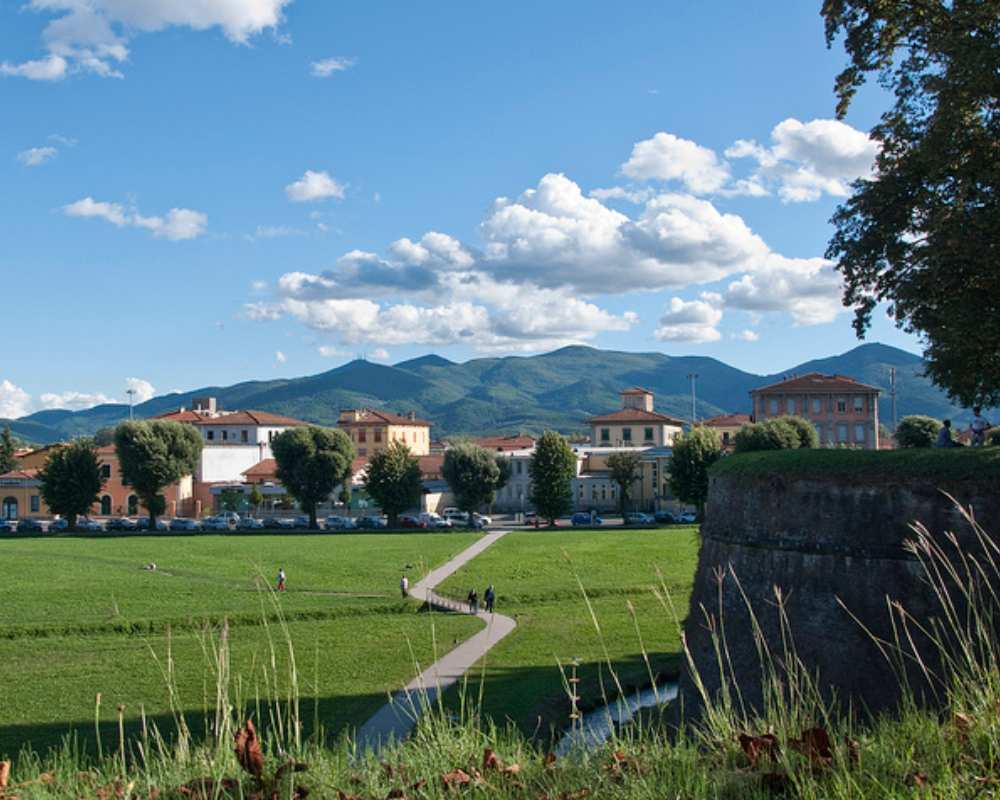
Arezzo has ancient origins and a well-preserved city centre with plenty of monuments, churches and museums, offering visitors a chance to travel back in time.
Piazza Grande is a good starting point for a city tour, boasting the Loggiato Vasariano and Palazzo delle Logge (designed by Vasari). Another important stop on your itinerary is the Basilica of San Francesco and its astonishing Cappella Bacci. Don’t miss the Museum of Medieval and Modern Art and the Romanesque church of Santa Maria della Pieve.
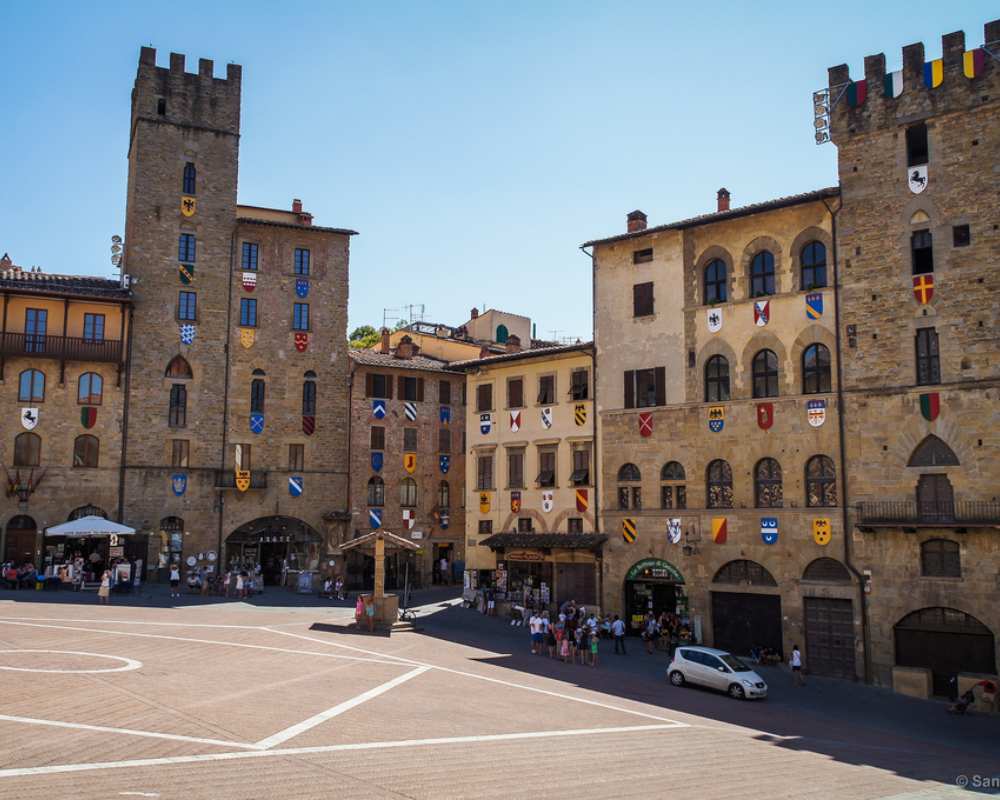
Plan your trip
Accommodation, where to eat, packages and stays, experiences, guides and maps, start your discovery.

Itineraries


Ultimate Travel Guide to Tuscany
Known to the locals as Toscana , to the rest of the world, Tuscany epitomises the romantic, picture-perfect image of rustic Italy. Spanning much of central Italy from the Apennines to the Tyrrhenian Sea, the landscape changes from pastoral to the rocky hills of Chianti, the mountainous region of Montagnola and the flat landscapes of Pisa.
With centuries of impactful history housed in this central region, Tuscany is world-renowned as an artistic powerhouse and the ultimate introduction to the fruits of Italy’s land. Tuscany’s effervescent charm oozes from its medieval hill towns, wine-soaked villages and swathes of rolling olive groves. You’ll be hard-pushed to find a more romantic part of Italy than Tuscany.

Art lovers rejoice. Tuscany has charmed its inhabitants since the Etruscans first arrived and indeed, the Romans left an array of exquisite monumental sculptures in their wake, but it was during the medieval and Renaissance periods that Tuscany truly shone. From the murals on Florence’s backstreets to the city’s galleries which burst which incredible paintings and sculptures, Tuscany will impress any art buff.
Within each region of Italy, you’ll find mouthwatering cuisine you’ll savour your entire trip and Tuscany is no different. Whilst much of its delicious produce can be found in other regions, it’s the concentration in which Tuscany’s fine wines, artisan olive oils and gourmet home-cooked dishes are delivered that fuels its status as one of Italy’s food capitals.
Don’t Miss Our Exclusive Offers! Subscribe Today!
For the ultimate travel inspiration, local insight straight from our expert Local Designers and exclusive offers you won’t find anywhere else from Designer Journeys, sign up today! Don’t miss out.
Hear the word ‘Tuscany’ and you’re guaranteed to imagine gentle undulating green fields blanketed by olive groves and rows of vines, cypress tree-lined country roads and stone farmhouses scattered across the landscape. This iconic image that many people hold of Tuscany is not wrong, but many forget the region’s mountain ranges and forests of the north as well as the 25-kilometre stretch of Tuscan coastline which is speckled with seaside villages and glamorous resorts.
Largely protected, Tuscany is a region which will maintain its charming, golden appearance even as it grows in popularity. It’s a place where you’ll always find a quaint countryside farmhouse with owners that usher you inside to fill your belly with authentic deliciousness as you gaze out over the spectacular landscape. It is a land where unspoiled nature and authentic traditions triumph.

Post Contents
The Best Time to Visit Tuscany
Live the dolce vita & explore tuscany in an ape tuk-tuk, truffle hunting in the san miniato hills, explore the beautiful art-filled city of florence, discover the iconic monuments of pisa and the walled city of lucca, lay eyes on the unesco world heritage site, val d’orcia, explore siena and san gimignano – two unmissable cities in tuscany, wine, wine and more wine in chianti, tuscany’s most famous wine region, bathe in tuscany’s natural hot springs, how to get around tuscany, where to stay in tuscany, must-try foods and places to eat and drink in tuscany.
- The Cost of a Trip to Tuscany
National White Truffle Festival in San Miniato
The palio race in siena, ready to design your perfect tuscany trip.
Like many of Italy’s regions, Tuscany’s peak season is during its summer months from May to September. July and August bring soaring temperatures and crowds making these months to busiest, most expensive and most uncomfortable time to take a Tuscany trip. Due to its mix of terrain from the cooler mountains to the intense heat of its coastline and valleys, Tuscany’s weather varies.
August is when the locals take their holidays so as the cities empty, regions such as Tuscany fill with Italian travellers. Many of the hotels in this region consider this time the low season.

In the winter, from November to March, temperatures are cool, main sights close earlier and fewer activities are occurring in the region. However, November is also prime truffle season in Tuscany so to make the most of this delicacy, this is the month to take a trip to Tuscany. If you choose to travel during this season, it is best to visit Tuscany with a local as then you can ensure activities will go ahead.
The best time to visit Tuscany is the shoulder season, which falls either side of the region’s busiest months. Planning a trip to Tuscany during April and May or October and November will mean fewer crowds, comfortable temperatures and lots of activities. During these months, you may need a light jacket in the evenings but the days will bring blue skies and sunshine.

Unique Experiences and the Best Places to Visit in Tuscany
From laying eyes on its beautiful monuments and exploring its never-ending vineyards to savouring the flavour of a bistecca alla fiorentina as you sip a local Chianti wine, Tuscany offers endless unique experiences and opportunities to learn more about this beautiful region.
Tuscan towns and medieval villages are known for their quaint winding streets and hilltop positions, however, this can make getting around them a little difficult. The Ape Tuk-Tuk was developed by local Tuscans living in small villages as a way to navigate the streets and deliver goods to and from the farms. Used for over sixty years, these three-wheeled buggies have become an iconic image of Tuscany, and on a trip like this 10-Day Luxury & Charm of Central Italy adventure, you can explore the rolling Tuscan countryside and several wine tastings as part of the experience.

If there’s one food that Tuscany is world-famous for, it’s truffles. The star of the Tuscan food scene, every species of truffle found in Tuscany ripens at a different time of year. The white truffle in Autumn and the black and brumal truffle in winter are the two of the most popular. Tuscany boasts eight regions from which to truffle hunt and the hills of San Miniato which straddle Florence and Pisa is one of the most prominent producers of truffles in Tuscany.
When on a tour of Tuscany, like this 10-Day Rome, Ponza, Tuscany & Florence trip, you can head out on a truffle hunting experience in the San Miniato Hills. Together with an expert truffle-gatherer and his inseparable truffled-trained dog, you will discover these ‘treasures’ hidden in the woods. The day will end with a wonderful-tasting lunch of truffles in the truffle factory.
Take the Hassle Out of Planning Your Italy Trip!
Planning your trip can be a little overwhelming, especially when you want to make sure it’s perfect. Our trusted Local Designers use their travel planning expertise, local insight and destination knowledge to design extraordinary travel experiences, every time. Browse our Italy tours and connect with one of our Local Designers to get started!
Hailed as the birthplace of Renaissance art, Florence is a city where you can feast on Tuscan cuisine and marvel at the astonishing works of art that fill both the city’s streets and museums. Housing some of the world’s greatest artistic treasures, whilst on a Tuscany trip , you shouldn’t miss the Florence Cathedral, the Gallerie dell’Accademia or the Uffizi Gallery which is home to works by Botticelli, Michelangelo and Leonardo da Vinci. After laying eyes on Giotto’s Bell Tower, an exquisite example of Florentine Gothic Architecture, you should spend an afternoon admiring the 700-year-old frescoes in the Santa Maria del Carmine church and the beauty of the city from Piazzale Michelangelo.

Said to be two of the richest cities in the world for their architecture and history, both Pisa and Lucca are unmissable destinations for those that want an in-depth look into Tuscany and its artistic background.
On this 9-Day Culture between Tuscany and Naples trip, you’ll explore these incredible Tuscan cities with a local guide. Instead of just laying eyes on the famous Leaning Tower and the majestic Pisa Cathedral, you’ll learn about their rich history, construction and how they came to be such iconic images of Tuscany. In Lucca, you’ll explore its historic centre filled with cobblestone streets, centuries-old churches and open squares all encircled by well-preserved Renaissance walls.
Of course, in Tuscany, a day trip is not a day trip without the taste of a delicious Tuscan speciality. In Lucca, you’ll end the day with a Buccellato tasting, a typical Lucchese cake. As the locals would say: “Those who come to Lucca without eating the Buccellato is like they have never been there!”

The quintessential image of Tuscany, Val d’Orcia is a spectacular landscape dotted with ancient fortresses, quaint Tuscan villages and an abundance of vineyards that produce Brunello and other fine Tuscan wines. The cypress trees steal the show in Val d’Orcia; lined up neatly along countryside roads swooping up and down across the landscape with the hills and ravines.

Travelling through the countryside on this 6-Day Culture and Wine in Tuscany trip, you’ll pass through characterful villages such as Piena and the beautiful medieval hilltop city of Montalcino and finish the day at a local wine cellar where you’ll taste the world-renowned Brunello of Montalcino and a selection of typical local products.
Distinguished by its stunning medieval brick buildings, Siena is a jewel of central Italy. At Tuscany’s heart, Siena bustles with locals going about their day and its infectiously charming atmosphere has made it one of Italy’s most-loved destinations. Piazza del Campo, the spectacular fan-shaped square flanked by the Palazzo Pubblico, the Gothic town hall, and Torre del Mangia, is not to be missed.

Not far from Siena, you’ll find the medieval hill town of San Gimignano encircled by 13th-century walls. Owing its beautifully preserved historical centre to a 13th-century law which banned the destruction of medieval buildings, visiting San Gimignano is like stepping back in time. You can explore both Siena and the city of towers, San Gimignano, with an experienced local guide on a trip like this 10-Day Rome, Ponza, Tuscany & Florence adventure.
Allow yourself to be fully immersed in the enchanting landscape of the Tuscan hills. On this 9-Day Gastronomic Rome to Venice Adventure , you’ll pass through the Chianti region in Tuscany and embark on an intimate excursion to three different wineries with an expert sommelier. Thanks to the beautiful climate and rich soil, the Chianti region produces some of the best wines in the world, known as ‘Super Tuscans’. Savouring the taste of these rich Tuscan wines, you’ll learn to distinguish the scents of flavours of each one whilst in the most fascinating settings – from medieval castles and noble villas to a boutique winery.
If you want to do things a little differently, on this 10-Day Luxury & Charm of Central Italy trip, you can kick off your tour of the Chianti wine region with a hot air balloon ride over the vineyards of Tuscany, endless olive groves and ancient townships; there’s nothing quite like it!

Boasting the highest number of thermal centres in the whole of Italy, taking a relaxing soak in a natural hot spring is a must-do in Tuscany. Many of them are open to the elements so that you can relax as hot, steamy water flows over the rocks and your body, surrounded by some of the most beautiful, breathtaking natural landscapes in the world. Some of these natural hot springs such as Bagno Vignoni and Bagni di San Filippo are free and open to dive into at any time of the year!
Tuscany is a region so harmonious with its land that it demands to be explored on foot and by bicycle. But when that’s not possible, railways and country roads link this region’s greatest finds with ease.
A reasonably-sized region, much of Tuscany can be crossed in just a few hours. Trains and buses link the major towns and cities in Tuscany, making these modes of transport the easiest way to get around. Trains are also one of the most affordable ways to travel around Italy; many regions have dedicated passes to explore the top cities and towns in a number of days.
However, if you plan to spend your trip exploring Tuscany’s abundance of remote villages and off-the-beaten-track towns, travelling by car is the best way. Many of the train routes don’t reach the smaller areas, which means you’ll have to rely on bus travel to reach towns such as San Gimignano. As buses are not the most reliable or most convenient, travelling by car wins in these situations.

Planning your Tuscany trip with a local guide means you can choose between travelling in Italy by private car with a driver or self-driving. If you decide to drive yourself, your rental vehicle will be pre-arranged and waiting for you when you arrive in Tuscany.
Tuscany has two international airports, the Galileo Galilei International Airport in Pisa and Amerigo Vespucci Airport in Florence. Both are accessible from major European cities, but Pisa is the larger airport.
Due to its popularity as one of the top regions in Italy, Tuscany offers a wide variety of accommodations from hotels to B&Bs and apartments for those that like to self-cater. Staying in a hotel is the most popular choice of accommodation for Florence, Siena, Pisa and other larger cities in Tuscany.
In the countryside, farmhouses converted into guesthouses are popular places to stay for those that want to combine the charm of the Tuscan country life with the warm hospitality of a local host. Choosing to base yourself in one of the countryside towns or villages over one of Tuscany’s larger cities means having a car as transport would be very useful as in this 6-Day Culture and Wine in Tuscany trip.
One of the best places to base yourself in Tuscany is in the central area between Florence and Siena. Here, you won’t be far from the Chianti wine region and the San Miniato Hills, and you’ll be less than an hours journey from the many sights in Tuscany: Florence, Pisa, Lucca, San Gimignano, Montalcino, Montepulciano, Siena, Volterra, Arezzo, the Crete Senesi and the Val d’Orcia. Many of these areas boast an array of locally-owned villas and farmhouses that enable you to enjoy the peacefulness and beauty of the hills, coast and mountains of Tuscany.
If you’re on a shorter trip like this 9-Day Culture between Tuscany and Naples adventure, you can base yourself in a central city such as Florence and spend your days driving out to the surrounding regions. This way, you’ll be able to experience the artistic beauty of Florence whilst being a short journey from Tuscany’s major sights. If you have a little longer, like on this 12-Day Culture and Wine in Central Italy trip, you can split your stay between a larger city like Siena and a countryside town like Lucca.
Tuscany is the region of a thousand flavours. Truffles and fine Chianti and Brunello wines steal the show, but the enormous pride Tuscans take in the quality of their produce shines through every dish, snack and aperitif. A gourmet destination, many people flock to Tuscany to spend the majority of their trip wining and dining like you would on this 6-Day Culture and Wine in Tuscany trip.
Every bit of produce is local, seasonal and sustainable in Tuscany. Whether you’re enjoying artisan pasta cut by hand in a family-run trattoria, a glass of Brunello di Montalcino in a world-class estate or sinking your teeth into bistecca alla fiorentina (a chargrilled T-bone steak), life is simply delicious in Tuscany.

One thing you must not miss in Tuscany is the taste of truffles. One of the most traditional Tuscan products, the truffle can be enjoyed in a variety of ways each one varying hugely in flavour. A bit like diamonds, finding truffles is an activity cherished among locals in Tuscany. You can join in finding the crème de la crème of truffles in the San Miniato Hills with an expert-gatherer and his truffle-hunting dog on this 10-Day Rome, Ponza, Tuscany & Florence trip.
Producing some of the world’s finest wines is what Tuscany does best. Chianti, Vino Nobile Montepulciano, Brunello di Montalcino and Vernaccia di San Gimignano are four wine varieties that you should taste, savour and enjoy whilst in Tuscany. Of course, like wine, Tuscan olive oil is also world-famous. Each November, olives are hand-picked from the olive groves that scatter the Tuscan hills and are sent to be pressed.

Foodies will want to indulge in Tuscan food delights such as: Panzanella , a cold bread salad with unsalted bread, red onions, tomatoes, basil, olive oil, vinegar and salt; Lardo di Colonnata , pork lard cured in local marble in Colonnata; Castagnaccio , a traditional cake made with chestnut flour common to the Apennine mountainous area of Tuscany; and Pici , a type of spaghetti from the area of Siena.
The Cost of a Trip to Tuscany
So, how much is your Tuscany tour going to cost? If this answer were simple, there wouldn’t be a whole section dedicated to it. The cost of your Tuscany trip comes down to several different variables, including:
- The length of your trip
- The season or month you travel in
- Your accommodation class
- How many places you visit or stay in
- The number of activities or tours you take part in
- Your expenditure on shopping and dining
You’re travelling style can also affect the cost of your Tuscany trip. Do you like to travel alone, as a family, just with your spouse or with friends? Also, do you want to travel by public transport, in a private car with a driver or by bicycle? However you like to travel and whoever you want to travel with, making sure your Tuscany trip is perfect whilst staying within your budget can cause a little bit of a headache. Luckily, with Designer Journey, it doesn’t have to be.

You can choose to design your Tuscany trip with an in-destination Local Designer who has been approved by Designer Journey to offer unique, tailor-made trips through our website. When designing your trip, the Local Designer will take into account your budget, choice of activities, class of accommodation, trip duration and so much more. Using this information, they can create a trip that is perfect for you and every member of your party. Whether you’d like a fully-guided trip with a local there every step of the way or just the occasional guided activity, the choice is yours. With Designer Journey, you can relax in the knowledge that every detail of your Tuscany trip has been taken care of for a price that suits you.
The cost of a tailor-made Tuscany trip starts at roughly $2,700 per person for a 12-day trip. As an example, this 12-Day Culture and Wine in Central Italy includes:
- 3-star hotels
- Thirteen activities and day tours
- Transport by private car and train
- A licensed English-speaking guide
- Airport transfers
This is the perfect example of a budget-friendly Tuscany trip which could be made even cheaper by opting to stay in smaller cities and reducing the number of places you visit by staying longer in one or two of them.
If you’re looking for a luxury Tuscany trip, your Local Designer can upgrade the class of accommodation and include more guided activities. This 10-Day Luxury & Charm of Central Italy trip is the perfect example of a luxury Tuscany trip and includes:
- 5-star hotels
- Twenty-six activities and day tours
- Three dinners and one lunch and breakfast every day
With Designer Journey, you can design your perfect Tuscany trip by browsing our range of fully-customisable Italy trips and tailoring any one of them to your preferences with an expert Local Designer. Or better yet, select what you want out of a trip using the ‘ Design your Own Trip ’ function and let a Local Designer create your ideal trip.
Special Events and Festivals in Tuscany
Like every region in Italy, Tuscany is full of unique experiences, special events and festivals that occur throughout the year.
Known as the ‘City of Truffles’, San Miniato and the hills that surround it are where the best of the white truffle treasures are gathered. Every year in November, thousands of truffle lovers from all over the world fall upon San Miniato for three weekends of all-things-truffles. Sample tastings of these delicious truffles as you peruse the stands which are full of locally-made truffle-based products like truffle oil, sauces, truffle salt and other preserves, as well as lots of other Tuscan food products. If you’re travelling to Tuscany in November, this festival is not to be missed!

Every year, Siena’s fan-shaped square, Piazza del Campo is transformed into the racetrack for the famous Palio run. Taking place on 2nd July and 16th August every year, the city divides into 17 ‘contrades’ which are then represented by a horse and a rider in the race. Each contrade has its own unique emblem and colours; as you walk through the city, you’ll be able to tell which contrade you are in due to the flags and emblems that will decorate the street.
The race itself dates back to the 6th century and is a hugely important part of the local Sienese’s lives. Whilst it is very much a local race, the atmosphere that surrounds the Palio race is infectious. If you have the stand to attend the Palio race whilst in Tuscany, it is something you should not miss.

Take away the stress of planning your Tuscany trip and making sure it meets your budget whilst including everything you’d like it to.
With the help of one of Designer Journey’s in-destination Local Designers, you can tailor your Tuscany trip to suit the needs of everyone in your party with a wide range of locally-inspired and culturally-rich activities that few travellers have the chance to take part in.
Get inspired by our range of Italy trips or design your own trip from scratch by connecting with a Local Designer who can take care of it all.

Marta Ostoja-Kiedrzyńska
Hi! I’m Marta, a Barcelona-based travel writer, photographer, creator and spontaneous traveller. Fearlessly optimistic, I always look at the bright side of things – that is why I make a great travel companion. I love sharing travel inspiration, be it through writing or my Instagram photography. If I am not taking pictures or writing about new destinations, you will find me dreaming of new places, planning my next trips or compulsive buying plane tickets to the most remote spots on earth. I am not very keen on adventure sports but somehow I always end up rafting in rivers full of snakes or jumping out of a plane (Yikes!). Find me on Instagram for more travel inspiration!
Madrid Travel Guide
Everything you need to know about andalusia travel, you may also like, greece in december.
Trips you may like 11-Day Luxury Honeymoon: Athens, Mykonos, Paros & Santorini If you are looking for a relaxing honeymoon in Greece and to get a taste of Athens and some of…
Cycling in Italy: Everything You Need to...
Trips you may like 5-Day Rome, Florence & Venice Getaway Embark on a getaway to three of Italy’s most-loved cities! Your Italy itinerary is 5 days from Rome to Venice, beginning in…
Spain in June
Trips you may like 4-Day Whistle-Stop Barcelona On this 4-day trip, you will discover Barcelona, the capital of Catalonia. This cosmopolitan, Mediterranean city is filled with Roman remains, medieval quarters and the…
Ultimate Rhodes Itinerary: Top Things to Do
50 good reasons to travel in 2019.
For many of us, travelling runs through our bones so why would we need 50 reasons to travel in 2019? Well, Designer Journeys just recently launched our 50th destination! That’s right, we…
2 Weeks in Italy Spent Like a...
The country that has it all; travelling around Italy remains one of the most exceptional experiences in life. Home to the birthplace of the ancient Roman empire, Renaissance art and landscapes that…
Your Italy Travel Guide: Rome to Venice...
Greece in january, the ultimate italy itinerary – 7 days....
Europe’s most captivating country, Italy flaunts its Mediterranean climate, millennia of history and irresistible food; unwittingly drawing you in. Boasting more UNESCO World Heritage Sites than any other country in the world,…

Unlock your next trip
- How it Works
- Become a Local Designer
Getting around Tuscany
Getting around in Tuscany is relatively easy, even without a car. Chances are there’s a bus or train that can take you where you need to go.
Bigger cities in the north of Tuscany are well connected with the train network, and Florence is at the centre of it, directly connected with Pisa, Pistoia, Lucca, Livorno and Arezzo.
If you’re travelling to southern Tuscany , where the only big city is Grosseto, (a train journey from Florence with at least one change is around 3 hours) you might consider renting a car to make the most of your time. Buses do run here but be mindful that services can be infrequent.
As for travelling around the Chianti area and the Val d’Orcia (in the province of Siena), buses are the only real option. But a car is the best way to be able to appreciate the endless views.
=> Planning a road trip in Tuscany ? Find out about driving in Tuscany . And the best scenic drives around the region !
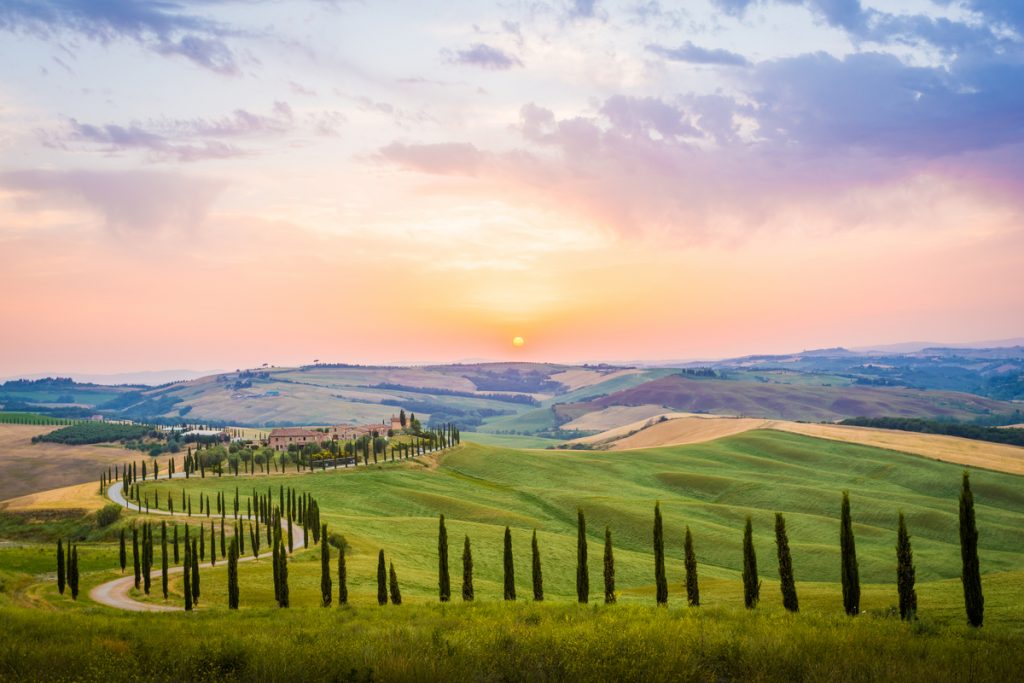
Getting around in Tuscany by train
As a general rule, it’s easy to travel around Tuscany by train if you’re visiting the bigger cities . Connections between Florence and all the main cities is good – from the slow rattling ‘treno regionale’ stopping at all smaller towns, to the faster Intercity. With a combination of trains and buses you can go practically everywhere in Tuscany, even the most remote little town. But you’ll need to do a bit of planning and have plenty of time on your hands.
Tuscany has four main rail artieries. The fastest is the Milan-Florence-Arezzo-Orvieto-Rome line. Another is a line that runs along the coast between Genoa-Pisa-Livorno and Rome. The third and fourth lines connect the first two. The Florence-Viareggio route stops in Prato, Pistoia, Montecatini Terme, and Lucca. Meanwhile the Florence-Pisa line has stops in Empoli and Pontedera.
NOTE: When travelling between Florence and Siena , the bus is the easiest and quickest option.
=> Everything you need to know about Paying for Things in Tuscany: info & practical tips
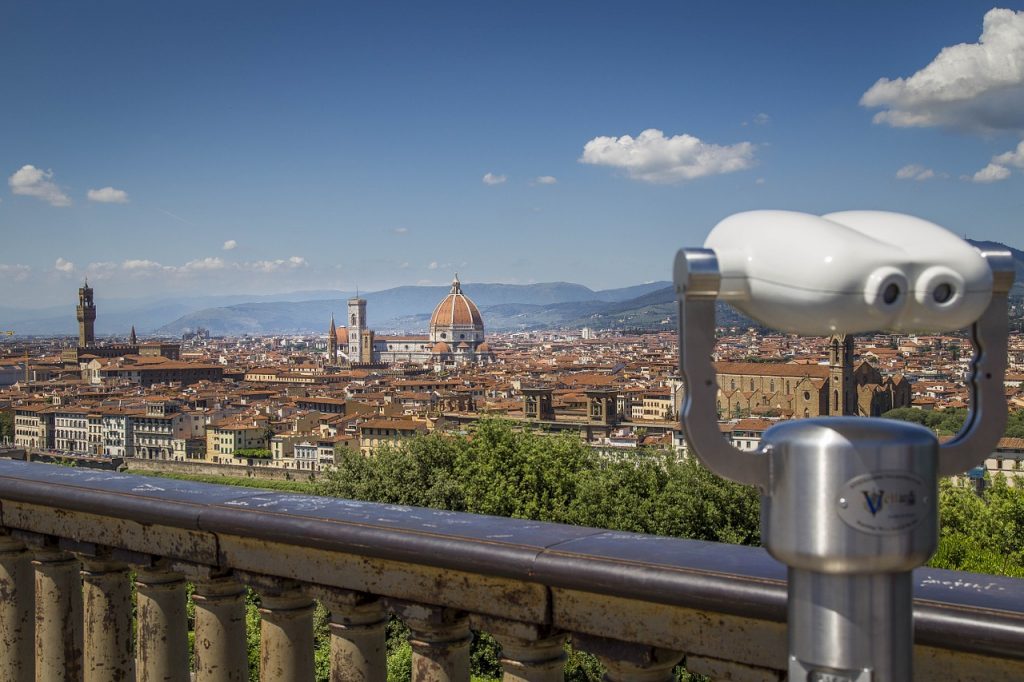
⇒ When travelling between by train from Pisa airport to Florence city centre, you have to change at Pisa Centrale station . The new Pisamover shuttle takes you from Pisa airport to Pisa Centrale in three minutes.
Italian trains are as generally clean and fairly comfortable. Remember that First class (prima classe) is only a touch better than second class (seconda classe). On Friday evenings, weekends, and in high season, trains can be hot and crowded.
Buying a regular ticket. Ask for either andata (one-way) or andata e ritorno (round-trip). If the train you plan to take is a high-speed service, ask for the ticket con supplemento rapido (with speed supplement) to avoid on-train penalty charges.
Ticket supplements. If you board a regular train without a ticket (or board an IC/ES without the supplement), you’ll have to pay the conductor a “tax” on top of the ticket price. Remember to stamp your ticket in the little yellow box on the platform before boarding the train. If you don’t you are liable for a fine.
The Frecciarossa (ES) is the high-speed train that connects Salerno, Naples, Rome, Milan, and Turin, stopping at Florence along the way. It’s the fastest and most comfortable option. But it’s also the most expensive. It has its own ticket window at the stations and requires a seat reservation. Other Eurostar/Frecciabianca/Frecciargento (ES) trains connect most Italian cities. These are the quickest of Italian trains. They offer both first and second class and you’ll need a supplement.
Eurocity (EC) and Euronotte (EN) trains connect Italy with international destinations. Intercity (IC) trains have first and second class seating and require a smaller supplement, but are often rather slow. Regionale (R) and the slightly faster Regionale Veloce (RV) don’t require supplements.

For information and reservation visit the website of Trenitalia or call: 89 20 21 or 199 892021. Helpline for disabled passengers at 199 303060
You may find the following terms useful when at the train station: treni in arrivo – arrivals treni in partenza – departures binario – platform in orario – on time in ritardo – delayed
How long does it take?
Firenze S.M. Novella – Pisa Centrale 1h. to 80 minutes
Firenze S.M. Novella – Lucca 80 minutes to 100 minutes
Florence S.M. Novella – Pistoia
Florence S.M. Novella – Arezzo 45 minutes to 90 minutes
Florence S.M. Novella – Livorno 1h and 40 minutes
Florence S.M. Novella – Siena up to 100 minutes (often with a change) – TAKE THE BUS!
Getting around Tuscany by bus
The main bus companies in Tuscany are:
BUS ITALIA – SITA
Services between Florence and the areas of Chianti, Siena, Arezzo, Valdarno, Casentino, Mugello.
Office in Florence (for info and tickets): via Santa Caterina da Siena, 15 (near S.M. Novella train station) – number to call for information: 800 373760
This is the best and quickest option to travel from Florence to Siena .
This company connects Florence, with the areas around Prato, Pistoia, Mugello. (it was previously called LAZZI)
Office in Florence (for info and tickets): Largo Fratelli Alinari, 10 – tel. number: 055 214637
This is the main bus company for southern Tuscany. It operates in the areas of Arezzo, Certaldo, San GImignano, Siena, Grosseto, Piombino and Maremma’s coastal areas.
For information call: 800 922984 (from mobile phone: 199 168182)
There are many options from Florence for daily trips by bus. They are also the best options for travel between Florence and Siena (they are quicker and more frequent than the trains) and between small towns around the region. Bear in mind that service is sparse on weekends. From small centres there are usually a couple of buses a day headed to the main city in the area. If you do plan to travel like this you’ll need time, and a little patience.
They do not operate on the 1st of January, on Easter, 1st of May, Christmas day. If travelling on a bank holiday, make sure you check with the bus company.
⇒ What to pack for your trip to Tuscany
FLORENCE BUS ATAF
In Florence the ATAF (Azienda Trasporti Area Fiorentina; 800 42 45 00; www.ataf.net ) cover the city centre and surroundings. Ticket costs 1.20 € and they’re valid for 90 minutes. Buy the ticket at the tobacconist or at the ATAF Information Office “ Ufficio Informazioni dell’ATAF ” (Piazza Adua; 7-20 in front of the train station). If you buy them on board, the price is 2€.
ATAF Buses are the best way to get from Florence to Fiesole and Piazzale Michelangelo. This company also connects Florence city centre with Florence airport .
Find out the best sights in Tuscany and the top things to do to make the most of your stay.
Your friendly online guide to Florence and Tuscany. Get our insider travel tips delivered to your mailbox every month.
Email address:
Read Our Popular posts
- 3 Scenic Drives in Tuscany, Italy 507 views
- Best coastal towns in Tuscany 339 views
- Medici the Magnificent. Fact and Fiction in the TV series 261 views
- Val d’Orcia itinerary – A day driving around Val d’Orcia 232 views
- My secret Florence – Hidden gems in the city of the Renaissance 228 views
- Easter in Florence – Experience a traditional Easter in Florence 174 views
- Chianti Road Trip – A scenic drive on the Chiantigiana Road 160 views
- 8 Famous Statues in Florence you have to see 160 views
- 10 Non-touristy things to do in Florence 156 views
- 10 Best Chianti Towns to visit 148 views
Recommended Reading
Driving in tuscany.
If you're planning to stay in and around Florence, you're unlikely to need a car....
Getting to and from Florence and Pisa airports
Everything you need to know about getting to and from Florence and Pisa airports in the region...
Cities in Tuscany
A brief introduction to the main cities in Tuscany and their attractions. Florence is the...
Top places to visit in Tuscany
Discover the top places to visit in Tuscany. Beautiful places that will make your holiday unforgettable. Start...
Best Way to Visit the Tuscan Countryside
The glorious region of Tuscany is a picture-postcard destination in northwest Italy. It’s easy to see why great artists and visionaries such as Da Vinci, Michelangelo, and Galileo made Tuscany the birthplace of the Renaissance. Several towns and cities are designated UNESCO World Heritage Sites and superb photo opportunities are available at every corner. But some of the best things to do in Tuscany are just being present and soaking in your surroundings. Discover local traditions, sample mouth-watering Tuscan cuisine, and sip aromatic Chianti wines. Or go on a Tuscany tour with a local guide and get a deeper insight into the local history and culture. Be sure to check out where to stay in Tuscany . Our guide on the best ways to visit the Tuscan countryside tells you everything you need to make the journey!
Table of Contents
Tours to the Tuscan Countryside
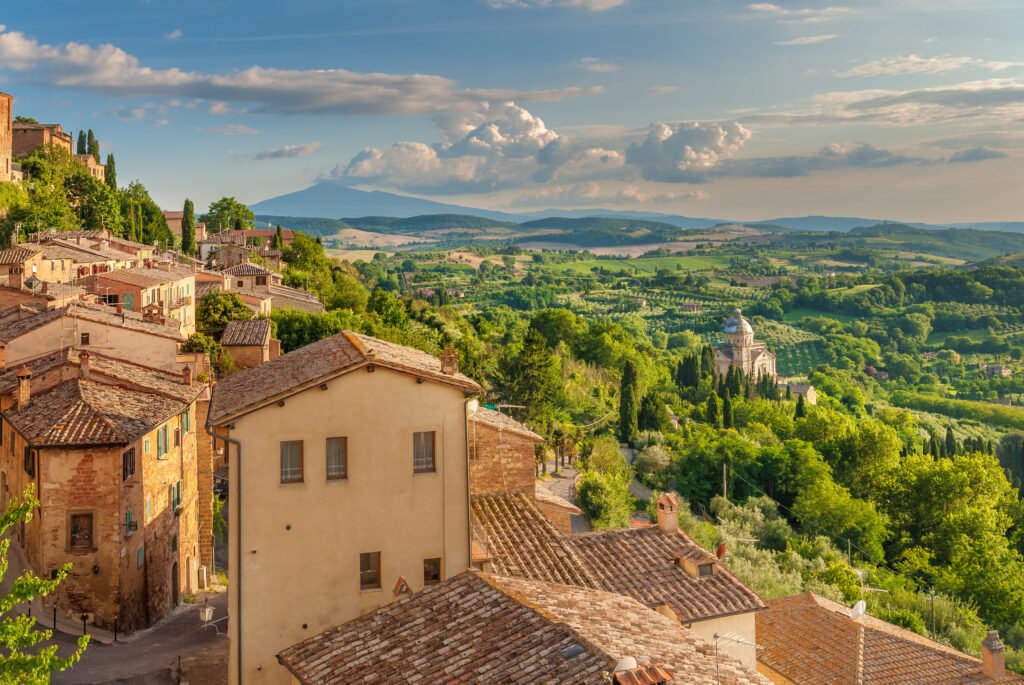
By far the best way to visit the Tuscan countryside is by guided tour or package tour of Tuscany . There is certainly no shortage of ways to get around Tuscany , but navigating yourself around the countryside can result in lots of wasted time. With all the logistics taken care of, you’re able to see the highlights and simply enjoy yourself. Tours start from the major towns and cities such as Florence.
Popular tours of the Tuscan countryside:
- Tuscany Sunrise, San Gimignano, Lucca, and Pisa Tour from Florence – wake up to the Tuscan sunrise as you take the scenic route through the Tuscan countryside. After stopping for incredible photo opportunities, you’ll spend the day seeing all of Tuscany’s best cities. From €99 per person.
- Ultimate Coffee Tour Experience from Florence – If you’re a coffee lover seeking beautiful Tuscan views, this is the tour for you. Travel from Florence into the depths of the Tuscan countryside, where you’ll tour historic coffee-making institutions, nestled within the picturesque countryside. You’ll get a chance to taste a range of Italian espresso products and even perfect your barista skills!
- Back roads of Chianti 4×4 Tour from Florence – a full day in the Chianti region of Tuscany’s small back roads – including vineyards, beautiful landscapes, food and wine tastings, and a local style lunch. From $170 per person.
- Tuscan Market Tour and Cooking Class from Florence – head from Florence, into the Tuscan countryside, buy local produce at a local food market, and cook a local-style meal which you’ll then enjoy in a rustic setting. From $139 per person, this is one of the best cooking classes in Tuscany .
- San Gimignano, Chianti, Siena & Colle Val d’Elsa Tour – From Florence – visit some of the most picturesque and iconic locations in Tuscany, including wine tastings, and local lunch, in a one-day small group trip from Florence. From $189 per person.
- Chianti e-Biking Tour from Florence or from Siena . Or on horseback from Siena . A day of exploring the countryside of Tuscany on an e-bike or horseback. From $89 per person.
Popular Tuscany Tour Packages
Alternatively, for an entirely hassle-free and curated experience, try a Tuscany Tour package .
- The Alternative Florence & Tuscany 6 Day Tour Package combines time in stunning Florence with peeks at the smaller, fascinating towns in the region. Sample wines, learn how to cook local specialties, and immerse yourself in the history and culture of the region.
- You can also discover the rest of the country with the 14 Day Italy Tour Package – a whirlwind adventure through Rome, Venice, Naples, and more, with two days of discovering Florence and Tuscany.
How to Visit the Tuscan Countryside by Train
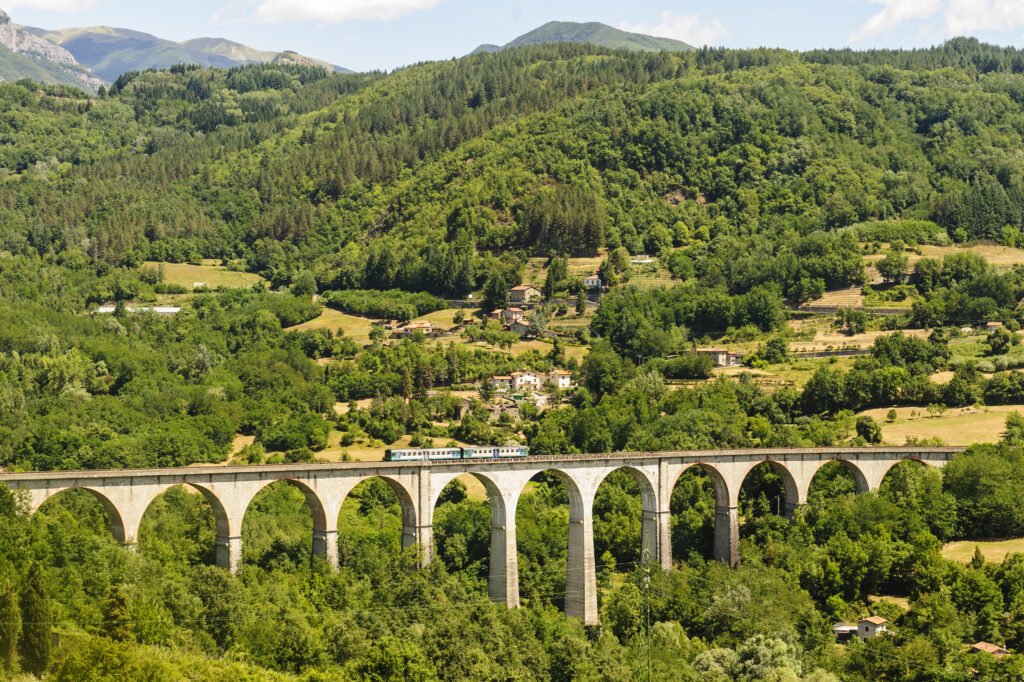
Florence is the main rail hub for Tuscany. Most visitors arriving from Rome , Milan , or Venice by train will transfer here for the Tuscan countryside. It’s easy to reach larger towns such as Siena , Lucca , Arezzo, and Pisa from Florence with regular services and reasonably priced fares. Pisa also has frequent train services to Lucca, Livorno, and Grosseto. If you plan to visit picturesque towns and hilltop villages like San Gimignano and Volterra, there are bus links from Poggibonsi station to your destination. Train tickets are well priced with fares ranging from $5 to $12 USD depending on the length of your journey. Carriages are clean and comfortable, ensuring you arrive at your destination ready for adventure.
Traveling to the Tuscan Countryside by Bus
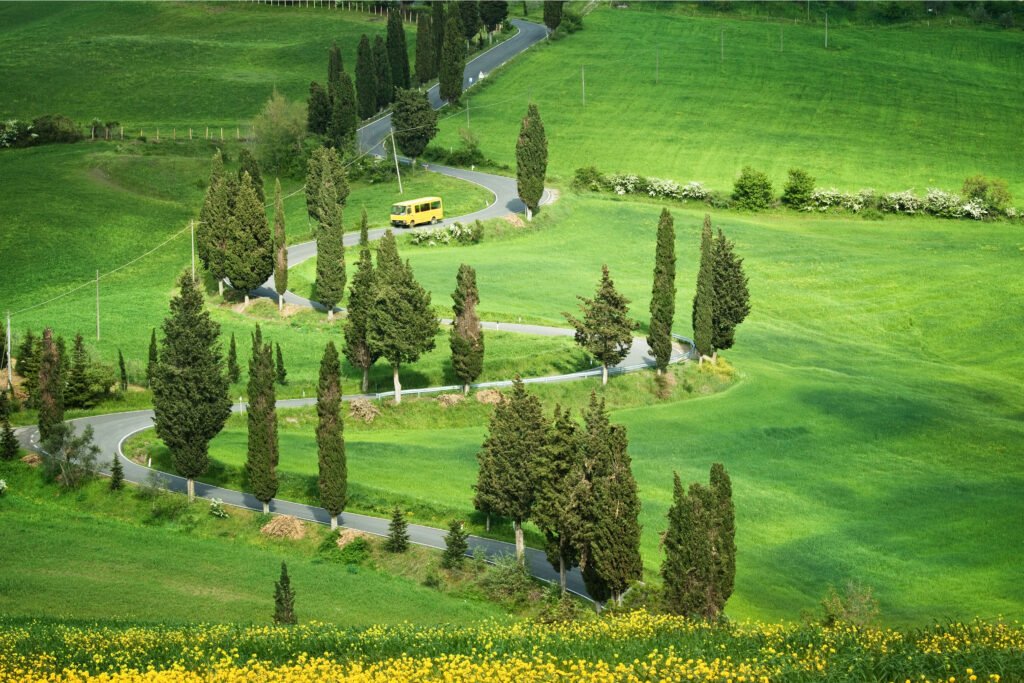
Traveling by bus is a great option if you want to get off the beaten track, with good services connecting most cities, towns, and villages throughout the Tuscan region. Every major city has a handful of bus companies that they use to get around. In Florence, LAZZI offers regular connections to Lucca, Pistoia, Pisa, and Prato. And SITA provides links to Siena and the Chianti wine region . If you’re staying in Pistoia, the Pistoia Mountains and Montalbano regions are easily accessed via Copit buses. And Michelangelo’s birthplace of Arezzo is served by the ATAM bus company. While you’re there, take a private walking tour or cooking class to get a feel for the place. It’s also possible to organize themed bus tours via many hotels and excursion companies in the region. Food and wine day trips , tours to see historic sites , and private tours are all available.
Driving to the Tuscan Countryside
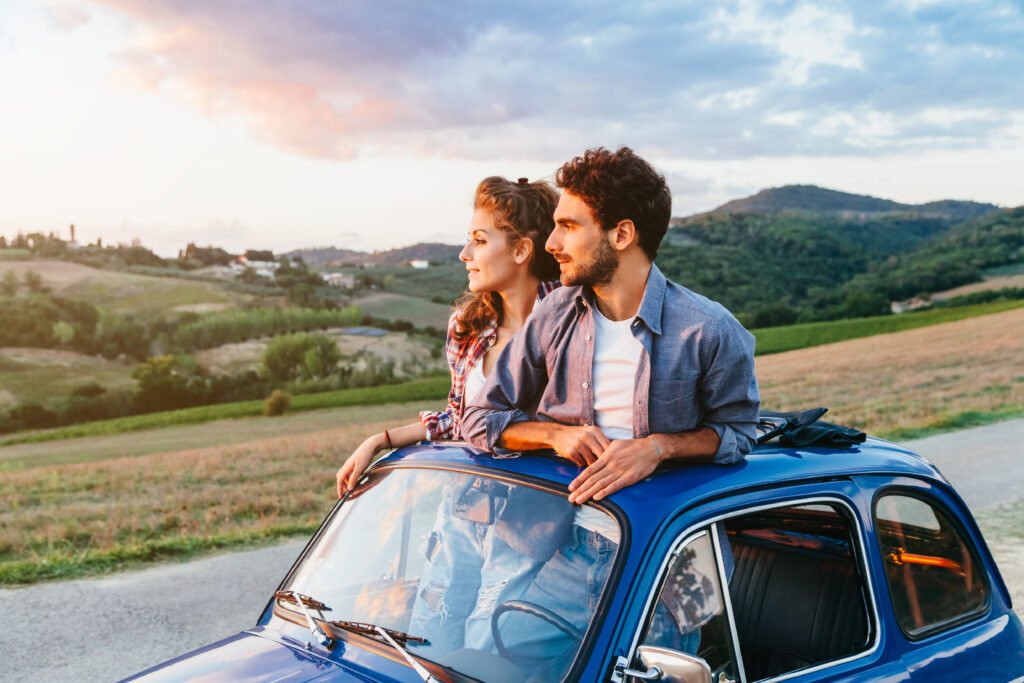
Another option for navigating this route is traveling by car. Imagine driving along winding cypress tree-lined roads, Italian style, in a Fiat 500 or Alfa Romeo convertible, stopping at charming trattorias for lunch, or breaking at a vineyard to sample local wines. Tuscany is easy to navigate by car, with just a few main road arteries connecting the region to major cities. You can reach Arezzo and Siena from Florence via the E35, and if you plan to drive to Lucca and Pisa, take the A11. This route takes you past Pistoia and Montecatini Terme – a famous spa town with mineral-rich waters. If you’re traveling by car in the Tuscan countryside, consider adding some experiences to enhance your trip. For example:
- Brunello Wine Tasting & Lunch In A Tuscan Castle From Montalcino
- Cooking workshops in Arezzo
- Wine tasting in Brunello
- Walking tours of small and enhanced towns such as Arezzo , Cortona , Lucca
Check out hotels in Siena for places to stay nearby and the best tours in the area . The Best of Tuscany 3 Day Tour From Siena is a great option for discovering Siena and its surrounding attractions over several days.
Flying into Tuscany
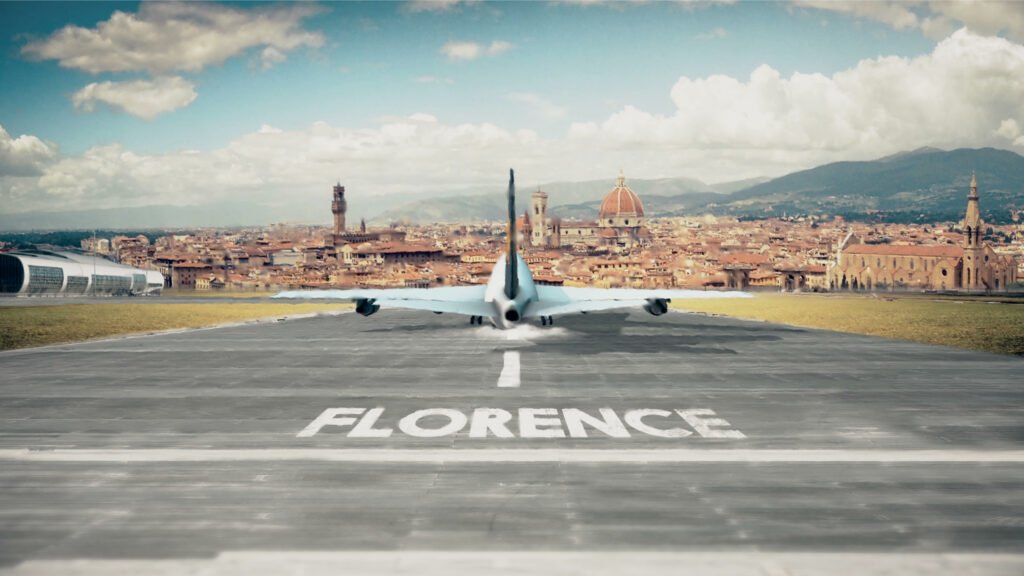
If you fly into Tuscany, you have a choice of 2 airports. Amerigo Vespucci Airport in Florence or Galileo Galilei Airport in Pisa. There are also flights into Bologna, Perugia, and Rome which are all within driving distance. Take our private transfer from Bologna Airport directly to Florence or transfer to Bologna city for hassle-free rides. Check out the full story in our Florence Airport Guide . From Florence and Pisa, you can catch buses, and trains, or rent a car to reach the Tuscan countryside.
Alternatively, take the hassle out of your itinerary and book a day trip to Chianti wine country, Siena , or Lucca! With its excellent hotels , Florence makes a great base for Tuscan explorations – here’s our take on where to stay there . Tours like the Best of Tuscany Day Tour and the Tuscan Market Tour and Cooking Class are great ways to explore the countryside from Florence – no navigation needed!
Cycling Through Tuscany
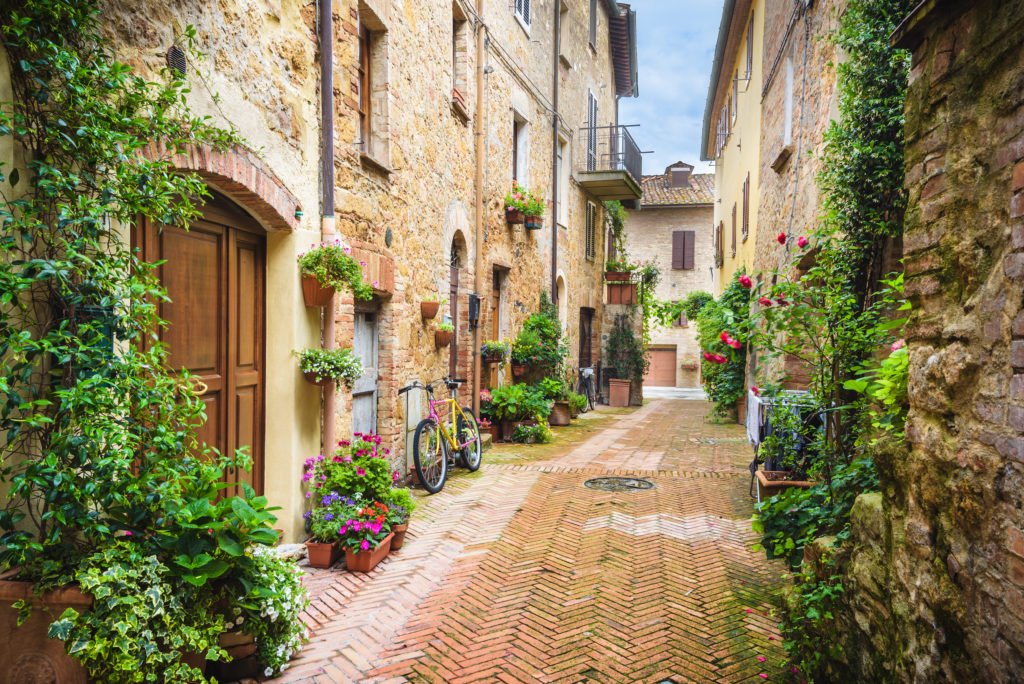
If you want to keep those pasta kilos at bay, a bicycle tour is an excellent way to explore the Tuscan countryside. Many towns and cities in Tuscany rent bicycles for a few hours to a day or longer. The Chianti E-Bike Tour from Siena will see a local guide lead you through stunning backroads in the Tuscan countryside. Alternatively, you can go the most old-school route on a Chianti Hillside Horseback Riding Tour from Siena . Riding through the rolling Tuscan hills on horseback is undoubtedly the most romantic way to experience them.
Coming in from a different city? No problem! Our Day Trip to Tuscany from Rome provides you with the best opportunity to explore this region from the capital city.
Subscribe for insider tips to Italy Enter your email address to stay in-the-know of what's new in Italy. We promise to only send you guides to the best experiences. Email Keep Me Updated
Recommended

Related Articles

Siena Travel Guide

Tuscany And Florence Food And Wine Travel Guide

Ultimate Tuscany Travel Guide

Best Things To Do in Tuscany

Best Things To Do in Florence

Food Travel Italy: An Insider Guide

Planning Your Italy Holidays? Your Guide to Dream Destinations and Tours in 2024

Italy in May 2024

Italy in April 2024

Italy in March 2025
- TAXI FARES CALCULATOR
- BOOK PRIVATE TOUR
- Hotels near Termini
- 3 Star Hotels
- 4 Star Hotels
- 5 Star Hotels
- Apartments For Rent
- Best Hostels
- Hotels near the Colloseum
- Fiumicino Airport
- Ciampino Airport
- Termini Railway Station
- To Florence
- To Ostia Antica
- Famous Roman Dishes
- Best Pizza Places
- Best Pasta Places
- Local Italian Food
- Best Gelato Places
- Best Rooftop Bars
- Sistine Chapel
- Vatican Museums
- Borghese Gallery
- Roman Forum
- Trevi Fountain
- Spanish Steps
- Castel Sant’Angelo
- Navona Square
- Ancient Sites and Ruins
- Galleries and Museums
- Parks and Gardens
- Squares and Fountains
- Beaches near Rome
- To Alberobello
- How to Choose a Hotel in Rome
- 2025 Pilgrims of Hope Jubilee
- Rainy Days in Rome
- What to See in 3 days
- Buying a Sim Card in Italy
- Tickets to Vatican museums
- Renting a Car in Rome
- Apps for Tourists
- Souvenirs from Rome
- Free Things to Do
- Unusual Things to do
- Public Transport
- Italian food and wine
- Sightseeing Tour at Sunrise
- Sightseeing Tour by Car
- St Peter’s Basilica
- Colosseum & Roman Forum
- Campo Marzio
- Jewish Ghetto Quarters
- Quartiere Coppedè
- Sant’Eustachio
- Marcus Aurelius
- Gaius Julius Caesar
- Octavian Augustus
How to Get from Rome to Tuscany
Written by: Kate Zusmann
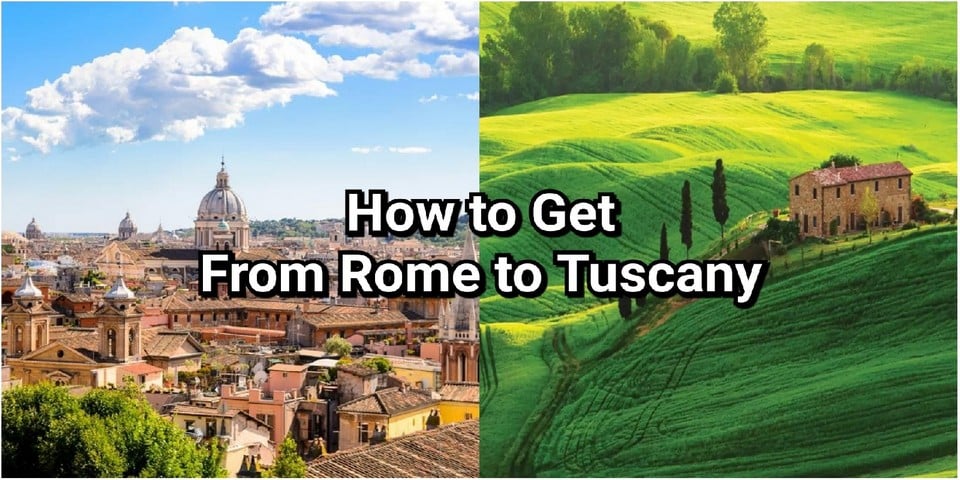
12467 views
Rome is located in the region of Lazio, right near the famous Tuscany region . Tuscany is known worldwide for its medieval towns, cuisine, art, and wine. It is worth exploring the Green Hills region from Rome, at least for a day trip. Moreover, the distance between Tuscany and Rome is 280 km. Your journey to the final destination will take from 1 to 5 hours. There are many transportation options for getting from Rome to Tuscany, where the most convenient is a high-speed train or car.
You can compare all ways to get and buy tickets on a reliable search engine website Omio.com
Here’s the list of options on how to get from Rome to Tuscany:
Tuscany Day Tour from Rome
If you’re staying in Rome and yearning for a slice of authentic Italian culture, consider venturing on a day trip to the splendid region of Tuscany. Known for its beautiful landscapes, artistic heritage, and gourmet delights, this tour introduces you to the heart of Italy in an unforgettable way!
The journey begins in Montepulciano, a quaint town known for its Vino Nobile. Delve into the town’s historical charm through a guided tour highlighting its architectural and vinicultural importance.
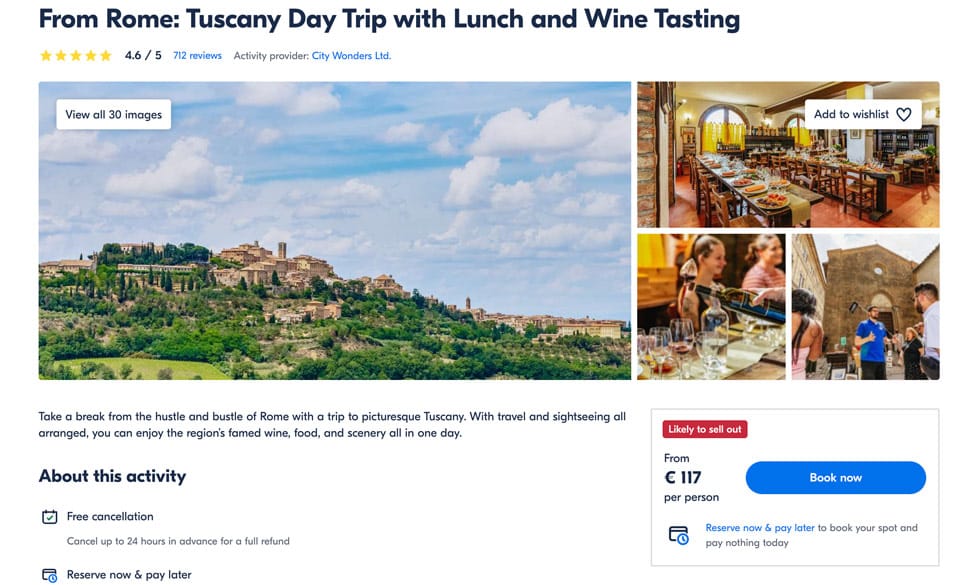
Next, prepare your senses for a traditional Tuscan feast. At a rustic vineyard farmhouse, you’ll savor a three-course lunch paired with an array of locally produced wines, providing a taste of the region’s culinary prowess.
Your final stop is Pienza, where you’ll enjoy the freedom to explore at your own pace. Renowned for its pecorino cheese and rich wines, it’s an ideal spot to pick up gourmet souvenirs.
This Tuscany day tour from Rome is more than just a break from city life; it’s an immersion into the soul of Italy. Be ready to be charmed by Tuscany’s captivating allure. For more information and to book your tour, visit here .
Getting from Rome to the Tuscany region by high-speed train is easy, convenient, fast, and not expensive. Many fast train options are functioning daily from 6 am to midnight with different journey times and prices, depending on the city of your final destination. The most popular and visited cities of Tuscany are Florence , Pisa , Lucca, Siena , and San Gimignano.
The main route that passes through Tuscany from Rome is through Florence
You should better buy train tickets in advance, so there is a high chance of purchasing them at discounted prices. You can book tickets online on ItaloTreno or Omio.com websites. In addition, a direct train goes from Roma Termini station to Santa Maria Novella in Florence, and the journey takes only 1.5 hours. Here’s an example of the schedule and prices from Rome to Florence by train:
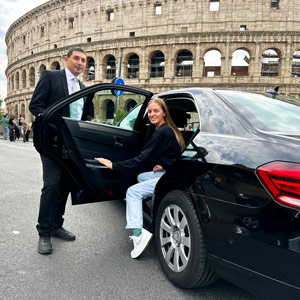
Explore Rome in the most comfortable way!
from €150.00

Trains from Rome to Florence are the most frequent and prices for one-way tickets start from 15 euros. Another option is to go to Siena with a stop in Florence because most high-speed train tickets to Siena are not direct. Prices also start from 15 euros. Here’s the example:
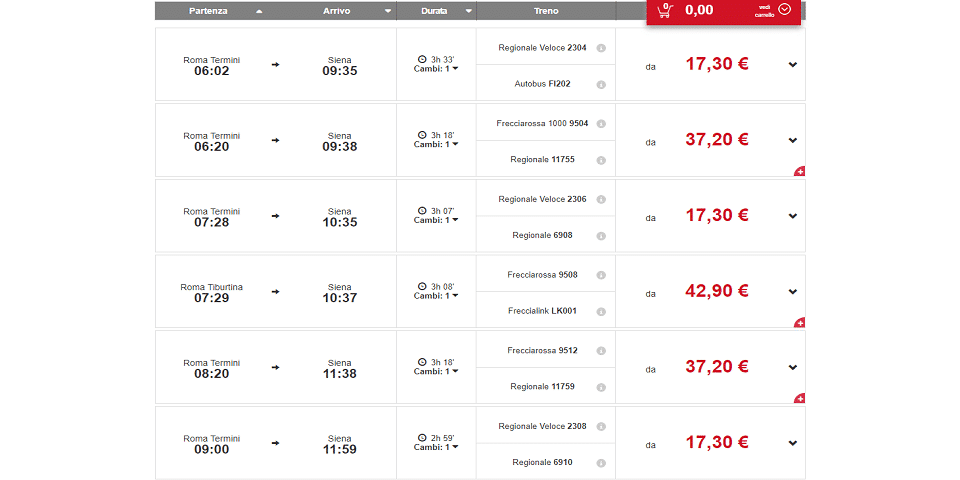
Also, Trenitalia offers fast trains to Lucca with a train change in Florence central station. The journey takes about 3 hours, and prices start from 25 euros:
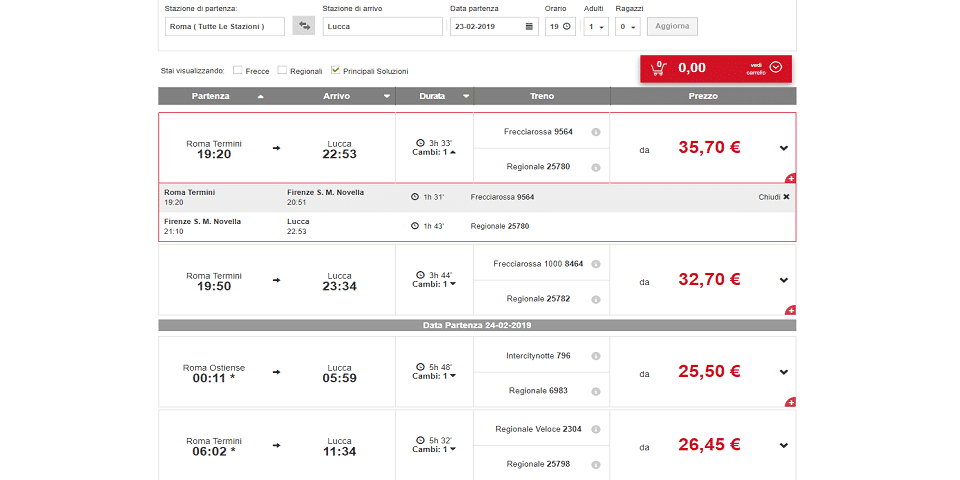
- Read an article about ItaloTreno trains.
Getting from Rome Tiburtina bus station to any of the cities in Tuscany may take more time, but there are direct buses to Pisa, Siena, Florence, and several exciting towns. You can buy bus tickets on the website of FlixBus company. Prices to different destinations start from 9.99 euros one-way . This option is excellent since you can wake up earlier and make a day trip from Rome to Tuscany for an excellent price. For instance, here’s the schedule and prices of Flix Buses from Rome to Florence:
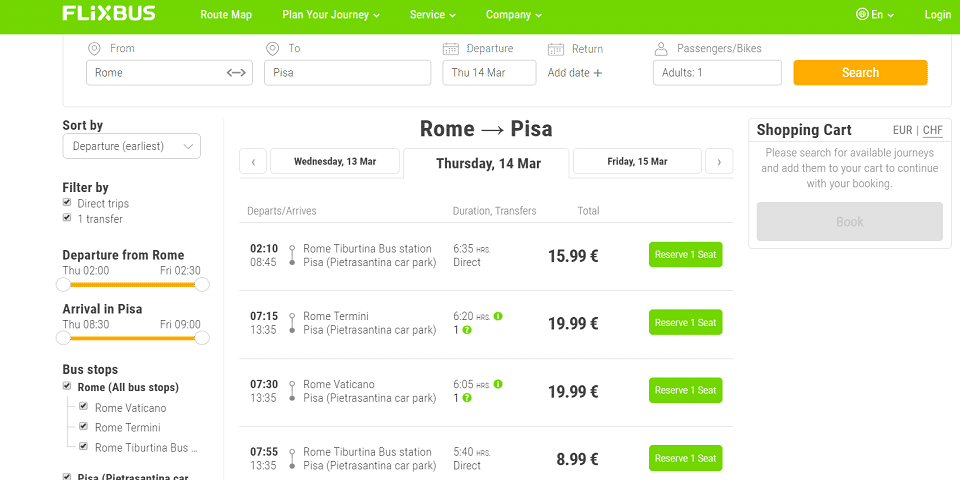
The distance between Rome and Tuscany is around 280 km by car. This option is the most convenient in that you can easily explore the towns and cities of the region. Tuscany is famous for its greenery, beautiful views, and charming valleys.
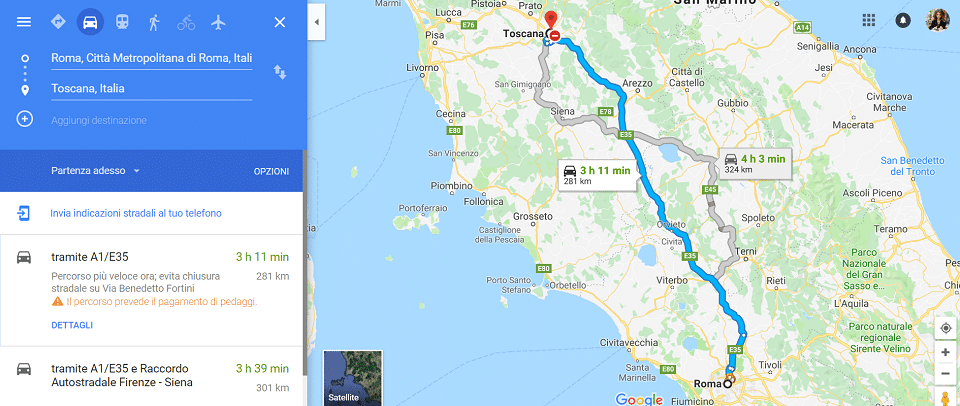
- You can rent a car in Rome on rentalcars.com
There are airports in Pisa and Florence so you can travel from Rome to Tuscany by plane. This option is not cheap, although the flight takes less than 1 hour. However, do not forget to consider time for the road to/from airports. For instance, the one-way ticket price from Rome to Pisa by plane starts from 30 euros, and the most popular airlines that offer flights between two cities are ITA-AIRWAYS.com (80-100 euros for a one-way ticket) and Ryanair.com (30-50 euros for a one-way ticket). Therefore, it takes only 55 minutes to reach your final destination by air. Flights to Florence are frequent: 4 times per day and they are provided by Alitalia company . On average, the price is 80 euros.
Read also about the best day trips from Rome .
Best Things to Do in Tuscany.
- Climb to the Leaning Tower in Pisa .
- Visit the Uffizi Gallery in Florence .
- Visit wine tasting in Chianti or try Montalcino wine in Montalcino.
- Try the famous Florentine steak (bistecca).
- Explore the movie scenes of “Twilight” in Montepulciano.
- Climb the clock tower in San Gimignano .
- Admire the Florentine Duomo .
- Admire masterpieces of Michelangelo and other famous artists in Florence.
- Try truffle hunting in San Miniato.
- Visit the Palio competition in Siena .
- Walk along the medieval streets of Lucca.
- Rent a real castle for your holiday.
- Visit famous valleys such as Val d’Orcia of the Tuscany.
- Try local dishes and olive oil.
- Pass by charming Volterra city.
Where to Stay in Tuscany – Best Places
Villa la principessa.
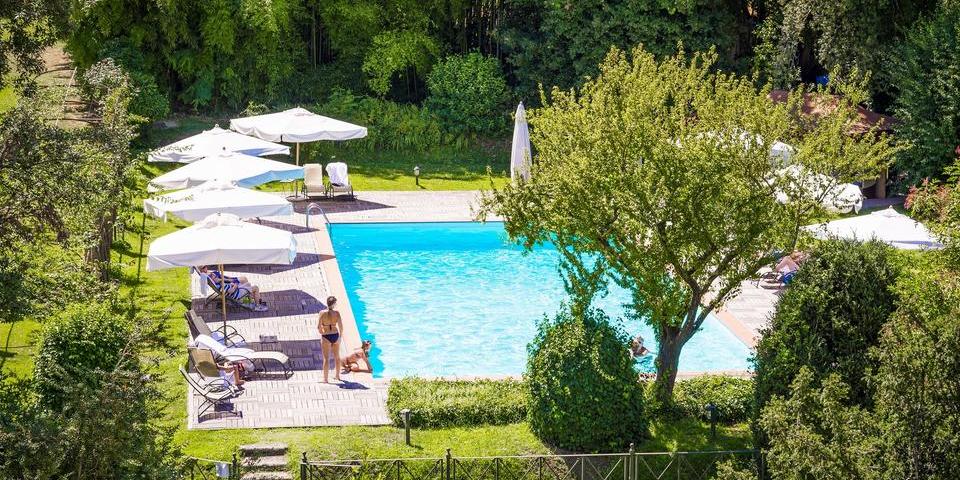
Hotel Villa La Principessa is an elegant hotel with a relaxing pool area located in Lucca. There is a restaurant with traditional food from Tuscany and traditionally furnished rooms. Moreover, this 13th-century house once belonged to the Duke of Lucca. All rooms include air conditioning, WiFi, and a minibar.
- The price for 2 people per night starts from 120 euro
Grand Hotel Minerva
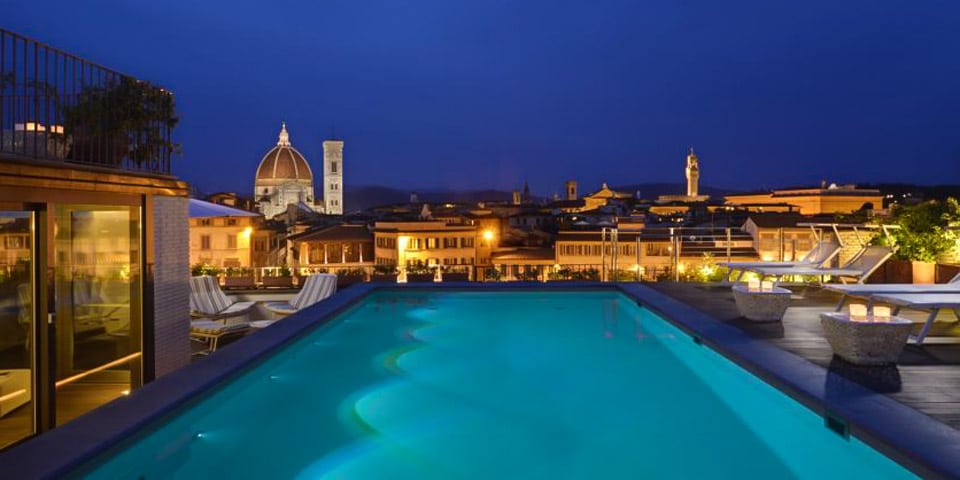
Grand Hotel Minerva is an accommodation in Florence that features a rooftop, swimming pool, and sun terrace with amazing city views. It is located nearby SMN train station. Its rooms are charming and with all amenities.
- Price: from 335 to 645 euros per day for 2 persons
Hotel Athena
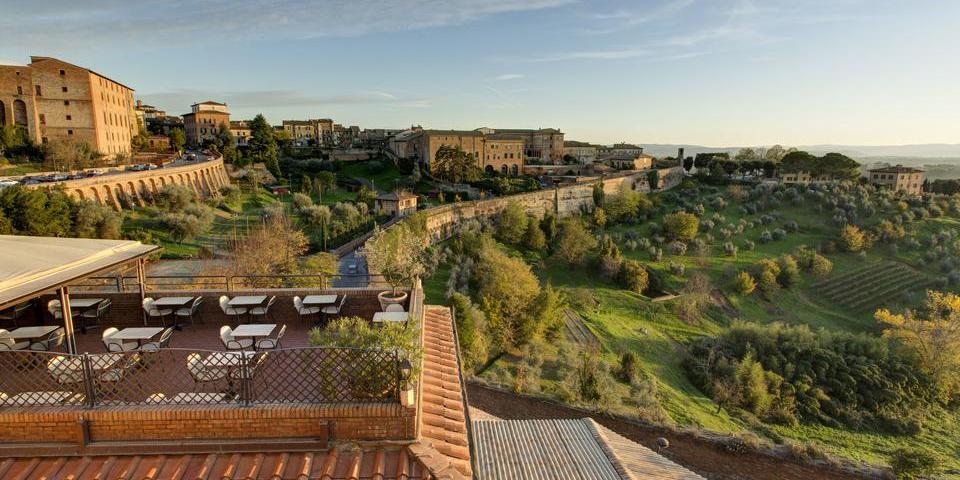
Hotel Athena is a 4-star hotel located on the historic walls of Siena. There is free parking, an elegant Italian restaurant, and a furnished terrace with views of the town and valley. Moreover, all rooms are spacious and air-conditioned.
- The price per night for 2 people starts from 120 euro
Dedo Boutique Hotel
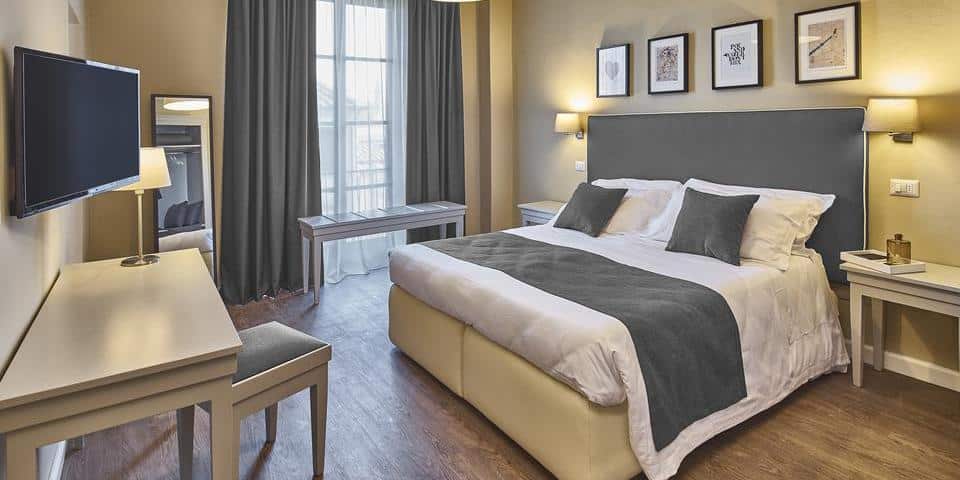
Dedo Boutique Hotel has a fantastic location right near the central station of Florence. Classic-style rooms with an air conditioner, free WiFi, and parquet floors. Moreover, all rooms have a satellite flat-screen TV, minibar, and electric kettle.
- Price: from 70 euros per night for a room for 2 people
Pisa City Lodge
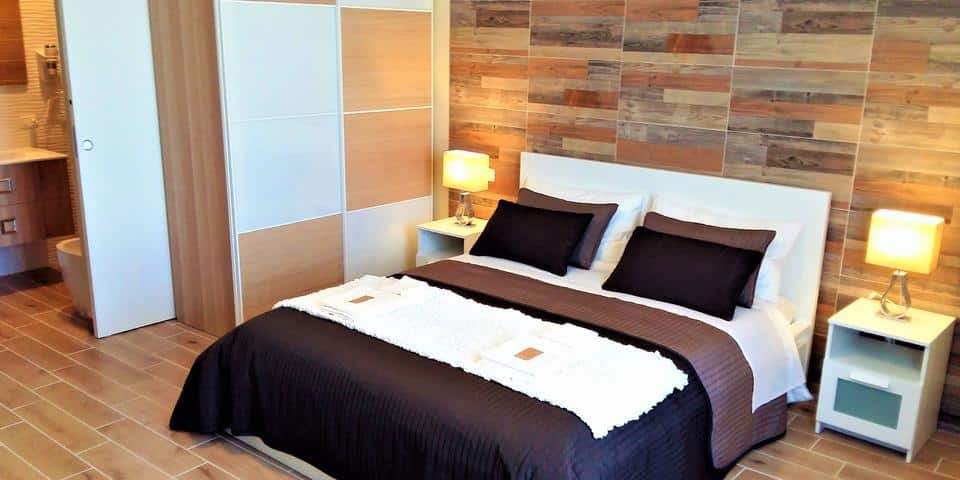
Pisa City Lodge is located near Piazza dei Miracoli and Pisa Cathedral. This bed and breakfast offer a flat-screen TV and a private bathroom with complimentary toiletries. Moreover, an Italian breakfast is served daily on the property. The B&B is high-rated by its guests.
- The price for 2 people per night starts from 80 euro
Hotel Panoramic
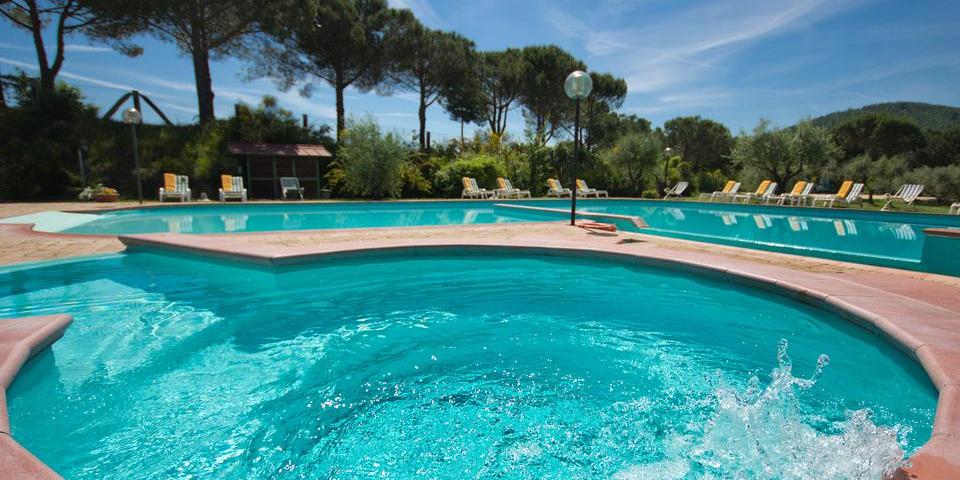
Hotel Panoramic is located in Montepulciano. It overlooks the Tuscan countryside from an altitude of 1969 feet. There is a large garden and an outdoor pool with a hydromassage area. It is a nice option to relax in a quiet area full of greenery.
Author: Kate Zusmann
For the last 10 years, I live in the Eternal City. Traveling, exploring new things, writing blogs, and shooting vlogs are my main hobbies, but the thing that I like even more is sharing my experience and thoughts with you! Explore Rome with Us :)
Dive Deeper into Rome's Stories
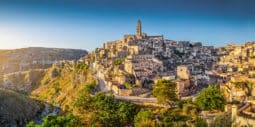
How to Get from Rome to Matera
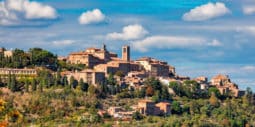
How to Get from Rome to Montepulciano
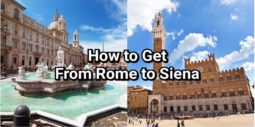
How to Get from Rome to Siena
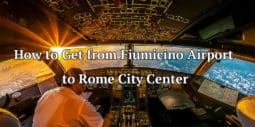
17908 views
How to Get from Fiumicino Airport to Rome City Center
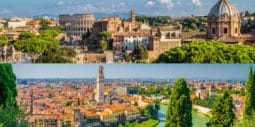
How to Get from Rome to Verona
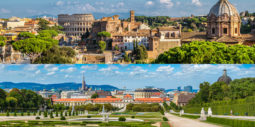
How to Get from Rome to Vienna
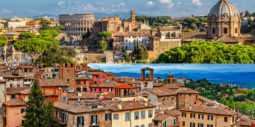
How to Get from Rome to Perugia
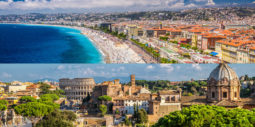
How to Get from Nice to Rome
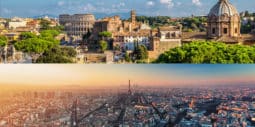
How to Get from Rome to Paris
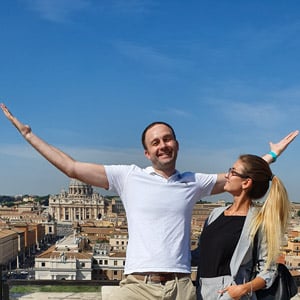
Read more about Rome

Who Painted Sistine Chapel?

15351 views
Vatican Military – Who Protects the Pope?

What to Wear in Rome in July?
Rome.us © 2024. Created with love by Roman experts and guides.
Privacy Policy

Art & Culture Travel Blog
How to travel around tuscany on public transport.
- Tea Gudek Šnajdar
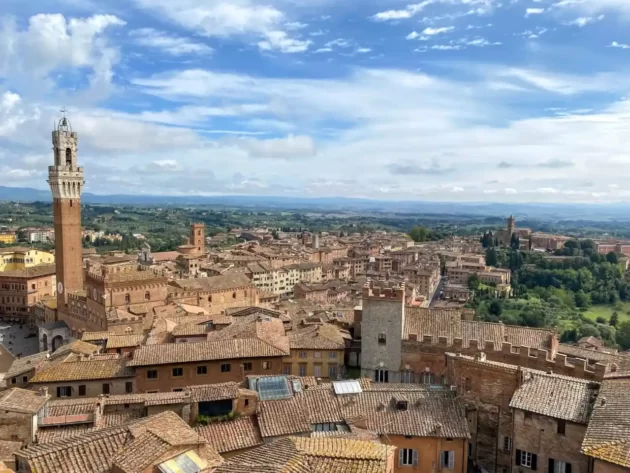
With its beautiful scenery, delicious food and fantastic art, Tuscany is a must-see place for any cultural tourist. It’s home to numerous lovely towns like Florence, Siena, San Gimignano, Arezzo, Luca, Pisa, and many more. The best way to visit Tuscany is by having a base in one of those places and seeing the rest on day trips. And don’t worry if you won’t have a car, because here is the complete guide on how to travel around Tuscany on public transport.
This is a sponsored blog post by Omio , an online platform for easy flight, train and bus bookings.

Tuscany is the best explored on a round trip. With its hills, lots of vineyards, historical villas and charming towns, the whole area is so dreamy. Travelling through Tuscany feels like going on a historical journey. It always reminds me of paintings at the Rijksmuseum made by the 17th-century Dutch masters who travelled to Italy.
I visited Tuscany twice this year and have visited many of these places during those trips. So, here are some of my tips on how to explore Tuscany by using public transport.
⤷ Read more : Where to travel in 2023
What to see in Tuscany
However, let’s start with what to see in that Italian region first. Here are just some of the towns listed, but you’ll find numerous interesting cultural sites throughout Tuscany.
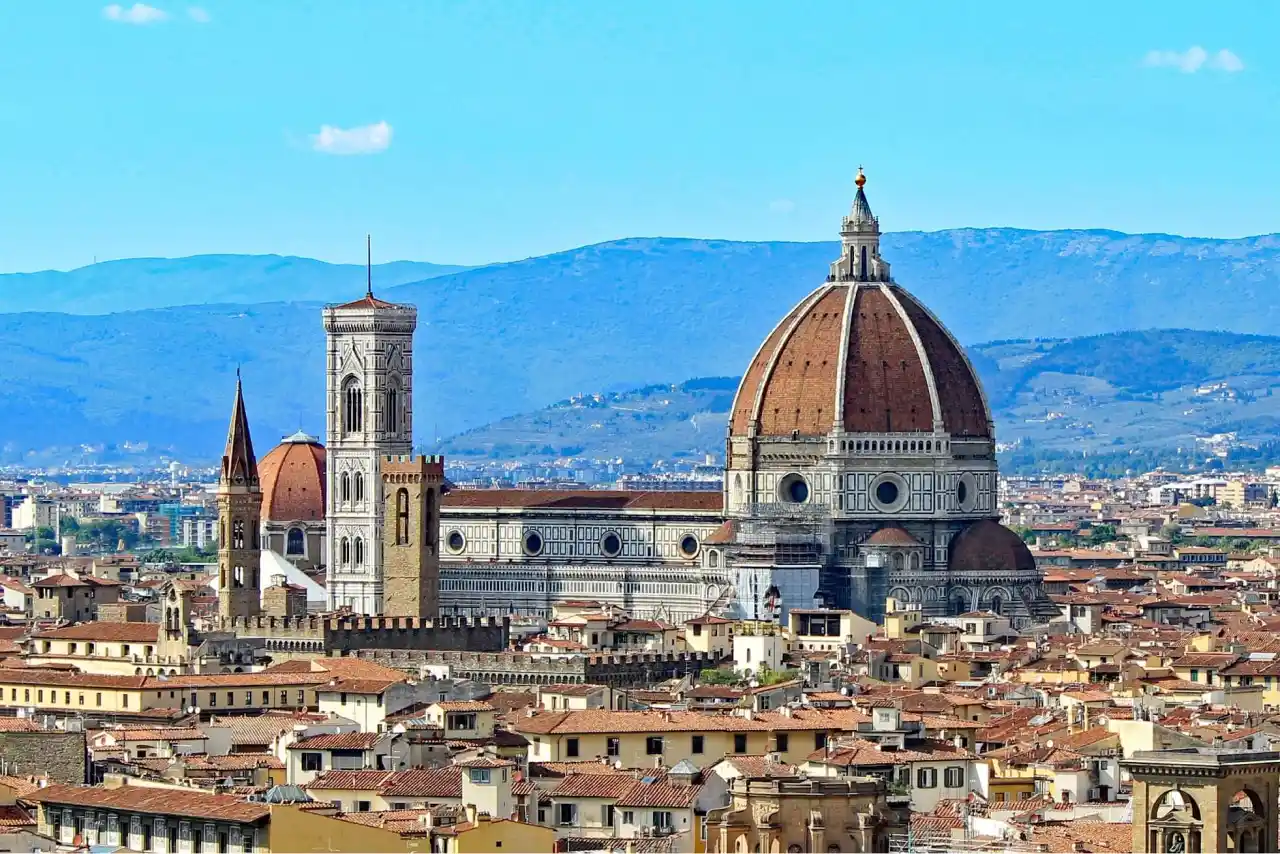
The largest town and the capital of Tuscany is Florence. It’s famous for its cathedral with a beautiful Renaissance dome. A former hometown of the powerful Medici family, Florence is also home to two museums that anyone interested in the Italian Renaissance should visit. Uffizi Gallery is where you can see some of the most famous artworks from the Renaissance time. Galleria dell’Accademia is home to a great collection of Michelangelo’s sculptures, among which the statue of David is the most famous.
⤷ Read more : 10 Cultural spots to visit in Florence
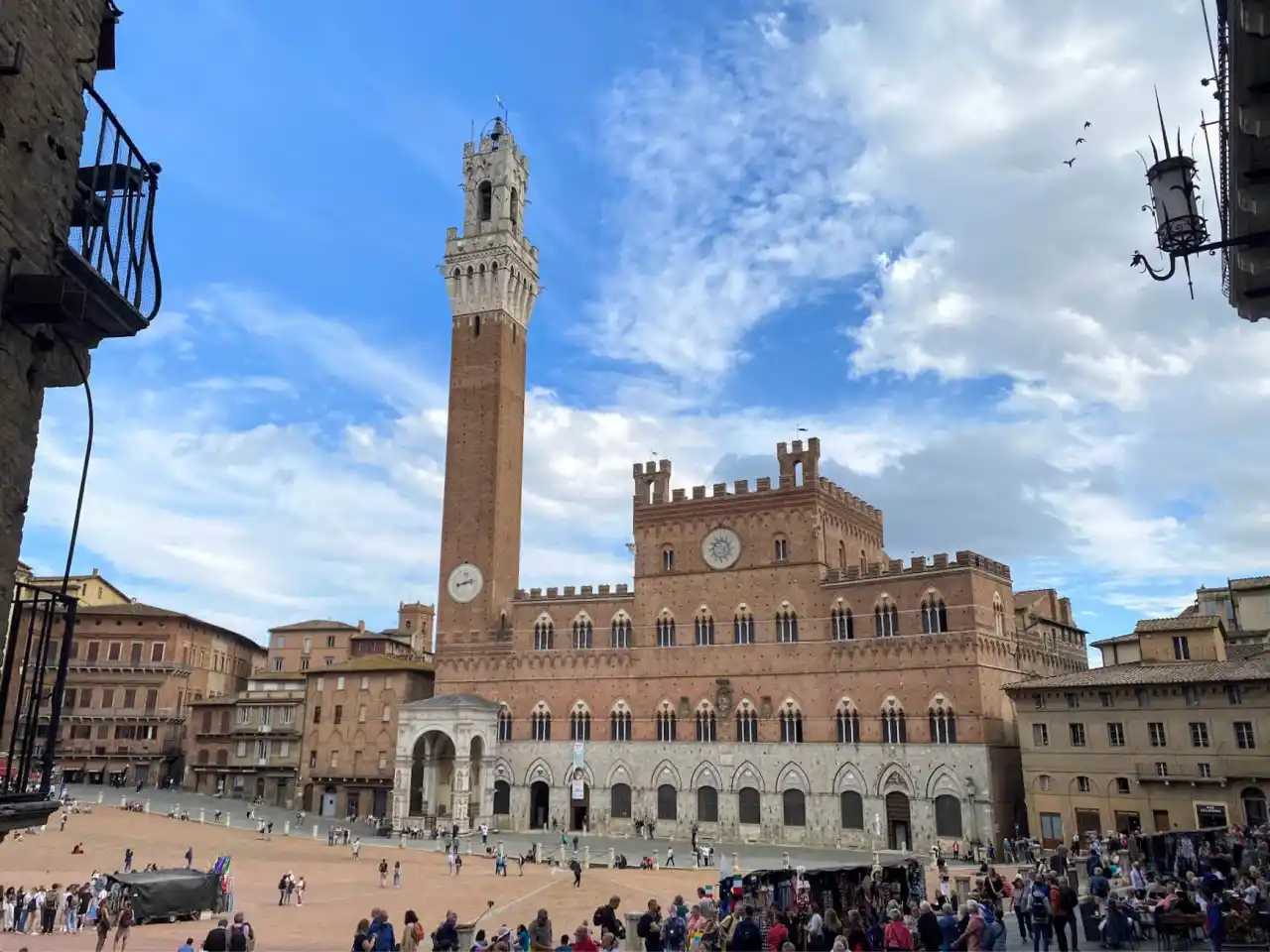
Located some eighty kilometres (fifty miles) further away, Siena was always a historical rival to Florence. Visiting that lovely town makes a great day trip while in Tuscany. When in Florence, you feel as if you have stepped back in the Renaissance time. However, the architecture in Siena is even older. With its narrow streets and historic houses, it looks much more medieval. This town’s highlights are its Romanesque-Gothic cathedral, the city hall with some of the most beautiful medieval frescoes (with a theme of the good and bad government) and its oval-shaped main square.
San Gimignano
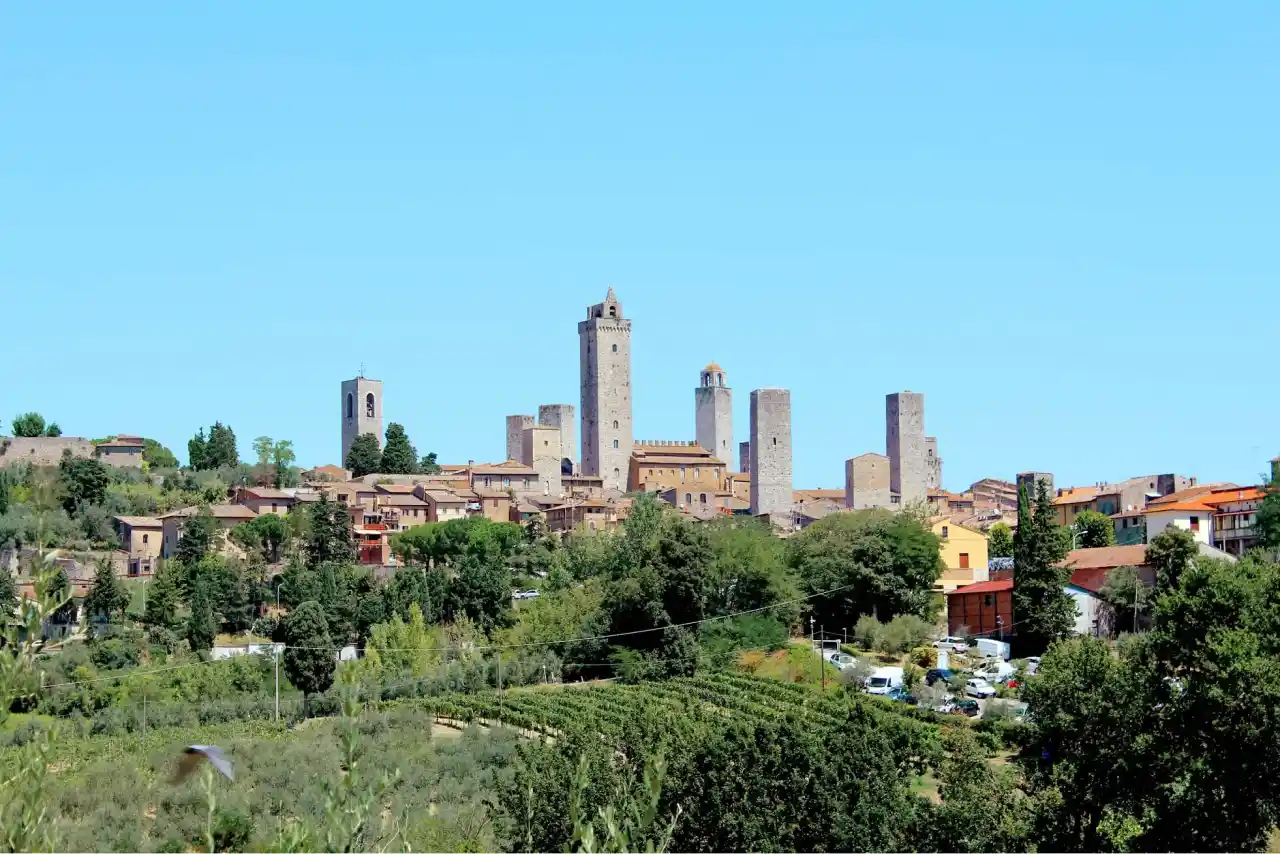
Since I first saw a photo of San Gimignano, a small town filled with medieval towers, I have wanted to visit it. It is one of the best preserved medieval towns and, because of that, listed as a UNESCO World Heritage Site. It’s still home to fourteen medieval towers that survived all the wars throughout the history. Surrounded by strong city walls, San Gimignano is home to many beautiful historical houses, palaces, piazzas and good restaurants.
⤷ TIP : While there, be sure to try a local wine called Vernaccia di San Gimignano.

Lucca is one of the most unique medieval towns in Tuscany and home to well-preserved Renaissance city walls. It’s known as the city of art because it was the birthplace of many world-famous composers, like Giacomo Puccini, the author of La Boheme and Madama Butterfly. Some places that shouldn’t be missed in Lucca are its medieval cathedral, the elliptical-shaped Piazza dell’Anfiteatro and the Romanesque-Gothic Gunigi Tower.
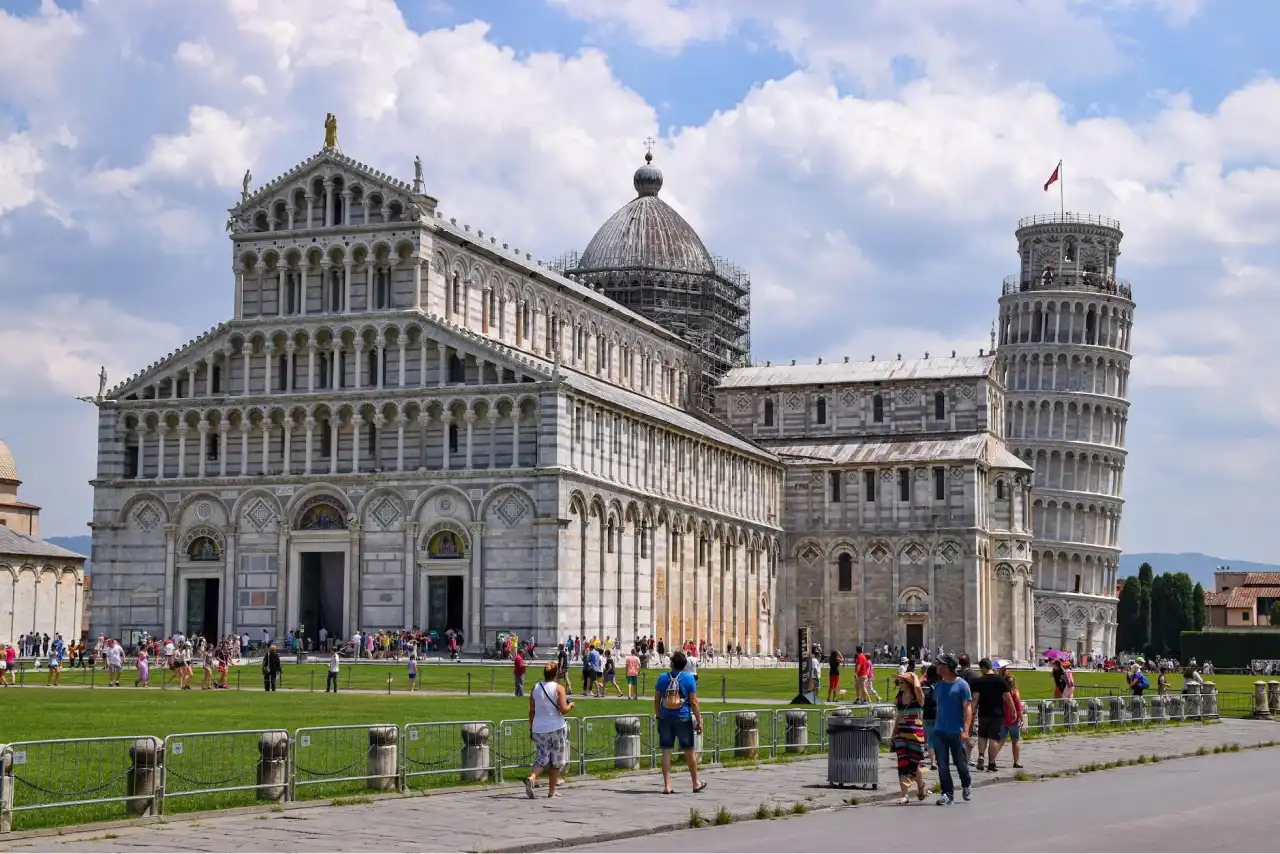
Although famous worldwide for its leaning tower, Pisa is home to many more historical landmarks. Pisa University was founded back in the 12th century. The city is filled with medieval churches and palaces. Some of the architectural landmarks in Pisa are its cathedral, baptistery and monumental cemetery, Campo Santo. In the Museo dell’Opera del Duomo you’ll find artworks made by two of the most famous medieval sculptors from Pisa – Nicola Pisano and Giovanni Pisano.
⤷ TIP : Galileo Galilei was born in Pisa. The international airport located next to the town is named after him.
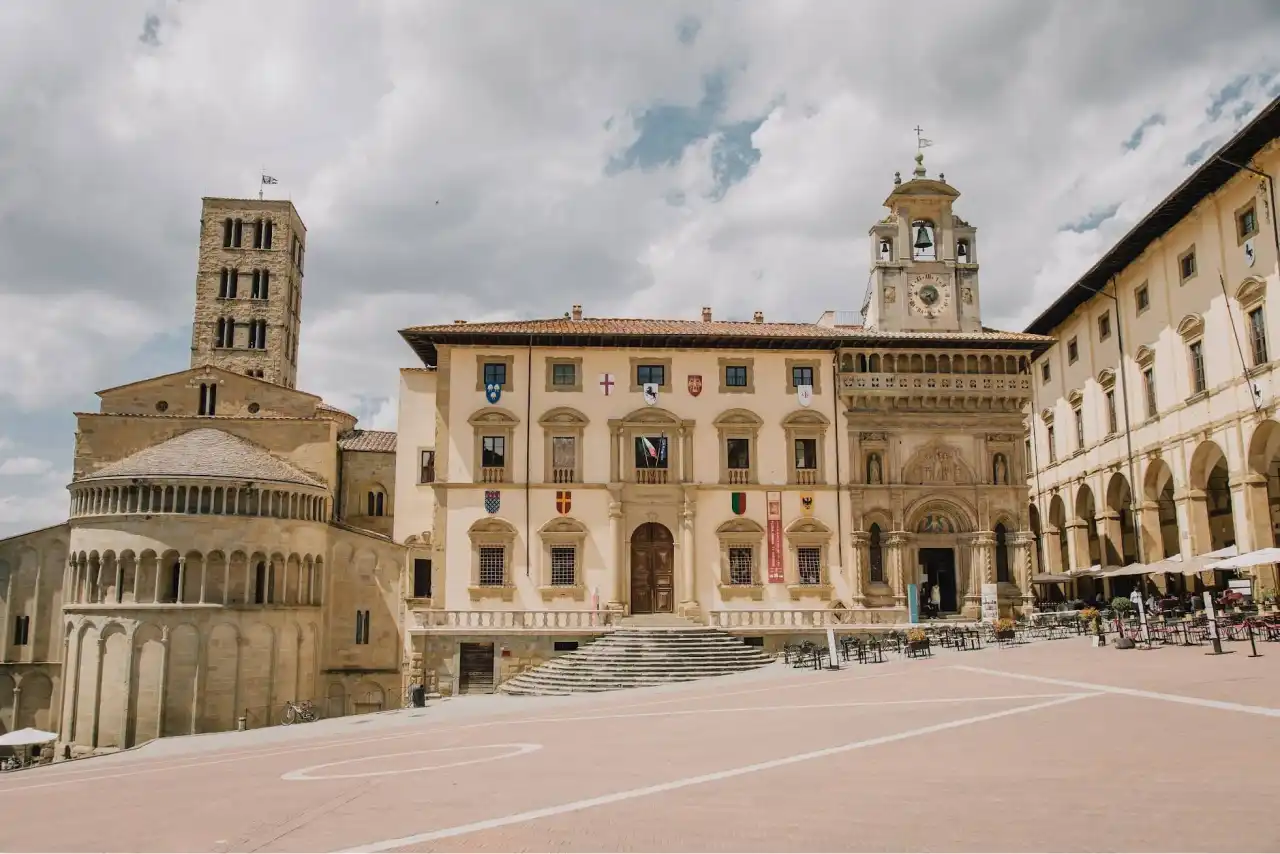
The charming town of Arezzo is one of the Italian art centres no cultural tourist should miss. It was the hometown of Giorgio Vasari. He wasn’t only a gifted artist, but also wrote the first biographies of his contemporaries, Renaissance masters. It’s home to numerous interesting cultural sites. Cimabue’s Crucifix in the San Domenico’s Church (13th century) and Piero della Francesca’s History of the True Cross fresco (15th century) shouldn’t be missed.
⤷ Read more : Beautiful autumn destinations in Europe

Exploring Tuscany by train
Tuscany is well connected by train and you can easily visit some of the places in Tuscany by using public transport. The train stations are usually located close to the town centre. One of the main Italian train lines connecting Rome with Milan passes through Tuscany. So, the trains are quick and depart regularly. Siena, Lucca, Pisa and Arezzo have direct train connections with Florence. You can visit them on a day trip or even plan a round trip to Tuscany by using public transport.
⤷ TIP : I visited Tuscany by car, as well. Italians have a specific way of driving that could be difficult to adjust for people from countries with different driving styles. And one of the main benefits of travelling around Tuscany by public transport is that you don’t need to look for parking (which could be quite an issue in the narrow streets of these towns).
Exploring Tuscany by bus
Getting around Tuscany by bus could also be a great way to explore that region of Italy. It’s especially handy if your accommodation is located outside the city centre or in some of the smaller villages in Tuscany. During my last trip to Florence, I stayed in a villa at the edge of the town. So, when I wanted to visit Siena from Florence by public transport, it was much easier to take a bus instead of a train. Also, don’t be afraid that buses will be slow because they often drive on a highway between the towns.
Busses are also very nice to use as a mode of public transport in those places, especially in Florence. They’ll get you right in the city centre for a very reasonable price – one journey will cost you 1,50 euros.

Using Omio to explore Tuscany by public transport
If you’re unsure what the best public transport options are for you, apps like Omio come in very handy. You can type in your departure and arrival destinations, and it will calculate the best travel options for you. Once you pick up your journey, you can buy your tickets online. That’s also useful because sometimes the tickets could be more expensive if you buy them from a bus driver.
Here is the link to all the train options for travelling in Italy that will hopefully help you plan your trip to Tuscany.
Tuscany is a beautiful region of Italy and home to numerous charming towns worth exploring. I hope this guide will help you with planning how to travel around Tuscany with public transport. Have you travelled around Tuscany on a train or a bus? Let me know if you have any additional tips to share.
The blog post ‘How to travel around Tuscany on public transport’ was sponsored by Omio, an online service for booking plane, train and bus tickets. However, as always, all opinions are my own.
Italy , Tuscany

Best Places to Visit in Tuscany
J oin EuropeUpClose as we take a journey to some of the best places to visit in Tuscany. We will begin in Florence, then drive to San Gimignano with a stop at the fabulous Antinori nel Chianti Classico Winery. From San Gimignano we venture to the compelling town of Siena with its fantastic cathedral and famous horse races in the Palio. Another hour south and we’ll stop at Caparzo Winery near Montalcino before heading east to the beautiful hilltop walled city of Montepulciano.
Also read these articles on Tuscany:
- Best Tuscany Wine Tours
- Where to Stay in Tuscany
- Tuscany Holiday Planning
- Tuscany Itinerary
Visit Florence
Florence is a natural starting point to begin your journey to the best places to visit in Tuscany. Known for the imposing red-roofed Duomo and Michelangelo’s David in the Accademia, Florence is a mecca for art, food, architecture, and history. You don’t want to miss the Uffizi Museum, the Central Market, and Ponte Vecchio, the bridge across the Arno River filled with shops displaying jewelry, crafts, and other fun products.
Also, read these articles on Florence:
- Where to stay in Florence
- Best Florence Walking Tours
- Best things to do in Florence
- Best Day Trips from Florence
Florentine Bisteca
And, of course, if you are in Florence, you must try the famous Florentine Bisteca. It is often referred to as some of the best steak in the world. We were lucky to have reservations at Trattoria dall’Oste Chianineria on Via dei Cerchi. Just a few minutes south of the Duomo, this iconic restaurant is well known for their Bisteca and other fine cuts of meat.
Florentines do like their steak rare, so be aware. You can order yours medium or medium rare, and it will most likely still come out very pink. One thing I liked about Trattoria dall’Oste Chianineria is that they brought out a hot plate along with the steak. That way, anyone who wanted their steak more done could cook it a bit more right at the table. Most of us ate it like it came, but there were a few in our party who preferred their steak more done. Sides included roasted potatoes, pasta with thinly sliced truffles, and some tasty bruschetta. For dessert, we completed our meal with a glass of Vin Santo served with tasty biscotti.
Wine Tasting and Lunch at Antinori Winery
With options of several great Antinori locations, we chose to tour the Antinori nel Chianti Classico vineyards just 20 minutes south of Florence. In a country where wine is a way of life, for twenty-six generations, the name Antinori has stood out.
We booked the special CRU Tour. This included a tour of the winery, a wine tasting of seven great wines, followed by a delicious lunch. This fully immersive experience featuring the wine-making philosophy of Marchesi Antinori following years of family tradition. Led by our outstanding sommelier, our tasting was held inside the fabulous wine cellar. Then we enjoyed lunch on the outdoor patio at the Rinuccio 1180 restaurant. This modernistic rooftop restaurant overlooks the gently rolling hills of the scenic Tuscan countryside.
Some of our favorite wines included a crisp Cervaro Della Sala Blend of Chardonnay and Grechetto and a Tignanello red blend of Sangiovese, Cabernet Sauvignon, and Cabernet Franc. The crowd favorite was the outstanding Brunello di Montalcino Pian Dellevigne Sangiovese. The following lunch on the beautiful outside terrance at Rinuccio made for a most pleasant day. This special vineyard among special vineyards in Tuscany is certainly worth a visit.
Explore the Hilltop Walled-Town of San Gimignano
After being totally wowed by Antinori nel Chianti Classico, we headed south to nearby San Gimignano. This was our third visit to this iconic Tuscan town – and we will be back again. No article about best places to visit in Tuscany would be complete without this idyllic town.
We stayed at the cozy Orto di Emma at Piazza delle erbe 4 . The location is conveniently in the middle of this walled city. Restaurants, spectacular views, and attractions are just a few steps away. Without any train station in town, most visitors come via personal car or with a tour group. There is a bus that comes from the closest train station (~ five miles away), but check the schedules.
Eat at Fuoriluogo Ristorante
Fuoriluogo Ristorante is a wonderful family restaurant just a two-minute walk outside the walls. In addition to having wonderful food, the service, the artwork, and the friendliness of Mauro, Davide, Enrica, Christian, and the rest of the staff are all top-notch. It’s no wonder Fuoriluogo is one of the highest-rated restaurants in San Gimignano.
Mauro was gone for important meetings with Barolo. He continues to work on the fine wines the restaurant offers to diners. In his absence, the rest of the staff did a superb job of welcoming us and making us feel so special. Our outstanding waiter, Rafael, kindly suggested a recommended menu along with wine pairings, and we were so glad we agreed to take his advice. Julie and I enjoyed a fantastic meal with just the right wines paired with each dish.
Favorites included the Wild Boar Ravioli with citrus fruits in a saffron cream sauce, and a delectable Soft Organic Egg with sausage, red peppers, and gorgovino mousse. We also both loved the pizza, some of the best I’ve ever tasted. The light, tender crust had just the right flavors to complement the fresh tomatoes, cheeses, and fresh herbs. For dessert, we could not resist the tempting tiramisu.
In addition to the fantastic food and service, the artwork and ambiance of Fuoriluogo is superb. Davide is a wonderful artist and painted much of the beautiful artwork in the restaurant. The friendly staff, elegant but comfortable ambiance and outstanding food and drink make Fuoriluogo one of the top restaurants in San Gimignano.
Check Out Intriguing Siena
It was hard to leave San Gimignano, but we had Siena waiting for us. The charming walled city of Siena is famous for its beautiful cathedral and for the exciting Palio di Siena Horse Races held twice a year in the large central Piazza del Campo. We unfortunately just missed this exciting event. It normally takes place twice a year on July 2 and August 16 every year. Preliminary events take place the three days before the official race. Since this is a very popular event, plan early if you want to attend during the races.
Following lunch on the lovely outdoor terrace at ViVace Ristorante and Wine Bar , we walked the short 10 minutes to the beautiful gothic Siena Cathedral. This impressive structure was built between 1215 and 1267 and features artwork from artists like Michelangelo, Donatello, and Pisano. With its iconic greenish-black and white stripes, this historic icon is striking inside and out. Other great attractions in and around the cathedral include the Piccolomini Library, the Museo dell ‘Opera, Baptistery, Crypt, Oratory of San Bernardino, and Diocesan Museum of Sacred Art.
Drink Brunello Wines at Caparzo Winery in Montalcino
With so many outstanding wineries around Montalcino, we picked Caparzo Winery to have a tasting and to explore. My new daughter-in-law became acquainted with Caparzo while watching the fun Letters to Juliet movie from 2010. There are some scenes in the movie from one of the many Caparzo winery locations in Tuscany. We thoroughly enjoyed our tour and tasting at Caparzo Winery, especially their world-famous Brunello di Montalcino. An added bonus was the spectacular scenery on our road trip from Montepulciano to Caparzo. Located in the picturesque hills of Montalcino, with fields of red poppies next to golden fields of wheat blowing in the breeze.
Eat and Drink your Way through Montepulciano
So, after visiting the walled cities of San Gimignano and Siena, we had another walled hilltop city on our itinerary: Montepulciano. Our return to this fantastic village was equally full of great food, wines, views, history, and special people of the town. This very walkable small town is anchored by the Grand Piazza, and is famous for its Vino Nobile red wines . Another notable landmark includes the Torre di Pulcinella. This clock tower is topped by the whimsical figure of the Pulcinella, a classical comedic character.
We also found the “underground city” of this hill town fascinating. Miles of tunnels, rooms, and cellars have been carved into the rock underneath Montepulciano, making for a fun and educational tour. We went to the popular Cantina Ercolani for a tour and wine tasting. Other popular wineries in Montepulciano include Cantucci Winery and Cantina de‘Ricci.
Eat at L’Altro Cantuccio Ristorante
L’Altro Cantuccio Ristorante is a fabulous family-run restaurant just a few minutes’ walk from where we stayed at the lovely Montepulciano Bed & Breakfast at Via Di Gracciano. Chef Mattia Putzulu and his lovely wife, Monica, a Sommelier, have created one of the best dining experiences in Montepulciano. L’Altro Cantuccio exudes old-world charm. Modern appointments along with the historic stone, wood, and brick is the perfect blend of old and new.
Mattia and Monica graciously hosted us for an extremely memorable evening. For starters, we enjoyed an outstanding Tuscan and Cinta Senese salami, Pecorino cheese of Pienza, and a selection of homemade fruit mostarda. Our server also brought a stuffed golden tomato held by a sculpted hand along with an excellent 100% Sangiovese wine.
For my main course, I had the Cheek of Chianani Beef cooked for 50 hours, with spicy vegetables, citrus fruits, and dill. The beef cheek was extremely tender and flavorful. It was one of my favorite dishes during our three-week visit to Europe. My wife had the equally excellent grilled Chianani flank steak. Other enticing mains on the menu included the Lamb with ember, coconut, mint, and radish, and a crispy salt cod with artichokes and burrata cheese.
Dessert was the amazing Underworld, an artistic and decadent concoction of chocolate mushrooms, acorns, and undergrowth – a true masterpiece! Each bite brought out the intense flavors of chocolate, cream, and nuts. I would loved to have brought one back to the states to share with family and friends, but I don’t think it would travel well (plus, I would probably eat it all before our return!).
L’Altro Cantuccio has deservedly earned its reputation as one of the top restaurants in Montepulciano. Do yourself a favor, and let Mattia and Monica treat you to a fantastic dining experience in their lovely hilltop restaurant.
Discover Top Places in Tuscany For Yourself
Obviously, there are so many great places to visit in Tuscany that no one article can capture them all. Many are relatively unknown and just waiting for you to discover them. We hope by introducing you to just a few of the many options you will be inspired to come visit for yourself. Tuscany is indeed one of Italy’s treasures and should not be missed on any Italy itinerary .
Best Places to visit in Tuscany was written and photographed by Scott Kendall for EuropeUpClose. Thanks to our gracious hosts, including Fuoriluogo Ristorante and L’Altro Cantuccio. All opinions are those of the author.
Best Places to visit in Tuscany – Pin for later:
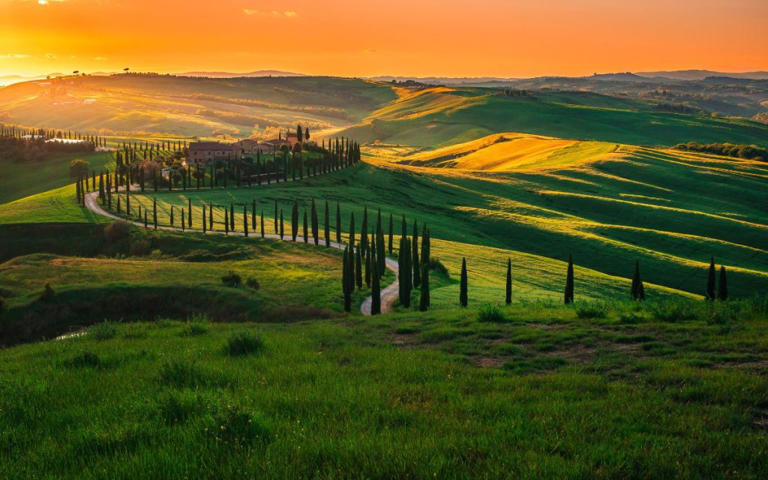

IMAGES
VIDEO
COMMENTS
Step 2: Start in Florence. Florence is a great starting point. You'll probably arrive in Italy via Rome, but I don't recommend driving in Rome if you've not been before. You can take a train to Florence in less than two hours and navigate easily from there.
It's like I'm on some sort of globetrotting drug…freebasing the essence of peak travel. And when I get home, it all feels like some sort of surreal fever dream. (Or maybe it's just all the pecorino and truffles.) Our tour company just announced a brand-new Best of Tuscany Tour for 2020. Impeccably designed by Heather Lawless and other ...
Day 2: Florence (sleep in Florence) Day 3: Florence (sleep in Florence) Day 4: Florence (sleep in Florence) Day 5: Bus to Siena (1.5 hours; sleep in Siena) Day 6: Siena (sleep in Siena) Day 7: Rent car, drive Crete Senesi route to Montepulciano (sleep in Montepulciano) Day 8: Follow our guidebook's "Heart of Tuscany Drive," with a stop in ...
The Apuan Alps. The Parco Naturale delle Alpi Apuane stretches across two areas of northeastern Tuscany that few people take the time to visit, Lunigiana and Garfagnana. The rugged Apuan Alps take their name from their resemblance to the actual Alps, although they are much smaller in size with peaks under 2,000 meters.
One Week Tuscany Itinerary Day 1 - Florence. Florence is one of the most beautiful cities in Italy and is not to be missed in any Tuscany itinerary.. One full day is the minimum that you need in order to see the main highlights of Florence.You can find more information, tips, and advice for visiting Florence in some of the more detailed guides to the city on our blog.
Day 2: Siena. Day 3: Val d'Orcia. Day 4: Val d'Orcia. Day 5: San Gimignano and Volterra (end in Florence) Day 6: Florence. Day 7: Florence. Now that you've got a good overview of the geography and logistics, let's get into exactly how to spend one week in Tuscany!
Trenitalia train tickets can cost as little as 3€ for local travel, and 50€+ for longer-distance, high-speed train rides. Keep in mind that if you book your long-distance train tickets well in advance, they will be cheaper. For short routes, there really isn't a need to buy in advance as the price doesn't change much.
Day 7: Drive back to Florence (visit Lucca if time) Best way to get around Tuscany. If you're just keen to visit the cities in Tuscany you can definitely get around using trains and buses. The main cities are well connected to places like Rome, Florence or Pisa and train travel is fairly cheap and easy to navigate.
Getting to Tuscany. There are many reasonably priced flights to Italy, generally to the larger international airports in Milan or Rome. From there, you can easily rent a car and drive to Tuscany or take a train to Florence. You can also look for flights that fly into Pisa, Bologna or Florence (from other European hubs) to get even closer to ...
And then you fill up to the amount you need. The console will issue you a receipt once you've finished. Glossary: Pompa = Pump. il pieno = Fill it up. Senza piombo = unleaded. General Tips. Tuscany is about slow travel, and we always recommend that people don't try to squeeze too much in to each day.
Atlanta: The nonstop flight from Atlanta to Rome takes 9 hours and 50 minutes. You can take seven direct flights between Atlanta and Rome every week. Boston: It requires an average of 8 hours and 10 minutes of flight time to get from Boston to Rome. Delta Airlines and Alitalia both offer flights from Boston to Rome.
Best time to visit Tuscany. A view over lush green fields and distant hills at sunset, Tuscany, Italy. Although alive with sunflowers and fruit trees, Tuscany's summer months bring heavy crowds and high temperatures. If you want to avoid these, we recommend visiting between April and May or late September and October.
The iconic vineyards and olive trees associated with Tuscany are spread throughout the Chianti area, situated just a few kilometres south of Florence.You'll find a series of country roads perfect for a car or bike trip, and this whole area is considered a food and wine paradise.. There are many different itineraries to choose from. One of these is the Chianti Classico route, which touches ...
The best time to visit Tuscany is the shoulder season, which falls either side of the region's busiest months. Planning a trip to Tuscany during April and May or October and November will mean fewer crowds, comfortable temperatures and lots of activities. ... Trains are also one of the most affordable ways to travel around Italy; many regions ...
Tuscany What To See and Do - Quick tips for your trip. 1. Florence and its grand museums. See Botticelli and Da Vinci at the Uffizi and meet the David at the Accademia Gallery in Florence. On this Special Tour Skip-the-Line of the Uffizi you can skip the queues and experience the highlights of Renaissance art with an experienced guide.
But a car is the best way to be able to appreciate the endless views. => Planning a road trip in Tuscany? Find out about driving in Tuscany. And the best scenic drives around the region! A view of the Val d'Orcia Getting around in Tuscany by train. As a general rule, it's easy to travel around Tuscany by train if you're visiting the ...
How to Visit the Tuscan Countryside by Train. Florence is the main rail hub for Tuscany. Most visitors arriving from Rome, Milan, or Venice by train will transfer here for the Tuscan countryside. It's easy to reach larger towns such as Siena, Lucca, Arezzo, and Pisa from Florence with regular services and reasonably priced fares.
Dive Deeper into Rome's Stories. The distance between Rome, located in the Lazio region, and Tuscany is 280 km. The best transportation option is a high-speed train 🚂. You can also travel by bus or car. The journey will take from 1 to 5 hours.
Tuscany is well connected by train and you can easily visit some of the places in Tuscany by using public transport. The train stations are usually located close to the town centre. One of the main Italian train lines connecting Rome with Milan passes through Tuscany. So, the trains are quick and depart regularly.
Find the travel option that best suits you. The cheapest way to get from Rome to Tuscany costs only €17, and the quickest way takes just 1½ hours. ... The best way to get from Rome to Tuscany is to train which takes 1h 36m and costs €17 - €75. Alternatively, you can Bus, which costs and takes 2h 58m, you could also fly, which costs €45 ...
Florence is a natural starting point to begin your journey to the best places to visit in Tuscany. Known for the imposing red-roofed Duomo and Michelangelo's David in the Accademia, Florence is ...
Find the travel option that best suits you. Rome2Rio uses cookies to help personalize content and show you personalised ads. By proceeding, ... The best way to get from Milan to Tuscany is to train which takes 1h 55m and costs €45 - €65. Alternatively, you can bus, which costs €25 - €40 and takes 4h 59m. ...